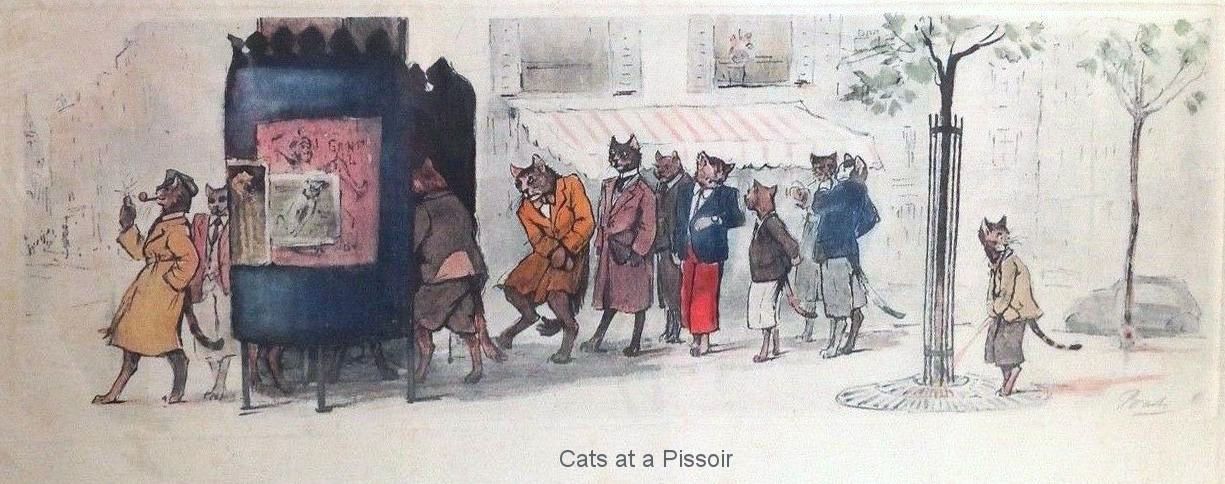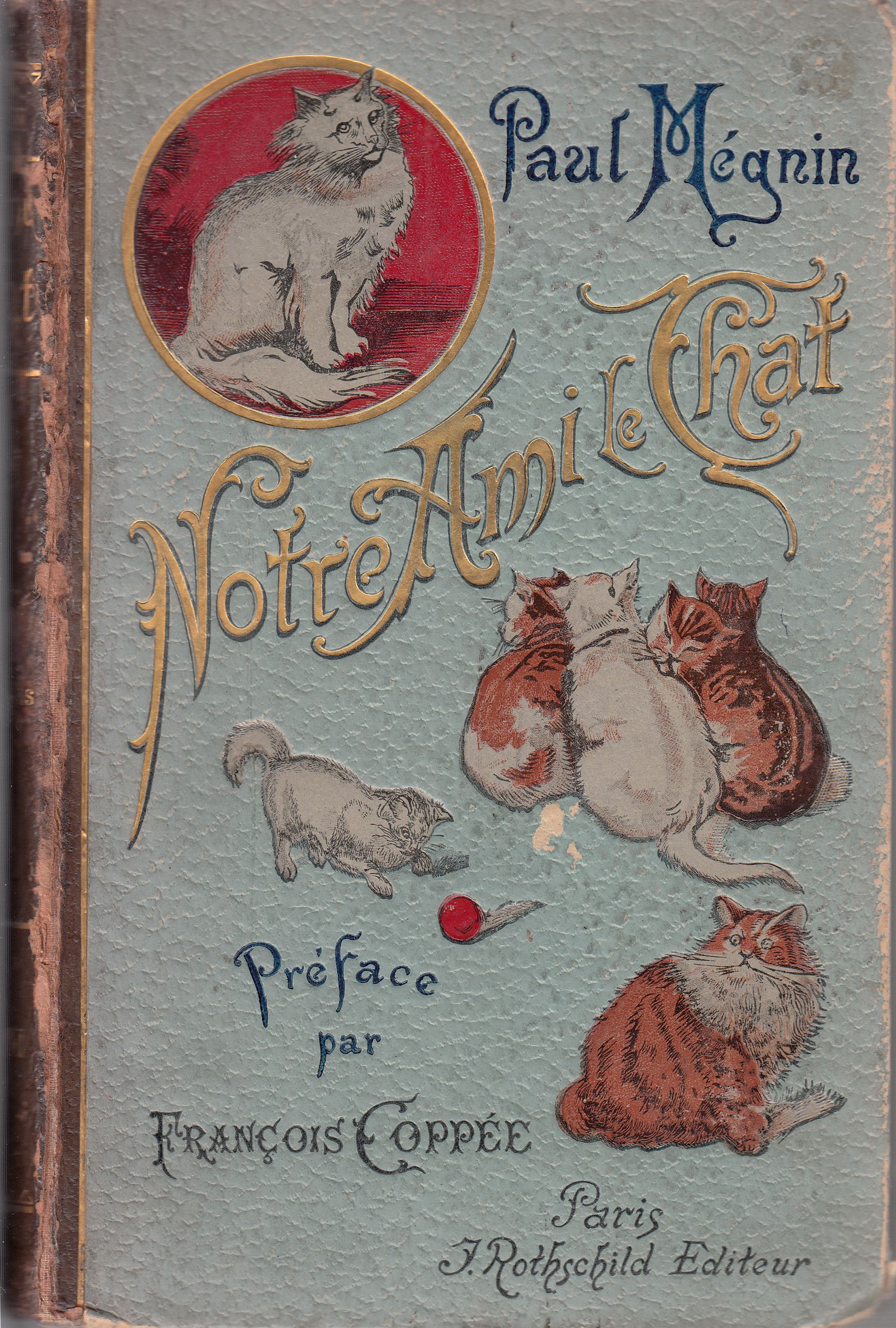
OUR FRIEND THE CAT
PAUL MÉGNIN

CATS IN THE ARTS - HISTORY - LITERATURE
NATURAL HISTORY OF THE CAT – CAT SPECIES - WILD CATS
DOMESTIC CATS – CAT DISEASES
CATS IN COURT - MODERN CATS
Preface by FRANÇOIS COPPÉE
Of the Academie Française
Illustrated with 200 Illustrations and 5 Etchings
BY
MM. ADAM — BREUGHEL — BRUNER — BURBANK — MADAME CHAMPFLEURY -CRAFTY
EUG. DELACROIX — FOU-SOU-KAI (HOK-SAI) — A. GAUTIER — J.-J. GRANVILLE
KREUTZBERGER — EUGENE LAMBÈRT — MANET — PIERRE MEGNIN — MILLOT
GODFRIED MIND — PILLE — HENRIETTE RÖNNER — ROUVIÈRE - SAINT-GERMAIN
SPECHT – WIR – CH. WEISSER - CORNÉLIUS WISCHER — WHISTLER, ETC.
PARIS
J. ROTHSCHILD, EDITOR
13, RUE DES SAINTS-PÈRES, 13
1899.
All Rights Reserved
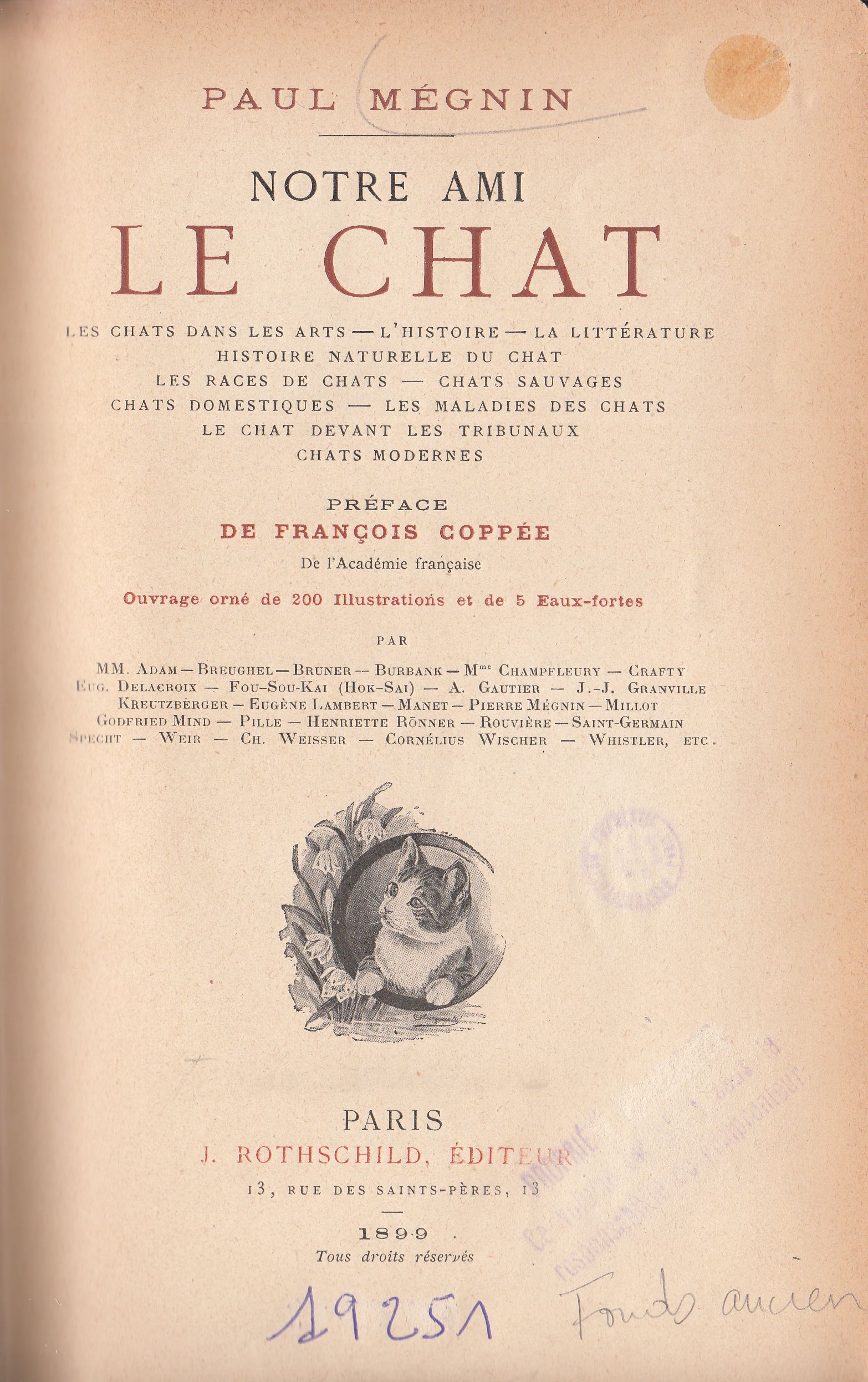
TO THAT EXCELLENT FRIEND
ARTHUR PORTE
Director of the Paris Jardin d’Acclimatation
WHO, WITH FERNAND XAU, DIRECTOR OF THE Journal, ORGANISED THE FIRST CAT SHOW IN FRANCE
WITH GREAT RESPECT
PAUL MÉGNIN
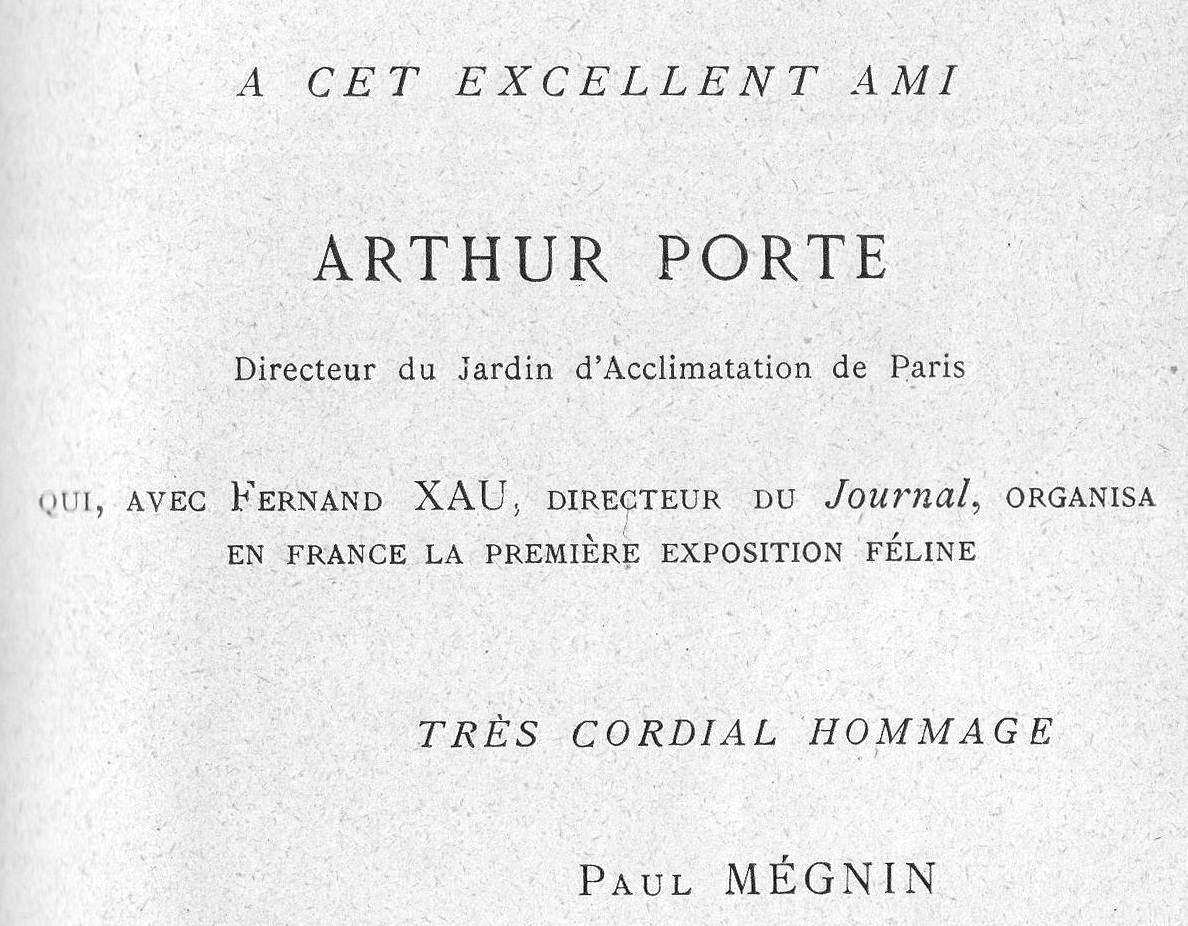
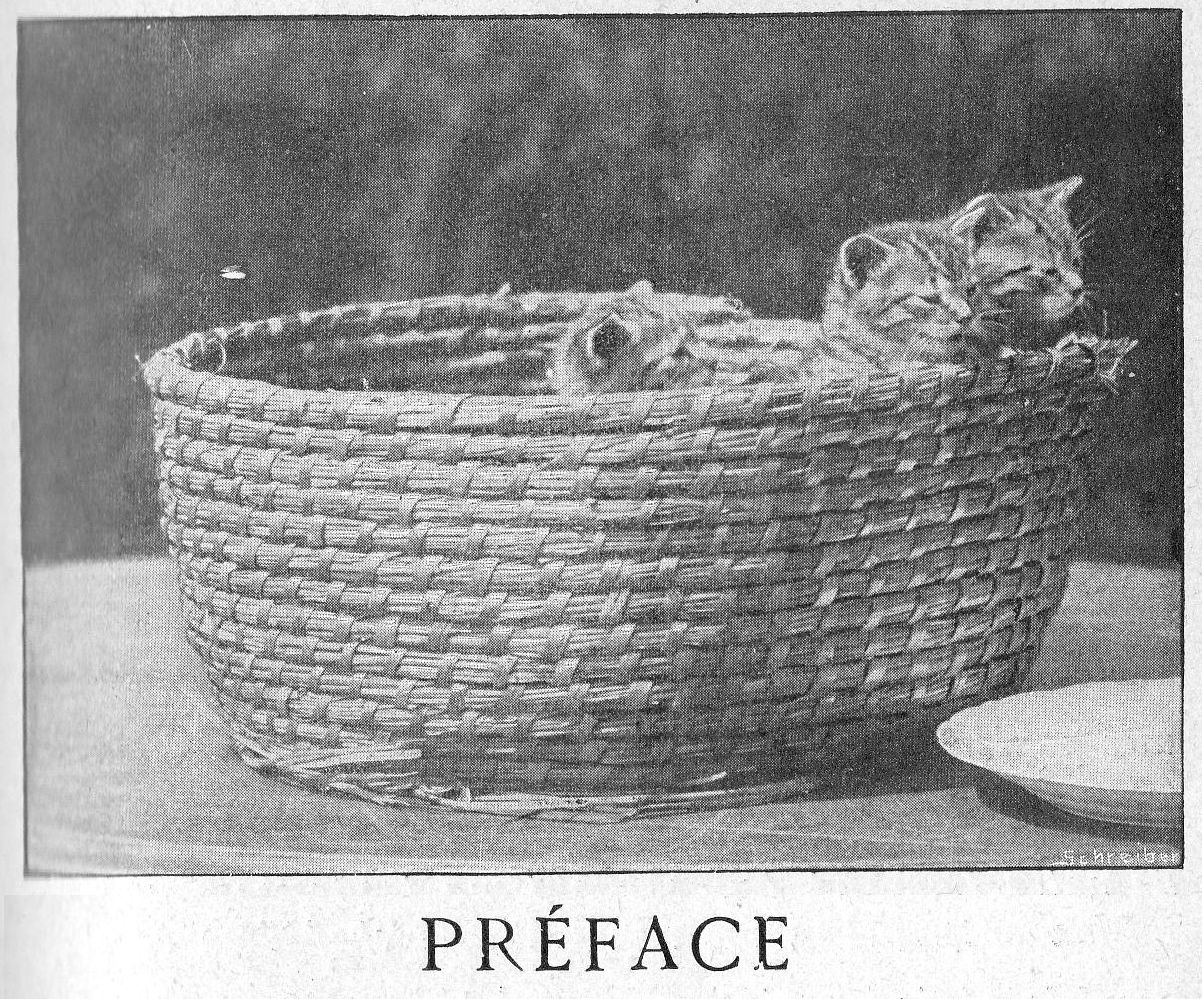
PREFACE
I read with extreme pleasure, my dear colleague, your charming book: "Our Friend the Cat". You speak of him with a great deal of wit and knowledge, and to praise him even more delicately, you have borrowed his principal quality - grace. This is how one recognizes that the writer is truly a friend of the Cat; it's his trademark or, more accurately, his signature.
You ask me for a page about these lovable felines as a preface. But what shall I say? I exhausted all my stories of cats a long time ago and have, in particular, described mine, from tail-tip to whisker-tips.
Fortunately, to help me out of this fix, I found in my papers a sonnet which I sent a few years ago to Madame Henriette Rönner, the Belgian artist and emulator of our Lambert, who, knowing my affection for Cats, kindly sent me a very beautiful Album containing excellent portraits of these pretty creatures.
Of course, by reminding me of Baudelaire's masterpiece, I blush at these nasty rhymes. Never mind! Please add them to your book, so that we know that I have paid tribute to the Cat in prose and verse, - by hook or by crook.
Yesterday I received your beautiful book of art,
These cats caught in mid-act by your rare skill,
No-one understands these creatures quite so well,
The familiar tiger, loving and proud in equal parts.
Your painted felines are exquisite, Madame Rönner,
I admire them and compare them with a slight pang of pride
To my own charming Angora who in my house resides,
And who is respendant in his fresh-donned winter fur.
In me, as in you, the Cats provoke such sympathy!
They have ruled my household in long dynasties,
These regal, idle kings in silky fur.
And Cats are walking cautiously and silently
Through the quiet of my old man’s solitude,
And bring with them beauty, grace, and mystery.
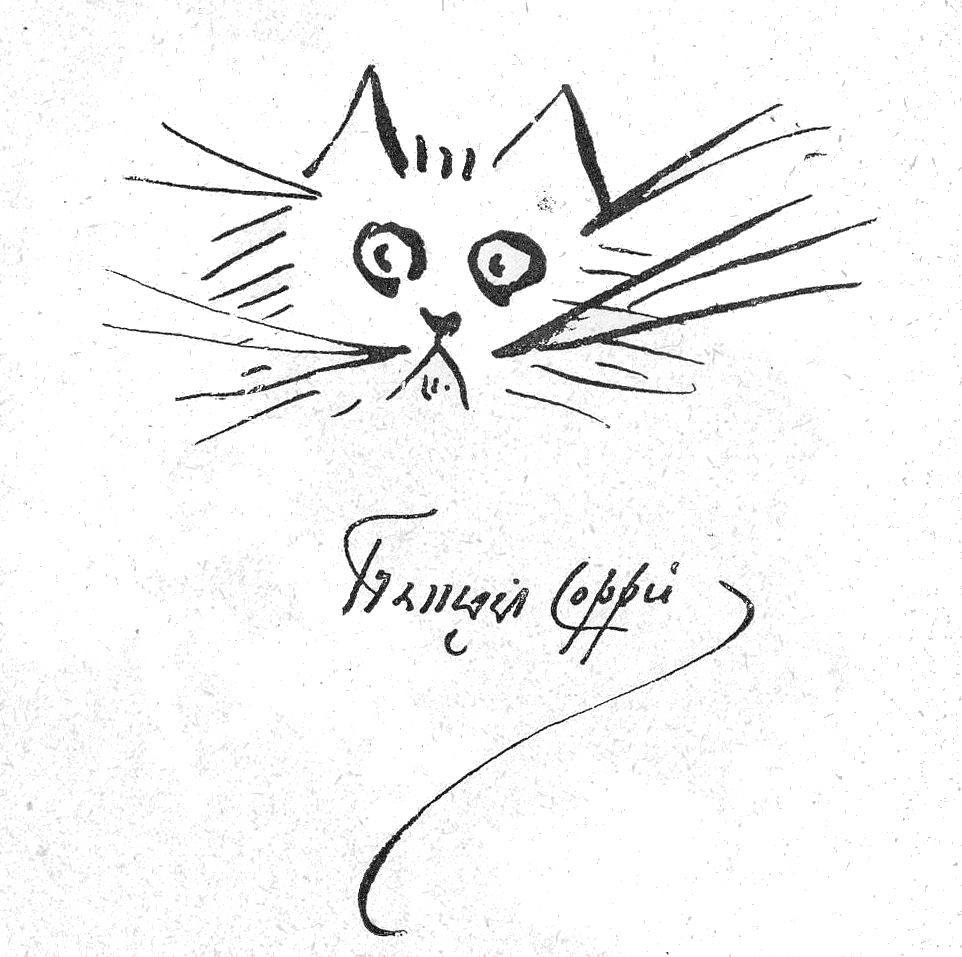
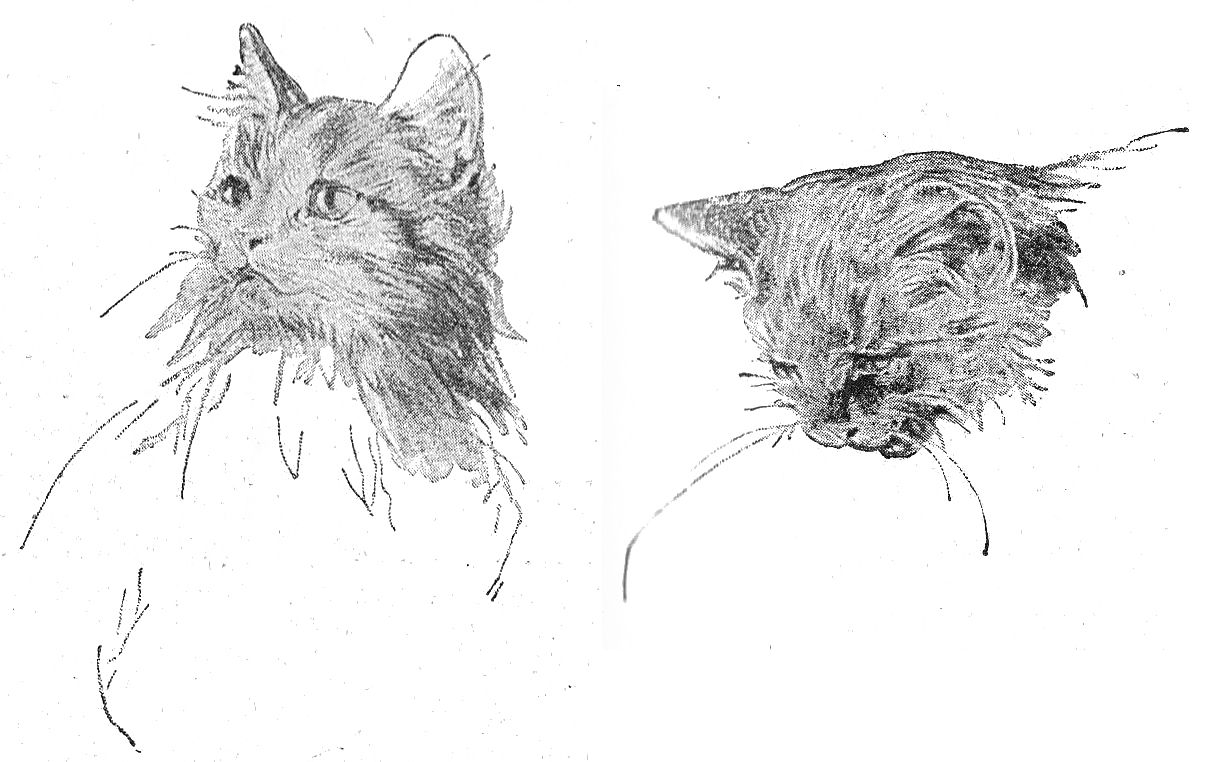
TRANSLATOR’S NOTE
Megnin quotes a number of accounts already published in books by Champfleury, Landrin and Moncriff. In these cases, I have used an existing English translation rather than make a new translation. I have also added explantatory comments in brackets for terms and nicknames that have no direct English equivalent. In the case of poetry, where there is no existing translation I have sometimes adjusted the rhyming scheme in order to preserve the meaning.
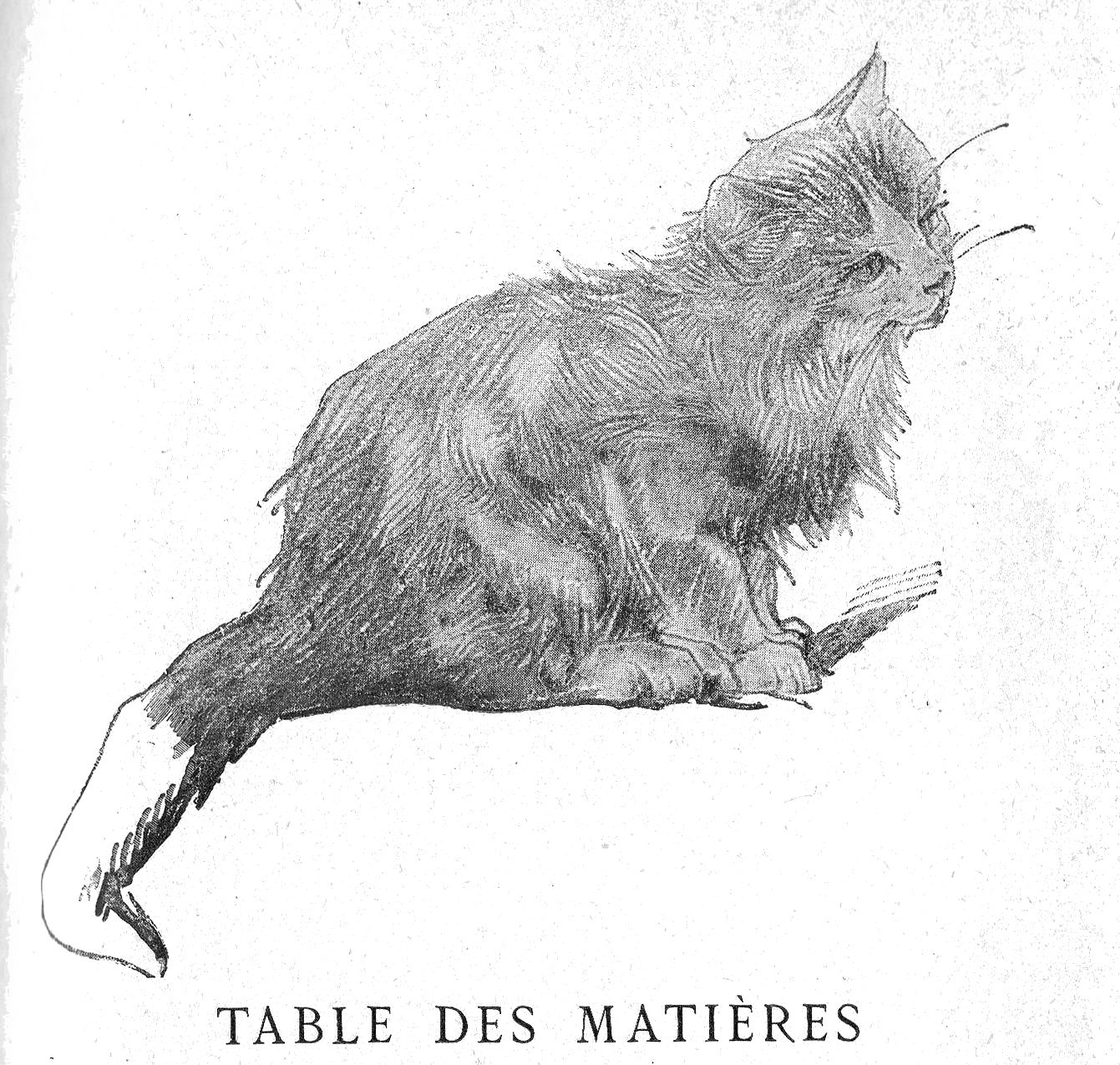
TABLE OF CONTENTS
Preface, by François Coppée, of the Academie Française.
PART ONE.
CHAPTER I - GENERAL CONSIDERATIONS ON THE CAT AND ITS CHARACTER. – 1
Lenz’s Opinion. – 1
The philosophical and independent cat. - 2
A few words on the domesticity of the cat. - 4
The sociable cat. - 6
Housecats and mousers. - 7
Cats and valerian. – 8
CHAPTER II – ORIGINS OF THE CAT. - 11
Legends about the cat’s origins. -12
The cradle of the cat species. - 12
Origin of the word "cat." - 13
Saying "cat" in various dialects. – 14
CHAPTER III – FOSSIL CATS. - 15
Prehistoric cats. - 16
Vanished species. - 16
CHAPTER IV –CATS IN ANCIENT EGYPT. - 17
Representations of cats on ancient Egyptian monuments. - 18
Cats used in hunting and fishing. - 20
The gloved cat. - 21
The veneration of cats in ancient Egypt. - 21
Cat symbolism. - 22
The cat's eye. - 22
Temple cats. - 23
Mummified cats. - 24
Cat gods and avengers of the gods. - 24
Temples dedicated to cats. - 25
The causes of the Egyptian cat cult. – 26
CHAPTER V - CATS IN THE ORIENT. - 27
The domestication of the cat in Eastern countries. - 28
The garden of cats. - 28
The cat among the Arabs. - 29
The cat in India. - 31
Hindu legends about cats. - 32
Cats in China. - 34
Cats in Turkey. – 34
CHAPTER VI – CATS IN GREECE AND ROME. - 35
Representations of cats in Greece. - 35
Epigrams of the minor poets. - 37
Roman and Gallo-Roman monuments. 39
The cat in Gaul. – 40
CHAPTER VII – CATS IN THE MIDDLE AGES - 41
A Welsh law. - 41
The diabolical cat. - 42
Witches’ cats. - 42
Cats and the fires of St. John. - 45
Cats in Metz. - 46
Cats in Picardie. - 47
The legend of Beaugency's cats. – 48
CHAPTER VIII - CATS FROM THE MIDDLE AGES TO THE MODERN DAY - 51
Popular poetry about cats. - 52
Cats and children. - 52
Legends about cats. - 55
The story of Bis, the Rothschild of cats. - 57
Cat's meat men in England. - 61
CHAPTER IX - CAT HATERS. - 63
Toussenel and Honouré Scheffer. - 64
Hunters and cats. - 65
Wild cats and gutter cats. - 65
A scary, but false, statistic. - 67
Ronsard and cats. - 67
Léo Lespès and Nadar.
The Anti-Cat Club in Munich. - 67
Cats and architects. – 67
CHAPTER X – CAT LOVERS. - 69
Theoph. Gautier and cats, the poor devils’ tigers. - 69
Veneration of cats by the Arabs. - 70
The legend of Mohammed’s cat. - 70
Why do cats always fall on their feet? - 72
Petrarch's cat. - 73
Tass’s cat. - 74
Richelieu’s cats. - 75
Colbert. - 76
Other cat-lovers of the 17th and 18th centuries. - 77
Chateaubriand and his love of cats. - 78
Moncriff’s Story of Cats. - 80
The "Historiogriff" of the Kingdom. - 80
Victor Hugo’s cat. - 81
Palemon, Sainte-Beuve’s cat. - 83
Baudelaire's cats. - 84
A sonnet by Baudelaire. - 85
Théodore Barière’s opinion. - 86
Fanfan’s crime. - 86
François Coppée and the cats. – 88
CHAPTER XI – CATS IN THE ARTS – 89
Representations of cats in Egypt. - 89
Hok’sai, the Japanese painter. - 90
Hok’sai’s sketches. - 91
Godfried Mind, the Raphael of cats. - 92
The Dutchman Cornelius Wischer. - 95
The physiognomy of cats according to Granville. - 96
The comedian Rouvière, painter of cats. - 102
Rouvière’s successor: Saint-Germain. His opinion on cats. - 103
Modern painters of cats. - 1-4
Cats in architecture. – 105
CHAPTER XII – COATS OF ARMS AND SIGNS RELATING TO THE CAT. - 107
The cat as a heraldic animal. - 107
The cat on Roman "Targues and Pavois." - 109
Some old coats of arms - 109
Printers’ "Marks." - 111
The cat and the Republic. - 111
Old signs. - 112
The Black Cat newspaper. - 113
Salis and his cabaret. - 113
Lou Matagot. - 114
The grey cat. - 114
PART TWO
CHAPTER ONE – NATURAL HISTORY OF THE CAT. - 117
The cat genus and the domestic cat. - 117
General zoological characteristics. - 118
Claws. - 119
Feline senses. - 120
Classification. - 121
The Manul. – 121
CHAPTER II - NATURALISTS OPINIONS ABOUT CATS - 123
Buffon and the cat. - 123
A terrible enemy of the cat species. - 123
Boitard, defender of cats. - 129
Buffon's collaborater and cat-lover, Sonini. - 130
A letter from Mme d'Epinay. – 130
CHAPTER III – FELINE INTELLIGENCE. - 133
The intelligence of the big cats. - 133
The characteristics of feline intelligence. - 134
Some curious cases of feline intelligence, wit, observation and reasoning. - 136
Cats and monkeys. - 137
A herding-cat. - 137
A chicken-guarding cat. - 138
Hunting cats. - 139
Fishing cats. - 139
Cats and water. - 140
Clever cats. - 140
Leoni Clarke, the King of Cats. - 141
Boxer cats. - 142
A feline aeronaut. - 143
Guignol’s cat. - 144
The cat-piano. - 145
Arnould's cat, Galopin. - 145
The Sébastopol cat. - 147
The cat and the cutlets. - 148
Cat language. - 149
Cats that talk. - 150
Saying "Cat" in different languages. – 151
CHAPTER IV – FELINE HABITS AND BEHAVIOUR, KITTENHOOD, FAMILY FEELINGS. - 153
Kittens. - 153
A mother’s love for her kittens. - 155
Female cats feeding other animals. - 158
The cat’s sense of cleanliness. - 160
Miaowing. - 163
Attachment to its master. - 164
Attraction to valerian. – 165
CHAPTER V – USEFUL CATS. - 167
Services rendered by the cat. - 167
What do cats destroy? - 168
The Pittsburg refrigerator cat. - 170
Cyprus cats - snake destroyers. - 172
Cats destroying insects. - 172
Richard Whittington's cat. – 173
CHAPTER VI - GENERAL CONSIDERATIONS ON BREEDS. - 175
Synopsis of cat breeds. - 176
Wild cats. - 177
Wild cat behaviour. - 178
Feral cats. - 180
The manul and the African wildcat (gloved cat). – 181
CHAPTER VII - DOMESTIC CAT BREEDS. - 183
General characteristics. - 183
The Iberian (Spanish) cat. - 184
Cyprus Cat. - 184
Iceland Cat. - 184
Cape cat. - 184
Gambian cat. - 184
Abyssinian Cat. - 185
Carthusian (Chartreux) cat. - 185
Angora cat. - 185
Persian cat. - 190
Russian cat. - 190
Chinese cat. - 191
Short-tailed cat breeds. - 192
Siamese. - 193
Siamese wild cats. - 194
Tailless cats from the Isle of Man. - 197
Varieties of cats created in England. - 199
The tortoiseshell cat. - 200
Arkangel cat. – 201
CHAPTER VIII – CAT DISEASES. - 203
Diseases of young cats. - 203
Cat plague. - 204
Rabies. - 205
Contagious typhus. - 205
Diphtheria. - 208
Parasitic diseases. - 211
Scabies (mange). - 212
Diseases caused by worms. – 214
CHAPTER IX - CASTRATION. - 215
How to perform castration surgery. - 216
A cat’s suicide after castration. – 217
CHAPTER X – CATS IN COURT. - 219
Lawsuits concerning cats. - 219
A legal case about cats. - 220
Two contradictory judgments. - 220
Cats and hunters. - 231
Legal judgments. – 231
CHAPTER XI – CAT SHOWS. - 231
The London cat show. - 236
Cat show in Belgium. - 236
What judges are looking for. - 236
The first cat show in Paris. – 238
CHAPTER XII - CONCLUSION. - 245
Some writers’ opinions on cats. – 245
Emile Zola. - 246
François Coppée. - 246
Catulle Mendès. - 247
Pierre Loti. - 248
Sully Prudhomme. - 249
Stéphane Mallarmé. - 251
Armand Silvestre. - 252
Georges Courteline. - 253
Edmond Deschaurmes. - 253
Love between a cat and a dog. - 254
Ernest La Jeunesse. - 256
Louis de Grammont. - 258
A monologue by Georges Feydeau. - 259
A page by Champfleury. - 263

TABLE OF ILLUSTRATIONS
16th century printing mark. - 108
A Cat Family, drawing by Eug. Lambert. - 50
A succulent lunch, by Specht. - 107
Abelard, from a drawing by Violiet-Je-Duc. - 215
Abyssinian Cat, drawing by H. Weir. – 185
Acrobatic cat (The), by H. Weir. - 133
Angora cat, drawing by H. Weir. - 186
Angora cat, drawing by Pierre Mégnin. - 187
Arkangel cat, drawing by H. Weir. - 201
Baudelaire, by Morin. - 84
Black cat (The), frontispiece of the newspaper. - 113
British Wildcat, drawing by H. Weir. - 178
Bronze, in the Egyptian Museum of the Louvre. - 18
Capital, from the collection of the Troy museum. - 102
Cat and fish, by Bungartz. - 10
Cat Cannon (The). - 46
Cat Mummy (Egyptian Museum). - 23
Cat piano, after an old engraving. - 145
Cat Show at the Crystal Palace, London, sketch by H. Weir. - 235
Cat strangling a bird, from a mosaic in the Naples Museum. - 36
Cat suckling its young, from a bronze in the Egyptian Museum. - 28
Cat's claw. - 119
Cat's head, sketch by Eug. Delacroix. - 124
Cats’ Quarrel, by Specht. – 11
Cats’ Rendezvous, by E. Manet. - 166
Cats’ Tribunal, drawing by H. Weir. - 219
Champfleury, by Morin. - 87
Chateaubriand, by Morin. - 78
Chatreuse Cat, drawing by H. Weir. - 190
Chinese cat, drawing by Bungartz. - 191
Chinese family (Children and cats), from a porcelain cup in the collection of Mr. Jacquemard. - 104
Coat of arms featuring Cats. - 109
Concert of cats, after the painting of Breughel. - 55
Coquetry, drawing by Specht. - 183
Country Cat (The), drawing by Ribot. - 218
Courteline (G.) and her cats, by Ch. Weisser. - 253
Duet on a roof, drawing by Ch. Weisser. - 51
Egyptian bronze, drawing by M. Prisse d'Avesnes. - 29
Egyptian painting in the British Museum, drawing by Merimee. - 19
Family of cats, sketch of H. Weir. - 205
Family scene, sketch by H. Weir. - 123
First skirmishes, drawing by Specht. - 63
For the sake of beauty, by Ch. Weisser. - 15
Forbidden Fruit, by Henriette Ronner. - 106
French Wild cat, drawing by Pierre Mégnin. - 177
Gallo-Roman tomb (Bordeaux Museum). 39
Gâlopin and his cat Minou. - 146
Gloved cat (F. maniculata). - 17
Good mother, drawing by H. Weir. - 157
Good mother, drawing by Specht. - 41
Granville (J.-J), sketch. - 96, 97, 98
Group of cats, acaprice, Japanese drawing from the collection of M. J. Tissot. – 99
Half-angora cat, drawing by H. Weir. - 188
Harrison Weir (photograph). – 101
High School, by Adam. - 62
Hoffmann, by Morin. - 83
Hungry foursome, drawing by Adam. - 174
Huysmans (S.-K.) and his cat, by Delâtre junior. - 244
In front of the fire. - 69
Insignia, St. Denis Street. - 113
Isle of Man Cat, drawing by H. Weir. - 196
Isle of Man Cat. - 195
Japanese screen from the collection of Mr. James Tissot. - 89
Judging panel of the first Cat Show in Paris. - 237
Kittens, sketch by H. Weir. - 157
La Jeunesse (E.) and his cats, self-portrait. - 256
Liberty, according to Proudhon. - 112
Lilith, sketch by Whistler. - 251
Little Minet, from a photograph. - 202
M. de Moncriff, by Morin. - 80
Mallarmé (Stéphane). - 251
Manul, drawing by Bungartz. - 117
Minet in illness, sketch by Kreutzberger. - 203
Misunderstood Love, drawing by Specht - 35
Montaigne, by Morin. - 77
Montaigne, from a portrait in Dr. Payen's collection. - 71
Mother and kittens, after a painting by the comedian Rouvière. - 5
Mother cat, sketch by H. Weir. - 156
Mummified Cat Sarcophagus (Louvre Museum). - 22
Persian cat (Young), drawing by H. Weir. - 189
Persian cat, drawing by H. Weir. - 189
Reproduction of a Japanese painting by Hok'sai. - 91
Richelieu, by Morin. - 75
Sessa printing brand. - 111
Showman with trained cats, after an old engraving. – 132
Siamese cat, drawing by Pierre Mégnin. - 193
Skeleton of the cat. - 118
Sketch after Mind. - 158
Sketch by Kreutzberger, after Delacroix. - 93. 94
Standard of the ancient Romans. - 110
Statement, by Ch. Weisser. - 27
Striped cat, drawing by H. Weir. - 198
The Little Household, sketch by Saint-Germain. - 260, 261, 262
The Victory of mice over the cat, popular Russian engraving. - 54
Tiger cat, drawing by H. Weir. - 199
Tortoiseshell cat, drawing by H. Weir. - 200
Tranquil Slumber, after a print by Cornelius Wischer. - 1
V. Hugo's cat. - 81
Victor Hugo’s autograph. – 81
Washing Cat, after a watercolour of Mind. - 160
Wet-nurse, drawing by Ch. Weisser. - 153
Wild cat from Siam, drawing by Millot. - 194
Wild cat, drawing by Specht. - 175
Wildcat, by Werner. – 13
Winning entries of the first Cat Show, drawings by Weisser. - 240, 241
Young Angora, drawing by H. Weir - 182
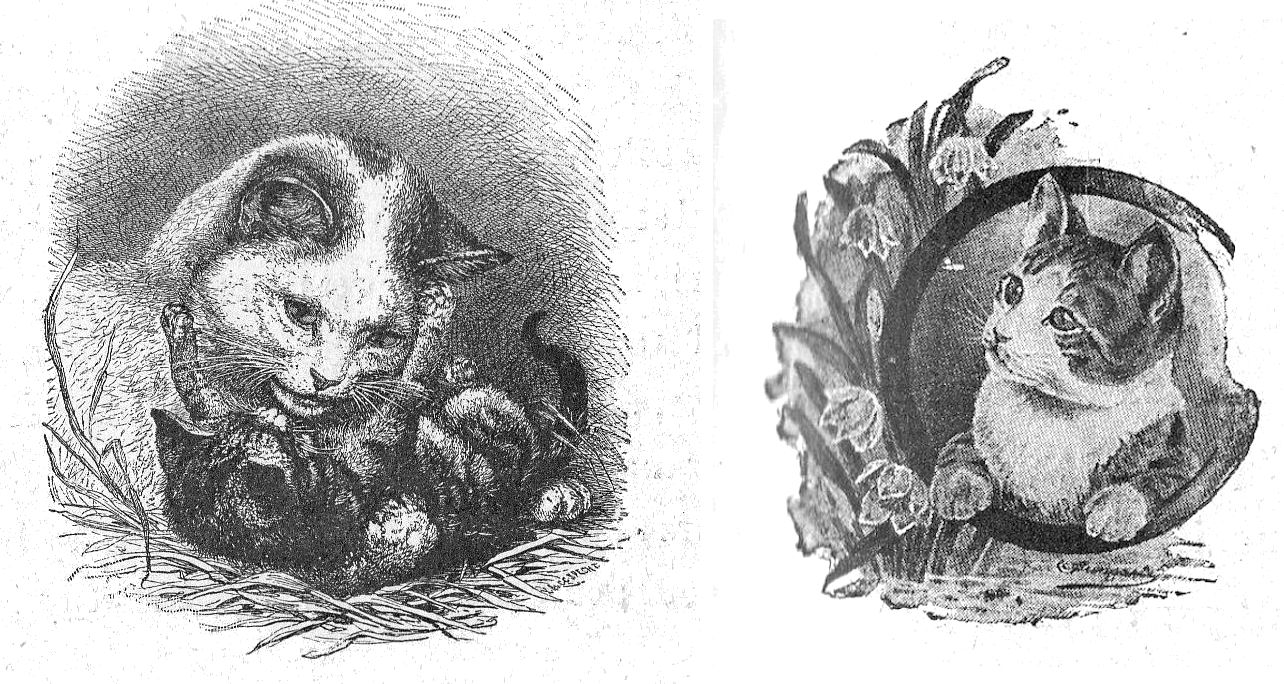
TABLE OF ETCHINGS
The Cat and The Flowers, by E. MANET - 1
Cats Playing, by Eug. LAMBERT. - 49
Cat’s Chase, by CRAFTY. - 129
Mother Cat, by Armand GAUTIER. - 161
Lunchtime, by Mme CHAMPFLEURY. - 225
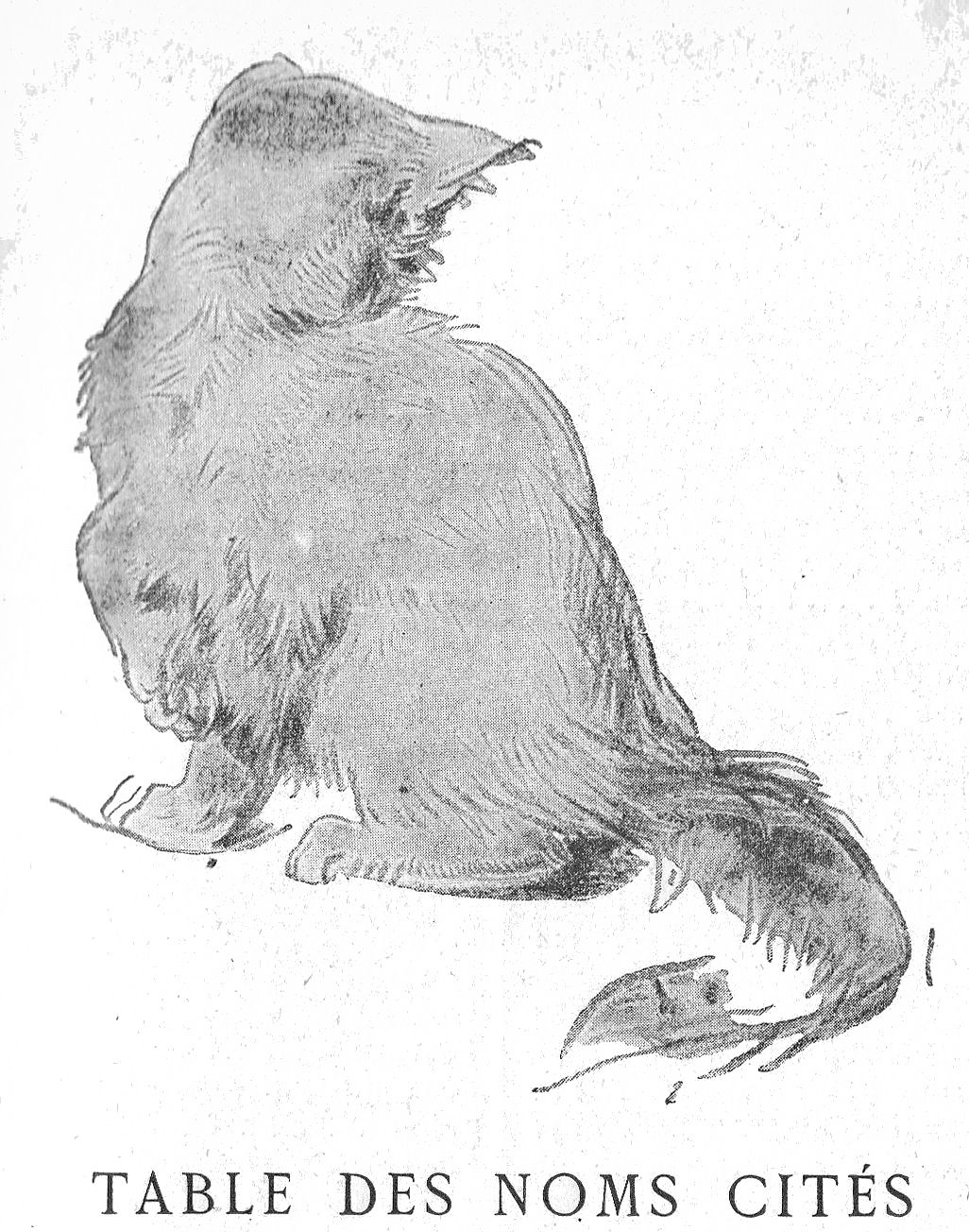
TABLE OF NAMES CITED
Abel - 76
Achille - 38
Actéon - 38
Agathias - 37
Aizac(Mlle Félicie d’) - 105
Allais (Alph.) - 113
Amyot - 22
Anaker - 213
Apollon - 11
Arène (Paul) - 114
Aristote - 36
Pages
Armentières (la maréchale d’) - 46
Aumale (d’) - 259
Auriol (G.) - 113
Barrier - 203
Barrière (Théodore) - 86
Balzac - 2
Baudelaire - 2, 81, 85, 192
Bell - 213
Bellay (Joachim du) - 47
Bernardin de Saint-Pierre - 77
Bertillon – 39
Blainville (de) - 15, 24
Blyth - 13
Boitard - 129
Boukay (M. ) - 113
Brehm - 137
Breughel - 55
Brown - 136
Bruner - 145
Bubastis - 19
Buffon - 2, 4, 63, 79, 123
Bujeaud (Jérôme) - 53, 161
Buniva (Dr) - 205
Burbank - 95
Cambyse - 27
Cammas (H.) - 25
Caribert (Octave Lebesgue) - 38
César - 28
Chabouillet - 38
Chafïardon - 111
Champfleury - 2, 3, 20, 38, 55, 81, 90, 105, 153, 264
Chateaubriand - 56, 78
Chetardie (La) - 110
Clarcke (Léoni) - 141
Colbert - 76
Combourg (Comte de) - 56
Coppée (Fr.) - 88, 196, 239, 246
Cornevin - 121, 175
Couch - 136
Courteline (G.) - 253
Çouturat - 239
Crémieux - 220
Cuvier - 15, 24
Damocharis - 38
Darnisei - 12
Darwin - 13
Debrèves - 172
Delacroix(Eug.) - 95
Delapalme - 230
Della Gatta - 110
Delassus (Jules) - 42
Depping (G.) - 92
Desbordes-Valmore (Mme) - 78
Deschaumes (E.) – 239, 253
Deshoulières (Mme) - 78
Desprez (Marcel) - 78
Devendiren - 32
Diane - 41
Diodore de Sicile - 21
Docquois(G.) - 246
Donnay (M.) - 113
Dufresne (Mlle) - 240, 243
Dumas (Alexandre) fils - 2
Dupont de Nemours - 120, 150, 152, 155
Edelestand du Méril - 45
Ehrenberg - 24
El-Daher Beybars - 28
Epinay (Mme d’) - 130
Estienne (Henri) - 111
Fadyau - 211
Feydeau – 103, 259
Finazzi - 207
Flourens - 4
Fontenelle - 77
Fou-sou-Kay (Hok’sai) - 90
Fréret - 31
Freytag - 14
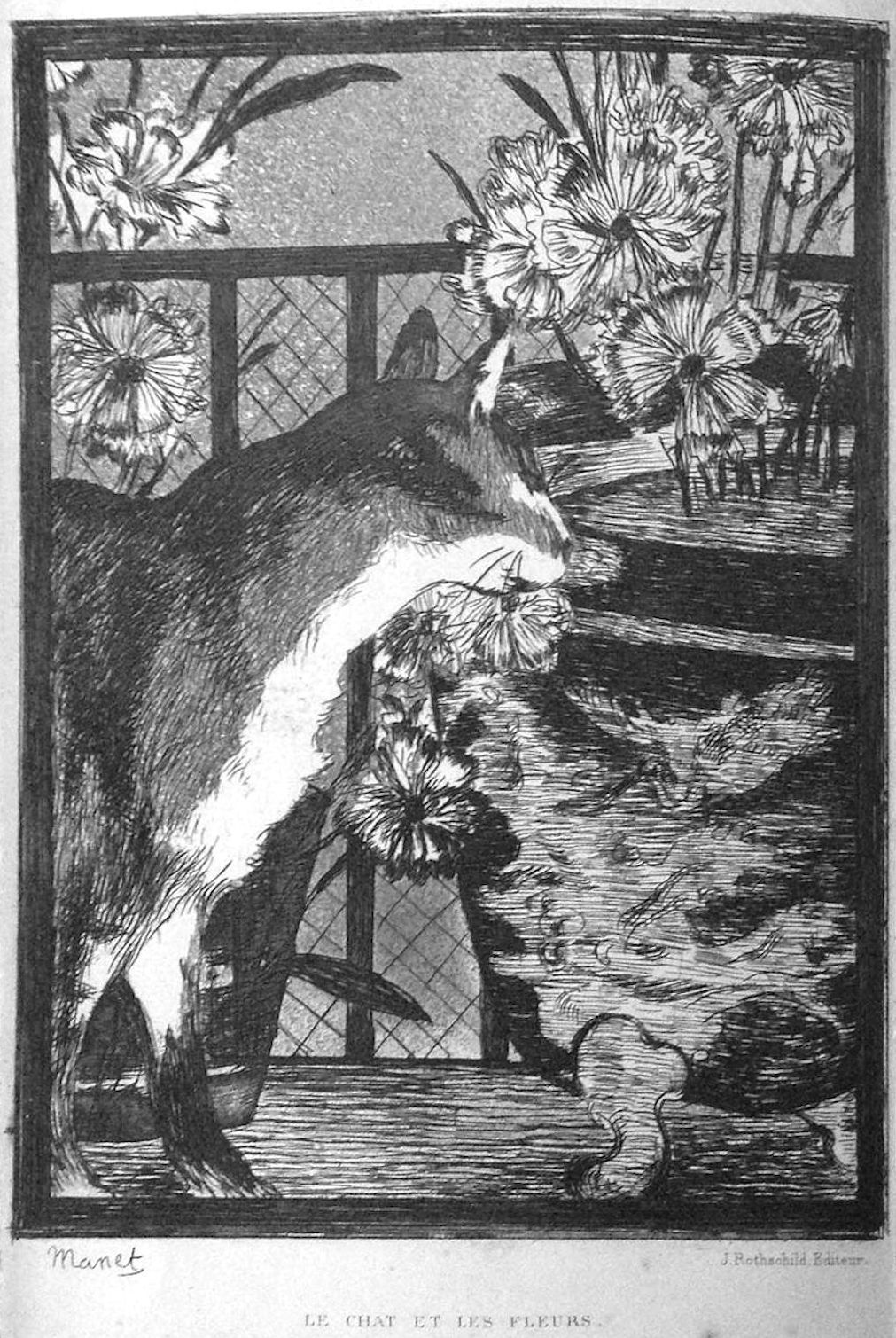
Galiani (l’abbé) - 130, 152, 164
Galopin (Arnould) - 145
Garguille (Gauthier) - 143
Gauthier (Th.) - 69, 81
Geffroy (E.) - 24
Giebel - 138
Goya - 90, 91
Grammont (Louis de) - 148, 258
Granville (J.-J.) - 98
Gratiolet - 154
Gray (J.-J.) - 208
Grewer Leclerc - 144
Grimm - 80
Guersant (Dr). - 205
Guillaume de Tripoli - 28
Guyot-Desherbiers – 66
Hana - 18, 19
Henri III - 66
Hérodote - 23, 36
Hoffmann - 85
Horapollon - 21
Howel le Bon - 41
Hubert (Lucien) - 113
Hugo(V.) - 81
Huysmans (S.-K.) - 249
Isidore - 13
La Jeunesse (Ernest) - 255
Jullemier - 233
Justinien – 37
Katzen - 110
Khil - 242
Klein -135
La Fontaine - 82
Lambert (Eug.) - 103, 104, 239
Landon - 77
Landrin (A.) - 203
Larchey (Loredan) - 47
Larousse - 23
Leboeuf (l’Abbé) - 45
Lebrun (Mme) - 93
Lefèvre - 24
Lenz - 2, 136, 168, 180,
Léon XII - 80
Le Noir (l’abbé) - 34
Leroux de Lincy - 48
Lesdiguières (De) - 77
Lespès (Léo) - 144
Lésy - 242
Levesque (Mme) - 173
Lévy (Maurice) - 73
L'Hoest - 239
Linné - 118
Littré - 14
Loti (Pierre) - 247
Mahomet - 69
Maine (Duchesse du) - 77
Mallarmé (Stéphane) - 251
Marcellus (de) - 78
Marin (Aug.) - 114
Maupassant (Guy de) - 9
Meek - 134
Mégnin (Pierre) - 213, 239
Mendès (Catulle) – 216, 239, 247
Mérimée - 8, 19, 20, 81, 84
Meunier (Victor) - 138
Michelet - 81
Michelet ,(Mme) - 81
Milne-Edwards - 196
Mind (Godfried) - 92, 158
Mirbeau (O.) 239
Mirepoix (Duchesse de) - 77
Mistral - 114
Moncriff - 12, 31, 46, 76, 81, 144
Monomagne .(Constantin) - 34
Montaigne – 77, 152
Moreau de Saint-Méry - 157
Mulla - 12
Muller - 139
Murger (H.) - 87
Nadar - 67
Nasica (Scipion) - 73
Nehring - 20
Néron - 28
Noé - 12
Ochus - 24
O’Larry (Mme) - 79
Osman Bey (Dr) – 20
Pacht - 25
Palladius - 14
Palliot - 109, 110
Perrault - 53
Pétrarque - 73
Pierquin de Gemloux - 157
Pille - 113
Piot-Bey - 21
Plutarque - 21
Poë (Edgard) - 85
Pommereux (Lucas) - 45
Porte (Arthur) - 7, 140, 235, 239
Praxinoé - 37
Prisse d’Avesnes - 28, 30
Proudhon - 112
Ptolémée - 21
Pyrrhus - 38
Ramsès - 19
Récamier (Mme) - 78
Rengger - 172
Richard - 220
Richelieu - 75
Romanes - 134
Rönner (Henriette) - 104
Ronsard - 67
Rousseau (J.-J) - 77
Rouvière - 102
Sablière (Mmc de la) - 81
Saint-Germain - 103, 259
Sainte-Beuve - 2, 82
Salangham - 31
Salis - 113
Say (J.-B) - 77
Scheffer (Honouré) - 63, 231
Scheitlin – 121, 158
Schweinfurth - 21
Sessa - 111
Silvestre (Armand) - 252
Sonini - 130
Specht- 104
Steinlen - 104, 113, 239
Sully-Prudhomme – 249
Tantet - 59
Tchudi - 179
Teyssandier - 76
Théocrite - 36
Theuriet (A.) - 239
Torquato Tasso - 74
Tournefort - 34
Toussenel - 63, 65, 67, 103, 230, 231
Vadon - 243
Valadon - 231, 234
Waldeck-Rousseau – 196, 241
Valmont de Bomarc - 145
Vaucaire (M.) - 239
Vogler - 114
Voltaire - 80
Weir (H.) - 104, 157, 193, 236, 242
Whistler - 252
White - 158
Whittington (Richard) - 173
Vigneux-Marville - 6
Wilkinson - 20
Villequez - 233
Willette – 104, 113
Willy - 114
Wirchow - 21
Wischer (Cornélius) - 95
Wood - 148
Vulson de la Colombière - 107
Xau (Fernand) - 235
Zola (Emile) - 265
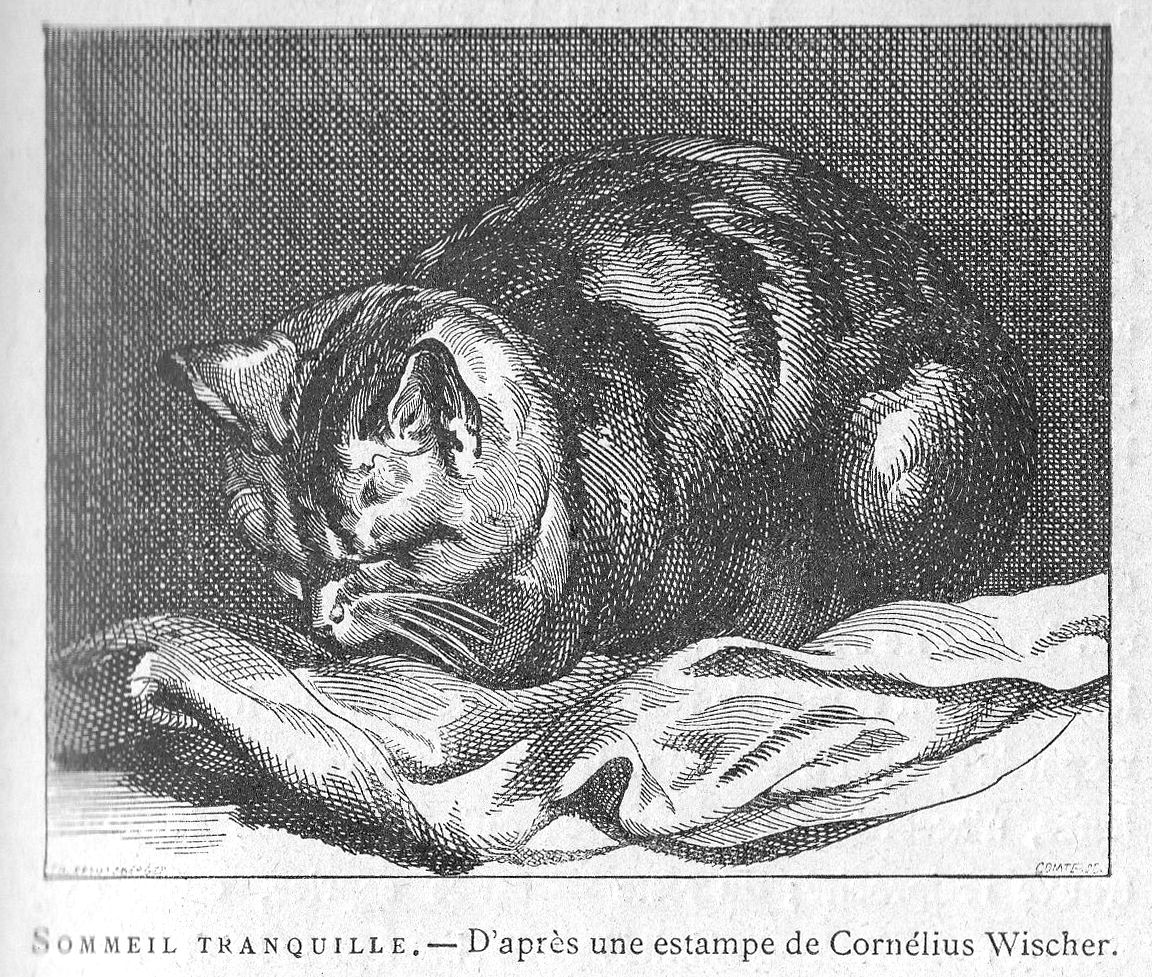
CHAPTER ONE - GENERAL CONSIDERATIONS ON THE CAT AND ITS CHARACTER
"If you have a cat that scratches and bites children, constantly breaks pots and pans, steals sausages, butter and meat, strangles chickens and small birds, without even trying to hunt rats or mice, the best thing to do is to drown him or give him the coup de grace.
"But if you have a nice puss who is the children’s favourite playmate, who does not cause the least disorder in the home and who diligently hunts rats and mice both night and day, then you would do well to take good care of him." This is the opinion of Lenz, and is one that also satisfies the stubborn denigrators and the staunch defenders of of Master Rominagrobis [Robinagrobis is a term for a big solemn tomcat].
However, surely the cat as well as the dog is entitled to the name of "friend of man"? It is a mistake to believe that the cat is only attached to the household hearth; it is not merely, as Buffon said, "the unfaithful servant kept only out of necessity", he is the most excellent and affectionate pet, who gives affection to those who reciprocate; besides – and is this a caprice, a question of character and affinity? – that the cat has women and poets as his admirers. In our century mainly, the most famous writers, Balzac, Hugo, Baudelaire, Gautier, Dumas junior, Sainte-Beuve, Champfleury, to name but a few, were avid felinophiles and did not think their standing was diminished when they professed their sympathies for this "tiger of the poor devils".
The cat is a philosopher and an independent. All his actions display a thoughtfulfulness that is much more developed than in certain other animals; he is often accused of using his claws too often, but I do not think there are any examples of cats scratching purely for the pleasure of scratching. Watch him when he plays, he keeps his paws soft and his claws sheathed, but if you hurts him he is not afraid to take an eye for an eye, a tooth for a tooth, even if he knows he is the weaker party; this side of his character is, in fact, prasieworthy.
Clever? He certainly shows this in a good many circumstances; in due course I will have occasion to quote many examples of his wisdom. For the moment, though, I will content myself with this remarkably curious fact reported by Champfleury.
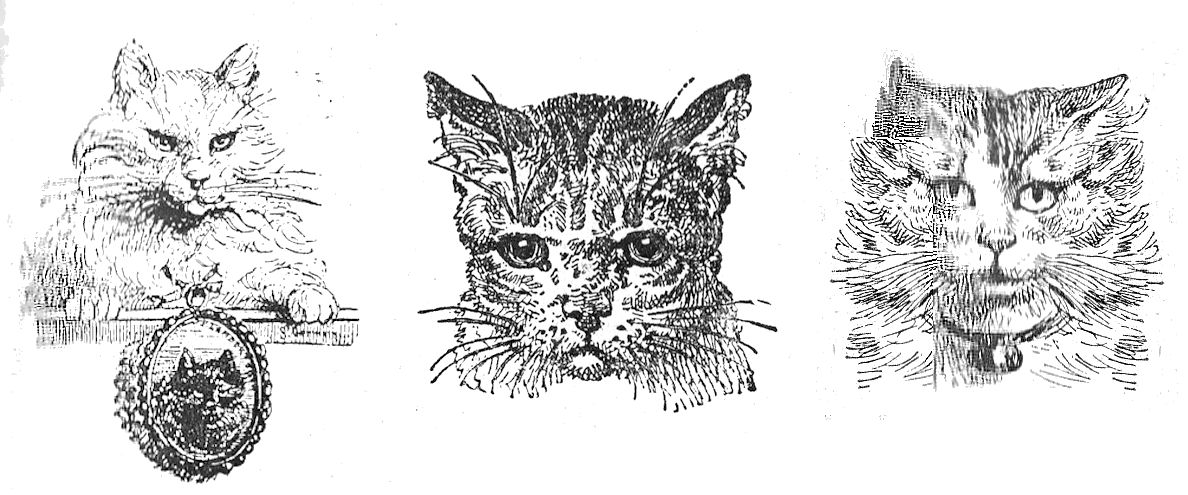
"Every day, after breakfast, I made it a rule to throw a bit of bread into an adjoining room, as far off as I could, so as to induce my cat to run after it as it rolled away. This custom I kept up for several months, and the cat always regarded that piece of bread as the tit-bit of its dessert. Even after it had eaten meat, it would await with attentive interest the minute when it was to start in pursuit of the morsel of soft bread. One day I held the coveted scrap in my hand, and swung it about for a long time, while the cat eyed it with a kind of patient eagerness, and then, instead of throwing it into the next room I threw it behind the upper portion of a picture which was slightly inclined forwards from the wall. The surprise of the cat, who, closely following my movements, had observed the direction in which I threw the bread, and its disappearance, was extreme. The uneasy look of the animal indicated its consciousness that a material object traversing space could not be annihilated. For some time the cat considered the matter, then it started off into the next room, evidently guided by the reflection, that, the piece of bread having disappeared, it must have gone through the wall.
"But the bread had not gone through the wall, and the cat returned, disappointed. The animal’s logic was at fault. I again attracted its attention by my gestures, and sent a second piece of bread to join the first behind the picture. This time the cat jumped upon a divan and went straight to the hiding-place. Having inspected the frame on both sides, it began to manoeuvre so dexterously with its paw that it shifted the lower edge of the picture away from the wall, and thus got at the two pieces of bread."
Isn’t this intelligence combined with learning, observation and reasoning? A dog, in the same situation, might have been quicker to solve the mystery; following his nose, he would have gone straight to the picture, and would have barked at the bread; the cat used reasoning, and acted from perspicacity.
As for the domesticity of the cat, I am sure no-one doubts this. Buffon, Flourens and a few others said that the cat was not a domestic animal because they viewed him as a loner who wanted to remain independent.
Certainly, if domesticity means changing an animal’s habits to make it agreeable and forcing it to be our pet, keeping it in the home in spite of itself, forcing it live amongst us against its will, then the cat is not a domestic animal in the same way as the horse, ox, goat or even the dog. The cat agrees to be our lodger, but does not want to give up his freedom or be our servant. Nevertheless, he is susceptible to developing attachments, sometimes to a very high degree, but we must let him proceed at his own pace and to solicit his flatteries. How many cats go to meet their masters returning after an absence? Here is a personal example. One day a poor abandoned cat took refuge in a friendly house where he knew he would find good food and good lodging. He immediately developed affection for the person who had first coaxed him and filled his poor hungry stomach. Ever since then, although he become very sociable with everyone, he reserved his greatest affection for his saviour.
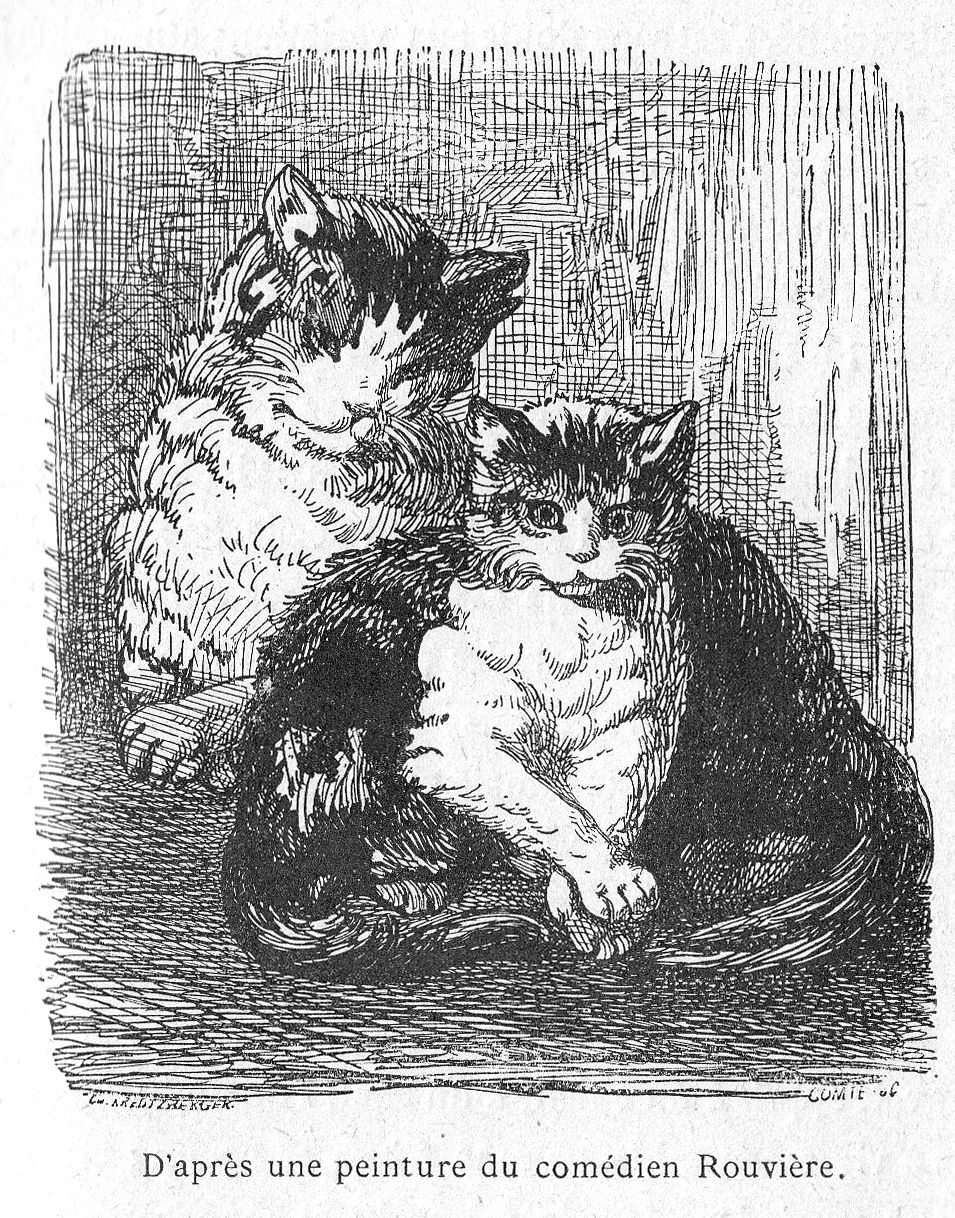
If that person was absent, the cat beacme sad and searched for her. When he didn’t find her he went to hide no-one knew where in grief, disappearing as long as his friend was not there. When she returned, the cat was quick to reappear, and what joy he showed on her return! It often takes little to win the affection of a cat, but it takes much less to lose that affection.
I have already said that a cat does not scratch without good reason, regardless of how one pretends otherwise ... The cat is never the aggressor, and it is therefore wrong to say that he is a traitor; but being susceptible to atmospheric electricity, he undoubtedly owes his changes of mood to atmospheric variations.
The cat’s nervous system - which is quite analogous to that of pretty women - is excessively delicate. It is by dint of teasing him that he is forced to pull out his claws. Fussing him for a prolonged period can also irritate him, because, although he likes the hand that strokes him, he resists becoming a slave.
The cat was also charged - what don’t we accuse our friend of? – with being neither sociable nor docile. Sociable? But he can live companionably with other animals; I have seen cats having dogs, monkeys, even rats as playmates, and even sharing their beds, while others live with birds, without ever trying to harm them, but often on the condition that the birds are not caged!
The Carthusian Vigneux-Marville, in his "Melanges," reports that in Paris there lives a lady who, by dint of perseverance in their education, brought a dog, a cat, a sparrow and a mouse to live together like brethren. The four animals slept in the same bed, and ate from the same plate. The dog, it is true, helped himself first, and amply; but he did not forget the cat, who kindly gave certain little bits she did not care for to the mouse, and left the crumbs of bread which the others did not covet, to the sparrow. [Note: "Melanges d’histoire et de literature." 1670.]
"After feeding-time came play-time," adds Vigneul Marville; "the dog licked the cat, and the cat licked the dog; the mouse played between the paws of the cat, who kept his claws carefully sheathed, and let it feel the velvet only. As for the sparrow, he flew about high and low, pecking first one and then another, without losing a feather. There existed, in short, the closest union between these comrades of such different species; and among them no-one ever heard of a quarrel, or the least disturbance; while it is impossible for human beings to live at peace with their fellows."
This same social harmony is found when one has several cats that are made to eat from the same dish; they immediately make an amicable household, something rare in dogs. Therefore, this animal, which is said to be selfish and hypocritical, leaves a share for its companions, while the dog, gentle and affectionate, will steal a coveted bone from his neighbor.
At the Jardin d'acclimatation in Paris a few years ago, a monkey that had been a victim of his own too joyful frolics had to have one of his arms amputated. He was isolated during his illness, and was given a cat for a companion. Nothing was more curious than to see the maternal care which the cat lavished on her friend, the monkey. This gave the director of the Garden, Mr. Porte, the idea of putting a collection of cats in the monkeys’ rotunda, where they lived on very good terms with the simians.
For example, the cat is quite an amazing curiosity, I could say ... feminine, it needs to know everything that happens, it asks about everything, it wants to find out about everything that affects it, and often without moving.
Is this a fault, and isn’t it the same in man, monkeys and also in little dogs? Look at that beautiful cat, curled up lazily in an armchair, eyes half-closed, a philosophical smile hidden in his whiskers; at the slightest sound he raises his ears, and looks around curiously; if he can see what intrigued him, he resumes his interrupted doze, otherwise, without seeming to take an undue interest in the thing, he gets up, stretches, arches his back and quietly learns what is going on. Can you call this malice? Would the cat be a cat, if he was not crafty?
Merimee, who liked to chat with his cat for hours, said of him: "He has so much wit! What a pity he is so sensitive! "Indeed, I’ll confess that touchiness is a defect in cats; but a stroke given at the right moment quickly puts things right.
The cat’s maternal instincts and the family feelings are very developed; I will return to this topic later with many examples that show that the cat’s critics have never known or studied it well.
It is often Sire Tomcat’s crime to not hunt mice. Whose fault is this? I don’t hesitate to say that it’s the master’s fault for neglecting his education. In spite of his greater independence, the cat is like a hunting dog; his instinct tells him to do something, but if he is not used to it, he soon neglects the task. This is so true that I saw in the same house, that of a friend’s painter's house, two cats: one that took mice, and the other that cared about it from the very first blow of his claws. The first had become accustomed to hunting mice from a young age; his master had had the patience to take mice from mousetraps and let them go under the little cat’s nose; in a few days the cat understood what was being asked of him and became a rabid hunter who slaughtered the small rodents. The other cat, his companion, had taught himself, and having plenty to eat here and there, he took a number of mice simply for sport.
So do not blame cats for faults in their training for which you are responsible.
A curiosity worth noting is that cats have a real passion for Valerian. When a cat comes across this plant, he jumps on it and rolls about, seeming to find incredible delights in this game. Why does valerian produce this effect? Is it because its smell is somewhat like that of the cat urine? Is it just a nervous phenomenon, the same, that occurs in those who like to pet cats? Didn’t Guy de Maupassant say that for him there was no "more delicate and more refined sensation than stroking their warm and vibrant coat?"
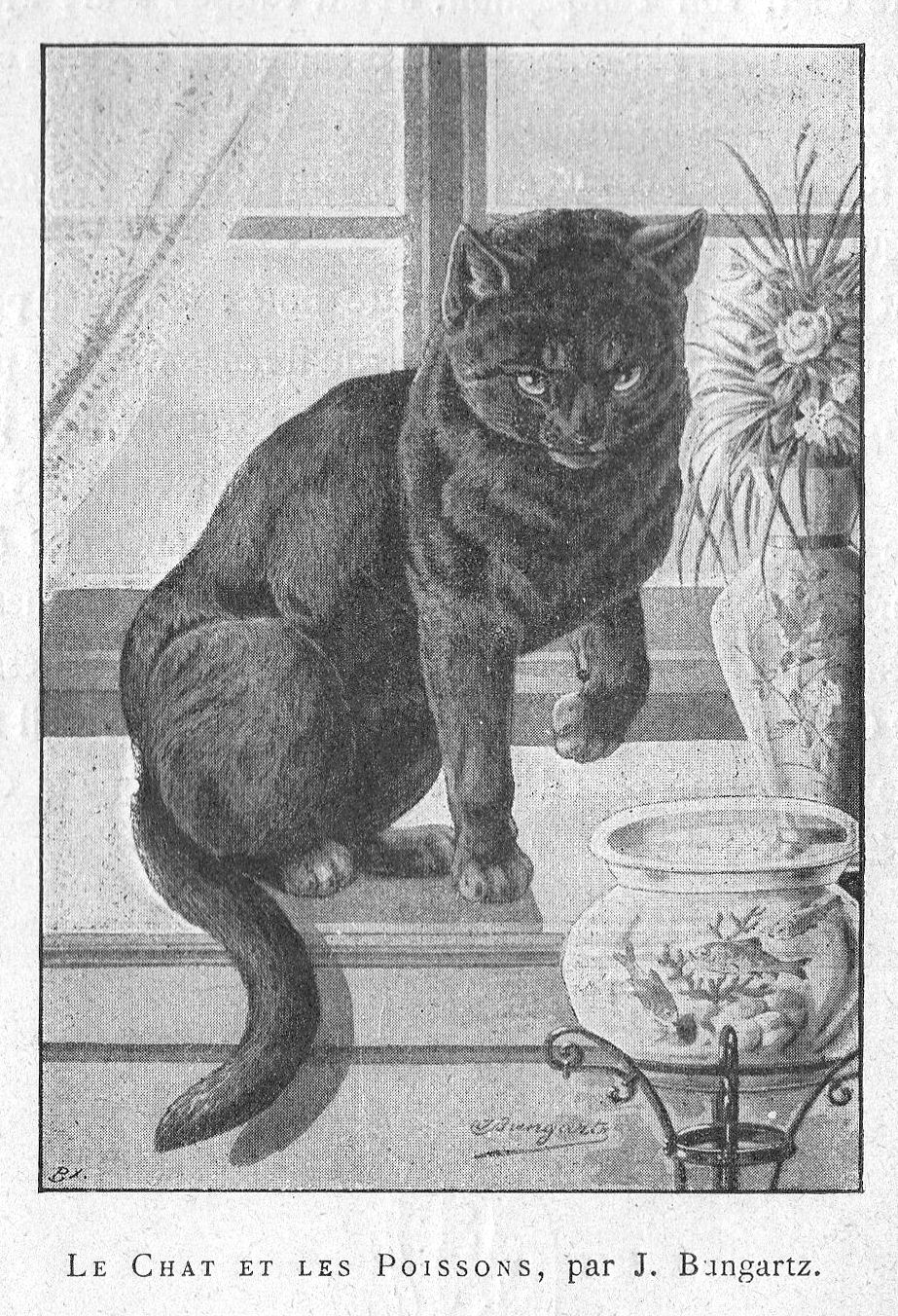
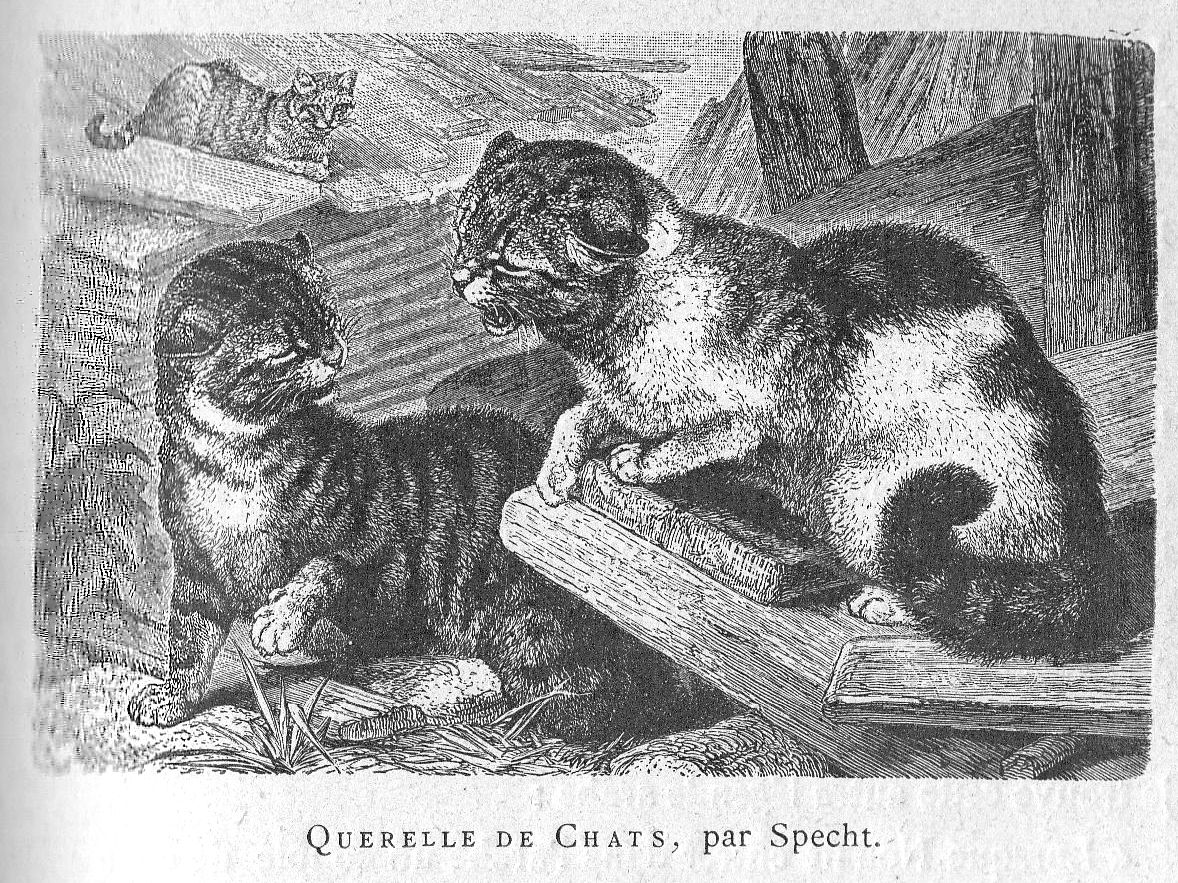
CHAPTER II – ORIGINS OF THE CAT
All the Felines are first cousins and the cat belongs to this big family, but it’s certain that no animal’s origins are surrounded by more legends. This is also a testimony of the interest and peculiar veneration of the cat by people in antiquity.
If we believe Greek mythology, Apollo, wanting to frighten his sister, created the lion. Diana, to simultaneously avenge herself and ridicule the so-called King of Beasts, created the cat in turn.
In his History of Cats, Moncriff repeated a curious legend about the cat’s origins, a legend which would have been told to him by a Moslem Minister or Mullah:
During the first days that the animals spent shut up in the Ark, astonished by the ship’s movements and by the new home they found themselves in, they all remained in their separate quarters without finding out much their animal neighbours. The Monkey was the first to get bored of this sedentary life; he proceeded to tease a young Lioness . . . The affair between the Monkey and the Lioness resulted in the birth of two Cats, one male and one female."
On the other hand, in the book of Darnisei (8th century of the Hegira) I found another Arab legend:
"When Noah brought two of each beast into the ark, his companions and other members of his family said to him, ‘What security can there be for us and for other animals as long as the lion lives in this boat with us?’
"The patriarch prayed and implored the Lord for an answer. Immediately, the King of beassts was gripped by illness and peace of mind was restored to the inhabitants of the ark. There is no other explanation for the origin of illness in this world.
"But there was another enemy, equally harmful, in the vessel - the mouse. Noah's companions pointed out to him that it would be impossible to keep their belongings and provisions safe from mice. After a new prayer addressed to the Almighty by the patriarch, the lion sneezed, and a cat came out of his nostrils. Since that moment the mouse become so fearful that it developed the habit of hiding in holes. "
It is said that the birthplace of the cat is Egypt; it is from there that cats spread to Europe, following the migration of rats.
The European wildcat may well be a different strain.
In his book: On the Origin of Species, Darwin had already dealt with cats; he returns to it in The Variation of Animals and Plants under Domestication, and gives the Orient as their birthplace; "Cats have been domesticated in the East from an ancient period; Mr. Blyth informs me that they are mentioned in a Sanskrit writing 2000 years old."
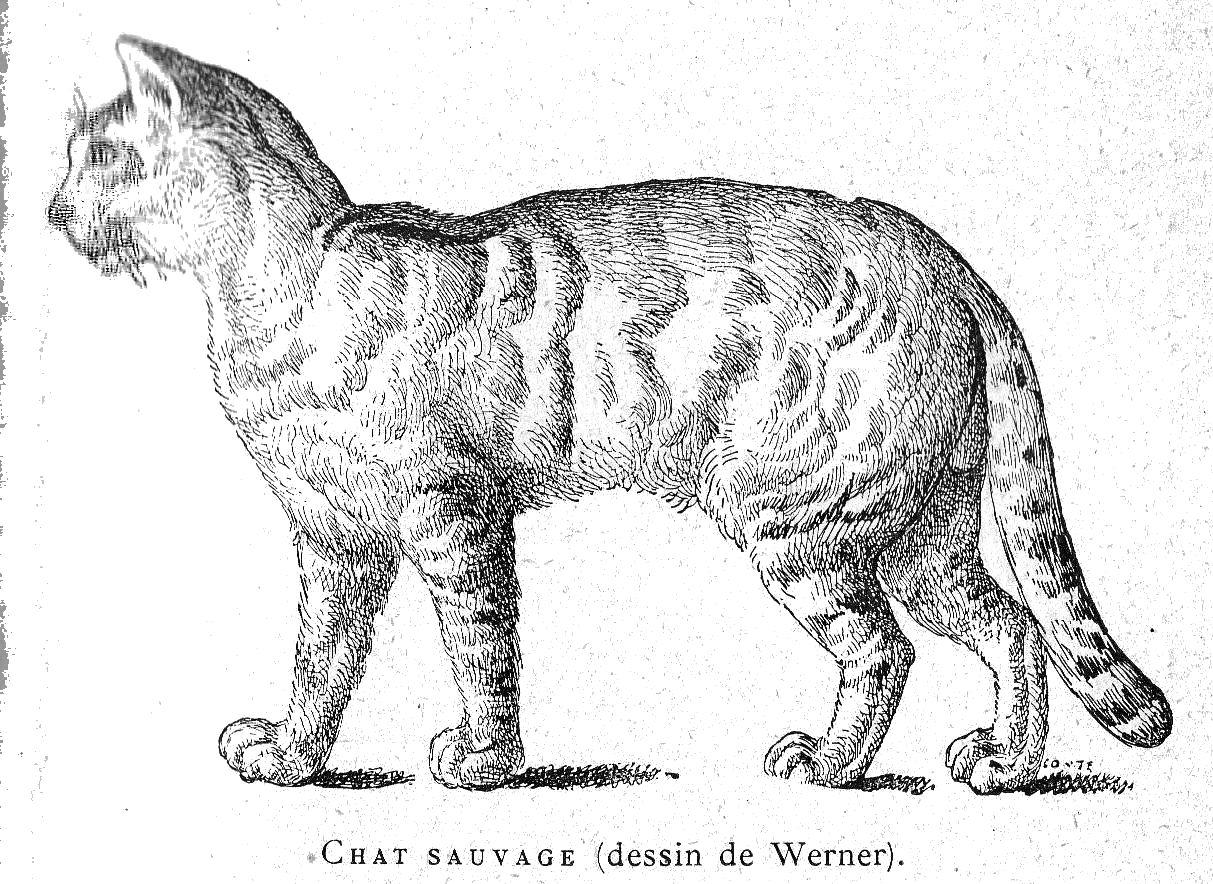
Where do we get the name "cat" from? According to Isidore, catus comes from cattare, to see; this animal is so named because it sees, it watches; catar is "look" in Provençal and "chater" in old French. Littre adds that we do not know if catus and catar are related; the late appearance of these words in Latin suggests that they are of Celtic-Germanic origin. In Arabic there is the word "gittoun" for a male cat, but Freytag doubts that this word comes from old Arabic.
The Latin term "catus" or "cattus" is found only in the relatively recent authors Palladius and Isidore, it is an expression of vulgar Latin. This word belongs to Celtic and German: Vil., Cat; kymri, kath; Anglo-Saxon, cat; old Scandinavian kottr; modern German, katze. In Walloon, we find chet; in Burgundy, chai; in Picard, ca or co; in Provençal, cat; Catalan, gat; Spanish and Portuguese, gato; Italian, gatto.
The generic name "catus" given by naturalists should, considering the original word "cattare," be written cattus.
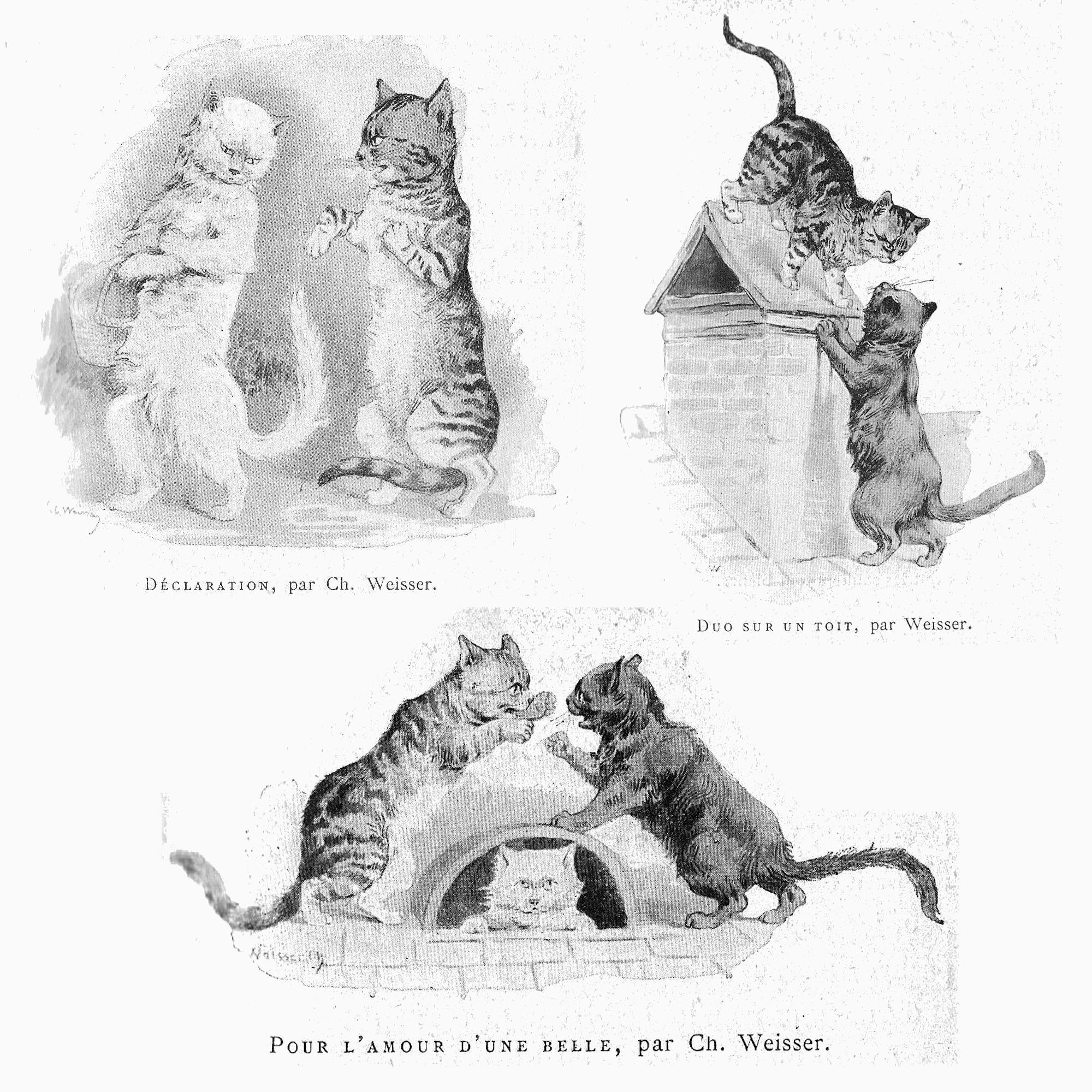
CHAPTER III – FOSSIL CATS
In prehistoric excavations, especially in recent years, we often find cats. This fact attests to the age of species in the genus Felis or Catus.
Fossilised bones have been found in caves in Germany, in caves in Kent in England, as well as caves in Belgium and Holland; and those in France, especially in Lunel-Viel. Cuvier pointed out this fact, but it was especially the naturalist de Blainville who took note of these discoveries. According to him, the number of known fossil species was fourteen; but more recent discoveries bring this number to at least twenty.
"Since the time, very remote, no doubt, where the degradation of the preceding formations produced the middle tertiary lands, to the point where our soil was covered with the enormous layer of diluvium which is observed over a large part of Europe, there has always existed, in the vast forests which covered it at that time, a fairly good number of Felis species of very different sizes, from that of a pony to that of the house-cat, for there were abundant Ruminant and Pachyderm populations, just as the modern Felids of Africa, Asia, and America have the herbivores of those parts of the world. With the decline and disappearance of these, possibly determined by the forests and by partial and general flooding, those carnivore species also declined and disappeared in natural harmony; but it seems that their disappearance preceded that of the other species less eminently disposed to eat only flesh."
Most of those species were more or less analogous to those which now exist in the two great parts of the ancient continent; but they also found some which do not currently appear to exist on the surface of the earth, and which fill gaps in the zoological series. Amongst others, one of those forms possed long, sabre-like canines in the upper jaw. Whatever determined a corresponding arrangement of the lower jaw and its front teeth seems to have been peculiar to temperate Europe. At least, up to the present time, we know of no living species of Felis, great or small great, that has anything analogous to Felis cultridens."
There were also quite a few remains of the cat in the kjoekkenmoeddings (peat bogs of Denmark), and the Neolithic lake dwellings of Robenhausen, Moossedorf, Wauwyl, Lüscherz, Moeringen and Rosen-Insel.
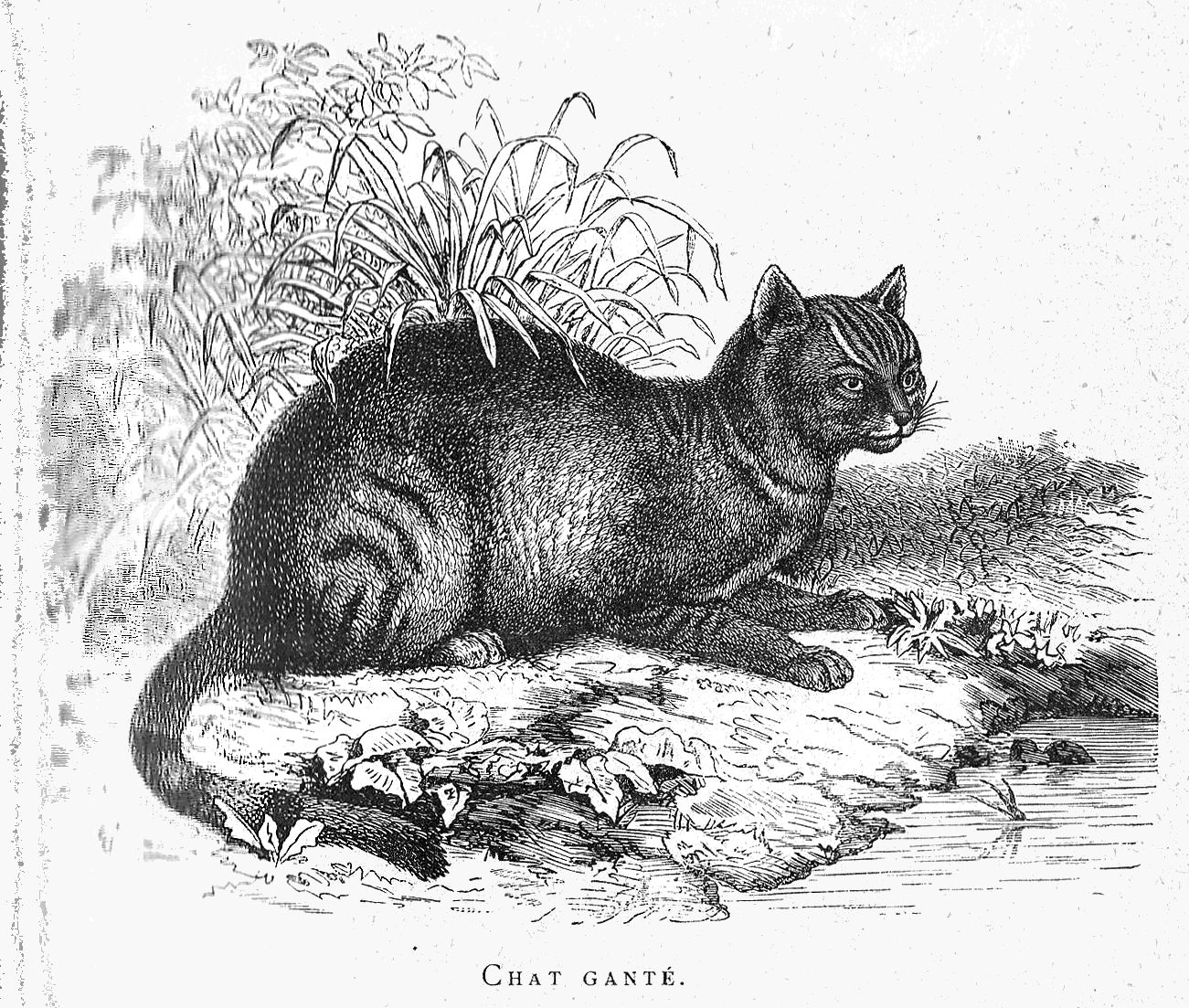
CHAPTER IV – THE CAT IN ANCIENT EGYPT
Egypt, as already mentioned, was one of the cradles, if not the origin of domestication and acclimation of the cat. All the monuments of ancient Egypt, as well as the large number of mummified cats and bronze representations, testify to the age of the cat in that country and that it was an object of veneration. This animal seems to have arrived there at the same time as the horse, that is, at the beginning of the new empire (about 1668 BC). The earliest known account of the Funeral Ritual does not go back beyond this period. It is at this moment that we see, in murals on the hypogea, the cat represented under the chair of the mistress of the house. The Egyptians gave the cat the name of Maï or Maau, which forms one of those onomatopoeias so often found in primitive languages. However, on some monuments it is given the name of Chaou. On the tombs at Thebes, which belong to the eighteenth and nineteenth dynasties (around 1638 and 1440 BC), there are cats in various forms. One of the oldest monuments depicting this animal exists ar the necropolis at Thebes which contains the tomb of Hana; on the stele stands the statue of this king, with his cat, Bou-haki, between his feet. King Hana seems to have been part of the eleventh dynasty; in any case, he predates Ramses VII of the twentieth dynasty, who explored this tomb.
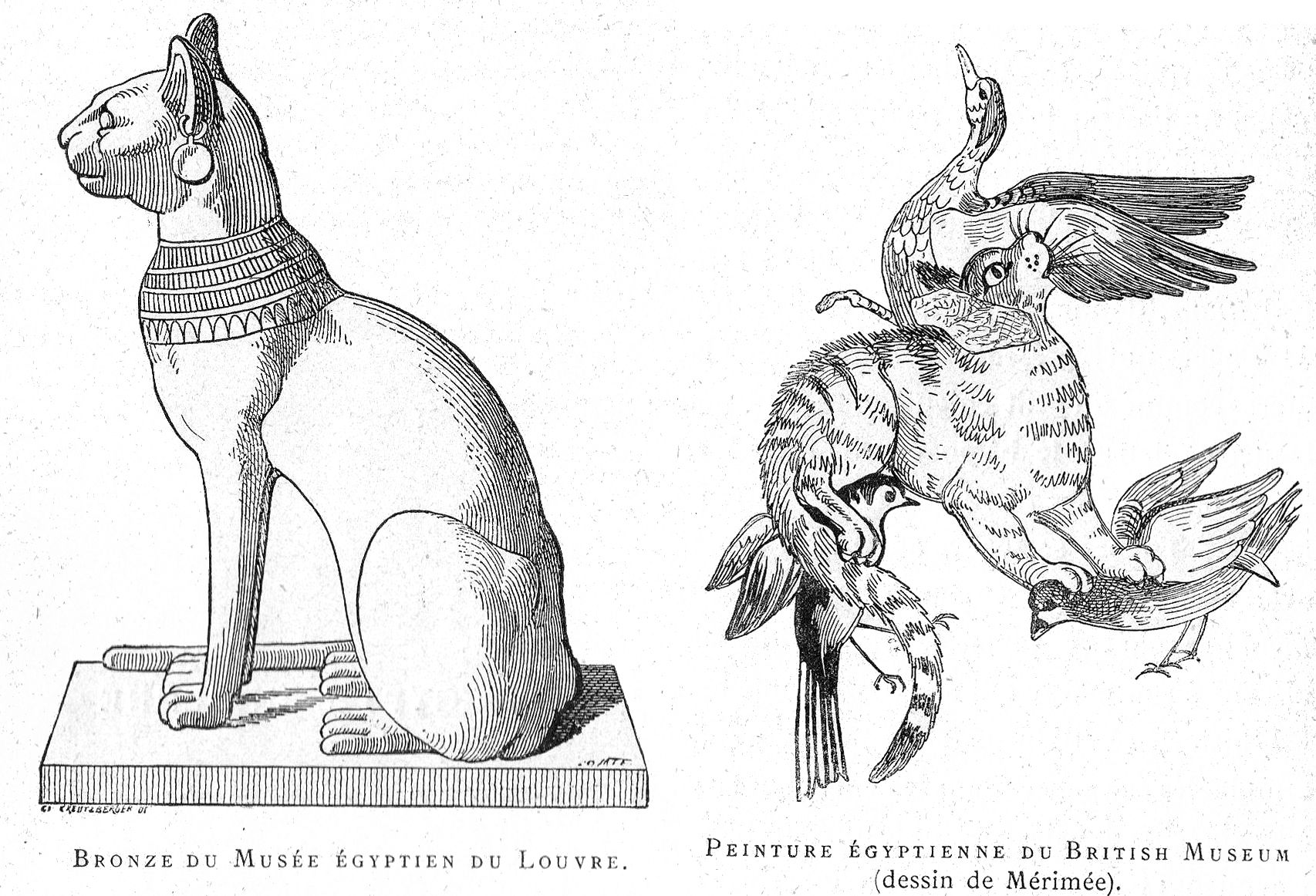
Among the Egyptian figurines in bronze or enamelled clay from our national museums, we often see a squatting cat, with the symbolic eye engraved on his collar, the emblem of the sun. In this case, the animal’s pierced ears were case, adorned with gold jewels.
The cat is also represented on some medals under the name of Bubastis; an Egyptian goddess. This goddess, a secondary form of Pasht, had the head of a cat and carried in her hand the sistrum, a symbol of world harmony.
The scarcity and usefulness of cats caused the Egyptians to place him in the ranks of their divinities very early on. This veneration was also based on their belief that Isis, to avoid the fury of Typhoon and the Giants, had evaded their pursuit by taking the form of a cat.
The Egyptians were extraordinarily adept at training animals, and they used the cat to hunt in the marsh. Today we would call it a miracle if a cat brought back a duck or waterfowl killed on a pond!
Wilkinson, in his Manners and Customs of the Ancient Egyptians, describes a Theban tomb painting which represents a boat in which a cat stands like a small dog against the knees of his master. His master is ready to launch the curved stick called the schbot, which is similar to the Australian bommerang. Another Theban tomb painting is in the British Museum. Merimee wrote to Champfleury about a drawing in which, according to this fragment, the cat played the leading part, bringing birds back to his master who was waiting in a boat.
The historian Wilkinson is reluctant to recognise domestic animals similar to our cats throwing themselves into water to retrieve birds wounded by the Egyptian throwing stick from the reeds; perhaps it was actually a kind of cheetah whose shape and pattern bore a certain resemblance to the cat?
The cheetah, moreover, is still used nowadays in the East for fishing. As for cats that fish, there are even some domestic cats that do this; I saw one, among others, that had extraordinary skill in catching small goldfish from a pond: a quick blow of the paw, and the fish was quickly snatched from the water.
Several scholars, among them Virchow and Nehring, investigated exactly which species the Egyptian cat belonged to; they saw a resemblance to the gloved or wild cat which would have lived in the domestic state in the Upper Nile regions i.e. in the Egyptian Sudan and Nubia. But these are only conjectures, because, according to a work of M. Piot-Bey, Secretary-General of the Egyptian Institute, summarizing his own observations as well as those of Dr. Osman-Bey, Ghaleb, and the explorer Schweinfurth, whom he consulted, the domestic cat of Ancient Egypt was exactly the same as the current cat. "The gloved cat (F. maniculata)," he wrote, "does not exist in the domestic state within the limits of present-day Egypt, nor in Nubia, where it lives in the wild. If this is the case, it must be admitted that there has been an error on the part of some scholars in the determinations made from the monuments, or that after having domesticated the gloved cat, the Egyptians abandoned it and adopted the European cat."
What is certain is that the cat was so venerated in Egypt that the most cruel torture awaited anyone guilty of killing one of these animals. Diodorus of Sicily wrote, about thirty years before the Christian era:
"He who kills a cat in Egypt is doomed to death, whether he has committed this crime intentionally or not; the people gather and kill him. An unfortunate Roman, who had accidentally killed a cat, could not be saved by either the Egyptian king Ptolemy or by the fear which Rome might have inspired."
However, the symbolism of the cat still remains surrounded by a certain mystery because of the stories of Plutarch and those of Horapollon who admit contradictory legends.
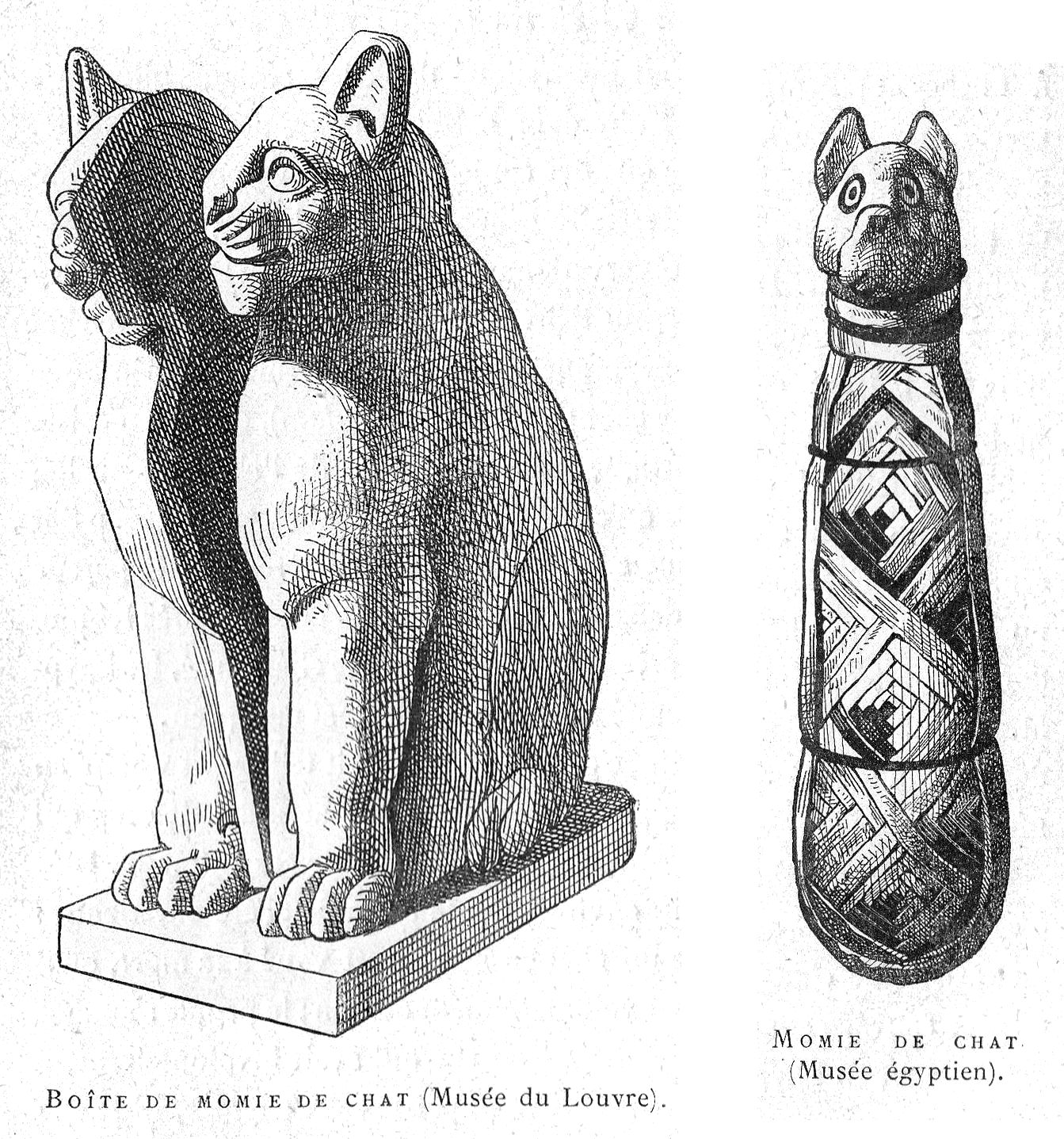
Horapollon discerneds a mysterious analogy between the pupil of the cat’s eye and the sun. The cat was adored, he says, in the temple of Heliopolis dedicated to the sun, because the size of the pupil of this animal’s eye is in proportion to the height of the sun above the horizon and in this quality represents the marvelous star. According to Amyot in his translation of the "Treatise of Isis and Osiris", Plutarch himself said that if one placed the image of a cat at the top of the sistrum, it was as emblem of the moon on account of the variety of her fur, and because she stirs at night, and because she bears a single kitten in her first litter, two in her second, three in the third, then four, then five until the seventh time, so that she bears twenty-eight in all, just as there are days of the moon. Now this is fabulous, but it is very true that the pupils of her eyes grow large and full at the full moon, and that, on the contrary, they contract and diminish during the course of the moon."
Modern science has abandoned the explanation of astral influences on man and on animals to necromancers; science explains these phenomena of vision by optics and conformation of the cat's eye.
What seems certain is that not only were temples raised in Egypt for cats; but that these animals existed in all homes. According to Herodotus, when the cat died all the inhabitants of the house shaved their brows in mourning. On the other hand, the author of the article "Cat," in the Larousse dictionary, tells us that it was the same in the temples.
"There was no temple, however, that didn’t have a family of cats. So children were dedicated to cats just as today they are dedicated to the Virgin, or white, or blue. The children thus consecrated wore around their necks a small medallion depicting the head of the cat at the Temple where the vow had been pronounced. The sale of these medals produced large profits for the priests of this cult. "
There are also many mummies of cats in the Egyptian tombs, Bubastis, Speos-Artemidos, Thebes and elsewhere; some have their faces painted. These mummies are extremely curious: very elongated, they resemble bottles of precious wine surrounded by straw braids. Today, there is no museum that does not have cat mummies. In some parts of Egypt, there are such great quantities that they are exported to England by the boat-load to fertilise the land. It's a new kind of guano, a sacred guano.
M. de Blainville speaks of a mummified cat whose skeleton was removed from its bindings for the Museum collections. "Mr. E. Geoffroy," he says, "has acknowledged G. Guvier who says that the animal does not differ in any way from our domestic cat, which is not exactly true. Since then, Mr. Ehrenberg, who has also had the opportunity to see the cat mummies, is assured that they came from a species currently found both in the wild and in domesticity in Abyssinia."
Various other cat mummies have led M. de Blainville to conclude that the ancient Egyptians possessed three species or varieties of cats still known today in Africa, in the wild as well as in the domestic state.
Moreover, in Egypt, Cat was not only a god, but the avenger of other gods.
The king of Persia Ochus, after having devastated Egypt and profaned its temples, committed a great sacrilege in the eyes of the Egyptians by sacrificing the sacred bull Apis that they adored. He was terribly punished by the Egyptians who had his body chopped into small pieces and fed to the cats eat.
In the vicinity of a small temple called the Cave of Diana, located in Beni-Hassan, wWe find many hypogea where cats dedicated to Pasht were placed.
Messrs. H. Cammas and Lefevre, who have devoted a passage to this subject in their Valley of the Nile, say: "The dried mummies of all the heroes of this race who were perhaps unworthy of divine honours are strewn on the ground. Their masters would have done much better to skin them first and use their furs; but they would not have thought they were paying a sufficient homage to the protectors of their granaries, to the friends of their houses. Cats are the living representation of the Penates and Lares [household gods]; they resemble the gods, for they love caresses and do not return them; there is in them something celestial and mysterious: they see at night as at day and their clear eyes seem reflections of the stars; their whole body reveals a light that appears at night when they pass their hand on their backs. Hence the law of emblems gave the head of a cat or a lioness, and phosphorescent eyes to Bubastis, the sacred name of the light which does not come from the sun, a luminous and nocturnal goddess; this is why cats are devoted to him. Thus the pontiffs shared their care between the statue of Pasht and a race of cats climbing the altars, or sleeping on the knees of the goddess. No gesture or action of these happy beasts remained unanswered: oracles were founded on their frolics and meowings, as elsewhere on the flight of the ibis or the vulture; it was the priests of Pasht who first recognized the imminence of rain, when the cats passed their paws over their ears.
"It may be supposed from the classification of the mummies that there was a rigorous hierarchy among the Cats. Some were wrapped only in bandages covered with hieroglyphics in their praise; others have been embalmed in families, with several in a single wrapping. The fur, colour, age, and many other considerations undoubtedly determined the degree of honour due to them. Unfortunately, the perfumes that impregnated the mummies have not fully preserved their remains, and grave-robbers have ransacked these tomb complexes for one to restore the dignities of those which have been thrown pell-mell into subterranean galleries by the centuries or the hands of profaners."
The Egyptian cat cult is lost in the origin of that country. For the people the cat was a beneficent god, to whom all qualities were attributed, for he was known from the start to rid the country of a scourge: the invasions of small rodents tht they hunted in the dwellings during the periodic floods of the Nile.

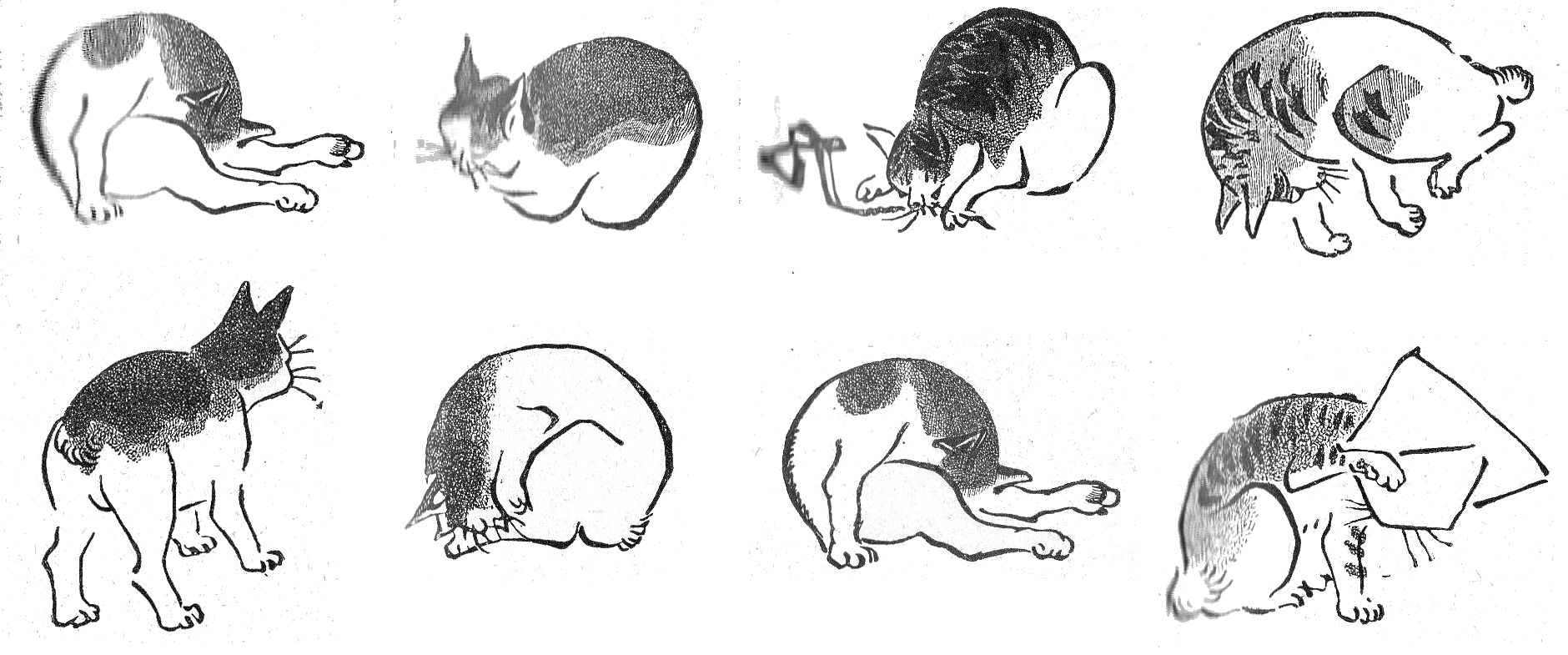
CHAPTER V – CATS IN THE ORIENT
Though the cat inspired the Egyptians to venerate it greatly, it was not the same throughout the ancient East. The Persians had no respect for the cat, it appeared that they would even use it to frighten some of their enemies. Thus, knowing the Egyptians’ fear of doing any harm to a caat, Cambyses, king of Persia, wishing to take the city of Pelusium, which was an Egyptian garrison, placed a great number of Cats at the head of the troops, and each officer and soldier carried a Cat as a shield. Through their fear of harming the Cats as well as their as their enemies, the Egyptians surrendered without a blow.
A distinguished Egyptologist, M. Prisse d'Avennes, while in the East collected considerable amount of material on the history of art, and was also occupied with the customs of the countries in which he lived.
In his notes this learned traveler speaks of the domestication of the cat in the eastern countries: ""The Sultan, El-Daher-Beybars, who reigned in Egypt and in Syria towards 658 of the Hegira (a.d. 1260), and is compared by William of Tripoli to Nero in wickedness and to Caesar in bravery, had also a particular affection for cats. At his death he left a garden, called Gheyt-el-Quottah (the cat’s orchard), which was situated near his mosque outside Cairo, for the support of necessitous and masterless cats. Subsequently the field was sold by the administrator, under the pretext that it was unproductive, and resold several times over by the purchasers. In consequence of a succession of dilapidations, it now produces only a nominal rentof fifteen piastres per annum, which, with some other legacies of the same kind, is appropriated to the maintenance of cats. The Kadi, who is the official administrator of all pious and charitable bequests, ordains that at the ‘Asi,’ or hour of afternoon prayer, between noon and sunset, a daily distribution of a certain quantity of the entrails of animals, and refuse meat from the butchers’ stalls, all chopped up together, shall be made to the cats of the neighbourhood. This takes place in the outer court of the Mehkémeh, or tribunal, and a curious spectacle may be witnessed on the occasion. At the usual hour, all the terraces in the vicinity of the Mehkémeh are crowded with cats; they come jumping from house to house across the narrow streets of Cairo, in haste to secure their share; they slide down the walls, and glide into the court, where, with astonishing tenacity and much growling, they dispute the scanty morsels of a meal sadly out of proportion to the number of the guests. The old hands clear the food off in a moment; the youngsters and the new-comers, too timid to fight for their chance, are reduced to the humble expedient of licking the ground. Anybody who wants to get rid of a cat, takes it there, and loses it in the midst of the confusion of this strange feast. I have seen basketsful of kittens deposited in the court, to the great annoyance of the neighbours."
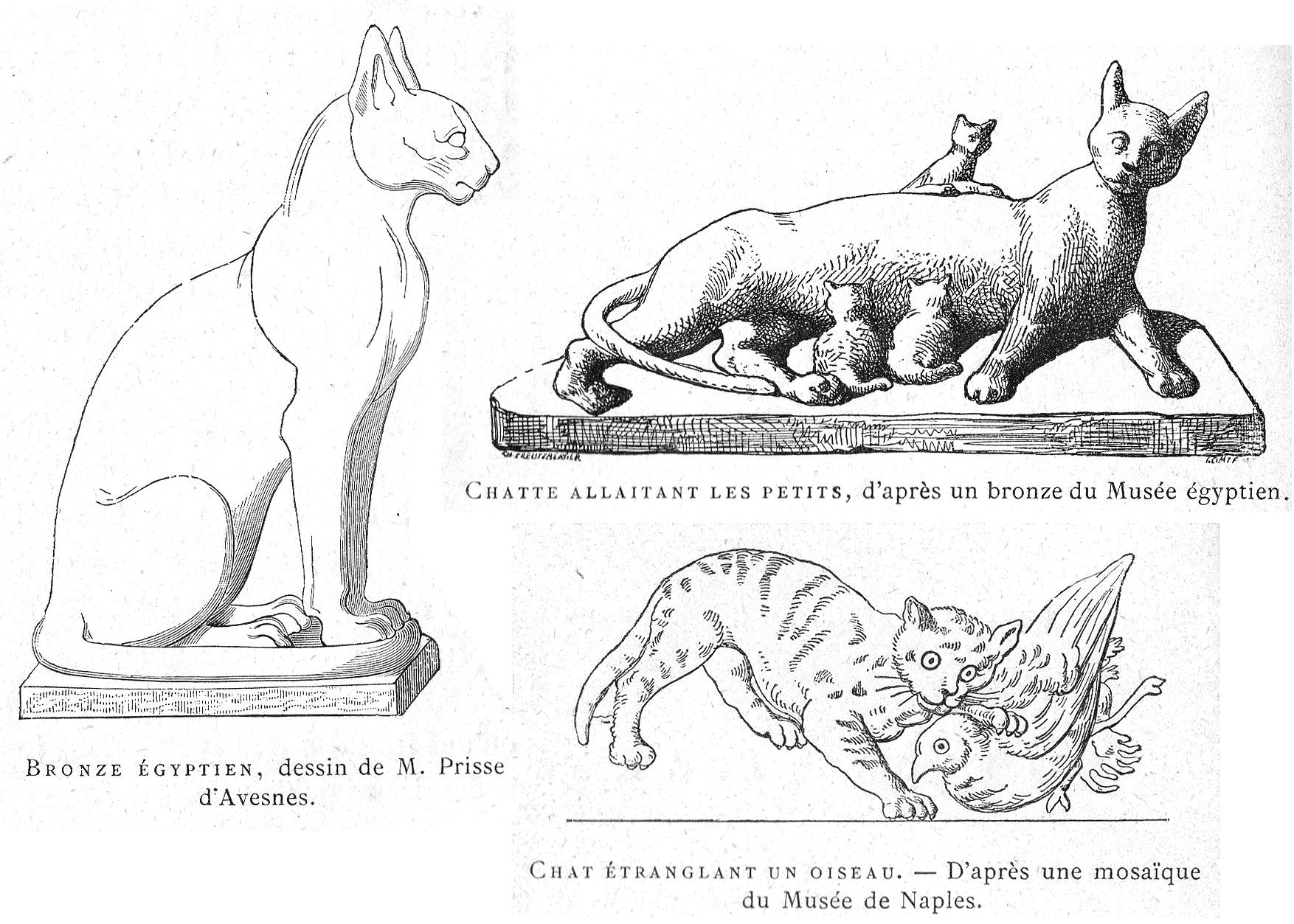
In some countries there are also similar refuges for cats: in Italy, in Florence, near the Church of San Lorenzo, in Switzerland, in Geneva, in England in several cities; in France itself, the endeavour was attempted in Paris.
"Cats in Egypt are much more sociable and attached than cats in Europe; probably because they are much better cared for, and treated with such affection that they are permitted to eat out of the same dish with their masters.
"The Arabs [1] have other motives for respecting cats, and sparing their lives. It is a general belief that Djinns assume the form of the cat, and haunt houses. Stories, as extravagant as any of those in the ‘Arabian Nights,’ are told in support of this superstition. The inhabitants of the Thebaid are even more credulous, and their imagination lends, unknown to themselves, a poetic form to the lethargic slumber of catalepsy. They hold that, when a woman gives birth to twins, boys or girls, the latest born (whom they call baracy) experiences for a certain period - in some instances throughout his whole life - an irresistible longing for certain kinds of food, and that, the individual frequently assumes the shape of various animals, and in particular that of the cat, in order to gratify this desire. During this transmigration of the soul into another body, the human being remains inanimate, like a corpse; but so soon as the soul has satisfied its appetite, it returns, and restores life to its habitual form. On one occasion I killed a cat which had committed sundry depredations in my kitchen at Luxor. A druggist in the neighbourhood came to me in a great fright, entreated me to spare all animals of that species, and informed me that his daughter, who had the misfortune to be baracy, frequently took the shape of a cat, that she might eat the sweetmeats served at my table.
[1.- The cat was the favourite animal of the Prophet Muhammad. (Note from A.)]
"Women condemned to death for adultery are thrown into the Nile, sewn up in a sack with a female cat. This refinement of cruelty is perhaps due to the oriental idea that of all female animals the cat bears the closest resemblance to womankind, in her suppleness, her slyness, her coaxing ways, and her inconstancy."
It is certain that the Cat was held in highly regard in India. Here is how the origin of its position was described in a manuscript which was communicated by Freret of the Academy of Inscriptions and Belles-Lettres [a French learned society devoted to the humanities, one of the five academies of the Institut de France], and which was reproduced by Moncrif in his "Letters on Cats":
"An Indian king named Salamgam had at his Court a Brahmin and a Penitent, both famous for their virtuousness. Between them there arose between them a rivalry and a dissension which often resulted in many marvellous events.
"One day, as these illustrious Champions disputed before the King over which of them was most virtuous, the Brahmin, outraged at seeing the Penitent share the Court’s esteem with him, declared loudly that his own virtue was so acceptable before the God Parabaravarastou, who in India is King of the First Order of Divinities, that he could instantly and at will transport himself into any of the seven Heavens to which the Indians aspire. The Penitent took the Brahmin at his word; and the King, whom they had chosen to judge their disputes, ordered him to proceed to the Heaven of Devendiren, and to bring back from it a flower from the Parisadam tree, whose mere odour conveys immortality.
"The Brahmin bowed deeply to the King, rose upwards, and disappeared in a flash. The Court waited in astonishment, but did not doubt that the Brahmin would lose the wager. The Heaven of Devendiren had never been accessible to mortals. It is the residence of forty-eight million Goddesses, whose husbands are one hundred and twenty-four million Gods, of whom Devendiren is Sovereign; and the flower Parisadam, of which he is extremely jealous, is the chief delight of his Heaven.
"The Penitent took great care to point out all these difficulties, and was already applauding the impending shame of his rival, when the Brahmin suddenly reappeared with the famous flower which he could only have picked in the gardens of the God Devendiren. The King and the whole Court fell to their knees in admiration, and the Brahmin’s virtue was exalted to the highest degree. Only the Penitent refused to give tribute. ‘King,’ he said, ‘ and you, too easily deceived Court, you regard the Brahmin’s access to the Heaven of Devendiren as a great marvel. It is only the work of a common virtue; understand that I send my Cat there whenever I please, and that Devendiren receives it with all sorts of friendliness and distinctions.’ Without waiting for a reply, he made his Cat ‘Patripatan’ appear and said a word in its ear. The cat rose up, and in full sight of the rap Court, was lost in the clouds, pierces through them into the Heaven of Devendiren, who took him in his arms, and gave him a thousand caresses.
"Up to that point, the Penitent’s project went marvellously; but the favourite Goddess of Devendiren was struck, as though by a thunderbolt, with such a fancy for the amiable Patripatan that she was determined to keep him.
"Devendiren, to whom the Cat had first explained the subject of his embassy, opposed this. He argued that Patripatan was awaited with impatience at the Court of King Salamgam; that the Cat had left there risking the reputation of a Penitent, and that the greatest affront one could do to anyone was to steal his Cat. The Goddess would not listen, and all that Devendiren could get from here was a promise that she would only keep Patripatan for two or three centuries, after which she would faithfully return it to the awaiting Court. Salamgam, however, was becoming impatient when the cat did not return, and only the Penitent kept his composure. Eventually they waited for three whole centuries without any invonvenience except impatience, for the Penitent, by the power of his Virtue, prevented anyone from growing old.
"When this time had elapsed, the skies suddenly became beautiful and from a thousand-coloured cloud emerge a throne formed of various flowers from the Heaven of Dvendiren. The Cat was sitting majestically upon this throne, and when he arrived in front of the King he presented to him, with his charming paw, an entire branch of the tree bearing the flower of Parisadam. The whole Court proclaimed his victory and the Penitent was universally congratulated, but the Brahmin, in his turn, dared to dispute the Penitent’s triumph. He argued that the virtue of the Penitent had not achieved this great success on its own, and that everyone knew of the great liking which Devendiren and his favourite Goddess had for Cats, and that doubtless Patripatan, in this marvellous adventure, deserved at least half the glory. The King, struck by this judicious reflection, dared not decide between the Penitent and the Brahmin, but all opinions were united in admiration for Patripatan, and after this event the illustrious Cat was the delight of the Court, and dined each evening seated on the Monarch’s shoulder."
For the more practical Chinese, the cat, just like certain breeds of dogs, is a national dish. Far from serving cat in place of rabbit, which according to legend happens in some Parisian eating houses, in China the cat is considered a luxury dish. Father Lenoir says in his accounts of travels in the Far East that in the food stores of most cities, huge cats are hanging at stalls, still with their tails and heads. On all farms, these animals are attached to small chains to be fattened with leftover rice; they are big cats that look quite like those of our countries. The enforced idleness facilitates and accelerates their fattening.
In Turkey, as in all Moslem countries, cats have always been the object of special care. In his "Voyages in the Levant," the naturalist Tournefort writes:
"In Constantinople, cats are treated with the same respect as the children of the house. We see nothing but foundations, set up by people of the highest consideration, for the maintenance of Cats that wish to live in independence. There are open houses where they are received with politeness, and they can spend the nights there."
Didn’t Jonatas recount that the wife of emperor Constantin Monomagne of Constantinople, who lived in the 11th century, had a favourite cat that was served food in golden dishes at the imperial table?
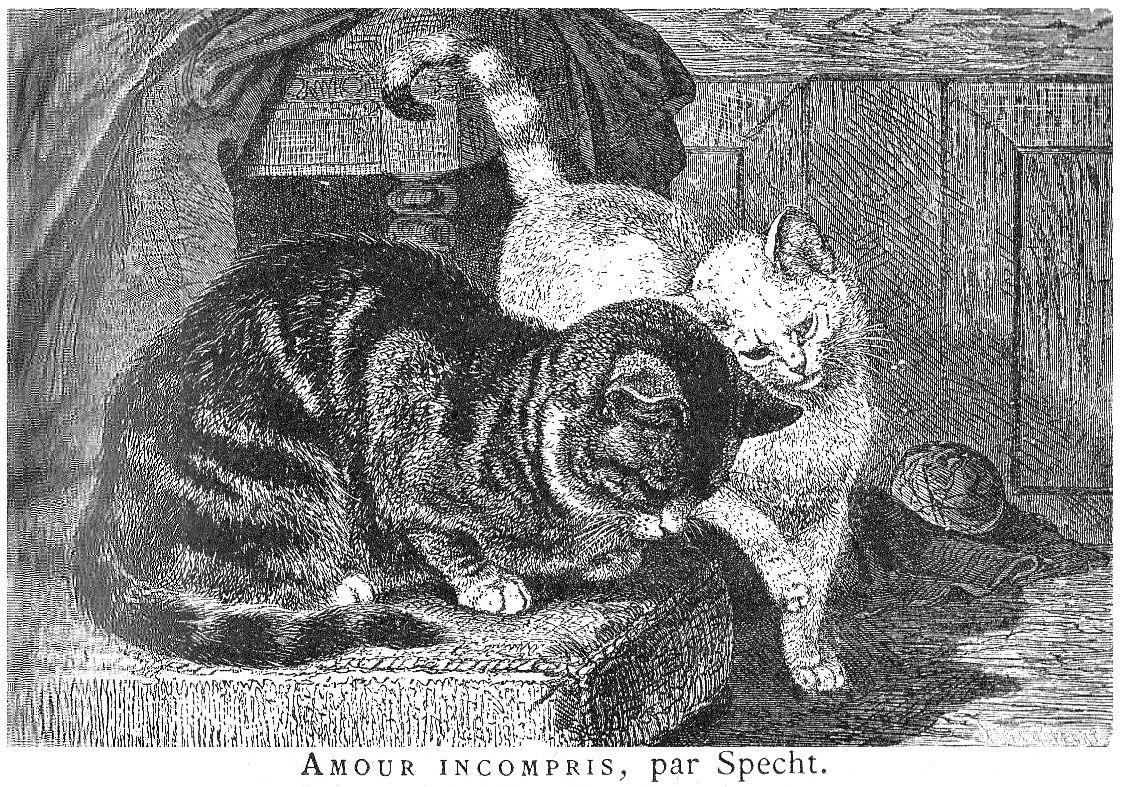
CHAPTER VI – THE CAT IN GREECE AND ROME.
BEFORE spreading to neighbouring countries, the cat remained confined to Egypt for a long time. It is not mentioned once in the Bible, and seems to have been completely neglected by the Greeks and Romans. Although not unknown to the latter, the cat was not commonly kept as a domestic animal; in Rome they used ferrets and weasels to get rid of small rodents. Moreover, if the cat had been a household animal the Romans, who liked depicting scenes of indoor life, would certainly not have systematically neglected it. We don’t find the cat mentioned by the Greek historians before Herodotus, and Aristotle describes it with such great accuracy, that it is quite obvious that his description was made from life. Perhaps in Athens and Rome this animal suffered the opposite of its popularity in Egypt, because, when it comes to the poets, it is only found among those of the decadent era (the decline and fall). The Greeks and Romans probably did not care to bring these useful hunting animals into their homes because the cat’s nature seemed too wild for the quiet indoor life.
Between the Egyptian artists of the XVIIIth Dynasty (1638 BC), who decorated tombs with representations of cats, and the poet Theocritus, who was born 260 years before the Christian era, we do not find, strictly speaking, any domestic cats except for the one in the charming dialogue of the Syracusaines where Theocritus is making a mistress scold her slave:
"Ennoa, bring water!" cries Prassinoé. "How slow she is! The cat wants to lie down and rest softly. Bestir thyself, then. Quick with the water, here. . ."
By comparing cats with a lazy slave he gives the idea of the animal which has come down to our time.
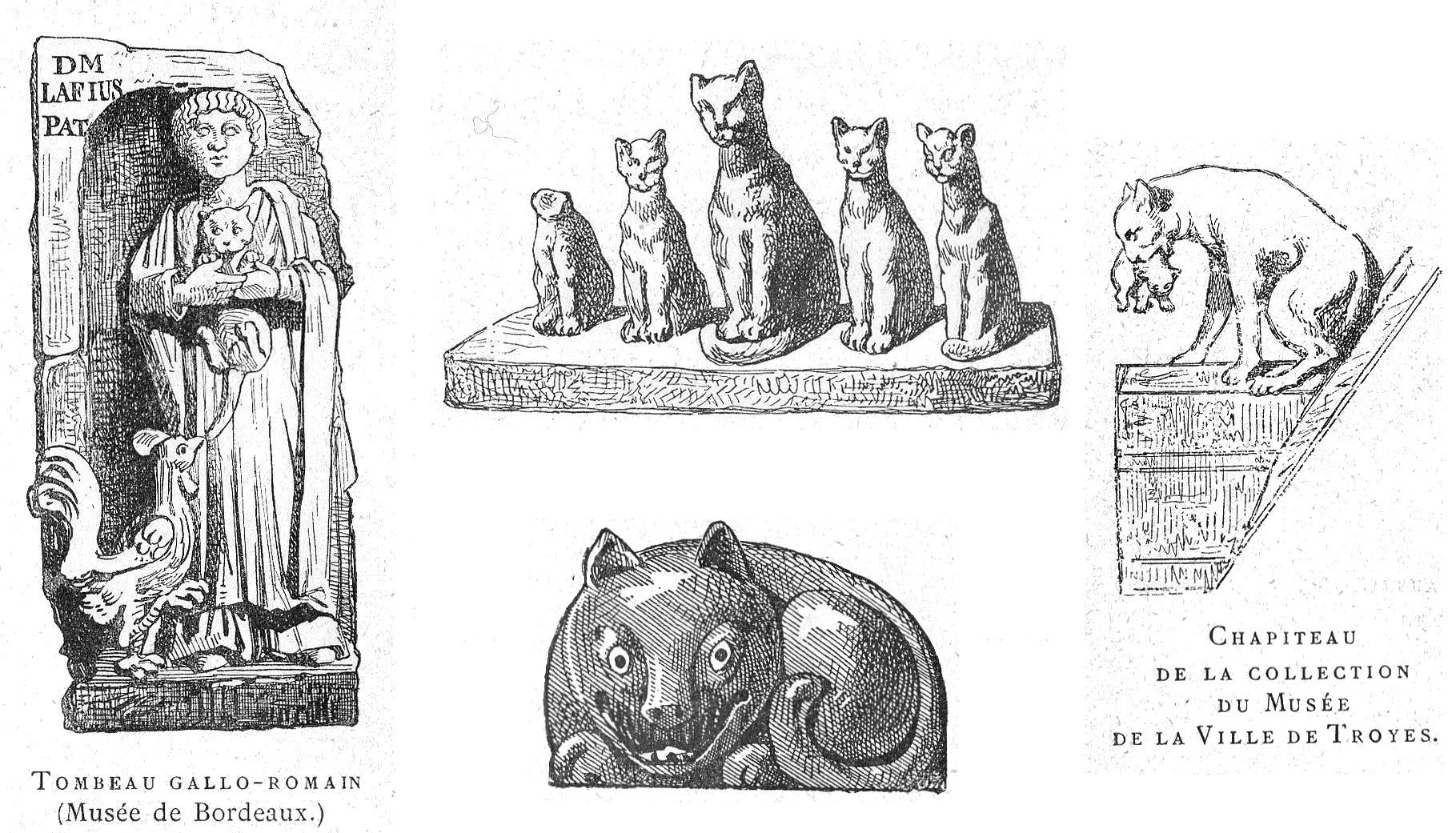
The Minor Poets of the decadent era (the decline and fall) had a deep contempt for the cat; they accused him of many faults and spread imprecations about his voracity and thievery.
Agathias, an epigrammatist scholar of the Lower Empire at Constantinople, who lived from 527 to 565 under the reign of Justinian, has left us two funeral epigrams in which the cat does not play a very fine role.
"O my partridge! Poor exile from the rocks and the heath, thy little willow-house possesses thee no longer! At the rising of the rosy dawn no more dost thou rustle thy wings in its warmth. A cat has torn off thy head. I seized the rest of thy body, and he was unable to appease his odious voracity with that. Let the earth not lie lightly on thee, but cover thy remains weightily, so that thine enemy may not disinter them."
The second epigram is even more nasty:
"The domestic cat which has eaten my partridge flatters himself that he is still to live under my roof. No, dear partridge, I will not leave thee unavenged, but on thy grave will I slay thy murderer. For thy shade, which roams tormented, cannot be quieted until I shall have done that which Pyrrhus did upon the grave of Achilles."
So, for having eaten a partridge, the unfortunate cat was to be sacrificed to ghosts of its victims.
His disciples outdid their master. Damocharis, a pupil of Agathias, touched by the grief of his master, composed in his turn the following epigram:
"Detestable cat, rival of homicidal dogs, you are one of Actaeon’s hounds. In eating your master, Agathias’s, pet partridge you were devouring your master himself. And you, base cat, thinks only of partridges while mice play, reveling among the dainty food that you disdained."
Equating the cat, rival of homicidal dogs, to the hounds of Actaeon, seems to us somewhat exaggerated. Maybe Damocharis was just being ironic?
Champfleury, who had visited a large number of museums devoted to antiquity, said he had never seen a cat depicted on a vase, medal or in a fresco. Yet there are several representations of marble or bronze cats in the Vatican Museum. In the Medal Cabinet, there is an engraved carnelian depicting a scepter and an ear of corn separated by the inscription
LVCCONIAE FELICVLAE
"The inscription upon the seal," writes M. Chabouillet, in his catalogue "gives us the names of its owner, a woman named Lucconia Felicula. Felicula signifies ‘Little Cat.’ The carving indicates a debased period in art."
A mosaic at the Museum of Naples - the art of mosaic dating from the reign of Sylla, about a year before the Christian era - represents a cat crunching a bird; and Millin, in his "Voyage to the South of France," says that he saw another mosaic at Orange - a cat attacking a mouse.
These are the rare monuments in our museums dedicated to cats during the age of decadence.
As we advance through history representations of cats become more frequent. Thus at the Bordeaux Museum, in the Antiquities Room, there is a tomb dating back to the Gallo-Roman period. It represents a young girl holding a cat in her arms and with a cockerel at her feet. Just as children were buried with their toys at that time, they were also depicted with their pets.
Let’s not forget that this monument dates to at least the fourth century.
If the Greeks and Romans scoffed at the Egyptians' use of cats on the African coast of the Mediterranean, the same was not true of the Etruscans and Tarentines who seem to have been the first in Europe to use this animal. Because of their direct trade with the Archipelago and the Carthaginians, together with manufactured products they received cats from Egypt. These were kept maintained not only as exotic animals and status symbol pets, but also to destroy mice.
In Gaul, as in Rome or Greece, the cat does not appear to have been a domestic animal. Also, among the many terracotta figurines made by the potters of the Allier, in which representations of animals are so common, we never find cats.
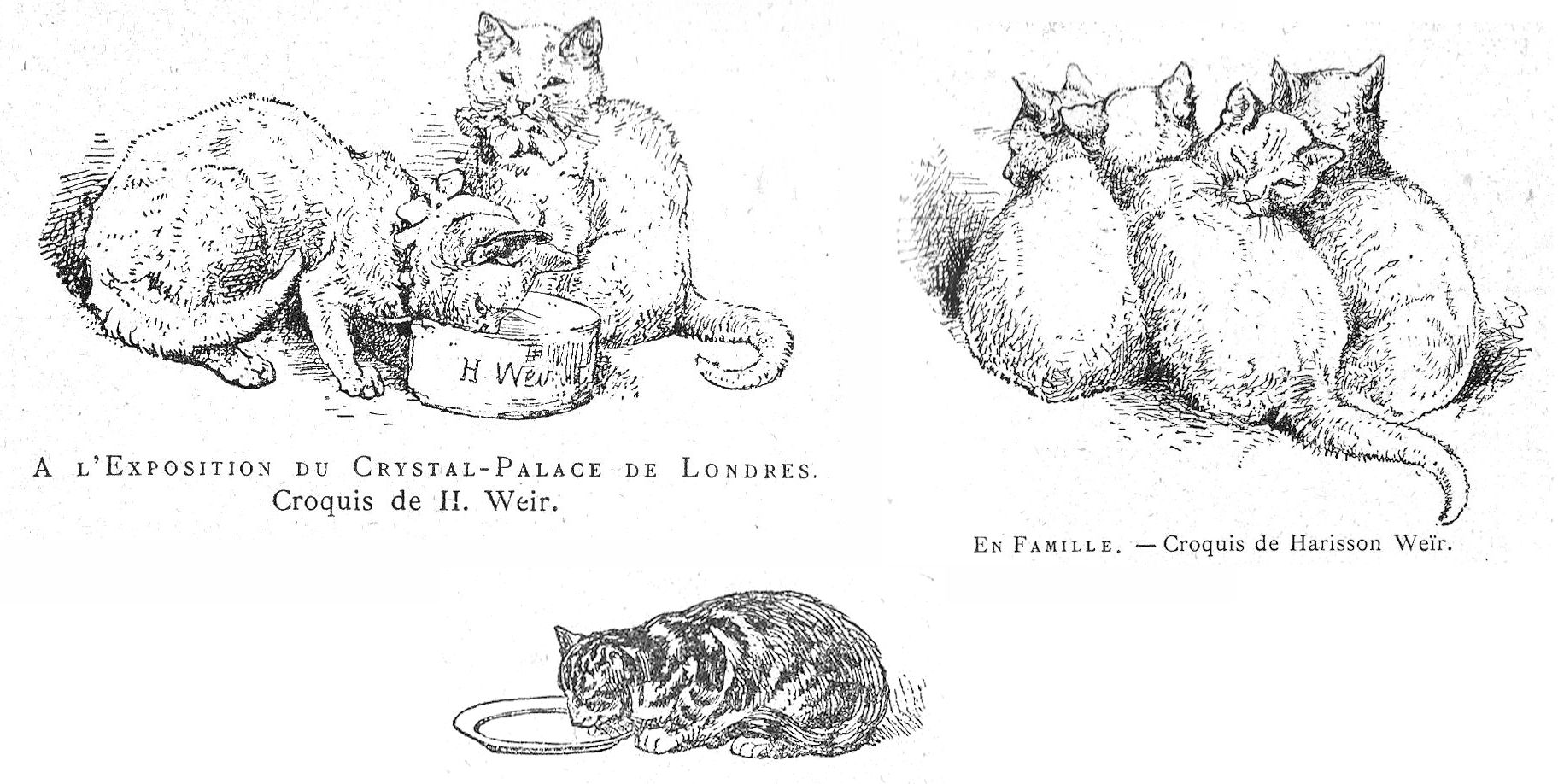
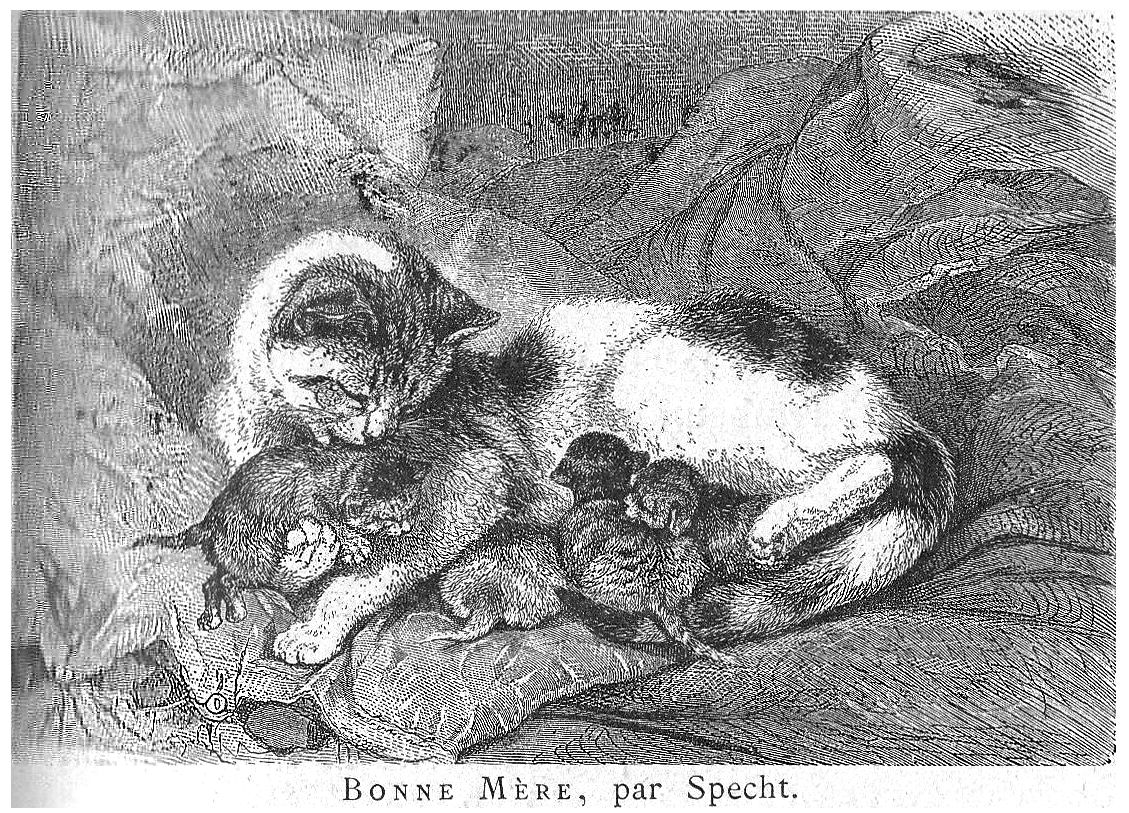
CHAPTER VII – CATS IN THE MIDDLE AGES.
In Europe before the 10th century, cats do not seem to have been well known as they are now.
Brehm quotes a law from Wales that proves the cat was not very widespread in the British Isles in the first half of the tenth century and, therefore, was very valuable.
"The code of Wales contains a provision introduced by Howel Dha or Howel the Good, who died in the middle of the tenth century, who fixed the value of the domestic cat and the fines that were inflicted on those who tormented, killed or wounded the animal. It also fixed the price of a young cat who had not yet caught a mouse; from the moment he caught his first victim, this cat doubled in value. The buyer had the right to demand that its ears, eyes, and claws be well formed, that the animal should be a good hunter of mice, and if it was a female that she would raise her young ones well. If the cat sold had some defect, the buyer could be reimbursed a third of the purchase price. Whoever killed or stole a cat on the Prince’s estate had to reimburse him him with a sheep or lamb, or was obliged to give the quantity of corn necessary to cover the dead cat when it was suspended by the tail, so that its nose touched the ground."
This is a very interesting law for scientific history. It shows us that, at that time, the domestic cat was considered a very precious animal and that it could not be descended from the wild cat, because wild cats existed in large numbers in England at that time and that it would not have been difficult to procure as many kittens as one wished in order to tame them.
For a long time the cat was regarded as a diabolical being; he was seen as the companion of wizards. Romantic painters represent cats alongside oddly shaped owls and chemistry retorts, showing them as part of an alchemist’s accessories.
The Middle Ages, when sorcerers and scientists were burned, it was also necessary to burn their cats.
Regarding this affinity between cats and sorcerers - not being very well versed in the occult sciences myself - I spoke to one of the specialist writers who have been prominent in recent years, Mr. Jules Delassus, who kindly sent me these lines on the witches’ fateful cats.
"Black cats and skulls are necessary accessories for any work of demonology. They always appear sad in the necromancer’s hovel. They are the lugubrious and evil larvae that haunt the accursed dwelling of these workers of evil. The arsenal of criminal evocations of Satan always comprises, alongside the nails of the coffin of a tortured person, the horns of a goat that has had congress with a woman and the skull of a cat fed on human flesh.
"For a long time black cats were associates of sorcerers - don’t we see them in the Sabbat with goats and toads? They often shared the fate of their mistress and perished in the holy flames of the pyres. In an old custom, cats were burned alive in the fires of St. John.
"It's because the black cat really does have a demonic appearance. Sitting with his tail curled on his paws, in a rigidly hieratic pose, he darts his green eyes like those of idols, wherein sparkle strange dreams. He seems to be the quizzical and evil incarnation of the Spirit of Evil. And when, on dark nights, the lusty tomcats and the lithe pussies cavort on the jagged gables, performing their mad danses to the sound of their own hellish music, we think we are hearing the Wild Hunt or the screams of a Sabbat. Their desire is accompanied by lamentable cries, their sensuousness seems to reach the point of sadism, a very sure indication of the devil’s presence. The black cat beside the witch fills the role of Incubus. Always flitting around, he is a true lover. In bed, he curls up under the covers in the hollow of her body and kneads her moving flesh. His hard, bristling, tongue provokes painful pleasures analogous to those of a satanic acquaintance; indeed, like the cat's tongue, the devil's chin was covered with backwards-pointing spikes.
"As a sorcerer’s companion, the cat is a dangerous beast to encounter. A very old proverb says ‘Whoever loves cats will have a beautiful wife.’ It's a new ruse of the accursed who use the cat as a charm to bewitch women whom he wants to bring to damnation. For it is certain that a man who has a beautiful wife will surely go to hell. Cats and women are creatures of the devil. Their eyes have extraordinary powers of fascination, a sign of considerable nervous energy. Sorcerers, who expend a great deal of nervous energy in their spells, gain an advantage in surrounding themselves with beings possessing large quantities of this nervous energy. These beings are somehow reservoirs from which lost fluids were recovered. This explains the use of animals in sorery: cats, goats, and toads all have phosphorescent eyes and a fixed, worried attitude that is somewhat disturbing.
"As well as this, the cat has the same character as the sorcerer. He is withdrawn and independent. He despises the world that he uses to satisfy his sensual inclinations. He is an anarchist, but very perverse and skilful. Calm and haughty, he traverses the vulgar society that hates him without defiling himself, but at mating time he seems to abandon his serenity. Distraught, he cries his complaints of the damned to the moon. Perhaps he regrets his past splendor, when, devoted to pure Isis by colleges of initiates, he had his venerated sanctuaries in Egypt. Then his balmy remains rested in the necropolis of Bubastis next to the beautiful bodies of queens and powerful pharaohs, while today his ghostly carcass is left to wither in gutters exposed to the winds."
M. Edelestand du Meril, in a pamphlet on popular customs, writes that "it was thought to encourage good morals by throwing a few cats into the fires of St. John." Indeed, the abbot Leboeuf quotes a receipt of one hundred one hundred sols parisis [Parisian Sols (coinage of the period)] subscribed by a certain Lucas Pommereux in 1573 "for having provided during three years all the cats that were necessary for the fires of the Saint-Jean, as customary".
These cruelties appear attributable more to the fear of sorcerers and cats than to any violent desire to reform manners, as the Renaissance is not exactly a shining example of purity in its behavious. However, in the Middle Ages it was still customary to attach cats under the windows of remarried widows as confirmation of a proverb relating to the cat’s lecherous nature, the cat is far less indecent than the dog. Certainly we often hear the cat speak of love, but the dog chooses the street for its boudoir, while the cat hides in the least frequented places. The dog shows in daylight those passions that the cat wraps in the mantle of darkness.
This deplorable custom of throwing cats into the fires of St. John was preserved for a very long time, as we can see from this quatrain accompanying a crude drawing dated at the end of the seventeenth century:
A cat, who, with a brief run,
Went up the fire of Saint-Jean-en-Grève;
But the fire did not spare it,
And made it jump up and down.
This custom still persisted in Metz in 1750 and it was not until around this time that the Marechal d'Armentieres persuaded her husband to suppress this pointess slaughter of cats.
In his Letter on Cats, Moncriff recounts this scene:
"In this regard, each year at Metz there is a ceremony that is very shameful to the intellect: The Magistrates come gravely into the public Square and reveal some Cats in a cage placed on a Pyre, which is set on fire with great formality. At the frightful cries which are uttered by the poor Beasts, the people believe that they are also hearing the suffering of an aged Sorceress who is supposed to have metamorphosed into a Cat on the occasion when they were going to burn her."
Not long ago - in the middle of the nineteenth century - these cruel entertainments were still practiced in the canton of Hirson in Picardy. On the first Sunday of Lent, the ‘Bihourdi’ was celebrated; as soon as the signal was given, all the inhabitants brought their share (of faggots) to a pyre erected in the middle of the village; the circle danse then began, the boys fired shots, the fiddlers played violins. A cat was attached to the pole of the bihourdi and ended up falling into the fire. It was necessary for these barbarians to roast a cat on a bonfire! Saving the animal from fire is a mark of the steps that civilization has taken in the countryside.
Among the Flemish people, until 1618 - the year a decree banned the party - it was customary to throw a cat from the top of the Ypres tower on the Wednesday of the second week of Lent. The cat, most of the time, fell on its feet, and this was a good omen for the harvest to come.

In a very curious work by Lorédan Larchey on the "Origins of the French Artillery" a facsimile of a certainly original drawing is reproduced: a cat carrying a kind of cannon attached to his back. A sixteenth century inventor had imagined the cannon filled with poisonous vapours; the cat cannon was to be sent into the ranks of the enemy's armies, spreading terror and foul odours to drive the soldiers away.
Among the ancient Germanic peoples, the cat was considered a symbol of adultery and, at the same time, a symbol of independence. Among the Scandinavians and the Northern Europeans it was the emblem of love; the goddess Freya was always represented in a chariot dragged by two big cats.
Some of the Christian writers used to show the devil in the shape of a cat. Sorcerers were also supposed to take the form of a black cat, which most often led to these innocent animals being burned. This incarnation of the black cat made the author of the "Plea of a Cat, a Parrot and a Dog" say:
"How many women would like to be with the great devil but have only a big black cat themselves."
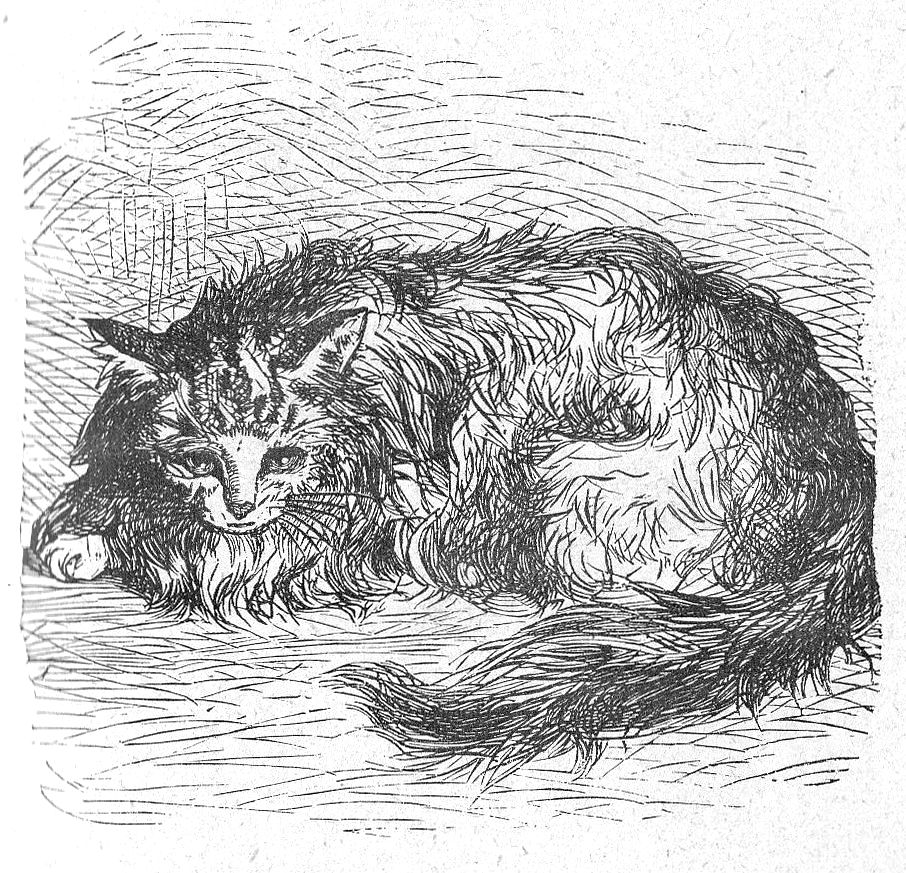
When it comes to finding the satanic or cabalistic intervention of the famous black cat in stories, legends and anecdotes we have an embarrassment of choices. Other stories show the devil's cat victorious, and in this case the bad spirits become good devils.
In the French Book of Proverbs, by Leroux de Lincy, we find the curious legend of the Cats of Beaugency.
"An architect could not build the Beaugency bridge. He had succeeded in building almost all the arches, but as soon as he finished the last arch it always fell down. This had happened three or four times and the poor architect did not know which saint to turn to. Finally, he called on the devil for help. The devil took charge of the work on condition that he could claim the soul of the first person that passed over that arch.
"The architect consented, but once the arch was built he made up his mind to deceive the devil by sending a cat across the bridge. Satan became enraged and did everything he could to destroy his work; he gave it such a kick that he bent a buttress, which always rests out of balance, but he did not succeed in destroying the bridge. For want of anything better, the devil decided to take the Cat, and the latter, as malign as they come, tore his hands and face and scratched him horribly.
"Satan, notwithstanding all his courage, could not stand up to the pain and let the poor animal escape, who, at one stroke, took refuge in a division in Sologne. Because of that memorable event, that place gained the name "Chaffin" (Chat fin). A hundred paces from Chaffin is a tumulus called the mound of Moque-Barre and Moque-Souris; it is said that this last name comes from the fact that in this is where the Cat of Beaugency made a frightful rout of field mice, weasels, rats, house mice, etc. Since that time, the inhabitants of Beaugency have been called Cats."
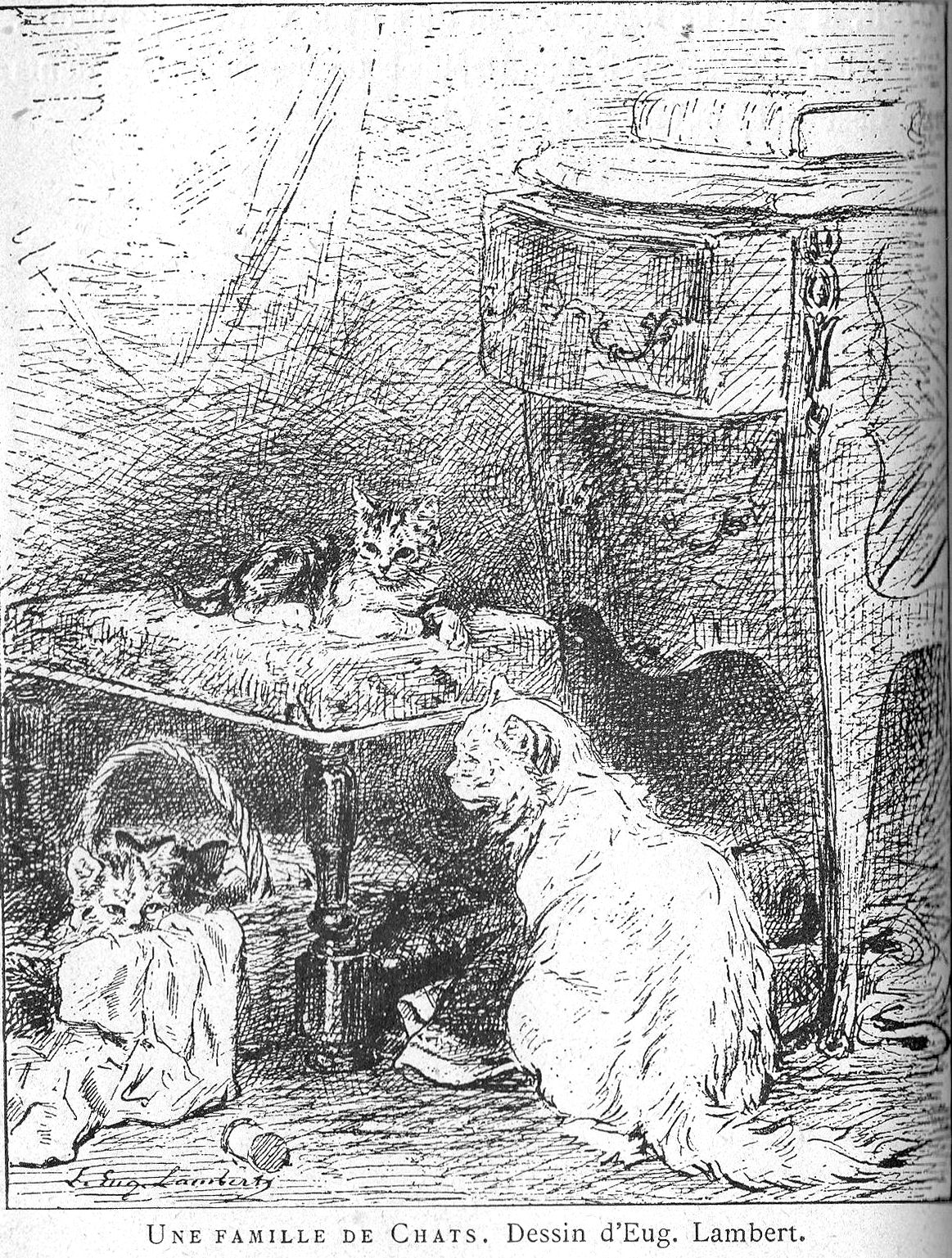
CHAPTER VIII - CATS FROM THE MIDDLE AGES TO THE MODERN DAY.
From the Middle Ages until today, the cat has not changed significantly. Certainly, in France, and especially in England and Belgium, new varieties have been introduced: sub-races with shimmering coats. I will return to these later. However, it is a noteworthy fact that, although we have no societies improving the feline, at least not here, there are many amateurs who take care of cats with the same passion as others devote to dogs or birds.
The cat, it must be said, belongs to the class of movable objects that form part of domesticity and, with dogs and chickens, is a subject of conversation between nurses and infants. It is found in the earliest games of childhood. No wonder then that we sing of it in verses of popular poems from the countryside. We could fill a whole volume with songs about cats and we would search in vain for the original authors. For example:
ABC
Le chat est allé
Dans la neige; en s’en retournant
Il avait les souliers tout blancs.
[A, B, C, The cat has gone in the snow and come back with white shoes.]
Or this one, collected in Bas-Poitou: a society of mice has gone to a dance and a comedy play:
Le chat sauta sur les souris,
Il les croqua toute la nuit,
Gentil coquiqui
Coco des moustaches, miro joli,
Gentil coquiqui.
[The cat jumped on the mice,
He crunched them all night.
Lovely puss-cat,
Mustachioed Coco, pretty miro
Lovely puss-cat.]
[Note: Here is the full version "The Mice’s Ball," Anonymous.

Dans un salon , tout près d´ici ,
Dans un salon tout près d´ici
L´y-a-t-un´ société de souris
Gentil coquiqui coc des moustaches
Mirjoli gentil coquiqui .
L´y-a-t-une société de souris ,
Qui vont au bal toute la nuit ,
Gentil coquiqui , etc....
Qui vont au bal toute la nuit ,
Au bal de la comédie ,
Gentil coquiqui ,etc...
Au bal de la comédie ,
Le chat sauta sur les souris ,
Gentil coquiqui , etc...
Le chat sauta sur les souris ,
Il les croqua toute la nuit ,
Gentil coquiqui , etc.....
Il les croqua toute la nuit ,
Le lendemain , tout fût fini ,
gentil coquiqui ,
Coco des moustaches , mirbo joli ,
gentil coquiqui .
In a salon, close to here,
In a salon, close to here,
There’s a mouse society
Nice puss-cat all bewiskered
Mirjoli, nice puss-cat.
There there is a mouse society,
Who go to the ball all night,
Nice puss-cat all bewiskered
Mirjoli, nice puss-cat.
Who go to the ball all night,
Who go to the pantomime ball,
Nice puss-cat etc.
At the pantomime ball,
The cat jumped on the mice,
Nice puss-cat etc.
The cat jumped on the mice,
He crunched them all night,
Nice puss-cat etc.
He crunched them all night,
The next day, everything was over,
Lovely puss-cat,
Mustachioed Coco, pretty miro
Lovely puss-cat.]
In the chorus, the onomatopoeia around the cats and mice make the child to remember the song.
Who laughes at recalling "My Neighbour’s Cat;" here is the first verse with the air noted:
Sur ma gouttière un jour je vis
Un chat de bonnè mine
Qui, sans s’occuper dés souris,
Miaulait en sourdine.
Ah! il m’en souviendra,
Larira,
Du chat de ma voisine.
[On my gutters one day I saw a good looking cat
Who, without busying himself with the mice,
Mewed silently, Ah! He will remember me,
My neighbour's cat.]
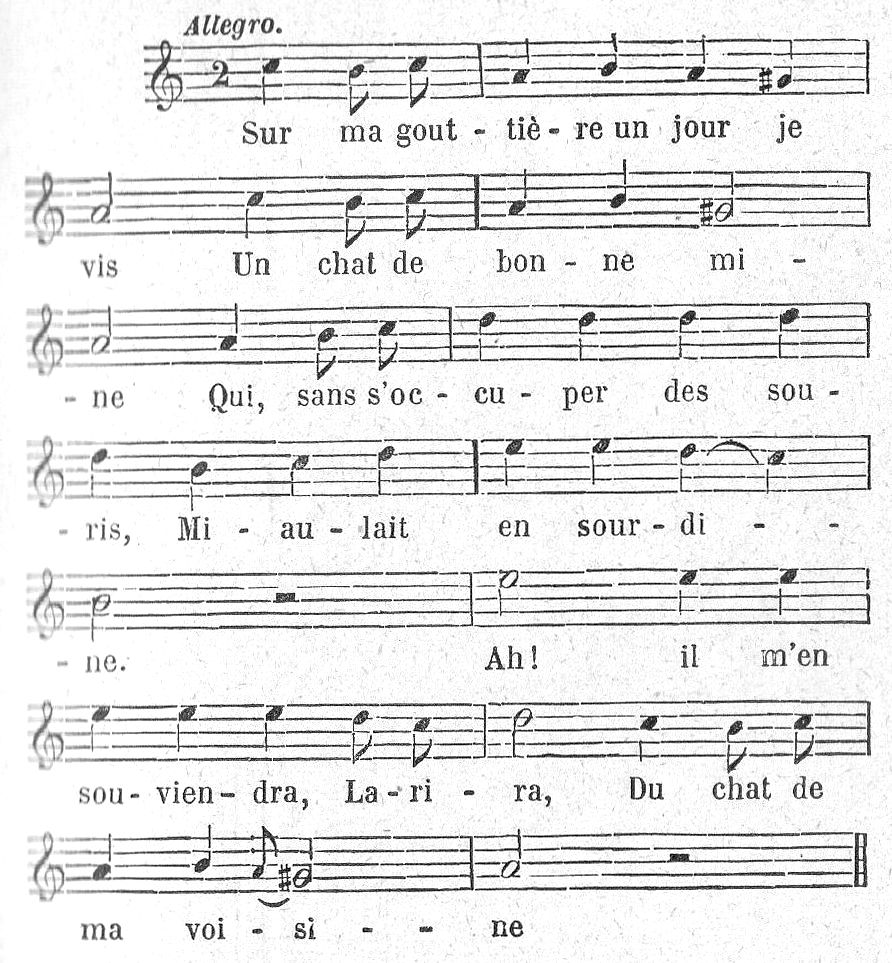
Jerome Bujeaud, in his "Songs and Ditties of the Western Provinces," quotes one of these childish couplets which forms a real sketch and describes the movement of the animal:
Le chat à la Jeannette
Est une jolie bête,
Quand il veut faire beau
Il lèche son museau.
Avecque sa salive
Il se fait la lessive.
[Jeannette’s cat is a very pretty beast;
And when he wants to make himself handsome,
He licks his muzzle with his tongue;
And he does his washing with his spittle.]
Children, and poeple of some classes of society, possess brains full of themes, songs and simple stories referring to cats. This animal also forms the basis of tales woven by Perrault and other French storytellers, as well as tales by Norwegian, German and English storytellers: Puss in Boots, Master Pierre and his Cat, Dick Wittington's Cat, etc.
In all countries there are many children's pictures devoted to cats. One of my friends has kindly sent me one of these pictures that is popular in Russia. It is reproduced here.
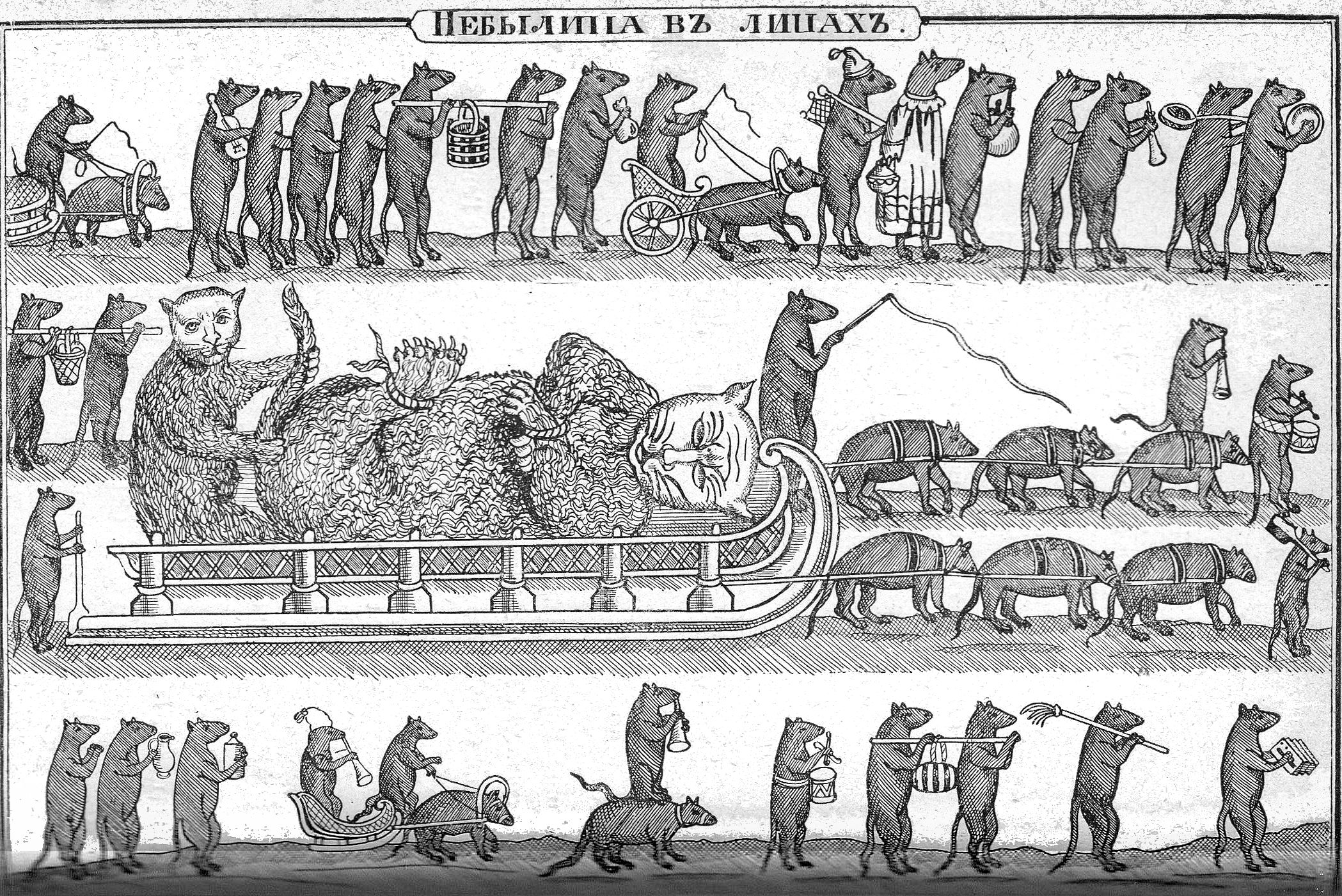
In "Cats," Champfleury recounted "Among the memories of my childhood, I recall with perfect distinctness a very old picture, used as a chimney-board, which represented a dozen cats of every kind and colour, fat, thin, black, white, Angoras and gutter-toms, all collected in front of a music-stand. On the desk lay open, in oblong form, the venerable ‘Solfège d’ltalie.’ The notes were represented by little rats, which perfectly rendered the black and white; their tails accurately indicating the quavers and semiquavers. In front of his companions stood a handsome cat, beating time with all the dignity that befits the conductor of an orchestra; his paw, placed upon the music-book, seemed to scratch the rodents imprisoned between the staves with a spiteful pleasure. and despite the amenities of the treble clef, I think the rats would have preferred the Clef des Champs [to make an escape]."
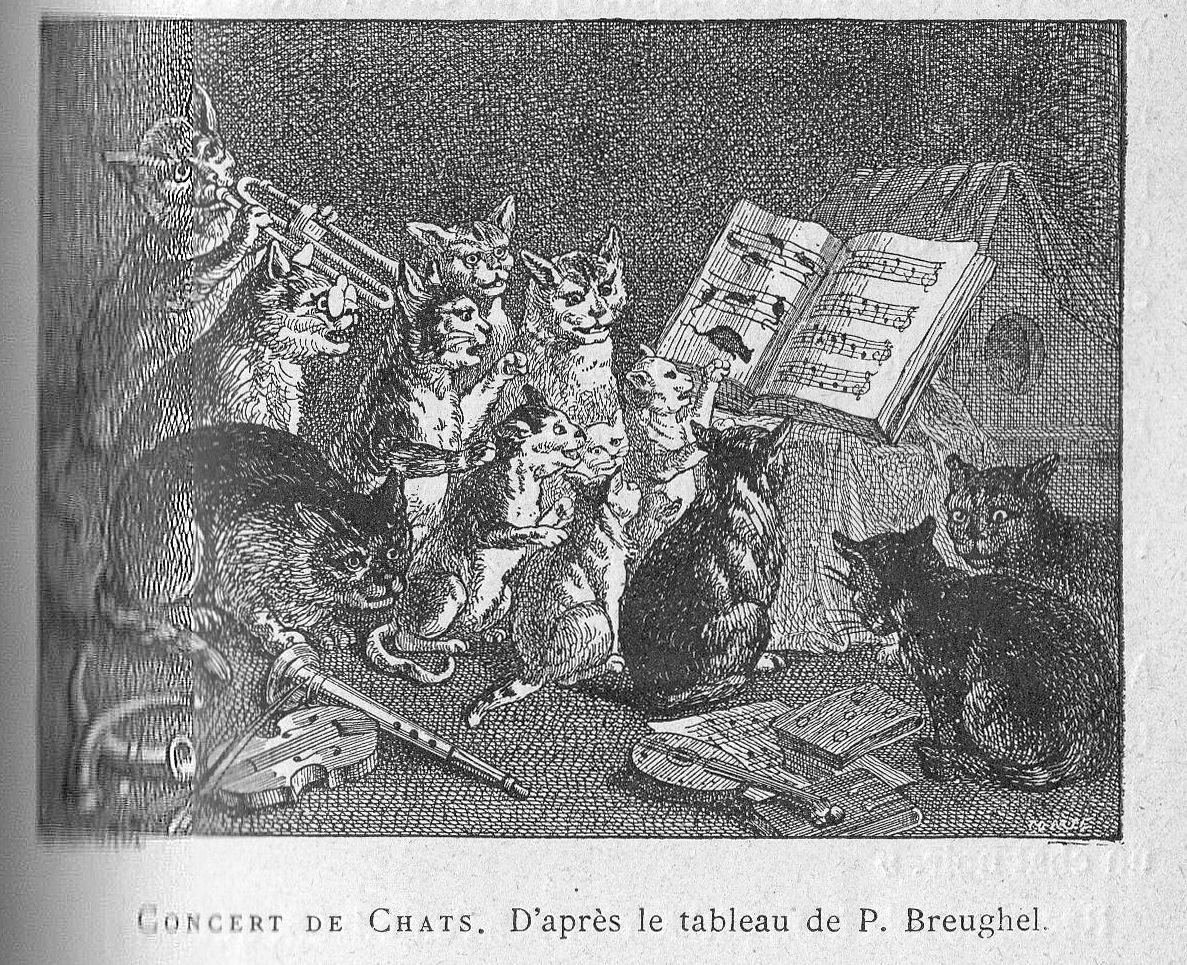
This motif, quoted by Champfleury, has been adopted by Breughel and the Flemish painters of his time.
And here is a fantastic tale in just a few lines, taken from the "Memoirs of Chateaubriand":
"The people were firmly persuaded that a certain Count Combourg, who had a wooden leg and had been dead three hundred years, appeared at certain periods, and that he had been met on the tower stairs. His wooden leg was also in the habit of walking about, attended by a black cat."
Tell this to a small child, embellishing it a little, and for a long time afterwards he will see the black cat, accompanied by the wooden leg, descending the stairs of the turret.
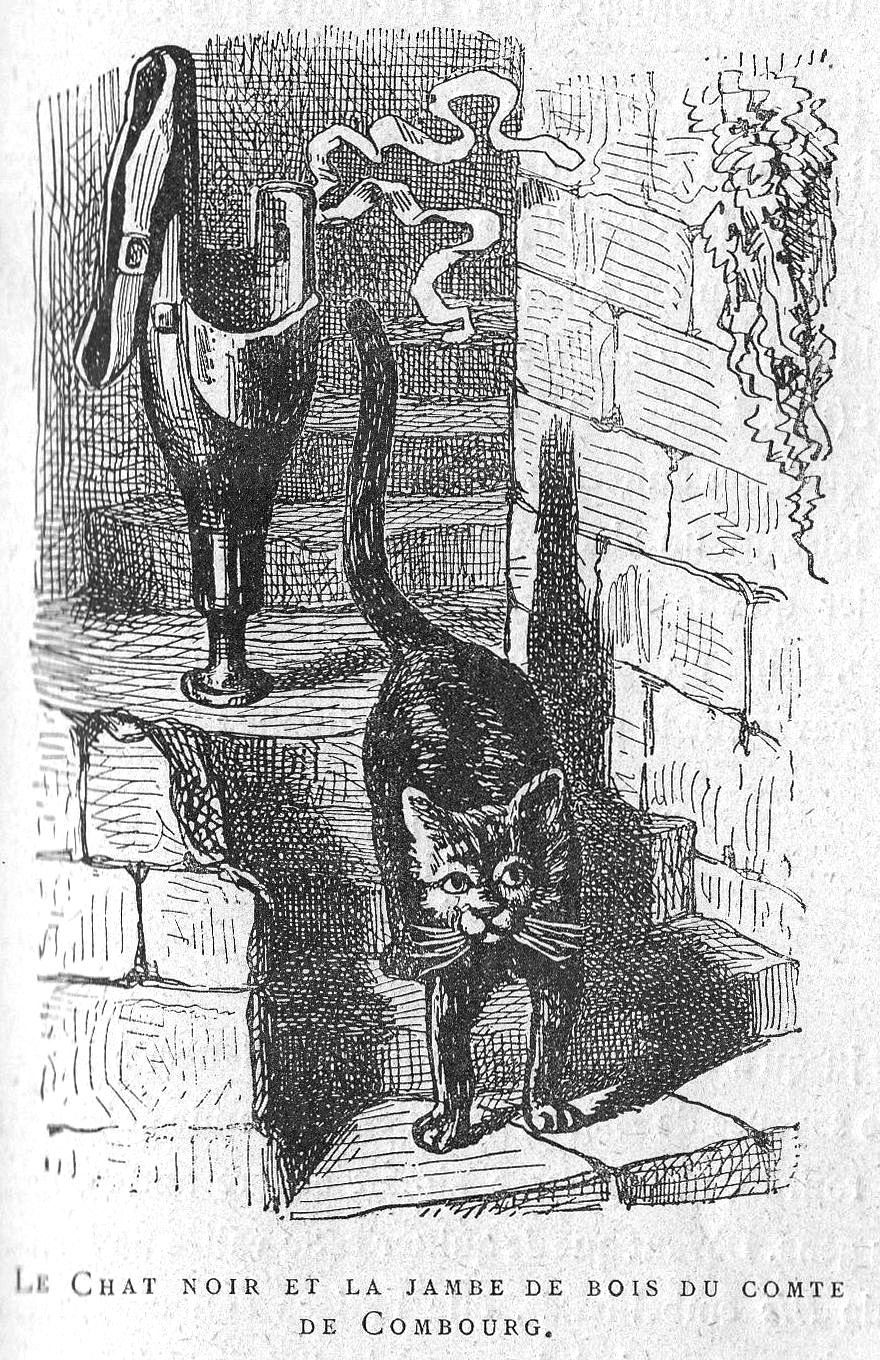
The memory of these legends where the cat plays the main role and which fill the brains of children, will remains alive and well even when they reach middle age; perhaps that is why so many men have an affection for cats.
Among modern cats who have a story (and I’m not yet considering cats belonging to certain notable literary or artistic figures), there is one who well deserves a mention; he was the most official cat of Paris, the Rothschild of cats, master "Bis."
Who was this Bis?
Bis was an important figure, a character fat as a monk, who lived in his rented place under the auspices of the municipality of Paris, recalling the Archduke of the cats of which the storyteller speaks:
... Un chat vivant comme un dévot ermite,
Un chat faisant la chattemitte .
Un saint homme de chat, bien fourré, gros et gras.
[... A cat living like a devout hermit,
A cat making a humble face,
A holy man of cats, well furred, large and fat.]
Every two weeks at least, he wrote his health bulletin; he had servants watching over him just as they watched over the President of the Republic. Bis even had his own historiographer in the person of one of our ablest colleagues in the Paris press, the witty Caribert (Oct. Lebesgue).
A few years ago, he says, a lady passed away leaving behind a cat and a fortune. If her cat had been the first to die that she would perhaps have, like the famous princess, perhaps she would have built a tomb; but it is unlikely that she would have engraved this epitaph on the marble:
[Ci-gît une chatte jolie.
Sa maîtresse qui n’aima rien
L’aima jusques à la folie.
Faut-il le dire ? On le voit bien.]
Here is a pretty cat
Her mistress, who loved nothing,
Loved her to the point of madness.
Why do you say that? – You can see it clearly.
Bis could flatter himself that he was loved to distraction, but besides his silky fur, his kind friendship, his cuddles and purrs, his mistress loved something else: the poor people. Before leaving the land of the living, and a life beautified by Bis, she wrote her will. She bequeathed all her property to the municipality of the third arrondissement, on condition that her grave be maintained, and that Bis would be live in retirement with an honourable family and enjoy a very high annual allowance until the end of his life.
The municipality was very perplexxed at the news of this legacy. They were trusted with a cat on their hands! An animal whose very nature was capricious. He readily clings to some things and to a certain extent will make his home wherever he sleeps. But love brings out his worst wandering instincts. He draws broadside like an old sailor. He goes off to find his plaintive Eurydices and is lucky to come back with both ears intact. To watch over a tomcat is such a responsibility, gentlemen!" said Mr. Tantet. "Here is a beast," said Mr. Achille, "who will give us a great deal of hassle!"
The question arose as to where this pensioner would spend his lazy existence. Would he be locked up at the mayor's office under the watchful eye of the mayors? They decided to put him up in an apartment. But there was a difficulty. What if he died at his foster-parents' home and what if they then substituted an unknown cat in order to prolong the benefit of the allowance? It was necessary to surround him with express guarantees!
They sent for naturalists who examined the beneficiary. They measured him, described his coat, the silky fur, the pattern of his markings, the approximate colour of his eyes. Bis was rigourously described and Mr. Bertillon found nothing to correct.
They then inquired about an apartment and Bis was placed with a very good woman, a caretaker in the neighborhood. Caribert, wanting to know the personal details of this important character, went to interview the excellent lady who maintains Bis.
She told him "Sir, he is an amiable creature and not conceited. He talks to everyone, but without making a fuss, and he is happy, because he falls asleep and he is replete. At first, I dreaded his frenzies, and I was always watching that the door was closed and Bis had not escaped. And it caused me anguish when this little rascal, as if to play a joke on me, hid under the bed. On two or three occasions I thought he was lost - I called him, I rattled the scissors that cut up his lights, and the milk-jug. To annoy me, he did not move. Finally, he suddenly decided to show the tip of his nose. You can imagine my joy!
"... On one occasions he played this comedy when the gentlemen of the commission came here to inquire about the genuine presence of Bis and issue his certificate of life. We called for him: Bis was not at hand. I was extremely anxious. ‘Gentlemen, I assure you that he is not dead,’ I said, ‘it is a trick of the little rascal.’ I searched, they searched, we all searched. These gentlemen were kind enough to call with me. But Bis is as deaf as a post. I got under the bed with a broom, I looked behind the wardrobe, I ran to his dish, nothing ... The commission was leaving, ready to declare that Bis no longer existed, and one of the gentlemen was already taking his hat, when he saw Bis coming out from beneath my sideboard where he had thought fit to snuggle. Cats have such cunning! Because I cannot get it out of my head that he knew we were looking for him ... "
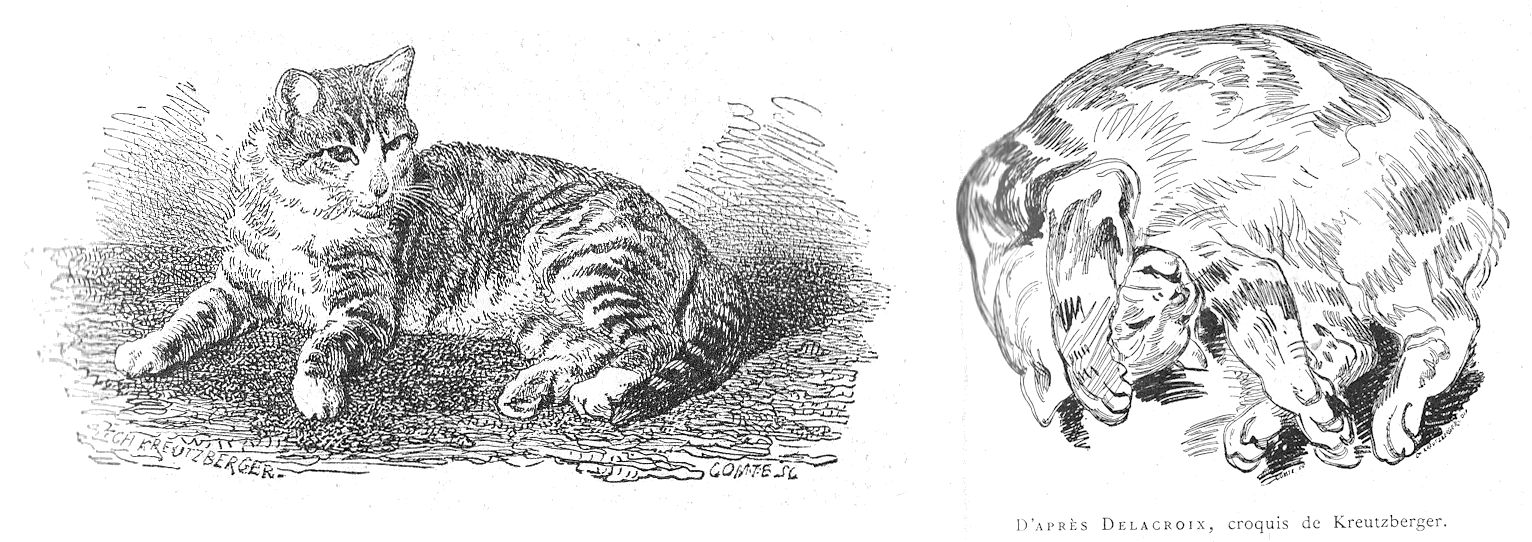
Here is the curious part of the text of the regular contract made between the municipality of the 3rd arrondissement of Paris and the Bis’s guardian:
"The municipality of the 3rd arrondissement entrusts to Mrs. C. a non-pedigree cat, snipped [neutered], called Bis, with white fur, about eleven years old and having the peculiarity that his left iris is greenish-yellow and the right iris is blue grey.
"Mrs. C ... undertakes to treat the cat well, to buy five centimes of liver and twenty centimes of milk for it every day.
"Every three months, the municipality will pay Mrs. C ... the sum of 55 francs. It is understood that it retains the right to take back the cat and to entrust it to another person without having to allege any reason.
"Upon the death of the cat, the 10,000 francs left by the donor will be paid to the Schools Fund of the 3rd arrondissement."
Just a few months ago, Bis gave up his soul to God. Poor Bis so well known, so well-regarded in his neighborhood, he ended up like a miserable gutter cat with a garbage can for his coffin!
In England, when cats are looked after from the point of view of exhibiting and selling them, they are most often relegated to the pantry, while their food consists of butcher's scraps traditionally sold from door to door by cats’ meat men (literally: men selling meat for cats). Here at home, on the contrary, kept in good houses, cats are almost as happy as children; they are pampered, caressed; their liver and lights, and their milk are subjected to severe inspection - nothing is too nice or too good for them.
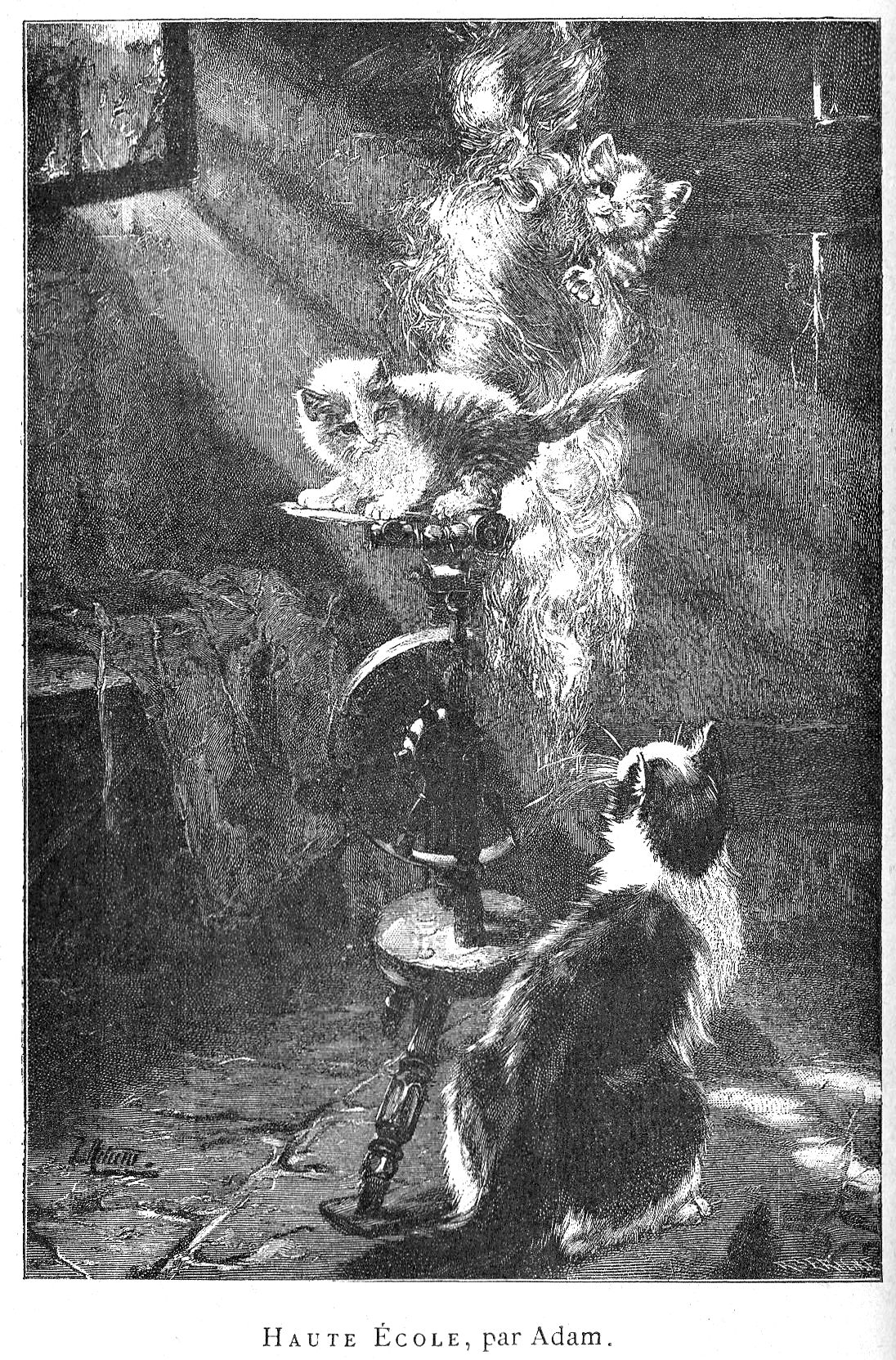
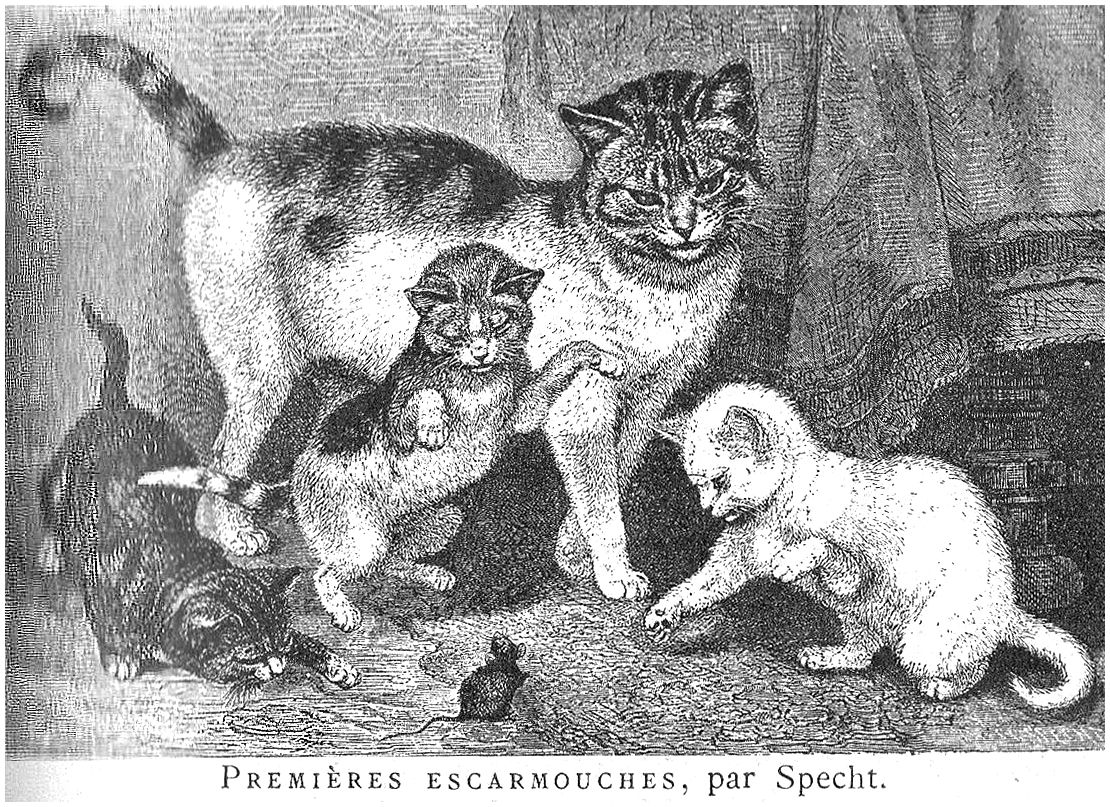
CHAPTER IX – CAT HATERS
If in Egypt, the Eldorado of cats, in India and among the Arabs, cats were deified, they had and still have irreconcilable enemies. Buffon was one of the most stubborn detractors of "unfaithful domestic cats, who are kept only by necessity to suppress another even more inconvenient domestic creature. Inveterate thieves, they have no taste except to do mischief. Those who are more tame are no more enslaved; they remain half-wild, only frequenting attics and roofs, and often thieving from the kitchen and pantry."
Honouré Scheffer and Toussenel especially also sounded the cry of death against cats, whom they accused of all manner of misdeeds, wrongly attributed, so they say, to poachers and marauders regarding the scarcity of game.
"I never meet a prowling cat," says M. Toussenel, "without doing him the honour of shooting him."
Today many hunters do what Toussenel did and follow the advice of that rabid Fourierist.
[Note: Fourierism is form of socialism espoused by Charles Fourier who recommended the reorganization of society into small communities, with living space divided hierarchically and higher pay for those carrying out unpopular tasks.]
"I strongly advise all my brethren of Saint Hubert to do likewise," It’s hard to believe that the person who wrote those lines is the same person who devoted such charming pages to birds and dogs, and even to wolves and foxes whom he accuses of fewer crimes than the cat.
However, by Toussenel’s article devoted to the cat does not show any serious grievances. He says "A love of cats is a vice of inferior minds; a man of good taste, and with a keen sense of smell, has never had, nor could he have, sympathy with a beast passionately fond of asparagus."
[Note: he was probably comparing the smell of tomcat pee to "asparagus pee."]
Good grief! if it were necessary to shoot everyone who loves asparagus, France would soon be depopulated!
Another complaint of the phalansterian [Fourieriste], this time specifically against the female cat, is hthat she mates with the wild cat. According to Toussenel, the wild cat species would be have destroyed by now if female domestic cats did not perpetuate it by frequent interbreeding.
"It is remarkable and bizarre," he writes, "that it is the female cat that returns to savagery, for such a retrograde act on the part of the female is contrary to the general rule of all animals. It is a fact that, in all animal and human races, improvement is made by females. Thus there are no examples where bitches have made a misalliance with a creature of the woods i.e. the wolf and the fox; on the contrary, every day we see the she-wolf listening to the dog's love song, and even make advances to a dog that is in the vicinity of the woods."
In addition to these assertions needing proof, it is a fact that the wild cat, at least in France where where domestic cats are most numerous, has become excessively rare. Therefore, these couplings of a domestic beast with a wild beast do not appear to be so frequent as supposed by Toussenel, who, nevertheless, is obliged to recognize that "the she-cat is the most graceful and lithe of all creatures; an eminently graceful woman is said to have the poise of a cat. The cat is the only animal not deformed by portliness. Her tenderness calls for caresses; her fur sparkles, and her back arches beneath the hand that strokes her. She inclines her head and blinks to her mistress and has a private language (purr, purr) for her inner happiness.
"Through all this amiability and refined taste, pussy has always had fans among witty people." Further, in the interest of his cause, Toussenel establishes a statistic so exaggerated that it is impossible to overlook its inaccuracy. According to him, there are at least six millions of rural cats in France who devour twenty-four million young rabbits and leverets, seventy-two thousand partridges, two thousand million seven hundred and ninety small edible birds, that is, field larks, horned larks [shore lark], ortolan buntings, etc. Who would admit this tremendous consumption as real?
[Note: "Deux milliard" – two thousand million. The original European "billion" was a million million, not a thousand million.]
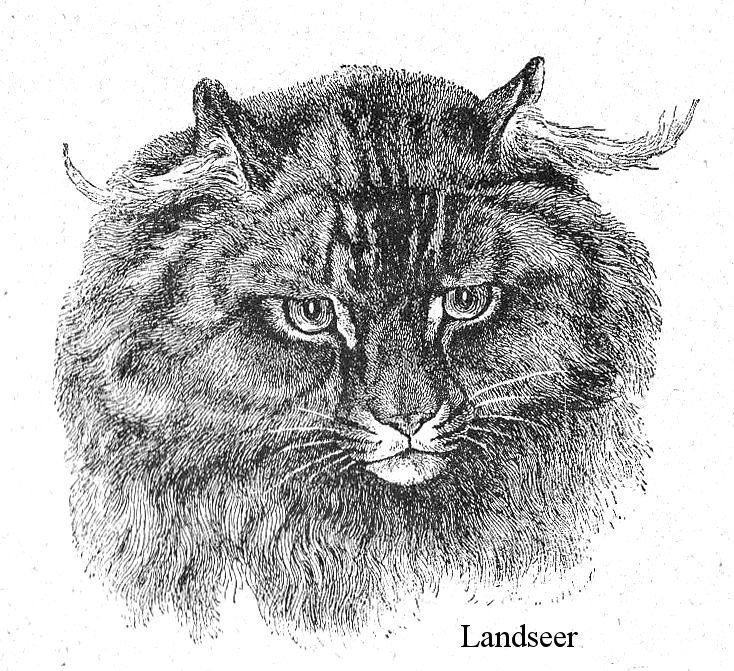
In general, the most hunters are cat-haters, which, it must be admitted, sometimes commit the crime of feasting on young game; but if in the peasants of the countryside fed their mousers a little better than they usually do, the cats would probably not go through the woods and the fields to seek necessary supplemnts to their diet.
While those cat-haters – hunters - have certain reasons explaining their age-old hatred, there are others who experience an instinctive horror of the cat through some nervous phenomenon, some illness. One such was Henri III who fainted at the sight of one of the creatures. Guyot-Desherbiers, who devoted a long poem to the glorification of the feline companion of Saint-Yves, also stigmatized that sovereign
A thousand woes to the mortal
Who by some natural disaster
Cats make their adversary!
Their former weighty contempt
Became the mark of anathema
To the last of the Valois,
Our penultimate Henry
Most vile of all the kings,
Their just disapproval
Became a frightening example!
See how that half-man faints
Before the majestic Cat,
Meditate on his deplorable end,
And his even more miserable life!
He took an unsteady throne
And made it a bed of vice;
Goes from the scoundrel to the chalice,
On the Night of Assassinations
Craven witness, cruel accomplice;
Without doubt the gaze of a Cat
Became his first torture.
Ronsard, who was a poet, felt the same hatred for cats:
No man alive hates Cats, the world around,
As much as I, with hatred so profound;
I hate their eyes, their faces and the way they stare,
And should I see one I will quickly flee elsewhere,
And Buffon, whom I have already quoted as one of the detractors of the feline race, supported this hatred by his scientific authority. He writes "Although these animals seem sweet, especially when young, at the same time they have an innate malice, a false character, a natural perversity that increases even more with age, and that education only hides."
It would also appear, if we believe Leo Lespes, that Nadar, like Henry III. had an instinctive horror of the cat; he experienced nervous tremors just seeing them flex their claws.
And just this year, 1897, in Munster in Westphalia, didn’t we see the "Antikatzen-Verein" society created, which aims to exterminate cats? The members of this bloody association are no doubt rabid hunters, fervent followers of Toussenel's theories.
It would also appear that a hundred years ago, before laying the last board of their floors, builders had the cruel habit of imprisoning a living cat under the floor! This was to bring happiness to the future inhabitants of the house. That’s why, when demolishing old houses, we find dried cats, almost mummified, convulsed by the suffering they endured before dying. Fortunately for the feline kind, this barbarous custom has gone out of fashion.
But, on the other hand, look how many apologists have stood up to defend Minet, how many determined felinophiles from the Egyptians to the present day!
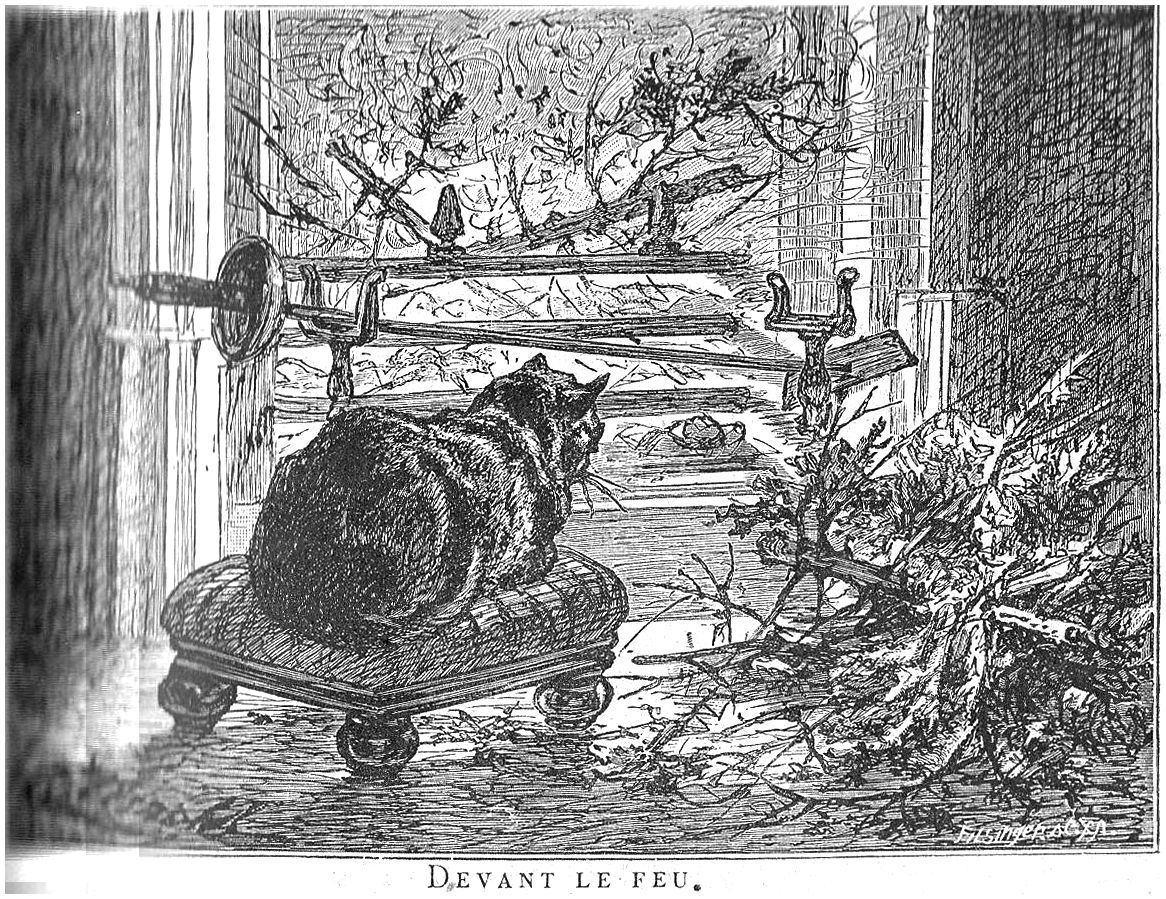
CHAPTER X – CAT LOVERS
Cat-lovers are certainly innumerable, from antiquity to the current days those who make cats their beloved companions and the distraction of their labors are legion, hence Th. Gautier called cats the "tigers of the poor devils." One book would not be big enough were it necessary to name them all, and to reproduce their opinions on their favourite animal.
Without going quite as far back as the deluge, I cannot pass over Muhammad, whose favourite cat, Muezza, is still the object of great respect among the Arabs. At the time of the prophet, the cat was not very common in Arabia. It was only in the Nile valley that it was worshiped as a God. Later, when the prophet was revered and the faithful sought to imitate him in all things, it became the favourite animal of the Muslims.
Muezza remains associated with the fame of the prophet:
The legislator of Asia,
Happy soldier, inspired priest,
The love of his tabby cat
Was his dearest fancy.
Carrying his Cat with him,
Wherever this hero fled,
Together they founded the Hegira,
Eternal date to his empire.
In order not to disturb this friend,
Venerated, admired and currently asleep
In the silky folds of his sleeve
With a generous blade he cut away
The large part of his coat
On which she made her bed. [Guyot-Desherbiers.]
Tournefort related this legend of Muhammed and Muezza in "a Journey to the Levant:"
"Mohammed dreamed of his policy; on his sleeve was sat Muezza. While the cat was purring, Mahomet thought. Perhaps the poet was thinking of his Paradise. He thought for a long time and the cat fell asleep. Forced to go to his duties, Mahomet took some scissors and cut off the sleeve of his coat on which the cat slept, and got up, happy not to have disturbed the creature’s sleep."
Thus goes the Eastern legend, well known to all Muslims, that we find elsewhere related in the "Cousin of Mahomet:"
"Turkish women show little attachment to the law of Mahomet; they do not consider themselves obliged to do anything ordered by a man who preferred his cat over them by putting it in paradise, while excluding them. It is because they ignore or pretend to be ignorant that this venerable Cat was a virtuoso, that is to say, a holy personage. Here is a feature of his story. One day the Prophet’s kitty was lying on a sleeve of its master's coat, and it meditated so deeply on a passage of the law that Mahomet, at the hour of prayer, dared not disturb its rapture and cut off his sleeve rather than disturb it. On returning from prayer, he found his Cat, who was awaking from its ecstatic asleep, and on seeing Mahomet’s cut away sleeve beneath it, recognized its master's intention for him.
"It stood up and bowed to him, raised its tail and arching its back to show him more respect. Mahomet, who understood perfectly what this meant, assured the holy man of Cats a place in paradise. Then, thrusting his hand three times over the cat’s back, his touch gve the cat the virtue of never falling on that part; hence Cats always fall on their paws. I have often heard venerable Turks tell this tale so seriously that it would be dangerous ridicule it in their presence."
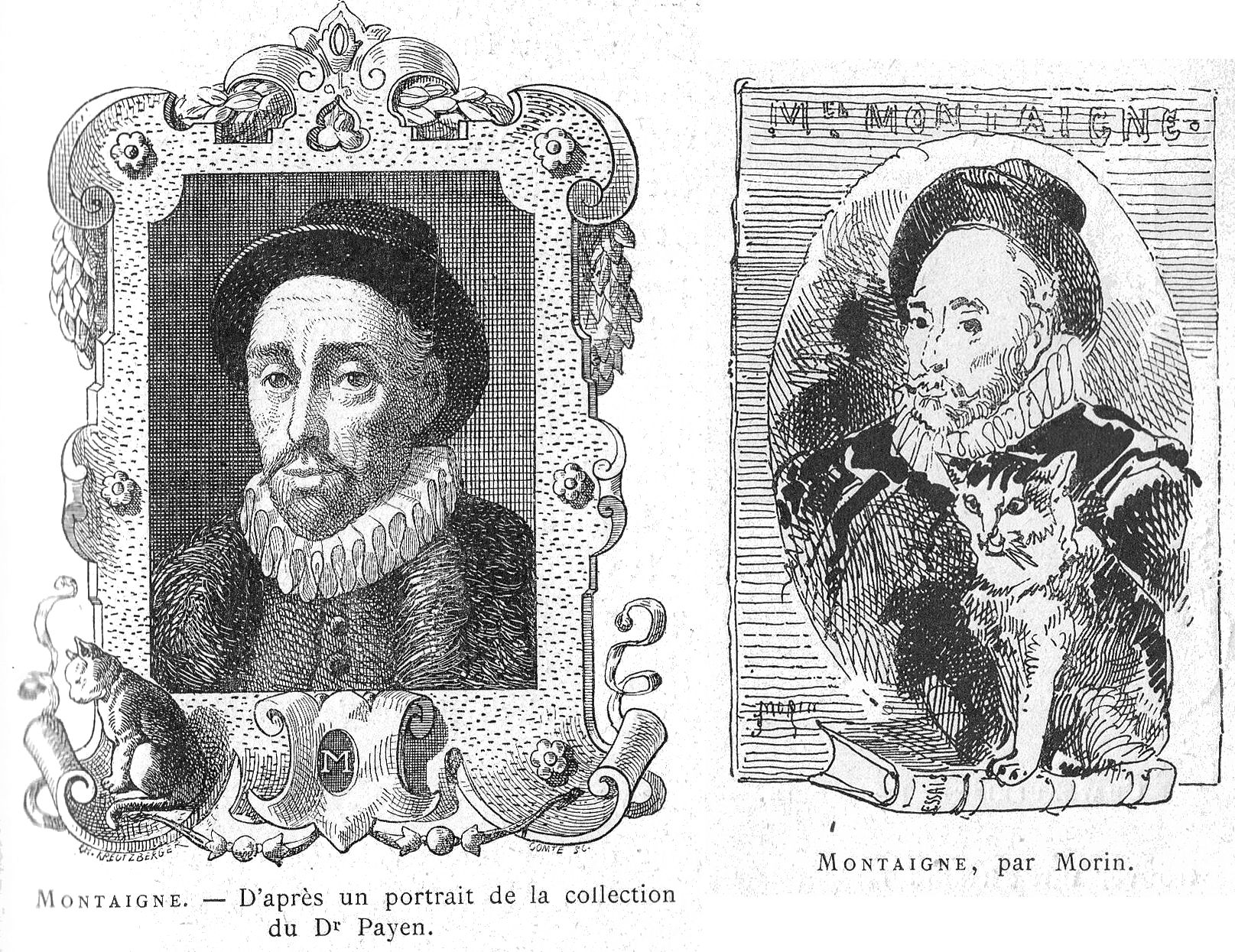
When, in recent years, the investigations by the Academy of Sciences tried to explain the peculiar fact that cats always land on their feet, the intervention of Mahomet was not thought to be at work ...
[The Academy of Sciences has, in fact, occupied itself with the cat’s agility and its faculty of always landing on its feet. At one of the meetings of the learned company in October 1894, Mr. Marey presented to his colleagues about sixty chromo-photographic snapshots obtained in his laboratory at Parc des Princes and representing, one and all, the various figures of a cat somersaulting during a fall from 1.5 metres height. The first pictures represent the cat's legs in the air; the following show the animal making movements, a sort of frantic appeal to the paws; others show it gradually righting itself, finally touching the floor all four paws at once and flinging its tail in the air. Physicists and mechanics, including Marcel Desprez, maintained that this fall was contrary to all known laws; but Mr. Maurice Levy showed that this was only a strictly mathematical question on which opinions could not be divided, any more than they could be on a theorem of geometry. Instead of leaning, as Mr. Desprez did, on the so-called mechanical principle of the areas, Mr. Levy established mathematically that the cat can, by suitable deformations, right itself without calling on any external help. In the same way, an acrobat who does a pirouette in the air and who gets momentum when leaving the ground, could still, by the correct method, do a pirouette without needing that initial momentum.]
The legend at least proves that the prophet was very gentle to animals, and that he gave his people an example of gentleness taken to the extreme; moreover, a few minutes before his death, didn’t he say: "If anyone has cause to complain that I have mistreated him with blows, here is my back, that he returns them to me without fear."
Returning to Italy, among the great cat lovers we must mention Scipion Nasica, whose tiger cat had a necklace made of gold pearls around its neck. And there too is Petrarch, who, after the death of his beloved Laure, retired to Argua, and found no-one else to ease his solitary sadness except his cat whose skeleton is now preserved religiously in the Museum of Padua.
Petrarch wrote sweet sonnets
To his connoisseur Cat.
The faithful poet implored
God to grant the divine power
To soften the heart of Laure,
And he did not implore in vain.
Whether he sang of sweet martyrdom,
Or he sighed in despair
At the death of his beloved,
He heard his favourite cat
Faithfully raise up its cry
In tune with his lyre. [Guyot-Desherbiers.]
Torquato Tasso, author of liberated Jerusalem, in the height of his misery that divine poet was sad, for that genius lacked even candlelight to write by, and in a pretty sonnet dedicated to his cat, he asked him "to lend him the light of his eyes during the night".
Rival of Virgil and Homer
(Someone named him the winner),
Tasso unburdened his heart
To a young Cat and its mother.
"Alas! Bitter is Fortune,
And she beats me," he told them,
"So I seek solace with you,
As a storm-beaten sailor,
Carefully navigating,
By the Great Bear and the stars
Seized the flashes of lightning
Through the clash of the clouds."
Think thoughts of pain and flattery,
In my poverty and disgrace,
With just two Cats to console poor Tasso!
While Ronsard had an instinctive fear of cats, Joachim du Bellay, canon of Notre-Dame de Paris and one of the most graceful poets of the sixteenth century, addressed his most beautiful poetry to his cat, Belaud.
Poets, to tell the truth, were not the only ones who enjoyed the company of cats. There are politicians, and not the lesser ones, who have taken things to the point of obsession. One such was Cardinal Richelieu. Champfleury tries to explain this love for cats by politicians:
"These great political personages are quickly tired of men, whom, with few exceptions, they regard as mere creeping things. They know too well how surely the purest are to be bought with money, place, dignities, and honours. On that point great politicians are not mistaken; if any were, they would not be great politicians. Thus, the independent animal pleases them, above all, the Cat, which is the very model of independence."
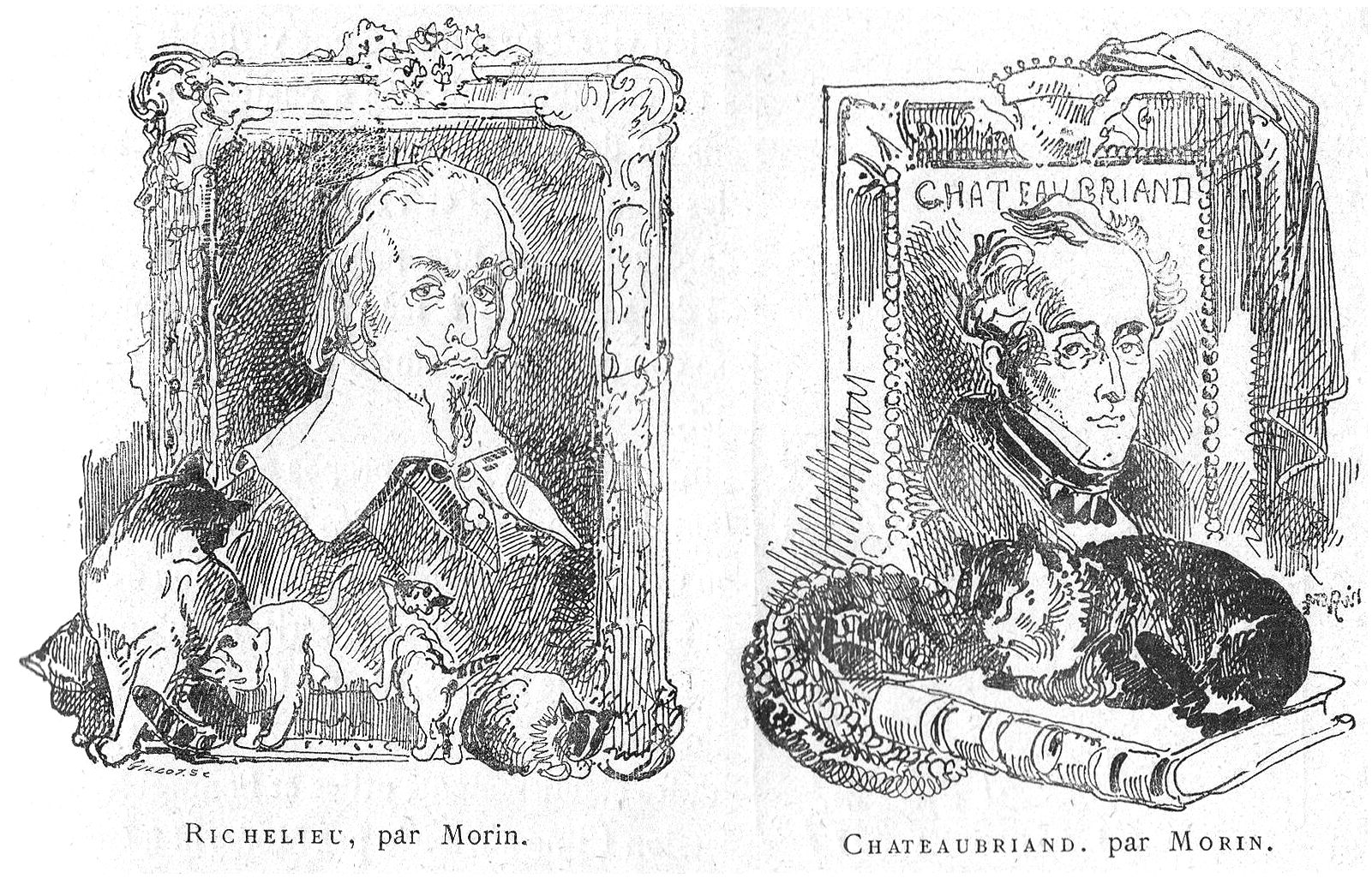
Richelieu lived in the midst of a veritable feline menagerie. Near his room was a "cattery" which was entrusted to the care of two of his servants, whose names are preserved in history as Abel and Teyssandier. Even at his death, the great cardinal left a boarding house for his cats and for the two attendants who cared for them, and their food was to consist only of light pate and chicken breast.
It is rather surprising that Moncriff, who did great research on cats, did not speak in his very curious work of Richelieu's passion for cats: "Everyone is aware that one of the greatest Ministers in France, Mr. de Colbert, always had a number of kittens frolicking about that same cabinet from which so many useful and honourable establishments have sprung up for the nation."
Is the feline passion attributed by Moncriff to Colbert a legend diverted from its source? One might be inclined to believe so, for the painters of his day often represented Colbert alone, or in his chains, holding the lion and the eagle, though it would have been interesting to have a portrait of this statesman in the midst of his cats, similar to that of Henry the Third carrying a basket of little dogs from his neck.
Champfleury says that Richelieu was not a true cat-lover as he only liked to keep them when they were very young. For him they were acrobats whose joyous frolics and clownish agility gladdened his naturally melancholy and sombre character.
At the time of the cardinal’s death, according to a historian of the time, he had fourteen favourites: Mounard le Fougueux, Soumise, Serpolet, Gazette, Ludovic le Cruel, Mimie Piaillon, Felimare, Lucifer, Lodoïska, Rubis sur l’Ongle, Pyrame, Thisbé, Racan, and Perruque. These last two were so-named because they were born in the wig of Racan, the academician.
As well as Richelieu and Mr de Colbert, we must mention the following cat-lovers: Montaigne, of Fontenelle, Bernardin of Saint-Pierre, Sieyes, J.-B. Say, the painter Landon, the poet Gray, de Lesdiguières, J.-Jean Rousseau, and among the women: the Duchess of Maine, the Duchess of Mirepoix, whose Caesar is famous for his prettiness; Madame de Lesdiguieres and her cat Menine who, after her death, had the honours of a mausoleum; tender Deshoulieres with his pussy Grisette; the beautiful Madame Recamier with her cat Dorothea; Mrs. Desbordes-Valmore, and many more besides. The list would be too long if we had to name them all.
But one of the most enthusiastic writers about cats was certainly Chateaubriand; these animals preoccupyed him everywhere, in fortune or in misfortune. He even had such admiration for cats that he came to have a certain resemblance to this animal.
"Do you not know someone near here," he asked his friend, Marcellus, "who is like a cat? I think myself, that our long familiarity has given me some of his ways."
What particularly struck Chateaubriand was the cat’s independence; he wrote about it to M. de Marcellus, his secretary of embassy:
"I love in the Cat that independent and almost ungrateful character which makes him attach himself to no one, the indifference with which he passes from the salons to his native gutters. He is caressed, he arches his back; but it is a physical pleasure which he feels, and not, like the dog, a simple-minded satisfaction in loving and being faithful to his master, who thanks him by kicking him. The Cat lives alone, he has no need of society, he obeys only when he wishes, he sleeps in order to see better, and claws everything he can scratch. Buffon mistreated the Cat; I am working on its rehabilitation, and I hope to make it an appropriately honest animal, in the fashion of the times."
We see that the fondness of the author of "René" penchant was impartial and that he had no illusions, he liked the cat for itself and in many passages of Chateaubriand's "Memoirs" we find this constant preoccupation to restore the cat:
He writes "I would willingly advocate some of the works of God which are in disgrace among men. In the first line would be the donkey and the cat."
As a poor emigre in London around 1797, Chateaubriand lodged around with an Irish widow, Mrs. O'Larry, who also loved cats. It became a link between him and his hostess.
"United by this common sentiment we mourned together the misfortune of losing two lovely she-cats, as white as ermines, with black tips to their tails." Then, speaking of the well-regulated and disciplined nature of London, he said:
"The London sparrow, all blackened with smoke, is silent on the roads; one never hears a dog bark or a horse neigh, and even the free and independent cat ceases to mew upon the roof-gutters."
At an embassy in Rome, Chateaubriand received a cat from the pope. "He was called Micetto," said Mr de Marcellus. Pope Leo XII’s cat, of which M. de Chateaubriand had inherited, could not fail to reappear in the description of the hearth where I saw him so often arching his back.
Indeed, Chateaubriand celebrated thios cat in the piece that begins like this: "My companion is a big grey and red cat."
But it is especially among writers, poets, and those of delicate sensibilities that we find the greatest cat-lovers.
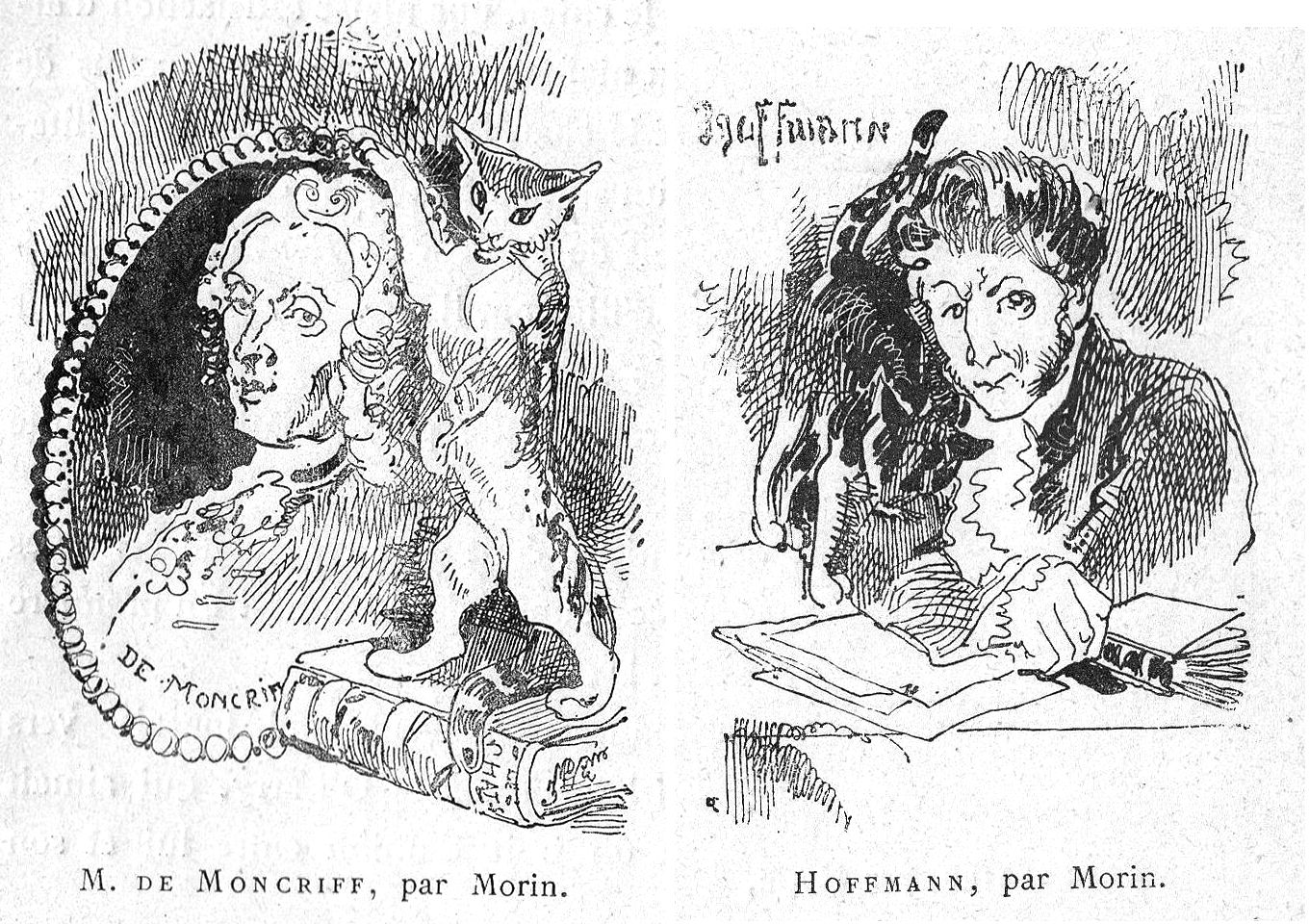
At the forefront of those who defended cats, or rather those who rendered them justice, is surely their historiographer Moncriff. His "History of Cats" earned him entry to the French Academy, but it also attracted a large number of unjust critics, mostly because it was a "seriously frivolous" pleasant book, as the author himself described it, which was surprising even for the time when learned books were very rare. Voltaire and Grimm, especially Voltaire, who "kept his claws sheathed," especially mocked Moncriff, saying that he should be sent back to his gutters.
In spite of the other titles of Moncriff, which I confess were very thin, the History of Cats was called the only "historiogriff" of the kingdom.
[Note: "Historiogriffe" was a play on words – historiography and "griffe" (claw).]
This was because Voltaire was jealous of Moncriff for a number of other reasons. Moncriff was a reader to the queen and was much in favour in her court.
Among the poets, we must not forget the good La Fontaine who shared his passion with Madame de la Sabliere. In fact, Madame de la Sabliere rwrote in one of her letters that, one day, the fabulist wanted to cure her of her great love of dogs, "a passion which seemed to him unreasonable". She consented to replace her dogs with a certain number of black cats, in order, she told La Fontaine, to have "only animals whose trade does not lead farther than one wants." Madame de la Sabliere began by amusing herself with the games of her new feline family, and ended up loving them so much that they shared her intimacy with her dogs when the latter returned to the fold and with ... the good La Fontaine.
Among modern writers, Hugo, Beaudelaire, Mérimée, and Théophile Gautier were great friends of cats.
Who else remembers the touching page about Michelet's cat Moquo, written by Mrs Michelet and found in "The Bird" by the Master Writer?
Victor Hugo’s favourite cat, which had been nicknamed Chamoine because of his indolent laziness, sat under a canopy of crimson brocadelle, in the great gothic salon of his master, the Place Royale, receiving the homage and caresses of guests.
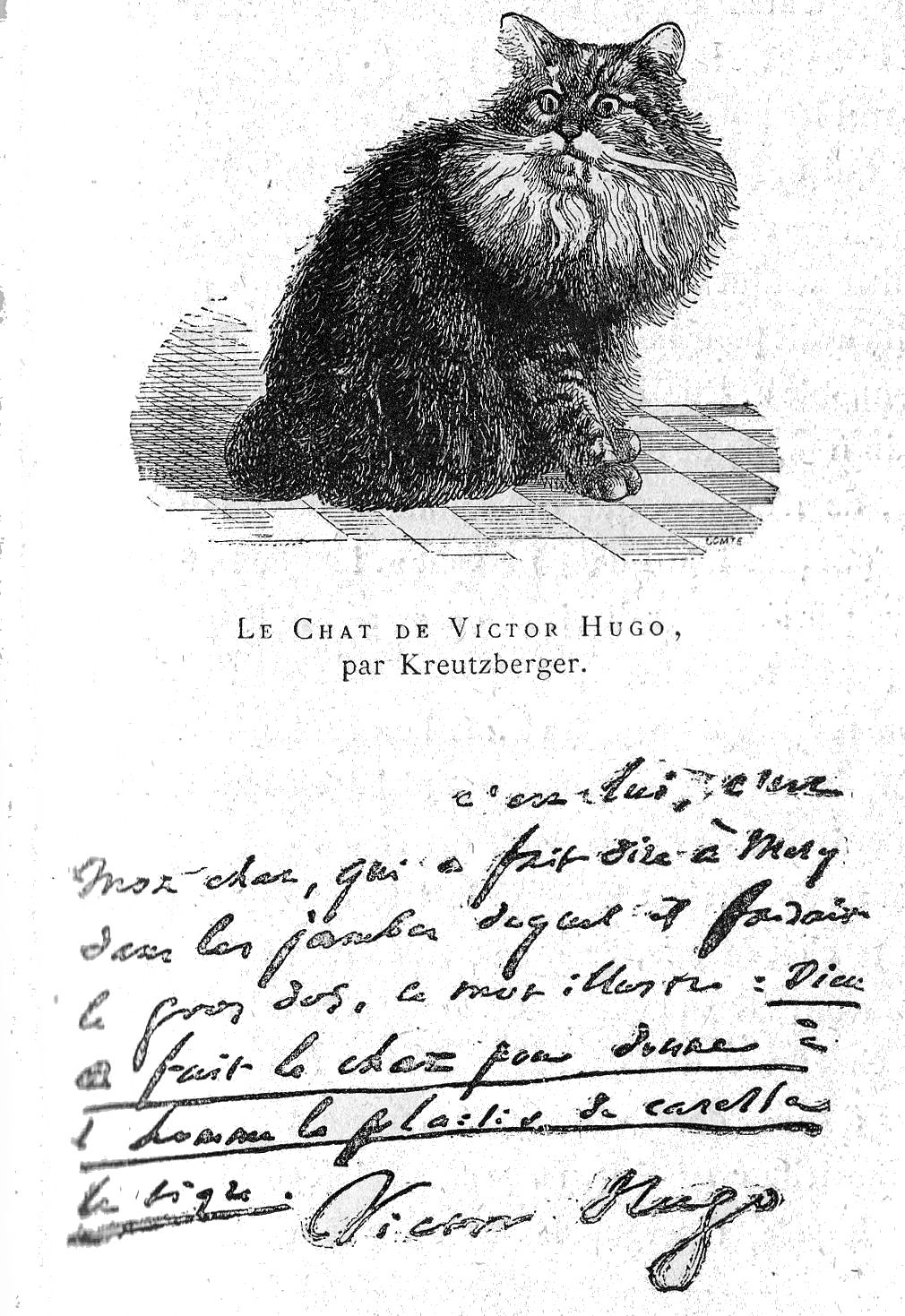
Champfleury was more eclectic - he loved dogs and adored cats. He wrote "To understand the cat, one must have a feminine and poetic spirit".
Théophile Gautier was a disciple dear to the master Hugo, and inherited most of his passion for cats. Gautier possessed a very complete collection, from the wildcat to the aristocratic angora, and it was he who wrote: "The pashas like tigers; I like cats; cats are the tigers of the poor devils. Apart from cats, I do not like anything ... " Yet, at one time, Gautier divided this tenderness between cats and white rats – a most strange combination!
We better understand the critic Sainte-Beuve’s cat, Palémon. This was a magnificent cat with a tiger-striped coat, who had his franchises in his master's study, stretching out his supple furry back across the mountains of scattered books, beating the air with his nervous tail, scarcely opening, in his voluptuous laziness, his large, round, green-gold eyes.
He purred at the grumbling caresses of the critic and reserved his best hugs for a friend of the house, Théophile Gautier. At Gautier’s approach, Palemon convulsed himself, and feverishly lay down under the broad, soft and yielding hand, arching his back or flattening himself, snake-like, constantly returning to himself, never tiring of this, as though hypnotized, as though drawn by magnetism.
It is said that one day Palemon brought back to his master one of his female friends which he had, no doubt, met on a roof in the neighbourhood. The latter was round-bellied and gave birth in Sainte-Beuve’s study, then the perverse mother abandoned her kittens and fled, leaving them to be bottle-fed.
There were six of them, who survived and were distributed around the neighbourhood. For several days, one of the windows on the ground floor of No. 11, Rue a Mont-Parnasse displayed a sign with the following inscription: "We have kittens to give to people who would like them and promise to look after them."
Merimee credited cats with a great deal of intelligence, and recognized no other faults apart from excessive sensitiveness. According to him, the cat proves his sensitiveness by extreme politeness. "In that," he said, "the animal is much like well-brought up people."
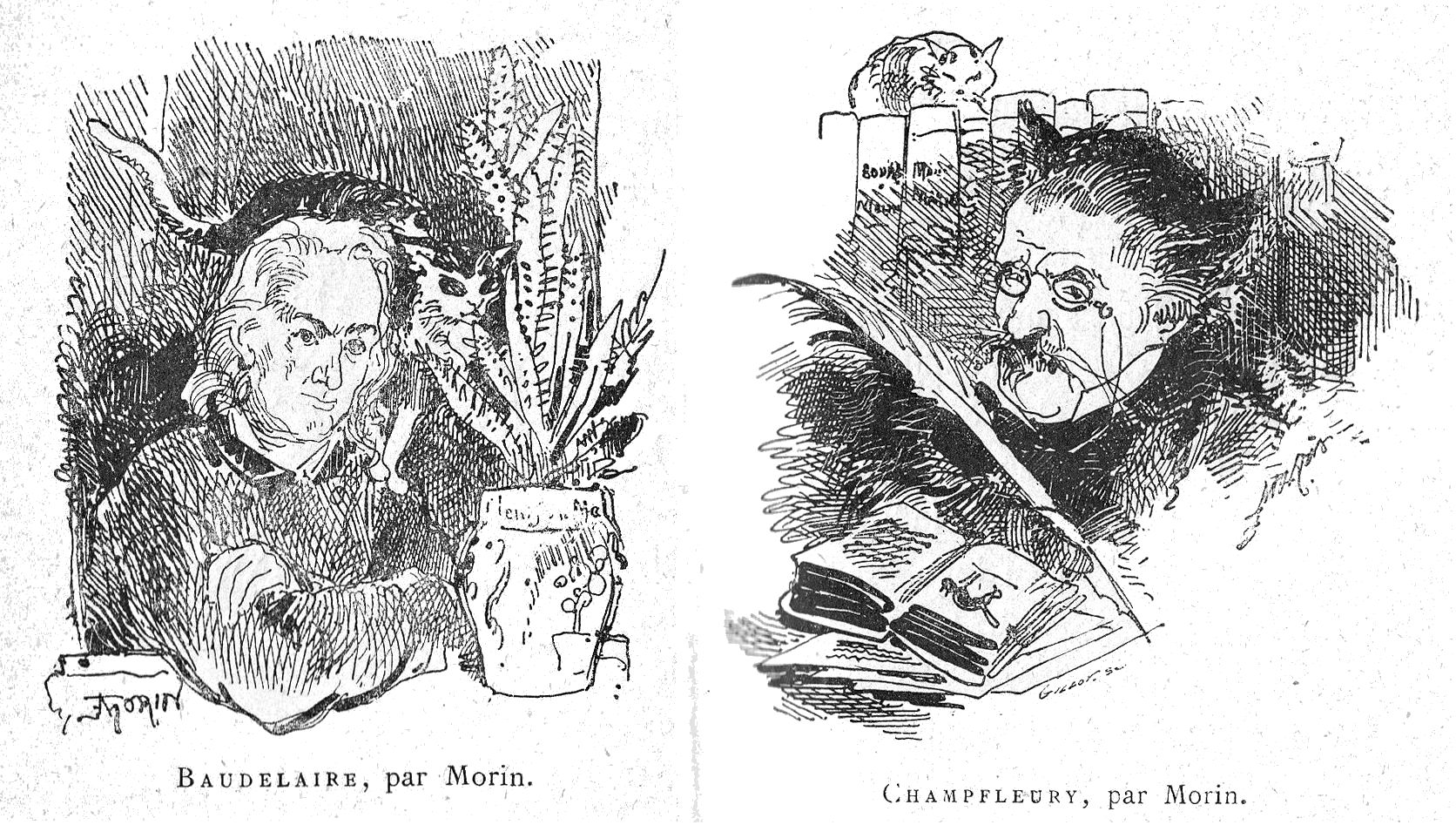
Baudelaire, an electric creature, when he was in health, had a friendly rapport with cats. "Many a time we have walked together [Champfleury, the Cats], and we stopped at the door of laundress’s shop at the door of a laundress’s establishment to look at a cat luxuriously curled up on a pile of linen, drunk on the fragrance of the newly-ironed fabric!
"How often we have fallen into contemplation in front of these windows, behind which the young and coquettish laundresses made pretty faces believing themselves to have admirers."
Cats, the objects of Baudelaire’s tenderness, and praised in one of his most beautiful sonnets, became a subject of ridicule in the petty press for a long time.
[It would be remiss of me if I did not mention Baudelaire’s much admired sonnet, The Cat:
Come here, my beautiful cat, onto my loving breast:
With your claws in soft paws restrained,
Let me plunge into your eyes, become lost
In metal shine mixed with agate.
When my fingers caress you at leisure
When I stroke your head and elastic back,
And my hand becomes drunk with the pleasure
Of feeling your body, electric,
Then I see my lady in spirit. Her glance,
Is like yours, sweet creature,
Deep cold slits that pierce like a dart,
From her feet to her head I can sense
A subtle atmosphere, dangerous scents,
That hover around her brown body.

"After the example of Hoffmann, Edgar Poe and Gautier, it became fashionable in this little corner (of Baudelaire and his companions) for loving cats too much. He is one who, when he goes to a house on business for the first time is ill at ease and worried until he has seen the household cat. But when he sees it, he rushes to it, caresses and kisses it; and is so completely occupied with it that he makes no answer to anything that is said to him; he is a thousand leagues away with his cat. People stare at this breach of propriety, but he is a man of letters, an exxentric, and the mistress of the house henceforth regards him with curiosity. The poet’s turn is served. Let us only astonish the world!" In this long, dull and simple pastiche of La Bruyere, Baudelaire is especially reproached for disliking dogs. No doubt that the barking of the dog was irritating for his delicate organs. To those who see life as only a kind of steeplechase strewn with obstacles to be overcome, and who have no time for contemplation or meditation, the cat, being an independent and contemplative creature, is quite useless, just like a poet.
May I also quote the dramatic author Théodore Barrière as a cat-lover? He always had half a dozen around his legs and was gladdened by their games and affection. One day, his collaborator Lambert Thiboust asked him why he surrounded himself with cats like a door curtain. "My dear," he replied, "it's been since I've known men." Barrière has provided us with the story of one of his companions, a very sweet Angora, who answer to the name of Fanfan.
Fanfan was a philosopher and one fine day became fond of a wood pigeon. Cat and pigeon – the latter being called Corbin - made a curious but excellent household. Henri Murger, a close friend of Barriere, contemplated this singular friendship with skeptical astonishment:
"It’s a bad relationship," he said to his friend, "you will see that it will end badly ... One day or another the pigeon will eat the cat!"
One morning, however, Corbin was in the mood for travel and wanted to see more of the countryside, perhaps drawn by love to some neighboring dovecote. He flew away, too far away, and returned to his lodging at night with his wing half broken by gunshot, and his flank bleeding.
Fanfan received him joyfully, placed him in the basket, nursing and licking him ... But she became intoxicated by the taste of blood and the idyll turned into an awful tragedy ... During the night, there was the sound of a struggle, with fluttering wings and plaintive, heart-rending cries, drowned out by ferocious roars and wild oaths. Then there were sinister sounds of bones cracking ... When the sun rose above the horizon, you could see Fanfan was alone in her basket, in the midst of a cloud of feathers. Around her were gruesome limbs and shreds of living flesh - wretched Fanfan was digesting her friend! – She went to sleep as a cat ... and she awoke as a tiger!
One of the greatest cat lovers of today seems to be the poet François Coppée. Just like the passion of cardinal Richelieu, he never had less than six or eight, not counting the sometimes numeorus guests.
During winter evenings, while a good fire flickered in the hearth, the poet sat at his desk, working by lamp-light, while his cats, lined up in single file, sat silently apart from the occasional ripple of the tail that reflected the restlessness in their bones.
Sometimes Coppee interrupted his work and arose to fuss his cats, talking with them, as if with children, admonishing them and giving them advice:
"Cats are such terrible undisciplined animals," he told them gravely. "Haven’t you noticed that they always die such tragic deaths? – Let that be a lesson to you!" Then, smiling, he added "There is not a single example where we see a cat die in his bed!"
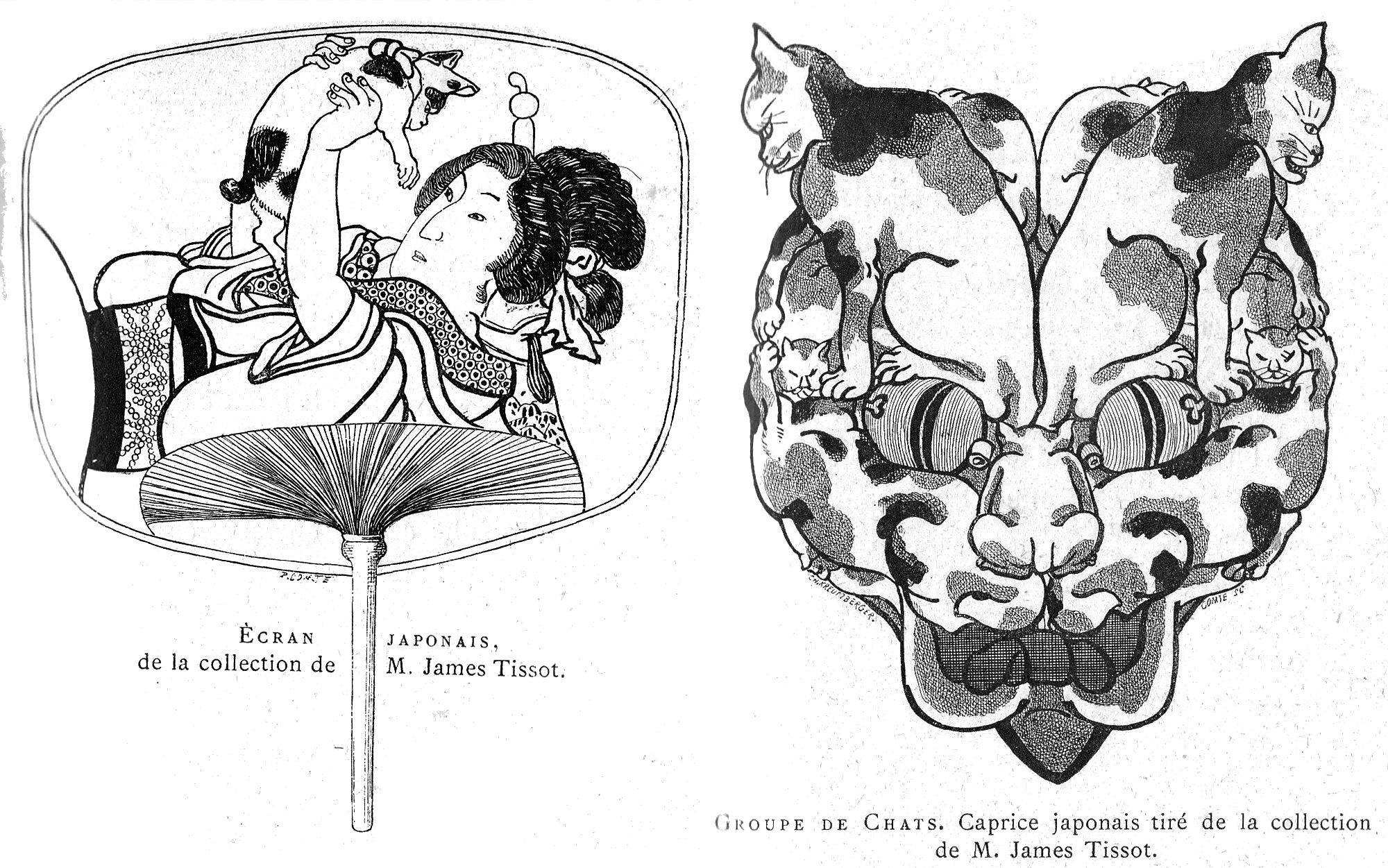
CHAPTER XI – CATS IN THE ARTS
I have already mentioned how often the cat is represented on the monuments of ancient Egypt. As a solemn animal with a rare refinement of lines, the cat played an important role in painting, sculpture and even architecture. Among Egyptians, representations of the cat sometimes offers a domestic character. We could even say that they were the only people of antiquity who understood the statuesque quality of the animal without departing from reality.
Sitting oddly, it sometimes appears in the manner of sphinxes. At other times a cat’s head is mounted on the body of a god, or it is fused to musical instruments in strange forms. More often, though, it is shown lying on its mistress’s chair or lying on a carpet nursing kittens.
After the Egyptians, we must mention the Japanese, whose curious albums, introduced in recent years in France, prove that they are unexcelled painters of cats, just as they are of women and fantastic creatures. Once again we see this association between cats and women!
Some Japanese vignettes are reproduced throughout this book; they are taken from the sketchbooks of a wonderful artist, who died in Japan some sixty years ago. Champfleury also appreciated the talent of this artist who was popular throughout the Orient. Known as Hok'saï his real name was Fou-Kou-Say:
"The best way to understand his merit is by likening him to Goya. He has the same whims and fantasy; even his manner of engraving offers a very marked analogy with that of the author of Caprice. Hok'sai has done more to make the knowledge of Japan easier than travelers and professors of Japanese who do not even know Japanese. Thanks to the profusion of art in his notebooks, we are able to appreciate Japanese civilization and the intelligence of a people who, far from falling asleep in the tradition of the past, like the Chinese, walk resolutely towards the conquest of European industrial discoveries.
"This is not the moment to make sensitive generalisations, but such is the power of art, that a simple sketchbook opens horizons that are difficult not to point out.
"Hok'sai was a deeply original artist, and although some of his detached drawings may suggest a kinship with Goya's sketches, it can be said that the Japanese artist knew nothing of Spain's artistic riches, of the author of Caprice and the Bullfights, these being absolutely unknown fifty years ago even in France."
"Hok'sai found material to exercise his genius in nature, in the institutions of his country, in the habits and customs of its people, in the popularity that the sketchbooks obtained, and more than anything else, I was struck by his genius because of his studies of cats."
One whole page of one of Hok'sai's albums is devoted to twenty-four sketches of cats in different positions, and we are the first to regret not having been able to give more to our readers.
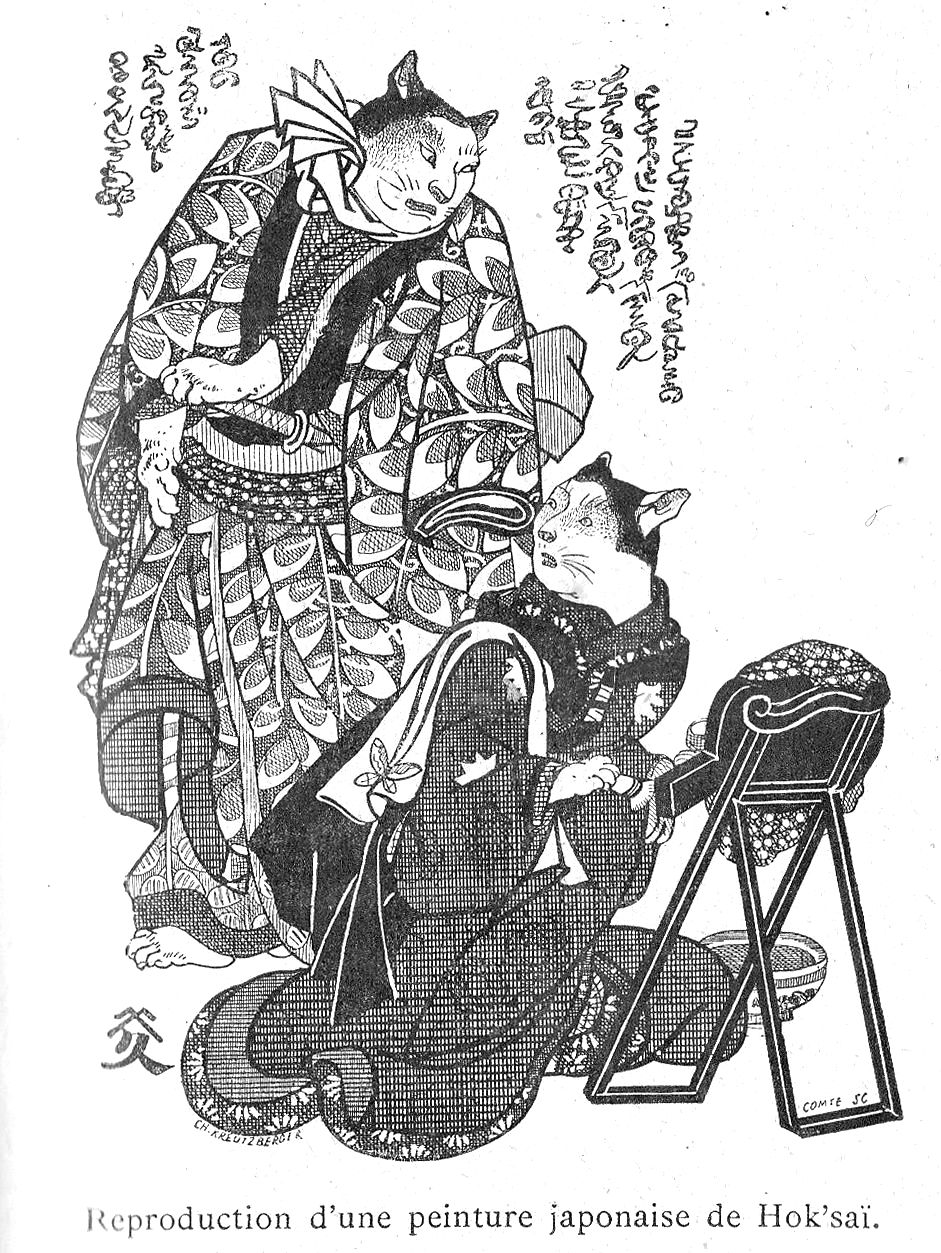
Another famous cat painter was Godefried Mind, nicknamed the Raphael of Cats, who was born in Bern in 1768. Of Hungarian origin, he was a student of Freundenberger who left little trace in the history of art. Mr. Depping, in his Universal Biography, gives us some notes on Mind. I’ve extracted some details from his article that may interest those calling for artists to make better interpretations of the feline race.
Mr Depping says "A special taste led Mind to draw animals, or rather two kinds of animals, bears and cats. The latter especially were his favourite subjects, he delighted in painting them in watercolours in all sorts of attitudes, singly or in groups, with truth and naturalness which have never been surpassed. One could almost say his pictures were portraits of cats; he gave every shade of expression to their soft and cunning faces; he lent infinite variety to the graceful attitudes of kittens playing with their mother; he perfectly depicted the silky coat of these creatures; in short, the cats that painted by Mind seemed to be alive on the paper. Mrs. Lebrun, who never failed to purchase some of this painter's works on each of her visits to Switzerland, called him ‘the Raphael of Cats.’
"Several royal personages, travelling in Switzerland, wanted to have Mind’s cats. Swiss admirers and other enthusiasts carefully kept his work in their portfolios. The painter and the cats were inseparable. During his work, his favourite cat was almost always beside him, and he had a kind of conversation with her. Sometimes this cat sat on his knees and two or three kittens would be leaning over his shoulders. He remained in this position for hours without moving, in order not to disturb these companions of his solitude. He was not so kind to the men who came to see him, and received them in a very bad mood.
Mind probably never in his whole life experienced more profound grief than that which was caused by the general massacre of cats ordered by the Berne police in 1809 because of rabies breaking out among cats. He managed to save his dear Minette by hiding her, but his grief at the death of eight hundred cats sacrificed in the name of the public safety was overwhelming. He was never entirely consoled.
It gave him great pleasure to examine pictures or drawings which represented animals. Woe to the painters who had not represented his favourite species with perfect fidelity! They obtained no favour from him, even if they had talent elsewhere.
"During winter evenings he still found a way to occupy himself with his beloved animals by carving chestnuts into the shape of cats and bears. These pretty trifles, which were executed with marvellous skill, were output in great numbers.
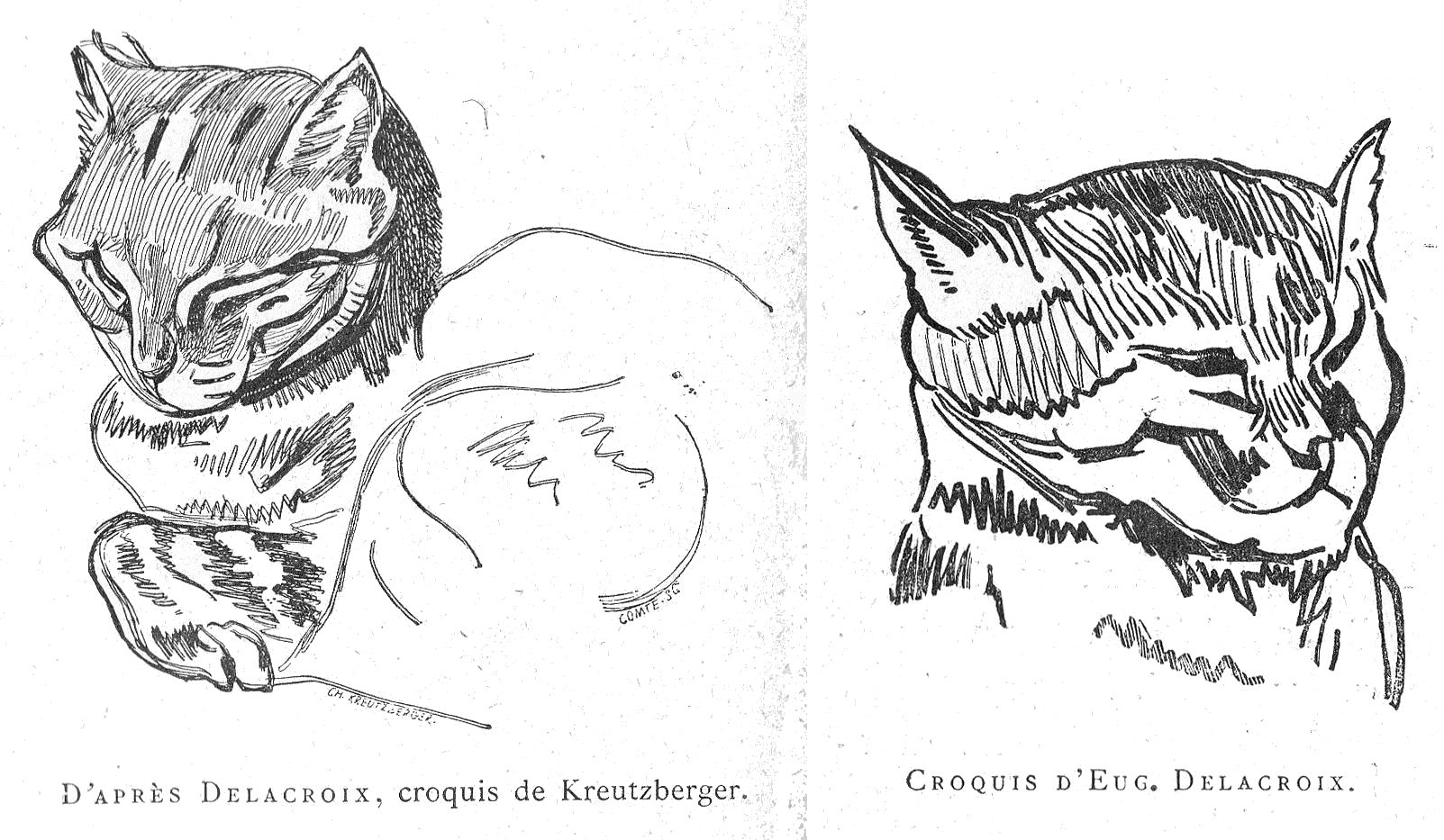
Mind was a short man, with a big head, very deep set eyes, a reddish-brown complexion, a hollow voice, and a sort of rattle in his throat, which, together with his gloomy expression, produced a repulsive effect on those who saw him for the first time. He died at Berne, on the 8th November, 1814. The verses of Catullus on the death of a bird were pleasingly parodied and applied to him:-
Lugete, o feles, ursique lugete,
Mortuus est vobis amicus;
[Grieve, oh cats and bears mourn
Your friend is dead;]
also another line by an ancient poet:-
Felibus atque ursis flebilis occidit.
[He died with/from cats and doleful bears.]
The English painter, Burbank, also had a specialty similar to that of Mind, but art books and biographical dictionaries do not mention him.
With the exception of the Dutchman Cornelius Wischer, whose wonderful cat has become characteristic, foreign artists and also many of our compatriots who introduced cats into their paintings seem to have found their models among the stuffed specimens of naturalists. Even Eugene Delacroix, a feverish and nervous creature, despite all of his persevering studies of this animal, never managed to give cats their true form, but made tigers of them. J.-J. Granville was particularly interested in the physiognomy of cats. The "Magasin pittoresque" [Pictorial Magazine] of 1840 published a series of his sketches in which the caricaturist was concerned with the physical relationship of men and animals. Among his cat drawings, some have become, so to speak, classics: Calm digestion; Tenderness and gentleness; Philosophical reflections; Anger mingled with fear; Fury and fright, all shades of an excessive intricacy that none of his predecessors had tried to capture, being more preoccupied with the movements of the body, or the lines of the head.
It seemed to Granville that the principle of the physiognomists, that the face is the mirror of the soul, was applicable to some extent to animals. To succeed as he did must certainly have taken the artist a very long time to patiently observe the cats around him. We have chosen from the seventy-five sketches of Grandville those which best reproduce the cat’s most usual poses.
Here he is shown sleeping. Is he dreaming? Maybe, but of what? Of she-cats or of mice? Of both, no doubt. His jaws are slack, his ears twitch, his legs stiffen, his back bristles and arches - he is waking up. Now his eyes are fixed on the earth and he is absorbed in his thoughts, meditating like a philosopher. A noise, however slight, suddenly brings him back to reality, his face lights up, his eye comes to life: he saw a buzzing fly or heard a rustling that sounds like a rat trotting or gnawing. And here his wide open eyes wide are fixed and radiant, drinking in all the available light, contemplating the sky or the flying birds, or the young mistress who spoils and coaxes it.
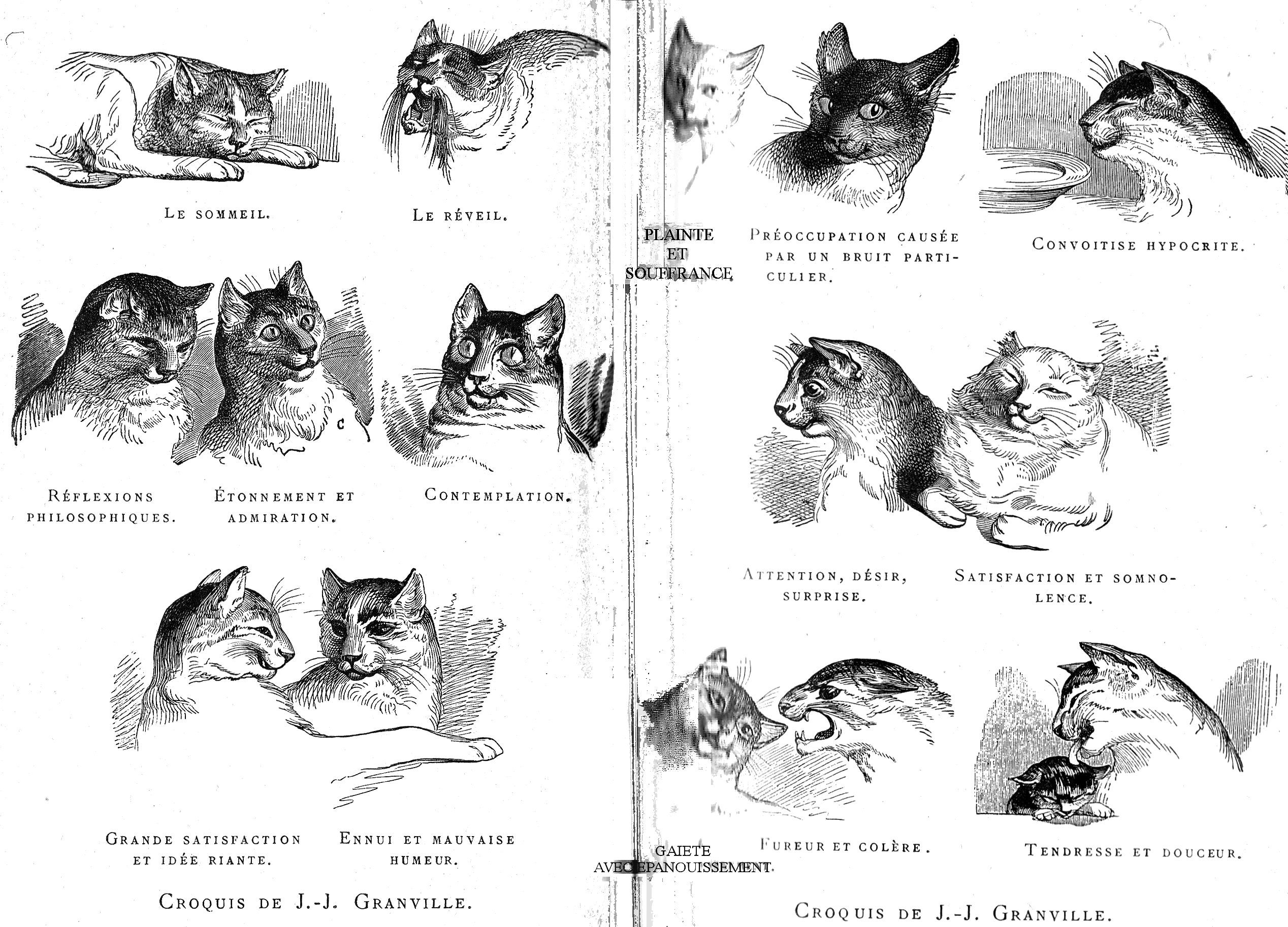
Now look at this laughing and malicious expression; certainly Minet has just made some joke; the brigand must have committed some petty larceny. What a difference from his frowning face during the dark hours! His eyes darken, his eyebrows furrow, his cheeks, whiskers sag with boredom; something must have disturbed Minet, or perhaps his food is not to his liking. Is Minet so difficult? No, it's just that Minet is hungry, and has not yet been given his milk, and that’s why he complains. Now he hears the door open and that beautiful cup of warm, sweet milk is brought for him; his little spirit awakens, he is ready to leap up as the sweet voluptuous odour stirs his sense of smell. At that moment, doesn’t his face look just like that of agreeable guests who mix excuses and thanks in equal parts while their plates are filled to the brim?
Very calm now, Minet digests his meal; a true cat, he settles comfortably for a nap; blinking his eyes and puffing out his cheeks, let’s not disturb him.
Now look at this mother cat: what mother caresses her child and washes it with more grace, more lovingly. . . and what child in such circumstances is as patient as a kitten!
Who is this one whose face lights up with so much gaiety? It's Minet who will use his nails on the back of a sofa or on the arms of an armchair. Yes, but beware of correction, Minet fears it, but he will be able to avoid it.
Poor Minet, it's his final act, his eyes are dull, his body is stiff. These are the blessings of Minet, his soft and supple poses. Farewell! Minet! Alas poor Minet!
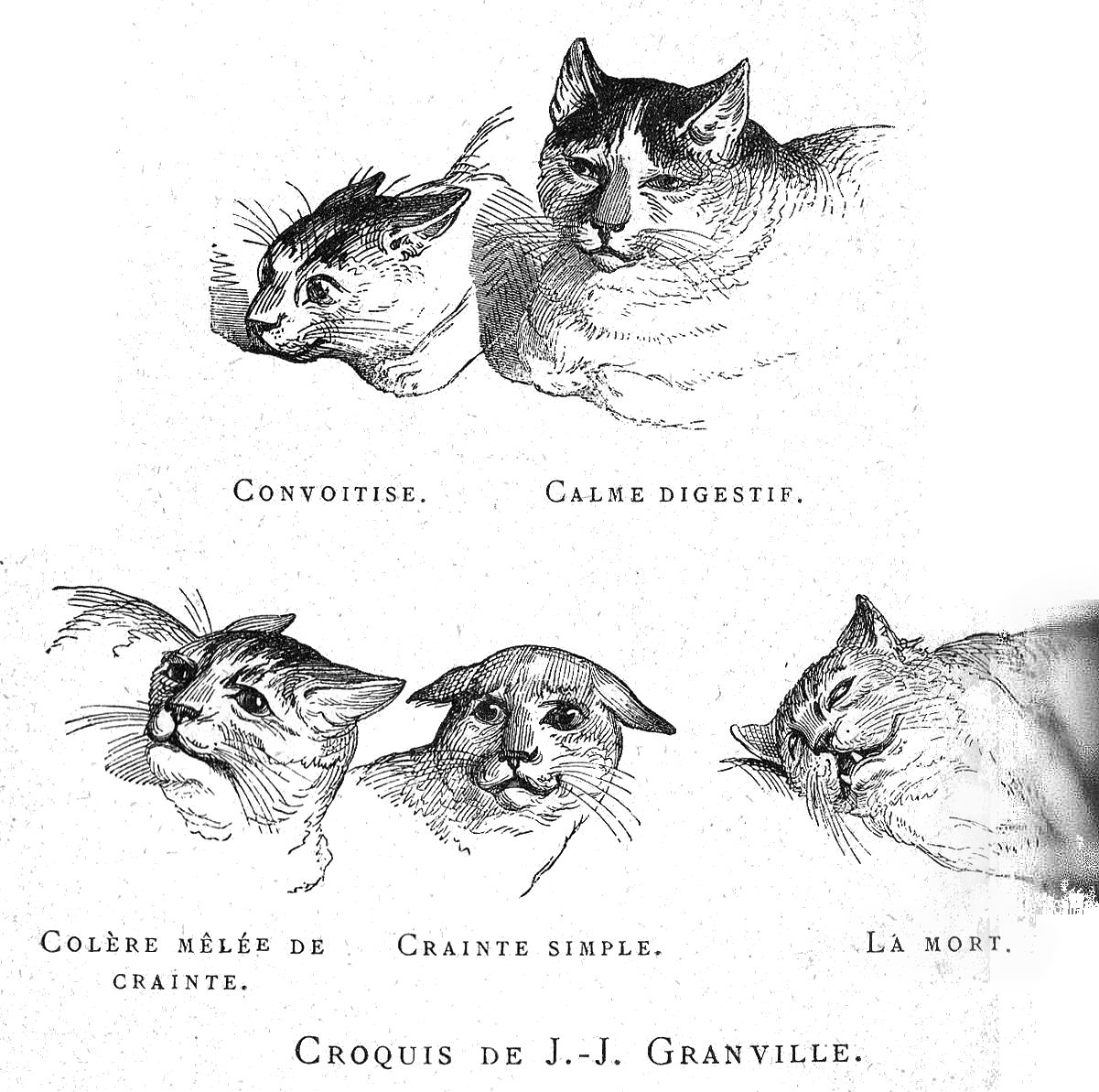
I have tried to translate - was it necessary? - Granville’s sketches. In order to obtain these various attitudes, he had his cat put in his studio and doubtless the physiognomy of the excellent Minet must often have expressed boredom. Grandville did not give us a portrait of a cat annoyed by having to pose for his master, so there is a gap in this curious and well-observed series.
"The actor Rouvière, the actor, writes Champfleury, was truly feline by nature and was tormented by his desire to represent his sensations by the brush. He fell in with Carlin, the harlequin of Italian comedy, who lived surrounded by cats and who proclaimed himself their pupil.
A picture of Rouvière explains certain movements of that actor, who was remarkable in Hamlet for his quick, strange, and caressing gestures: Rouvière painted a cat full of indulgence for her kitten who is contemplating some mischief. The curious curiosity of the little red kitten starting out in life is manifested in its mischievous eyes which are observed by its mother who once had similar whims. The lines are so delicate, the eyes so particularly unusual, the movements obedient to such sudden impulses that one must be feline oneself to portray such a subject. " [Les Chats, Champflery.]
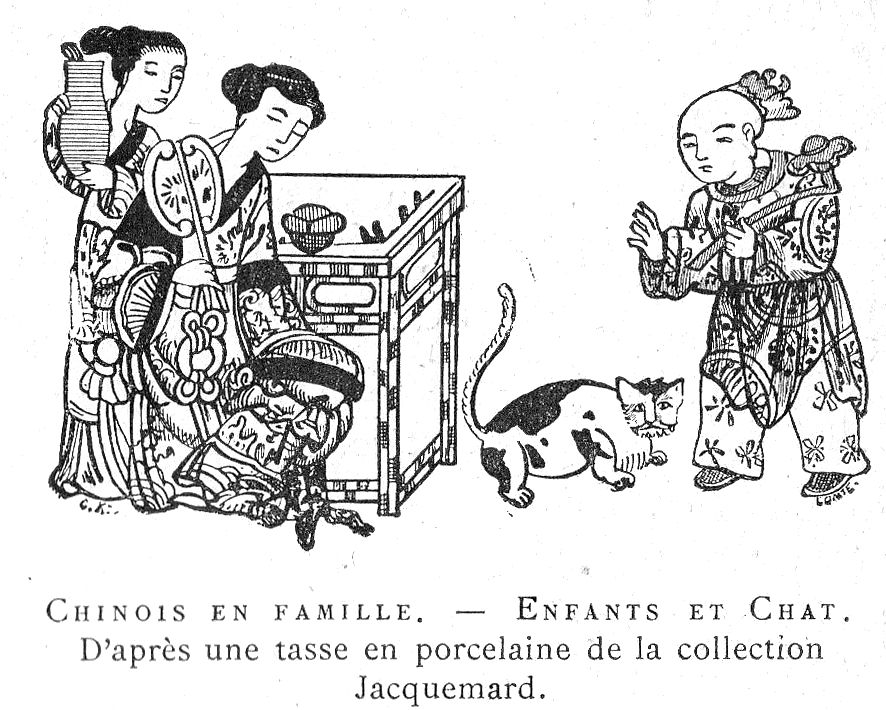
Saint-Germain, a modern and refined comedian who is a friend and pupil of Eugène Lambert, has kindly provided me with the originals of some of his sketches, finely composed with a great originality of touch, intended to illustrate the monologue by Feydeau which can be found at the end of this volume. The contribution of this likeable comedian was accompanied by a witty appreciation on the cat, which deserves to be shared.
"The Cat," writes Saint-Germain, "is a much-slandereds animal: the people who denigrate him reproach him for not having the qualities of the Dog. How wicked - it's a cat! Toussenel reproaches him for loving asparagus, how can this harm Mr Toussenel? The Cat is elegant, beguiling, discreet, and I like that. He is independent and interesting, and I dislike dullness. He does not always have a nose in the backsides of his fellows, for which I am grateful. When he has had a good lunch, nothing will disturb him, neither cake nor meat; what kind of dog could we say the same about? He is accused of hunting birds, so what! What does man do? It’s just professional jealousy! Mother nature has made the cat a hunter and fisherman and he is much more worthy than a man to hunt because he uses his cleverness and not a rifle! I have seen wonderful cats, and the females are generally the most intelligent. You say they only love the house? So what! Yhis often has merit, because the dwelling is not always sumptuous, but he doesn’t leave it for a more beautiful, so this is a virtue! He knows his master very well, understands his moods, anticipates him, and is always with him.
"It is a charming animal, very clean, clever, cuddly, and its whole anatomy is most admirable. Didn’t a German scholar dedicate an entire album to the Cat's analomy?
Rouviere, we shall see later, has a worthy successor among the actors in the person of Saint-Germain.
What can I say of modern artists? Their works are so well known that they need no comments: Lambert, will remain known as the "Painter of Cats," and Henriette Rönner has a very exact sense of the delicacy of the cat's lines. Among the whimsical artists we have Willette whose cats and pierrots always get along well, and Steinlen, some of whose drawings a special charm. Among the foreigners who aren’t well-known in France, we have Specht of Berlin and Harrison Weir, the English painter who is also the president of Cat-Club of London.

Still others have drawn or painted cats, but many of them have let their imagination run free, not suspecting that nothing is harder to portray than a cat’s face which, as Moncrif rightly pointed out, bears a character of "finesse and hilarity".
It seems that in architecture people are less concerned about the cat. In the Middle Ages, when the facades of monuments were decorated with fantastic beasts, few show cats although it was already well known and was a common household animal. Doesn’t the author of the Romance of the Rose compare the cat for its fur and its vigor to a prebendary canon? [A clergyman paid by the church.] It is strange, in any case, that the feline face did not provide the artists of that time with a grimacing motif in their collection of devilries that run from top to bottom of eleventh and twelfth century churches.
Mrs. Félicie d'Aizac, who has written a comprehensive work on zoology relating to architecture [Revue de l'architecture, volume VII, 1847-48], introduces the cat into symbolism; but it is impossible to draw a single precise fact from this whirlwind of archaeological sights. The cat is less rare on monuments from the Renaissance. In the museum of the city of Troyes, we see a capital from the fifteenth century that represents a cat.
Champfleury also mentions the bas-relief adorning the door lintel of a house at Ricey-Haute-Rive, a primitive sculpture that represents a cat in the company of chickens, a fox and a sort of rat.
No doubt the artists regarded cats as lacking nobility and left the representation of the cat to the sculptors of signs.
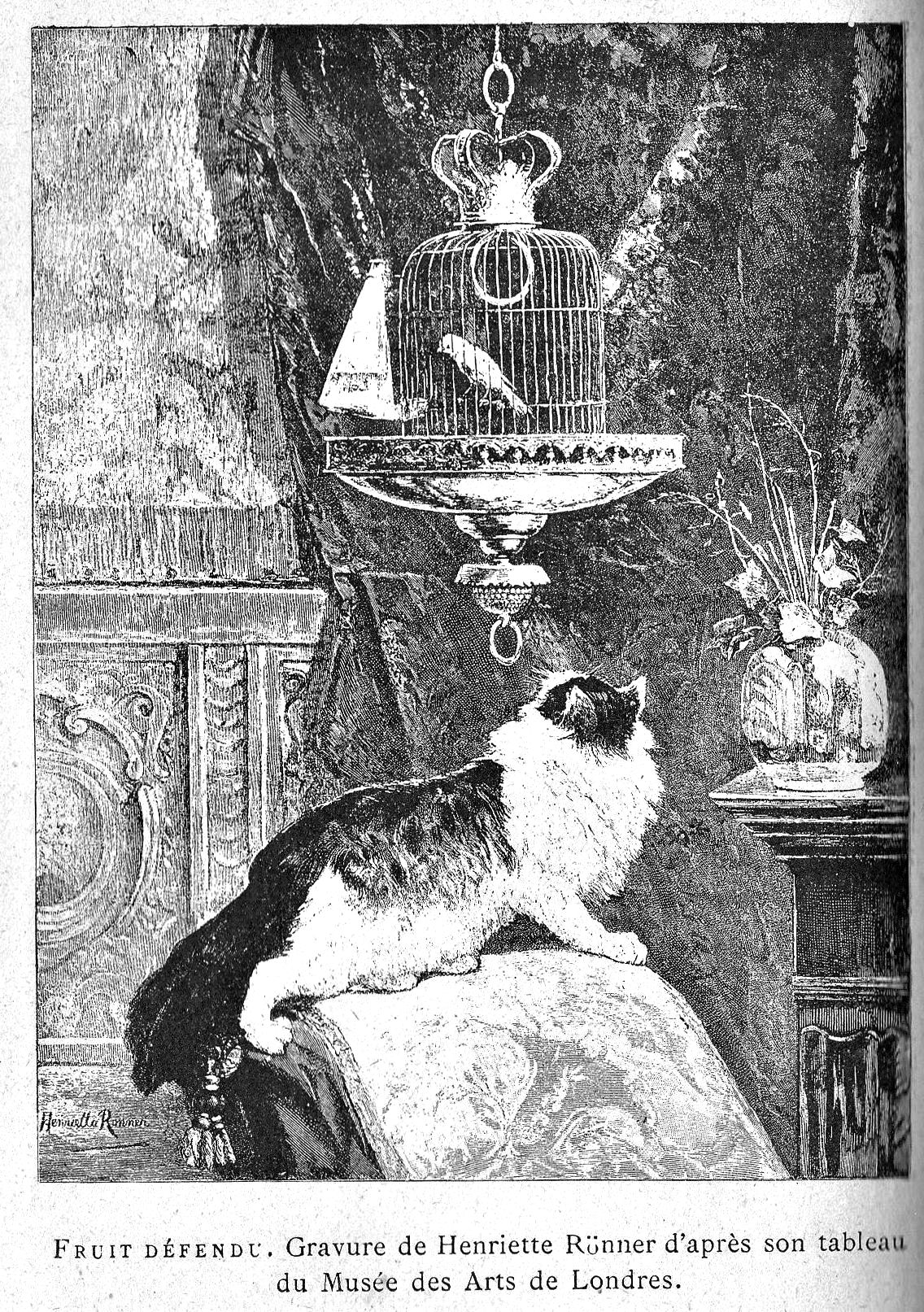
CHAPTER XII - COATS OF ARMS AND SIGNS RELATING TO THE CAT.
An odd animal, the cat naturally had to become part of the heraldic bestiary, composed mainly of noble animals, but also of chimeric animals. Vulson de la Colombière, who gave examples of some heraldic cats in his Book of Heroic Science, says:
"Just as the lion is a solitary animal, the cat is a whimsical creature whose eyes see clearly and sparkle in the darkest nights, and wax and wane in imitation of the moon; for just as the moon, reflecting the sun’s light, changes its face each day, the cat has such affinity with the moon, that its pupils grow and shrink at the same time as that celestial body waxes and wanes. Many naturalists assure us that when the moon is at its fullest, cats have more strength and skill to wage war upon mice than when it is weak. "
Another commentator [Pierre Palliot] on coats of arms gave a different interpretation which seems preferable to me:
"The cat is more harmful than useful, its caresses are more to be feared than desired, and its bite is deadly. The reason it gives us pleasure is amusing. According to a fable, the moment the world was created, the Sun and the Moon both wanted to populate the earth with animals. The great, fiery, and luminous Sun created the handsome, bloody and noble lion. The Moon, seeing the other gods admire that beautiful work brought from the earth a cat which, compared to the lion, was as disproportionately beautiful and brave as she (the Moon) was weaker than her father (the sun). This contention brought laughter and indignation; the laughter coming from the audience and the indignation from the Sun, which was outraged that the Moon had tried to match him and who showed his contempt by creating the mouse.
[Créa par forme de mépris
En mème temps un souris.]
"But because her sex never surrenders, the Moon made things even more ridiculous by producing the most absurd animal of all: a monkey, which caused a disproportionate laugh among the company of gods. Fire spread over the face of the Moon, so much so that it seemed to threaten them with a storm, or with an impulsive wind, and she made a final effort to avenge herself eternally against the Sun, by creating immortal hatred between the monkey and the lion, and between the cat and the mouse. This hatred is the only benefit we derive from the cat."
In the old days we saw fantastic cats on the banners of noblemen, something like the dragons that adorn the banners of the Chinese.
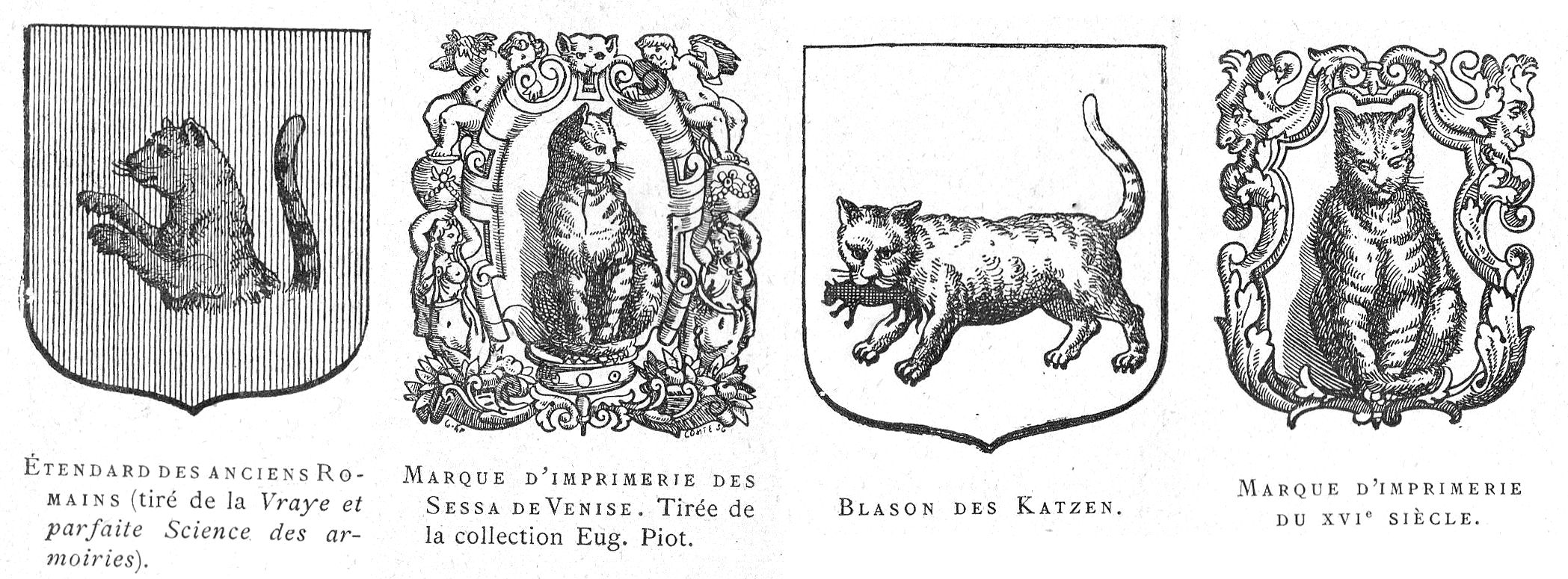
In his book, "The True and Perfect Science of Coats of Arms," Palliot said that the Romans frequently put Cats on their targets and shields. The company of soldiers, Ordines Augustei, who marched under the command of the Colonel of Infantry, carried white or silver shields bearing a cat of the colour of the mineral prase, which is maple-leaf green, or sea-green. When speaking of the gules the Cat was shown running and turning its head to its back. Another company of the same regiment, known as the Lucky Old Men, "Felices Seniores," wore a half-cat or front half of a rampant red cat on a vermillion buckler, or gules "in parma punicea diluciore," that is with its paws up as if wanting to play with someone. Under the same chief was a third gules, a cat with one eye and one ear walking to the left, with its right paw raised, on a green roundel with a silver border; this was worn by those soldiers known as the Alpines].
Here I will give a drawing of one of standards according to Palliot, as this author imagined it existed among the Romans.
The leopards, which the Normans passed on to the English in their coat of arms, were probably originally cats. For the Suevi, Vandals and Alains, who carried black cats on a silver background, it was the symbol of liberty.
The Burgundians had a cat in their coat of arms.
Also according to Palliot, Clotilde "Bourguignotte, wife of king Clovis, wore black cat on a golden background killing a rat of the same colour".
The Katzen family wore a silver cat on an azure background holding a mouse.
The Chetardie, a Limousin, wore an azure field with two silver cats, one on the other.
The Della Gatta, Neapolitan lords, wore azure bearing a silver she-cat with a ragged throat in chief.
Chaffardon wore on azure three gold cats, two full-face in chief.
Many more coats of arms can still be seen in the blazons of European families.
In heraldic terms it is said to be Hérisonné when the hindquarters are raised higher than the head, and Effarouché when it is lowered on its paws or even crawling.
But as we move away from the Middle Ages, the cat means independence. A cat was the "mark" of the firm of Sessa, printers of Venice in the sixteenth century.
The hagiographers always depict Saint-Yves accompanied by a cat. Henri Estienne maliciously observes that this animal is the symbol of the judiciary.
It was up to the French Republic to put forth this animal by adding it to its glorious coat of arms, placing the cat next to the Statue of Liberty.
They will repay you, heavenly godmother,
Your companion will be the wandering cat,
That Gaul loves with you,
And certainly that living portrait
Suits you better than the bonnet
Our artists have put on your head...! [Guyot-Desherbiers.]
Prudhon, the republican painter, had composed a curious allegory of the constitution: Wisdom was represented by Minerva and associated with Law and Freedom. Behind Law, children lead a lion and lamb coupled together. Liberty holds a pike surmounted by a Phrygian cap and with a cat sitting at his feet.
The reign of the cat ended with that of the Republic, and afterwards it became only the symbol of perfidy. The frontispiece of a pamphlet called "Crimes of the Popes" shows a cat at the feet of the prelate, it is emblematic of the hypocrisy of treason.
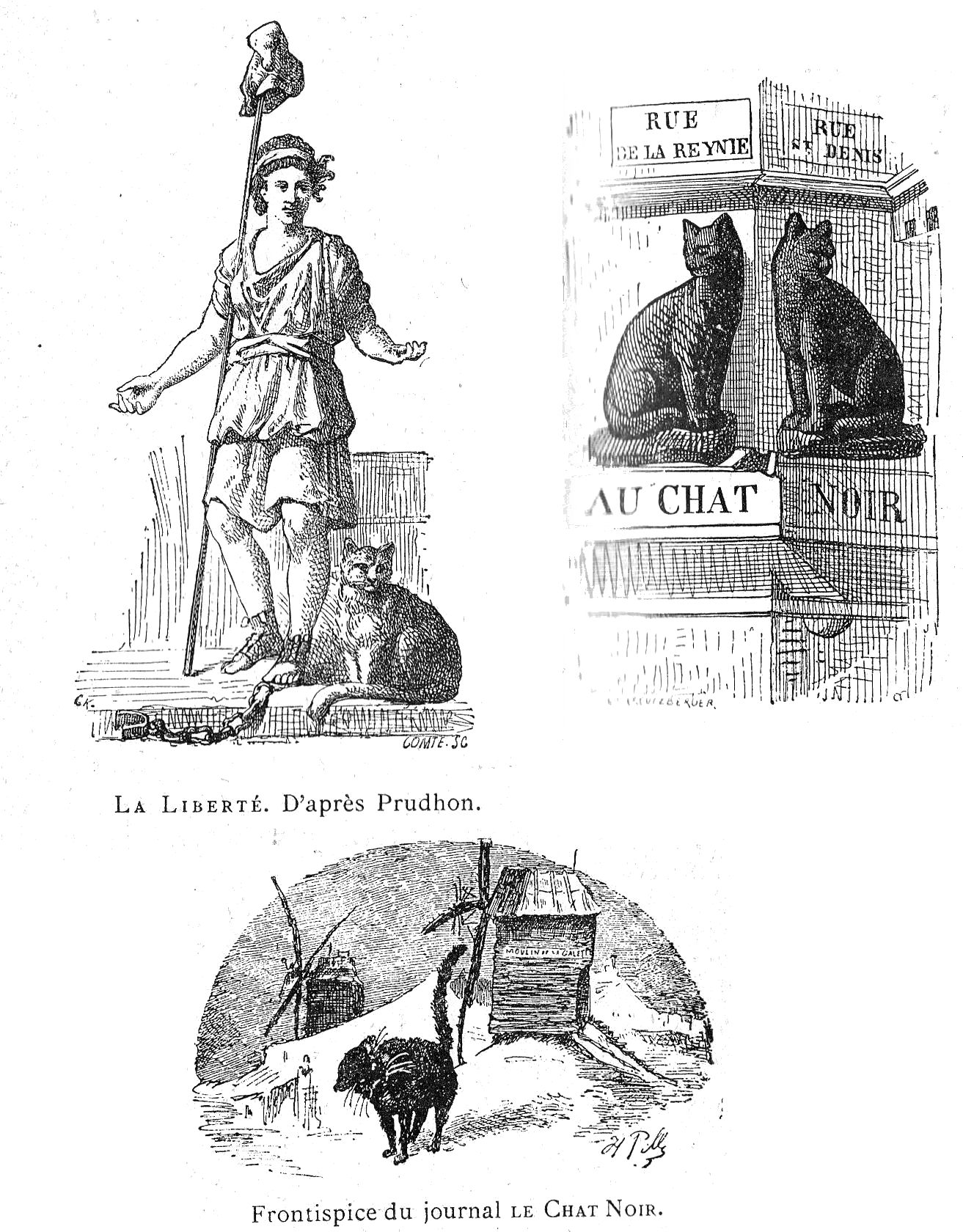
But where we do frequently find the cat is on the merchants' signs, often with unusual captions, for the cat seems to have occupied a considerable place in shopkeepers’ imaginations. How many shoemakers haven’t painted Puss in Boots on their facades? Here is the "Maison du Chat qui pelote" – the House of the cat that rolls itself up, or of the fishing cat. Some which were done in the last century are based on puns, such as "les Chats scieurs" which is a pun on Chassieux. Here is one from the door of a witty shoemaker called "a box full of mischief" which shows a box opening to show a monkey's head, a cat's head, and a woman's head.
How many Black Cat [Chat Noir] are there, the most famous of which was the lamented cabaret of the gentleman R. Salis, Lord of Chanoirville in Vexin.
Salis, who died this year, in the interval we can say, during a tour of his very artistic company, also founded the Chat Noir newspaper, a humorous gazette whose frontispiece from the pencil of Pille, is shown here. It in this Black Cat that Donnay, Alphonse Allais, Auriol, Willette, Steinlen, Boukay, and Lucien Hubert made their debut and so many others arrived in literature, the arts and even politics today. Currently its editor-in-chief is the fanciful Willy (Henry Gauthier-Villars), and he has almost regained its popularity of a few years ago. A very curious edition of the Black Cat appeared a few years ago, entirely written in the Provençal language by Mistral, Paul Arène and Auguste Marin under the title Lou Matagot. In the south of France, Lou matagot refers to the dream cat or the witches cat. Nowadays, this special issue of the Black Cat is much sought after by collectors.
These days, our old customs are being wiped out, just as the pickaxe demolishes all that was dear to the Parisian bourgeois. The loss of these signes is regrettable. I must not overlook one of the oldest houses in the Rue des Lombards, a confectionery that carries two fantastic black cats at both angles of the street corner.
Fans still remember the Grey Cat, which served as a sign for a group of engineers and employees of a railway company. We owed that sign, which has not existed for many years, to the painter Vogler. Then we had the Marauding Cat, the Smoking Cat, and many more.
The cat’s figure, and its proverbial spite, is compared to that of women; its character of domesticity mingled with independence destined it for publicity.
PART TWO
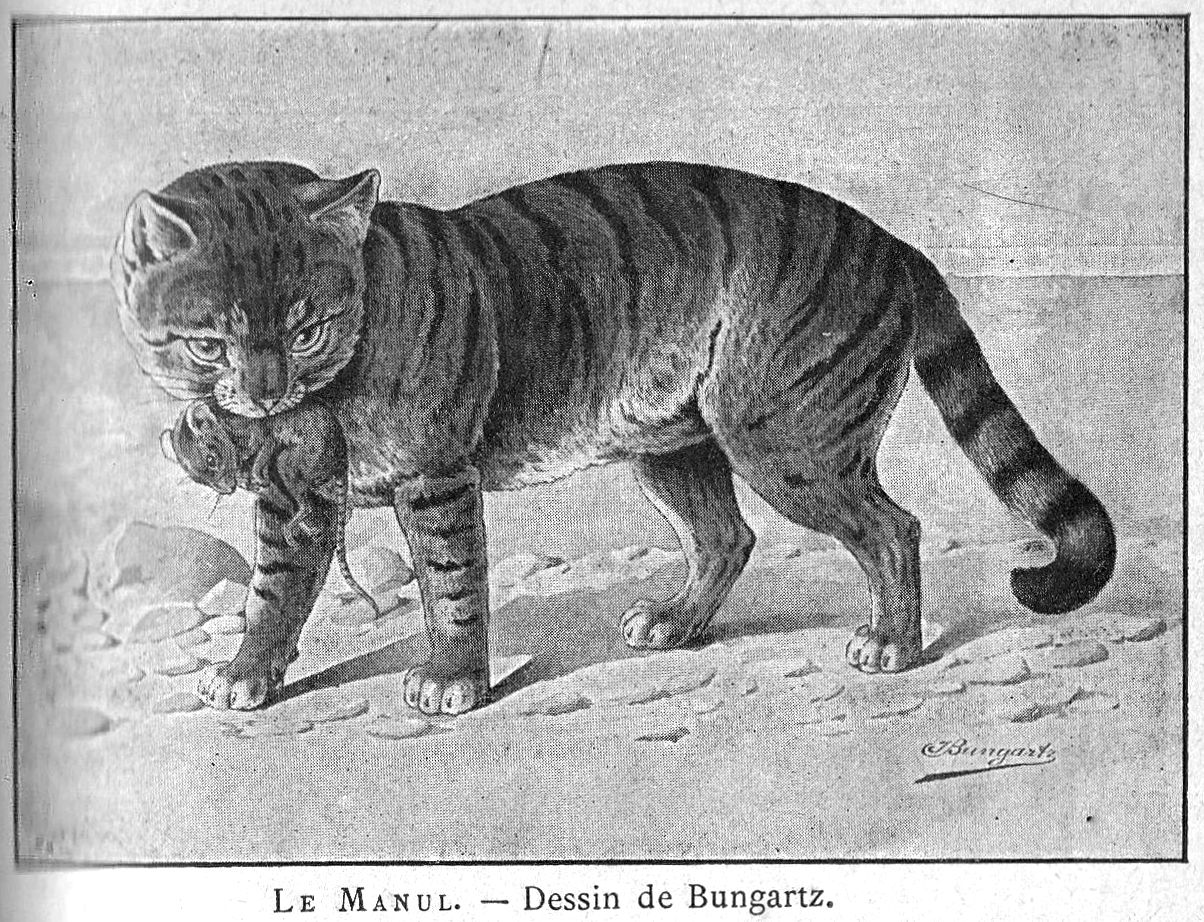
CHAPTER ONE – NATURAL HISTORY OF THE CAT
The "Cat" genus includes all small long-tailed feline species, with no ear-tufts, except for one or two species created recently by the English, and which lack any trace of a mane. I will only deal here with the cat proper, leaving aside the species that are allied to it, such as the lynx and the cheetah, which, although tamed in some countries, are only found in Europe in zoological gardens.
I will not be teaching anything new by saying that the cat is a vertebrate and a mammal, that it belongs to the order of carnassiers, the family of carnivores and the tribe of digitigrades. It forms the genus Felis, the name given to it by Linnaeus in 1735 in his Systema Naturae, thus preserving the name that the Latins had given to this generic group of animals. The general zoological characteristics are a rounded head and muzzle, a short, slightly arched snout and highly vaulted zygomatic arches. The jaws are short and therefore very strong, being armed with thirty teeth, of which there are sixteen in the upper jaw, distributed as follows: six incisors, two canines and eight molars; and fourteen in the lower jaw, six incisors, two canines, and six molars. The last lower molar is provided with two cusps.
The cat’s tongue bristles with very sharp, backwards pointing taste buds. They have toes on the front feet, four on the back, all armed with sharp, hooked retractable claws that are extened at will, allowing the animal to seize and tear his prey, and then curling back in when at rest. These claws are lodged between the fingers, so that friction does not wear out either their sharp points or their inner edges.
In order that the Cat, can pounce on its prey, seize it and hold it with its sharp nails, it was necessary that the claws could not be positioned at the extremities of the toes, which is why they are raised up and protected in a proper case or sheath when resting or walking. Hence they are not located at the very end of the phalanges as they are in other animals, but are place a little to the side. Retracting the claws is done without using the muscles. Under the influence of the flexor muscles, when the nails are extended they cause elongation of three elastic ligaments which, placed one outside, the second inside and the last above, are attached to the anterior end of the first phalanx and reach the root of the third. When the flexor muscles relax, the ligaments return to their normal state and cause the nail phalanx and the nail itself to be withdrawn into a sheath formed by the skin; this protects the integrity of the pointed claw-tips by protecting from the effects of external bodies.
As Dupont de Nemours has said, the claws and the power they give the cat to climb trees give him a kind of experience, of ideas denied to the dog.
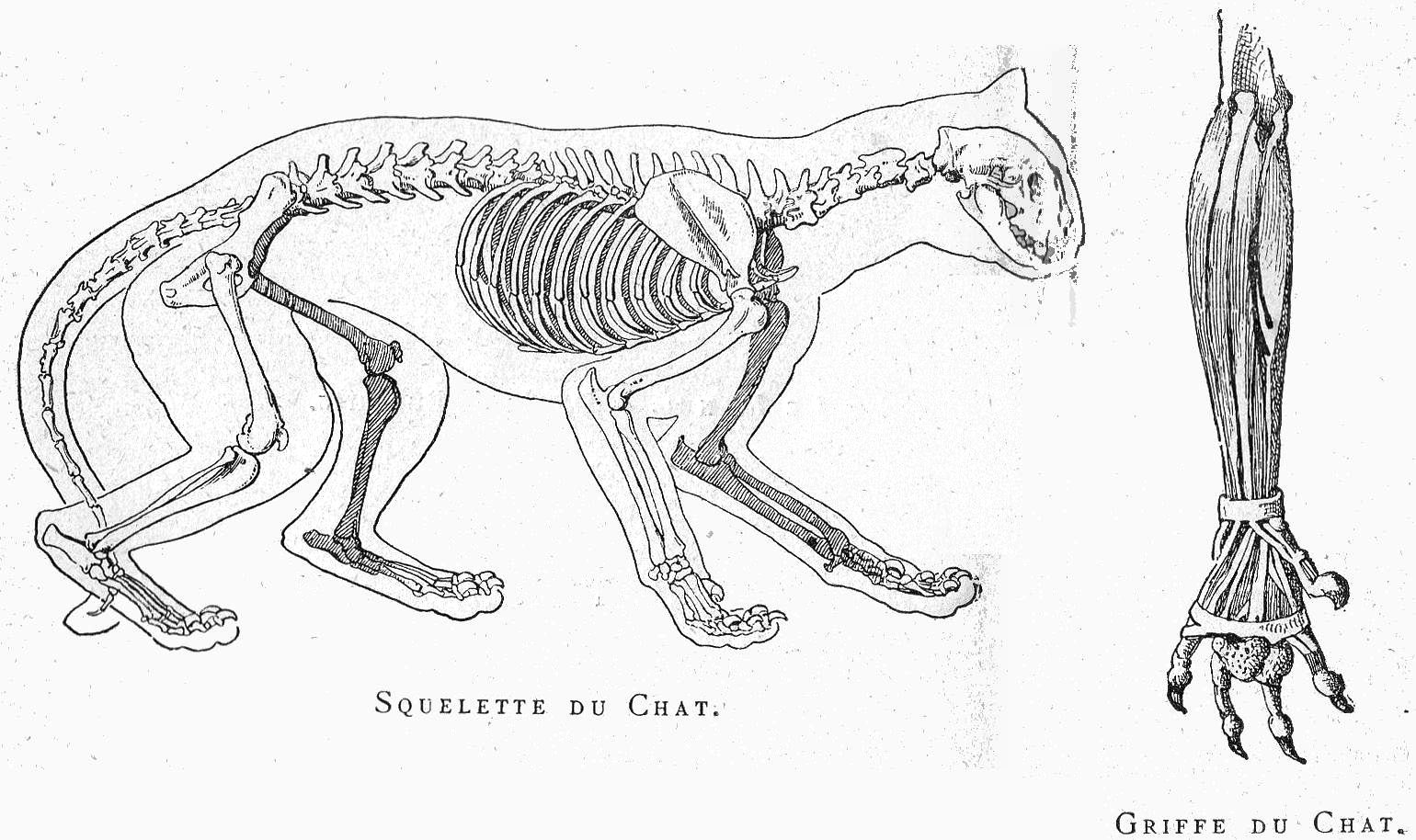
The nose ends in a rather small muzzle with the nostrils pierced below and to the side. The ears are straight, triangular, rather short, and uniformly hairy all over. The pupil of the eye is vertical and split longitudinally. The tail is about half as long as the body. The legs are rather short relative to body length, but are robust. Cats cannot run like dogs because of their limbs, and because their spine articulates with such flexibility that they cannot maintain, without painful efforts, the rigidity necessary for the chase; but they can climb with utmost ease, and can bend, roll up and stretch with extreme flexibility, and can leap great distances. Whenever they fall they always land on their feet; a fully satisfactory explanation of this ability has not yet been given, although several explanations have been proposed.
The senses are very unevenly developed, the sense of smell is dull, but those of touch, sight and especially hearing are the most acute.
Their size ranges between 25 and 30 centimetres and their body length from 42 to 55 centimetres. There are strong differences of opinion among zoologists as to their classification. Some zoologists have multiplied the number of species, while others have reduced the number. In this matter we will follow the advice Mr. Cornevin, the learned professor of the Lyon Veterinary School, who outs cats in the following three species:
Felis manul, manul;
Felis maniculata, gloved cat [wild cat];
Felis catus, common cat.
And we will exclude the little-known Manul which is almost as tall as a fox, and is confined to the steppes of Mongolia and Tartary. Moreover, there is good reason for the simple division of the wild cat or gloved cat, and the common cat because these have two kinds of immediately recognisable differences; these two types are distinguishable by the colour of the sole of the foot and lips: it is black in the first and pink or rather flesh-coloured in the second.
Scheitlin says "The cat is an animal of a lofty nature; its body structure already indicates a perfect being. It is a small Lion, a Tiger in miniature. Everything about him is symmetrical, no part is either too big or too small; so we are shocked by the slightest lack of regularity. There is nothing angular in its forms. Its head especially, as one can see from its skull, has graceful lines, and no other animal has such a beautiful head.
"The forehead has a poetic curve; all of the skeleton is beautiful and denotes an extraordinary mobility and we make special mention of its undulating and graceful movements.
"Its joints are not made in zigzag or acute angles; its curves are barely visible. To all appearances it is boneless and the whole body is a soft and flexible mass. Its senses are highly developed and perfectly related to its body shape."
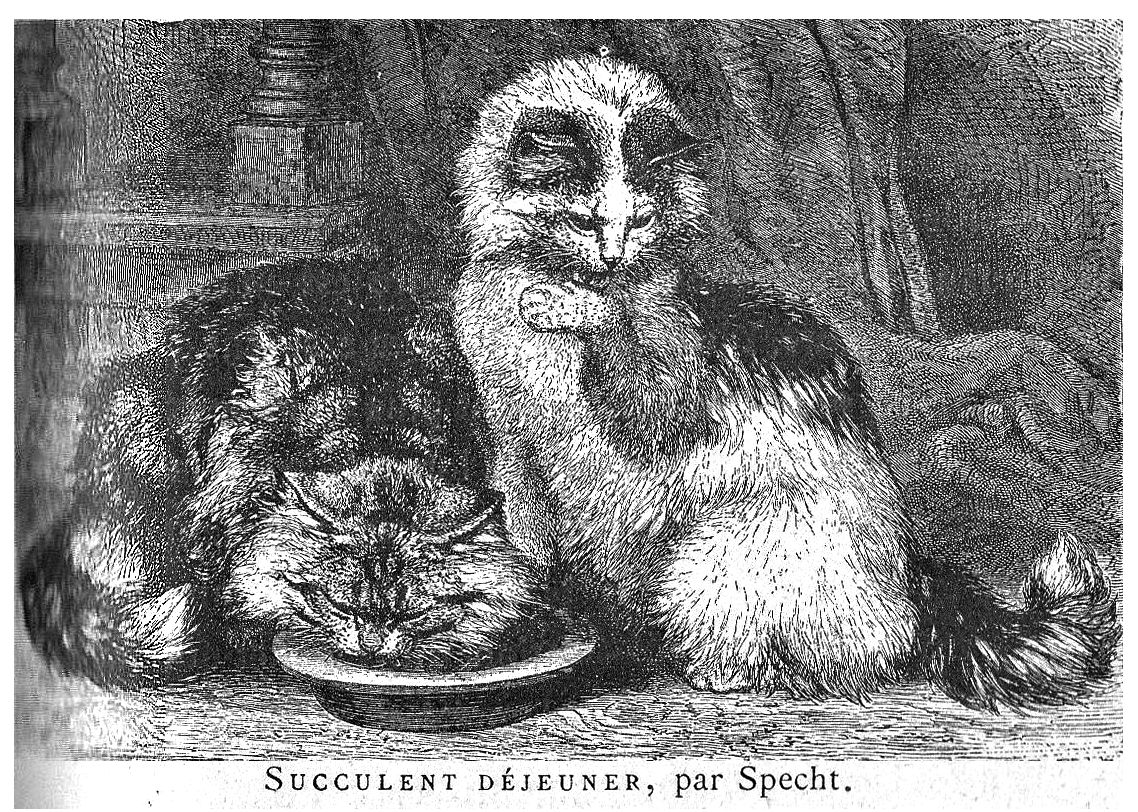
CHAPTER II - NATURALISTS OPINIONS ABOUT CATS
Buffon, as I have already mentioned, treated the cat as a true Prosecutor General. The pages written by this famous naturalist are tainted with great exaggerations and many inaccuracies.
No doubt M. de Buffon, always very stylish, must have had some complaint against the feline race; perhaps one day some ill-advised tomcat has torn hims lace cuffs with its wicked claws. Even if he had wanted to extol the qualities of the dog, we do not fully appreciate the reason why Buffon paints the cat in such dark and nasty shades.
[Note: I have used an existing translation of Buffon’s work]
"The cat is an unfaithful domestic, and kept only from the necessity we find of opposing him to other domestics still more incommodious, and which cannot be hunted; for we make no account of those people, who, being fond of all brutes, foolishly keep cats for their amusement. Though these animals, when young, are frolicksome [sic] and beautiful, they possess, at the same time, an innate malice, and perverse disposition, which increase as they grow up, and which education learns them to conceal, but not to subdue. From determined robbers, the best education can only covert them into flattering thieves; for they have the same address, subtlety, and desire of plunder. Like thieves, they know how to conceal their steps and their designs, to watch opportunities, to catch the proper moment for laying hold of their prey, to fly from punishment, and to remain at a distance till solicited to return. They easily assume the habits of society, but never acquire its manners; for they have only the appearance of attachment or friendship.
"This disingenuity of character is betrayed by the obliquity of their movements, and the duplicity of their eyes. They never look their best benefactor in the face; but, either from distrust or falseness, they approach him by windings, in order to procure caresses, in which they have no other pleasure than what arises from flattering those who bestow them. Very different from that faithful animal the dog, whose sentiments totally centre in the person and happiness of his master, the cat appears to have no feelings which are not interested, to have no affection that is not conditional, and to carry on no intercourse with men, but in the view of turning it to his own advantage. By these dispositions, the cat has a greater relation to man than to the dog, in whom there is not the smallest mark of insincerity or unjustice.
"The form and temperament of the cat's body perfectly accord with his temper and disposition, He is jolly, nimble, dexterous, cleanly, and voluptuous. He loves ease, and chooses the softest and warmest situations for repose. He is likewise extremely amorous, and, what is singular in the animal world, the female seems to be more ardent than the male. She not only invites and goes in quest of him, but announces, by loud cries, the fury of her passion, or rather the pressure of her necessities; and, when the male disdains her, or flies from her, she pursues, tears, and, though their embraces are always accompanied with the most acute pain, compels him to comply with her desires.
"This passionate ardour of the female continues only nine or ten days, and it happens generally twice a-year, though often thrice, and even four times. The period of gestation is 55 or 56 days, and four or five are commonly produced at a litter. As the male has an inclination to devour the young, the female carefully conceals them; and, when apprehensive of a discovery, she takes them up, one by one, in her mouth, and hides them in holes, and in places which are inaccessible. After suckling them a few weeks, she present them with mice, or young birds, to learn them to eat flesh. But, by an unaccountable caprice, these same careful, tender, and affectionate mothers, sometimes assume an unnatural species of cruelty, and devour their own offspring.
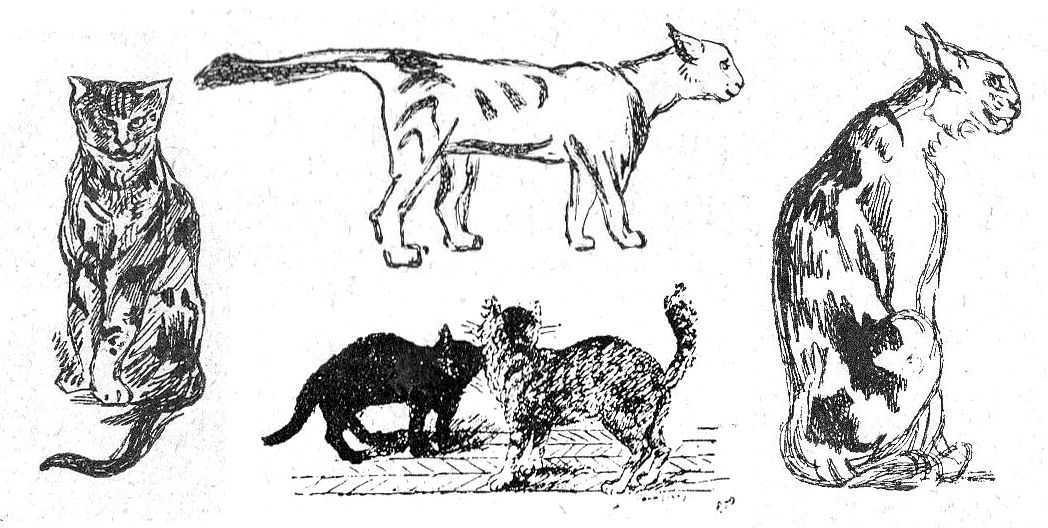
"Young cats are gay, vivacious, and frolicksome, and, if nothing was to be apprehended from their claws, would afford excellent amusement to children. But their toying, though always light and agreeable, is never altogether innocent, and is soon converted into habitual malice. As their talents can only be exerted with advantage against small animals, they lie in wait, with great patience and perseverance, to seize birds, mice, and rats, and, without any instruction, become more expert hunters than the best trained dogs. Naturally averse to every kind of restraint, they are incapable of any system of education. It is related, however, that the Greek Monks of the island of Cyprus had trained cats to hunt and destroy serpents, with which that island was much infested [Descript. des isles de l'Archipel, par Dapper, p 51]. But this hunting must rather be ascribed to their general desire of slaughter, than to any kind of tractability or obedience; for they delight in watching, attacking, and destroying all weak animals indiscriminately, as birds, young rabbits, hares, rats, mice, bats, moles, frogs, toads, lizards, and serpents. They have not that docility and fineness of scent, for which the dog is so eminently distinguished. They hunt only by the eye: Neither do they properly pursue, but lie in wait, and attack animals by surprise; and, after sporting with them, and tormenting them for a long time, they at last kill them without any necessity, and even when well fed, purely to gratify their sanguinary appetite.
"The most obvious physical cause of their watching and catching other animals by surprise, proceeds from the advantage they derive from the peculiar structure of their eyes.
"In man and most other animals, the pupil is capable of a certain degree of contraction and dilation. It enlarges a little when the light is faint, and contracts when the light is too splendid. But, in cats and night birds, as the owls, etc. the contraction and dilation are so great, that the pupil, which is round in the dark, becomes, when exposed to much light, long and narrow like a line. Hence these animals see better in the night than in the day. The pupil of the cat, during the day, is perpetually contracted, and it is only by a strong effort that he can see with a strong light. But, in the twilight, the pupil resumes its natural roundness, the animal enjoys perfect vision, and takes advantage of this superiority to discover and surprise his prey.
"Though cats live in our houses, they are not entirely domestic. Even the tamest cats are not under the smallest subjection, but may rather be said to enjoy perfect liberty; for they act only to please themselves; and it is impossible to retain them a moment after they choose to go off. Besides, most cats are half wild. They know not their masters, and only frequent barns, offices, or kitchens, when pressed with hunger.
"Though greater numbers of them are reared than of dogs, as they are seldom seen, their number makes less impression on us. They contract a stronger attachment to our houses than to our persons. When carried to the distance of a league or two, they return of their own accord, probably because they are acquainted with all the retreats of the mice, and all the passages and outlets of the house, and because the labour of returning is less than that which would be necessary to acquire the same knowledge in a new habitation.
"They have a natural antipathy at water, cold, and bad smells. They are fond of basking in the sun, and of lying in warm places. They are also fond of perfumes, and willingly allow themselves to be taken and caressed by persons who carry aromatic substances. They are so delighted with valerian root, that it seems to throw them into a transport of pleasure. To preserve this plant in our gardens, we are under the necessity of fencing it round with a rail; for the cats smell it at a distance, collect about it in numbers, and, by frequently rubbing, and passing and repassing over it, they soon destroy the plant.
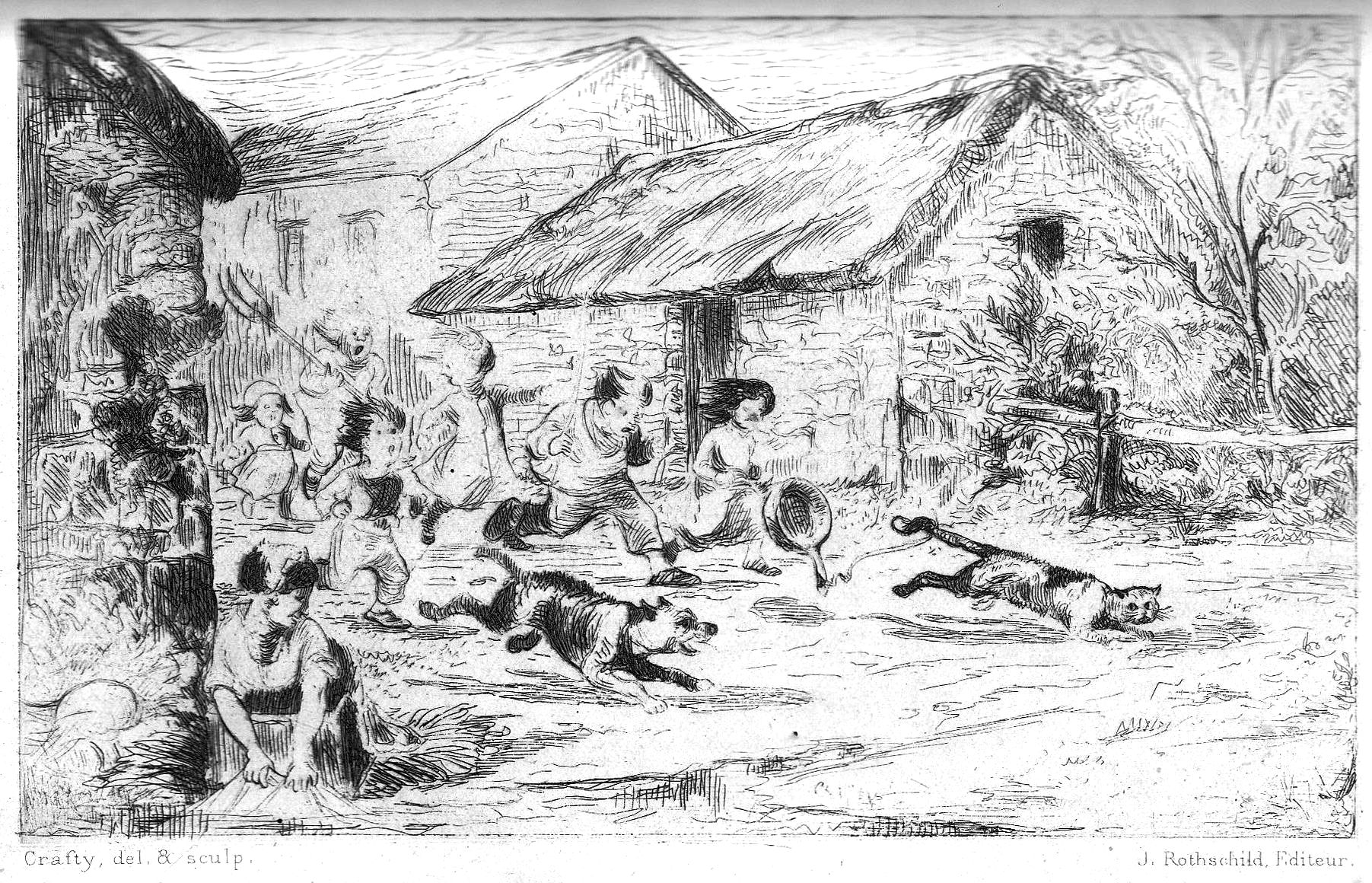
"Cats require fifteen or eighteen months before they come to their full growth. In less than a year, they are capable of procreating, and retain this faculty during life, which extends not beyond nine or ten years. They are, however, extremely hardy and vivacious, and are more nervous than other animals which live longer.
"Cats eat slowly, and with difficulty: Their teeth are so short and ill placed, that they can tear, but not grind their food. Hence they always prefer the most tender victuals, as fishes, which they devour either raw or boiled. They drink frequently; their sleep is light; and they often assume the appearance of sleeping, when they are only meditating mischief. They walk softly, and without making any noise. They hide themselves and go some distance away to defecate andthey cover it with earth.
"As their hair is always clean and dry, it is easily electrified, and the sparks become visible when it is rubbed across with the hand in the dark. Their eyes also sparkle in the dark like diamonds, and seem to throw out, in the night, the light they imbibe during the day."
Even among naturalists, advocates certainly did not ignore our friend the Cat. Boitard, in a speech for the defence in less castigating style perhaps than that of Buffon, but with great sincerity of tone, was one of the first to defend the cat. Here is the main passage:
"This animal has a timid nature; he becomes savage by cowardice, suspicious by weakness, cunning by necessity, and thief by need: he is never wicked except when he is angry, and never angry except when feels his life threatened; but then he becomes dangerous because his fury is that of despair, and he fights with all the courage of a coward driven to extremity.
"Forced to live continuously in society with his cruel enemy, the Dog, his natural suspicion increases. It is probably because of this Buffon attributes it with falsehood and insidiousness; it has retained enough of its independence to secure a life in the position we have placed it, and if this position is improved, as in Paris for example, where people love animals, it will give up some of its independence in proportion to the affection given to it."
Sonini, a naturalist who was Buffon's collaborator, did not judge the cat with the same antipathy as his master. Speaking of an angora she-cat, he writes: "For several years this animal was my pleasantest companion. How often her tender caresses made me forget my troubles and consoled me for many of my misfortunes! My beautiful companion died after several days of suffering, during which I did not leave her for a moment; her eyes constantly fixed on me were extinguished and the loss of her filled my heart with grief."
Abbé Galiani also did not associate himself with Buffon's recriminations; his sympathy for the cat is extreme, as we witness in this fragment of a letter to Mme d'Epinay:
"Your life in Paris is less insipid than mine in Naples, where nothing is attached to me except for the two Cats I have with me, one of which was led astray yesterday through the fault of my people. This made me mad; I dismissed everyone from me. Fortunately he was found this morning otherwise I would have hanged myself in despair."
This seems enough testimony from the defence to destroy Buffon's very prejudiced indictment, but I would like to also cite the following passage from a scholar of Madame de Custine, which seems a direct answer to Buffon's attacks:
"You would beat me if I were to say that I am not at all touched by the attachment of dogs. They look as if they were condemned to love us; they are mechanically faithful, and you know my horror of machines. They inspire me with a personal enmity. Long live the cat! Paradox apart, however, I prefer cats to dogs. They are more, far more, independent, more natural; human civilization has not become a second nature to them. They are more primitive beings, more graceful than dogs; they take from society all that it can give them, and they always have a gutter to retire to in the vicinity of the salon where they may once more become what God has made them, and be free and independent of their tyrant.
"When they do, by any chance, love that tyrant, it is not with the degraded slavishness of those wretched dogs, who lick the hand that strikes them, and are faithful only because they have not sense enough to be inconstant."
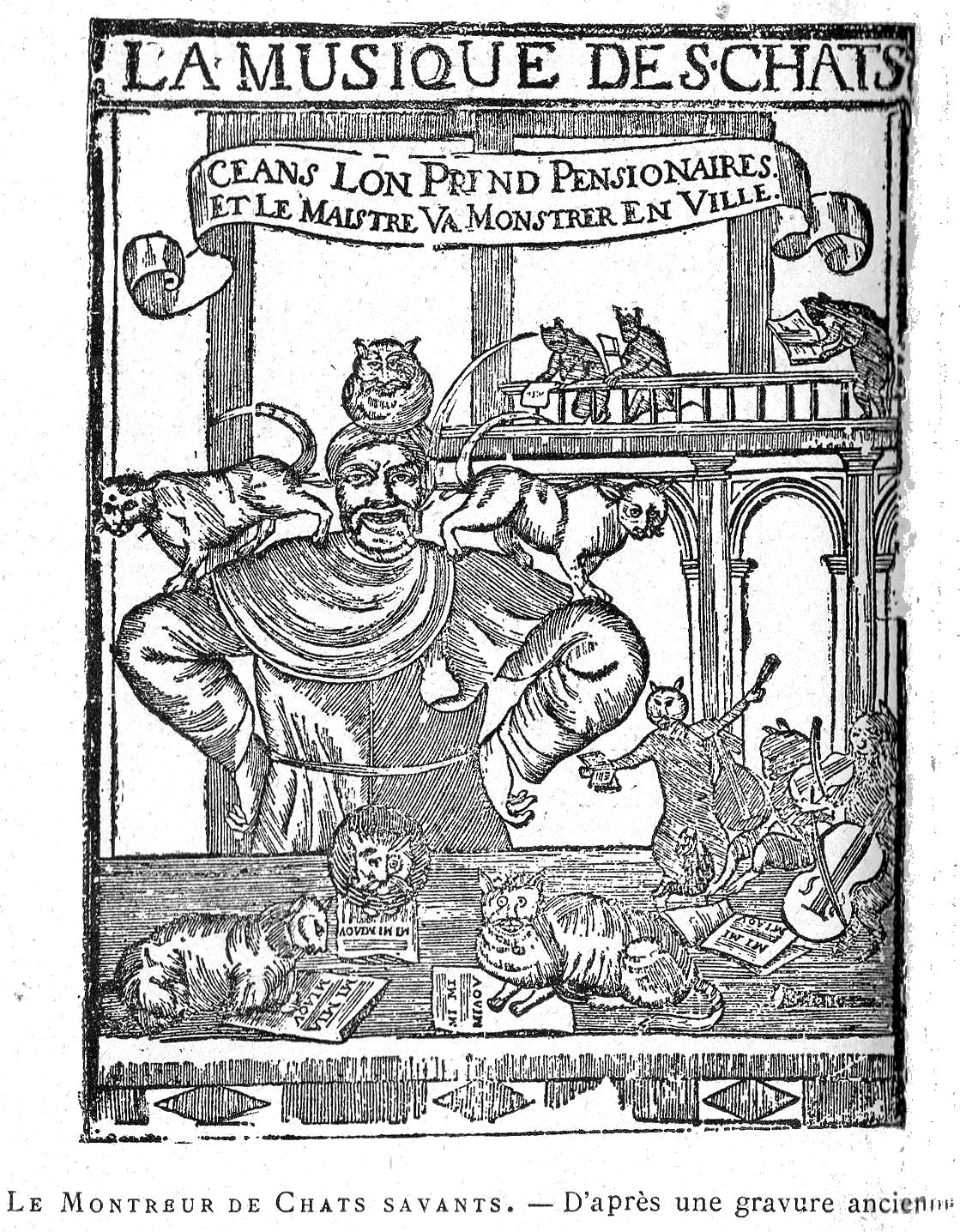
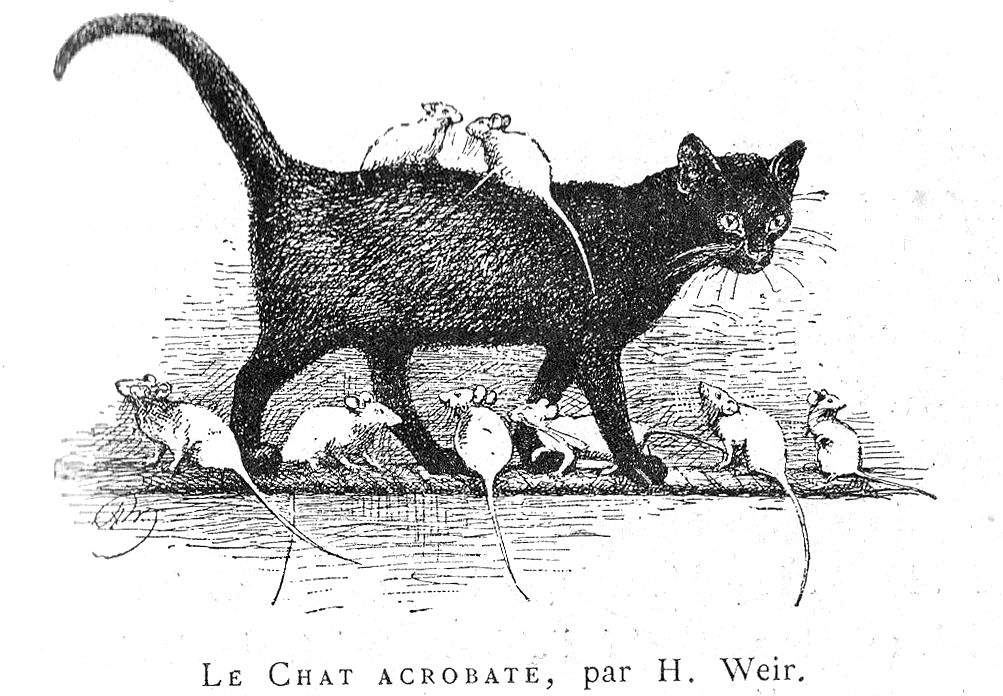
CHAPTER III - FELINE INTELLIGENCE
Without doubt, the cat is a very intelligent animal, but its intelligence is often under-estimated.
Taken as a whole, the various wildcat species all exhibit the same unsociable temperament, but even the large carnivores - lions and tigrets - are endowed with a considerable degree of intelligence; this is sufficiently demonstrated by the routines which they have to perform in menageries.
The general characteristic of the cat’s higher-order faculties is that - unlike most dogs - if it is separated from its owners or abandoned, he can usually cope perfectly well thanks to the unspoiled expertise inherited from his ancestors.
Mr. Romanes, the secretary of the Linnaean Society of London for Zoology, in his book on the Intelligence of Animals, cites more than a hundred cases proving the cat's intelligence and its powers of observation and reasoning; I'll borrow some of the more curious ones from him:
"Mr. Meek, the well-known paleontologist, had a small vertical mirror on his table, he drew on wood from nature the reflected image of the objects in the mirror. Seeing itself in this mirror, his cat tried several times to account for this apparition. After trying in vain to reach it, he apparently decided there must be something that separated him from the other animal, and stealthily approaching it without taking his eyes off the image, he launched a blow of his paw behind the mirror. He was greatly surprised at finding nothing, and it was only after many similar attempts that he finally gave up the idea of solving the mystery; or decided that the enterprise was beyond him, for he ceased to be interested in it."
Cats use numerous hunting tricks. It is easy to conduct an experiment. When lovers of small birds throw them bread, if a cat is nearby he will be well aware of the moment when the birds flock to it and he will come back each day. But here is a sign of greater reasoning power:
A correspondent [Dr. Frost] wrote to Mr. Romanes, "Our servants have become accustomed during the late frost to throw the crumbs remaining from the breakfast-table to the birds, and I have several times noticed that our cat used to wait there in ambush in the expectation of obtaining a hearty meal from one or two of the assembled birds. Now, so far, this circumstance in itself is not an ‘example of abstract reasoning.' But to continue. For the last few days this
practice of feeding the birds has been left off. The cat, however, with an almost incredible amount of forethought, was observed by myself, together with two other members of the household, to scatter crumbs on the grass with the obvious intention of enticing the birds"
The same case has been cited by Dr. Klein and several correspondents of the journal "Nature." Mr. Romanes himself says that he once owned a cat that had taught itself to open a door.
"I have often been at one of my windows," he writes, "and I have seen how the cat operate it without my presence guiding him. She was heading there with the most matter-of-course manner in the world, and one leap hooked her paw in the arc-shaped handle, then, pressing with her other paw on the latch, she depressed her paws the exact amount to push back the door. I find exactly the same events in the writings of many of my correspondents."
[Note: In Romanes’ own words: "My own coachman once had a cat which, certainly without tuition, learnt thus to open a door that led into the stables from a yard into which looked some of the windows of the house. Standing at these windows when the cat did not see me, I have many times witnessed her modus operandi. Walking up to the door with a most matter-of-course kind of air, she used to spring at the half-hoop handle just below the thumb-latch. Holding on to the bottom of this half-hoop with one fore-paw, she then raised the other to the thumb-piece, and while depressing the latter, finally with her hind legs scratched and pushed the doorposts so as to open the door. Precisely similar movements are described by my correspondents as having been witnessed by them."]
The idea of pushing with one's feet after lifting the latch must certainly be attributed to adaptive reasoning independent of any observation, and it was by the co-operation of all its limbs in a very unnatural movement that the cat finally succeeded in accomplishing its purpose.
It is not uncommon to see living-room cats jump on a chair and watch the bell button when they want milk, which is their way of saying they want to ring for the domestic servant in charge of bringing them their drink. And we often see cats pulling bell-ropes whenr they want to go out or it's time for their dinner.
Here is another example that demonstrates how well cats are endowed with intelligence and the power of observation. Couch, in his "Manifestations of Instinct," claims to have known a cat who had learned how to open the door of a cupboard to get to the milk. It sat on the table beside the cabinet and tapped the key-handle several times. Being old, the lock moved easily; the key finally turned and the cat achieved its goal.
A Mr. Brown of Greenock also reported in "Nature" that he one day saw a cat struck by a burning coal and, about to be burned alive, it rushed into a bowl of water to extinguish the fire that threatened it. The cat had certainly seen people put out the hearth fire by using water.
[Note: "A cat of Mr. Brown, of Greenock, Scotland, having had some paraffin accidentally spilled upon it and set ablaze by a cinder from the fire, at once rushed out of the door and up the street for about a hundred yards ; plunged headlong into the village watering-trough; and then stepped out, shook herself, and trotted quietly home. She had been accustomed to seeing the fire put out with water every night." Popular Science Monthly, January 1891]
In his book, the naturalist Lenz tells many more stories highlighting the cat’s intelligence. Here is one of them:
An inhabitant of Waltershauzen had a cat that had been accustomed to never stealing anything on the table. One day a greedy, thieving dog became his companion and committed thefts that scandalised the cat and justifiably irritated it. "The cat placed himself near the table and every time the dog jumped on a chair the cat climbed onto the table and when his companion succumbed to temptation he gave the thief a well-aimed smack with a paw."
Cats also become familiar with other animals. There are many examples of very friendly connections between dogs and cats, something that completely contradicts the well-known proverb. For my part, I knew a cat who was very satisfied when his good friend the dog carried through the apartment in his mouth. We have also seen other cats who, in the quarrels between dogs, defended their canine friends with all their strength and who, in turn, were defended by the dog in their own quarrels with other cats.
In the monkey rotunda at the Jardin d'Âcclimatation of Bois de Boulogne, several cats live quite harmoniously with their simian friends; there is even one who, two or three years ago, became the home nurse of a young guenon whos arm had been amputated.
Brehm tells us of the well known Godolphin Arabian horse that lived for many years on the the most friendly terms with a cat. When, in 1755, the horse died, the cat sat on his friend's corpse until it was buried. Unable to bear the sight of the places where he had spent days filled with affection from his equine companion, the cat disappeared. He was not seen again until the day he was found dead in a barn.
It is also often said that cats can show extraordinary acts of intelligence; thus cats, though great lovers of birds, are often trained to do no harm to the feathered favourites of their masters.
The naturalist Giebel himself saw this on several occasions. His tomcat, Peter, out in the yard where he picked up his master’s pet wagtail in his mouth and carried it back home. This wagtail lived in Giebel’s room, but the call of the wild sometimes lured it beyond desirable limits. The cat did not hurt the delicate fowl. At a bird dealer’s place on the Quai de Gesvres, I often saw a cat that hunted the mice in bird cages but never touched the birds.
M.V. Meunier [Animal Selection and Improvement] reported that "In the small village of Chamalières, there lived a cat who had given himself the task of supervising the chickens and who behaved towards them exactly like a sheepdog with the members of the flock. Extremely intelligent, this cat was quick to learn that the place of hens was not in the garden. He soon helped his masters in hunting the delinquent poultry, using their example to return the poultry to their home. Eventually he undertook this task alone, and the chickens were left to his supervision. Every contrary immediately had to deal with him, and was taken back by him to the henhouse. Having one day found a wandering hen in the street, he led her straight to his station, that is, to the kitchen. No doubt that this action had an encouraging success, because he repeated it on many occasions. But perhaps, in his over-zealous policing, he sometimes took honest chickens for strays or confused the neighbor's chickens with his master’s chickens, because he lost that curious habit.
"This animal was very affectionate and caressing. His attachment and sociability probably played a part in his decision to add his efforts to those of his masters in the pursuit of escaped birds. These are real, but under-appreciated and often overlooked, aspects of feline character when in a state of domesticity."
The Chamalières cat is not a unique case. Trustulumet, which belonged to Mr. Louis Müller, is on a par. Trustulumet was a she-cat. She saw that the manoeuvres of the chickens, which were penned at the bottom of the garden, as they flew each evening to the top of the wall and from there to neighboring walls, gave rise to troublesome hunts. Trustulumet came to a realisation. One fine evening he began to play shepherd's cat, barring the way to any hen jumping on the wall and forcing her to go back down. For more than two years, there was hardly any evening where Mr. Müller did not witness this exercise [L. Muller, loc. cit.]. This happened in Vendée.
We have just seen the shepherd's cat or at least its equivalent, the chicken-guarding cat, and we have previously seen a hunting cat; there is also a fishing cat.
In general, cats do not like to get wet; but it is not uncommon for millers to see cats addicted to the pleasure of fishing. Woe to the gudgeon that, coming close to shore, comes within their reach. Their method is the same as that of the jaguar. Some take the fish they have caught to their master, and this naturally leads us to a case reported by the Plymouth Journal [January, 1828] of a she-cat who, at Devil’s-Point battery, was in the habit of "diving into the sea, and bringing up the fish alive in her mouth, and depositing them in the guard-room, for the use of the soldiers". [Roulin, Natural History.]
Mr. Porte, director of the Jardin d'acclimatation, also gave me a curious observation about cats fishing. An elderly cat, belonging to one of is friends, does not have the same horror for water that all its friends have. Every day you can see her rushing into a small marshy river, looking for water rats and fish. She and a big tomcat, her son, also have the habit of following the household’s gardener, rarely leaving his shadow. One day, the garden being under water because of a heavy flood, the gardener had to cross it waist-deep in water to fetch a boat from some distance away. He was greatly astonished to notice the two cats, after having hesitated and miaowing for a long while, had decided to follow him through the expanse of water and were swimming vigorously behind him.
The innate intelligence of cats has allowed some cat-lovers to bring train them to such a degree that it is possible to present them in front of the public and make them perform clowning and and balancing exercises like dogs.
Not long ago, an impresario in Paris presented a troop of cats performing exercises quite incompatible with their usual nature by giving them birds, rats and mice for companions, and they did a good job together.
In Brussels, in recent years, I remember seeing five cats trained to do all kinds of tricks. Ringing bells arranged on a hoop suspended from the ceiling of the hall, they announced the performance to the public. Their various talents, which attracted a crowd, filled their master's pocket with coins.
There was nothing quite so comical, as to see, when the curtain lifted, the five kitties seated in line, gravely regarding their audience. At a first given signal, they all rose; at a second signal, they advanced towards the ropes, and, standing upright, pressed their claws into the woolen fold which was there to help their act.
After a moment's waiting Noireau pulled the rope of the big bell no 1, Blanchette pulled that of the no 2 bell, Tigré rang the no 3, Griffon sounded the no 4, and Mustache made the no 5 bell ring. I don’t know whether the bell-ringers of Saint-Quentin, who have so often charmed my ears, could have done better. The strange bell-ringers kept the rhythm very well, and the harmony was seldom disturbed by an untimely tug of the claw. After a few minutes, a third signal was given: the five Cats left the ropes and retired in the midst of justly deserved cheers.
He is an Englishman who is very famous among trainers, and who is modestly called "The King of Cats". He has fifty performers, of all ages, of all sizes, and of all colours. This eminent trainer’s name is Léoni Clarke, and though he has never come to France he has travelled all over Europe.
Among his cats, the old troopers are easily recognized by their way of working: they perform their ventures wisely. The young ones, on the other hand, who have neither the experience nor the circumspection inherent in the "grey hairs" of their elders, advance boldly, sometimes tumbling, but also quick to get up to start their exercises with renewed courage!
After running over the bottlenecks arranged on the stage, they ventured - emulating the famous Blondin - onto a rope stretched at a respectable height, and happier than many of our circus artists, they had a net to avoid any unfortunate consequences if they fell.
Then, on the rope, Clarke placed pell-mell a hundred mice, rats and even canaries, and it was in the midst of these creatures that the cats completed their aerial journey a second time. Their precautions as they advanced had to be seen to be believed; placing their paws only after they had ascertained that they could do so with impunity for their forced friends, who did not seem to care much about the close proximity of their hereditary enemies.
It seemed that these cats were afraid to hurt the mice and rats – the world was turned upside-down!
The performance continued by jumping through fiery hoops, despite the instinctive and innate aversion that any feline feels for fire, our cats bravely went through them.
And even before the boxing kangaroo appeared, two of Clarke's cats were fighting a boxing match under rules, wrestling with the best of them, throwing scholarly and classic blows with their paws. The game, very fairly fought, happily ended without any bloodshed. To comfort the fighters, their master served them a swig of whiskey, which, it seems, cats are very fond of. Thanks however to moderation on the part of the trainer, we were not obliged to apply the famous Wet’s law.
To close the show, a small grey cat, with a smart and mischievous face, climbed into the loft of the room and settled down in a cute gondola. At the signal given, a rope was pulled, and the kitten descended slowly on a parachute, in the middle of the room gliding majestically above the spectators,
It is only through patience, perseverance, gentleness, caresses and rewards that one can arrive at such a truly surprising result. After all this, we can believe as true the qualities that led to the regret expressed on the death of the cat that is alluded to in a book published in 1652, dedicated to Gauthier Garguille and entitled:
Regrets facétieux et plaisants, harangues funèbres du sieur Thomassin, sur la mort de divers animaux
[Facetious and pleasant regrets, funereal sermons of Sieur Thomassin on the death of various animals]
"The gods foreseeing that I might be melancholy if I remained alone, presented me with a handsome and lovely kitten, but the painful death of my property in a short time bothers me, to my great regret. My Cat gave me thousands upon thousands of pastimes, and for the sake of making him give me more, I had, last year, pulled his tail.
"If the roast was turning he did not dare look at it with the corner of his eye to touch it! He still held the keys to the expenses. He never injured any one, he never took anything from anyone else, he would rather die, raging hungry, or eat onions – which cats are not fond of – rather than eat something he had been given to guard.
"How many offers I refused, more mercantile than great trade, and several high-ranking barons, to possess my chubby and prettily spotted little short-haired cat."
Finally, all generations have known Guignol’s cat who attended all the performances given by his master and who, as Léo Lespès said, "remains a silent and unfeeling witness of the eternal duel between Polichinelle and the commissioner, not even taking the side of authority."
If it is necessary to believe Moncriff, who moreover shares the idea with Grew and le Clerc that cats are admirably organized for the music, being able to give various modulations to their voices, and using various tones to express the different feelings they experience.
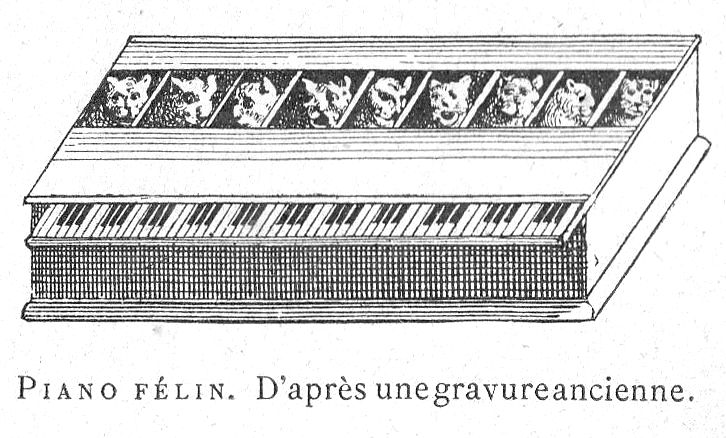
"An old engraving represents a clown having in front of him a box divided into squares; in each box was a cat whose right paw was tied to a rope connected to a keyboard. Whenever the performer touched a note, the thread pulled the cat's leg and it uttered a cry, a sound which was repeated according to the play of the hands, which produced real music. Was it really harmonious? I do not know, but it was a tune.
[Note: this refers to a katzenklavier, the cries being caused by pulling or pricking the cats’ tails]
Valmont de Bomarc tells us that at the Saint-Germain fair he saw some Cats performing a concert which was described by the director of the troupe as a miaulique.
The animals were placed on tables with a musical score in front of them and a solemn monkey conductor placed in the middle. At a given signal, the Cats made sad and pleasant meowing sounds."
In spite of this, however, it is customary to refer to the music of Cats as sharp and discordant.
This does not preclude that, for a long time, we have dealt with this question of how to apply the Cat’s voice to music. M. Bruner cited, in Les Fantaisies bibliographiques, "A Memoir on the Use of Cats in Musical Art, and on the Method of Biting Their Tails in Order that they may Meow in Concert" (at Utrémifasola, year 913, in-4 ).
Regarding the cat’s facility to be trained, one of my friends and colleagues, Arnould Galopin, introduced me to his cat, that is accustomed to get his newspaper every morning, and who does has never failed in this without any need to refresh his memory. This feat, which is common in dogs, is quite rare in cats, and worth mentioning here.
Here is what Galopin has written to me about his cat Minou: "Attentive, careful, loving and discreet, Minou has quickly conquered the sympathies of everyone. I brought him up and was able to convince myself of the falsity of M. de Buffon's accusations against this intelligent animal. For me, Minou is a spiritual son. He's waiting for me at the door when I have to go home, and crying when I'm away. He even brings me my slippers, he does not heat them yet, but it will come. In the morning, he greets me with a "meow" which means to me: ("Have you slept well?" And in the evening when I go to bed, he also sings "meow", but with another intonation which means: "Sleep well, my friend." I now understand the language of Cats. But that's not all: Minou is a first-rate observer. He follows all my movements, watching my every move. Last January, I took him regularly for a fortnight to a newsagent. One morning he went alone to the merchant, thinking I was there. I wanted to try an experiment. It succeeded. My maid opened the door, Minou returned to the merchant who was informed to put a newspaper in Minou’s mouth. Since Minou goes every day to look for the newspaper; I made him make a little bag in which I put a penny. The merchant takes the penny, gives him the paper and Minou, faithful commissionaire, runs up the stairs four at a time. "
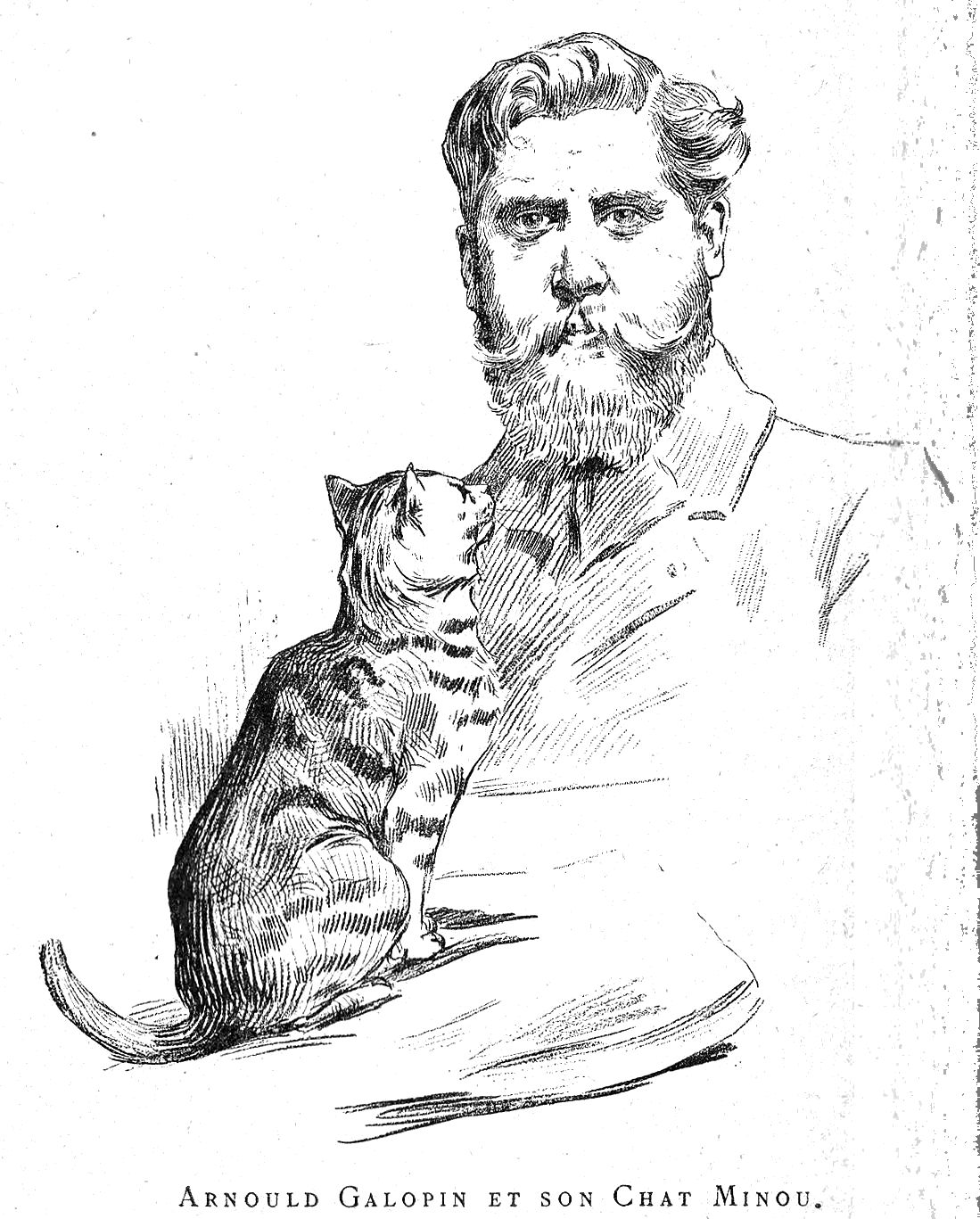
The cat who follows his master is not as rare as you might think; Breton knew two of them who very amiably conducted visitors who came to visit their masters. "They accompanied them," he said, "for ten to fifteen minutes, then took leave of them with caresses and purrs."
The Society for the Protection of Animals has previously published in its Bulletin observations on a Cat who, during the siege of Sevastopol, followed his master everywhere like a dog; his master was a general officer.
Wood, in his "Natural History" records an even more extraordinary feat: a young cat who became the servant of his sick young mistress. " It was truly wonderful to note how soon she learned to know the different hours at which I ought to take medicine or nourishment; and during the night, if my attendant were asleep, she would call her, and, if she could not awake her without such extreme measures, she would gently nibble the nose of the sleeper, which means never failed to produce the desired effect. The poor beast paid attention, down to the smallest details, to everything that happened to me, and as soon as I seemed to be looking for her, she was near me, making a purr full of affection. No animals seem to require human sympathy so much as cats, or to be so capable of giving sympathy in return."
These few examples, which I could have multiplied, sufficiently prove the falsity of the animal. Word of Buffon that: "Cats only have the appearance of attachment."
And to end this chapter on the intelligence of the Cat, this true story comes from the pen of a great cat-loving colleague and and charming storyteller, Louis de Grammont: "A friend of mine lived in a hotel, where gas had been installed. There was a cat, Madam Pussy, which at that time was the mother of two well-grown kittens. At mealtimes, Madam Pussy, who was badly brought up, and her little ones had developed the habit of climbing on the table, to snatch some tasty morcels.
"One morning, we had lunch. Mother and kittens were on the table as usual. The chops were brought to us and at the same moment, a detonation is heard. We ran to find out the cause. It was an explosion of gas, due to some carelessness on the part of the cook. Fortunately, no one was hurt. Having been reassured, we sat down at the table again. As for the cats, they had fled, terrified. "
"For several days there was no news of them. No doubt terrified, they were laying low in the refuge of the attic or cellar, or in some corner from which they dared not move.
"Then they reappeared, the mother with her little ones following her. Having overcome their fear they resumed their ordinary life.
"Some time ago, at lunch, they were on the table. The servant brought chops ... Immediately our three animals tumbled off and fled on all fours!
"Evidently they had concluded that the last time we served chops a terrible racket had broken out. Chops have been brought, therefore, there will be a new din. They decided to save themselves and fled. Only after finding out that no threatening noise was heard did they decide to return."
See how complex such reasoning is and all that it implies. It involves memory, the association of ideas, and the establishment of a relationship of cause and effect between two phenomena ... This report is inaccurate, the mother cat and her children committed the famous sophism: "Post hoc, ergo propter hoc." The deduction is no less remarkable.
Who would dispute, after such features,
That intellect is not found in creatures!
[Qu’on m’aille soutenir, après un tel récit,
Que les bêtes n’ont point d’esprit!]
The language of cats. A naturalist philosopher [Dupont de Nemours], who was directly inspired by the doctrines of the eighteenth century, Dupont de Nemours, studied the intelligence of animals very thoroughly; in a memorandum addressed to the institute, he even gives the means of understanding animals. Studying the animals in us, that was his life, and pushing his system into the last limits, he added:
I am asked how one can learn the languages of animals and be able to form an idea of their conversations from that approach?
This is the great theory of the language of animals, and it is obvious to those who live closely with animals and to those who pay attention, that animals have a language that is understandable to man. That same year, a circus trainer introduced a talking dog; in his book "Animal Selection and Perfection," Victor Meunier quotes several cases of dogs who managed to join their voices with human voices, and Marco Battini tried to transcribe the language of several animal species by onomatopoeia. Father Galiani, who was passionate about these questions, writes: "For centuries, cats have been reared, yet I do not find that they have ever been really studied. I have a male and a female cat. I have cut them off from all communication with cats outside the house, and I have closely observed their proceedings. Would you believe one thing? During their courtship they never once myow-ed; the myow is not, therefore, the language of cat-love,- it is the call of the absent.
"Another positive discovery I have made is that the voice of the male is totally different from that of the female, and this is as it ought to be. In birds the difference is more marked - the song of the male is altogether unlike that of the female - but in quadrupeds I do not think anyone has hitherto perceived it. Besides, I am sure that there are more than twenty different inflections in the language of cats, and their language is really a ‘tongue,’ for they always employ the same sound to express the same thing."
Dupont de Nemours is even more precise: " The cat also has the advantage of a language in which the same vowels as those pronounced by the dog exist, with six additional consonants, m, n, g, h, v and f. The consequence is that the cat has a greater number of words."
"Better organization, the paws, and a greater range of oral language certainly give a lone cat more cunning and skill in their hunts than a lone dog."
Scoffers will smile at the affirmations of Dupont de Nemours or Abbé Galiani; it will be nonetheless be learned by those who study the Cats that they have their own language, understandable to man.
In Sanscrit the cat is called mardjara or vidala, and its speech is rendered by the words madj, vid, bid. The Greeks called the cat ailouros and its speech laruggiein. The Latins called the cat felis, and gave no name to its speech. Among the Arabs it is called ayel or cotth; its speech naoua. The Chinese translate the cry of the cat into ming. In German the cat is katze, and the utterance is miauen; the English say cat and his cry is mew (pronounced miou).
But it is the Western peoples who have best rendered the sound made by a Cat. Maoua is an exclusively oriental meow. The "ming" of the Chinese is reminiscent of the metallic sound of a gong. The miauler of the French, miauen of the Germans and the mew of the English better expresses the special cry of the Cat.
If three eminent minds of these different nations who have translated the language of the animal into positive language by means of onomatopoeia could enter into perfect collaboration to study the vocabulary of the cats, perhaps we could complete the theories of Dupont de Nemours and realize the wishes of Father Galiani.
For the present we must be content, with what Montaigne ways about our intercourse with these animals:- "When I play with my cat, how do I know whether she does not make a pastime of me, just as I do of her? We entertain ourselves with mutual antics; and if I have my own times to start or to refuse, so she has hers."
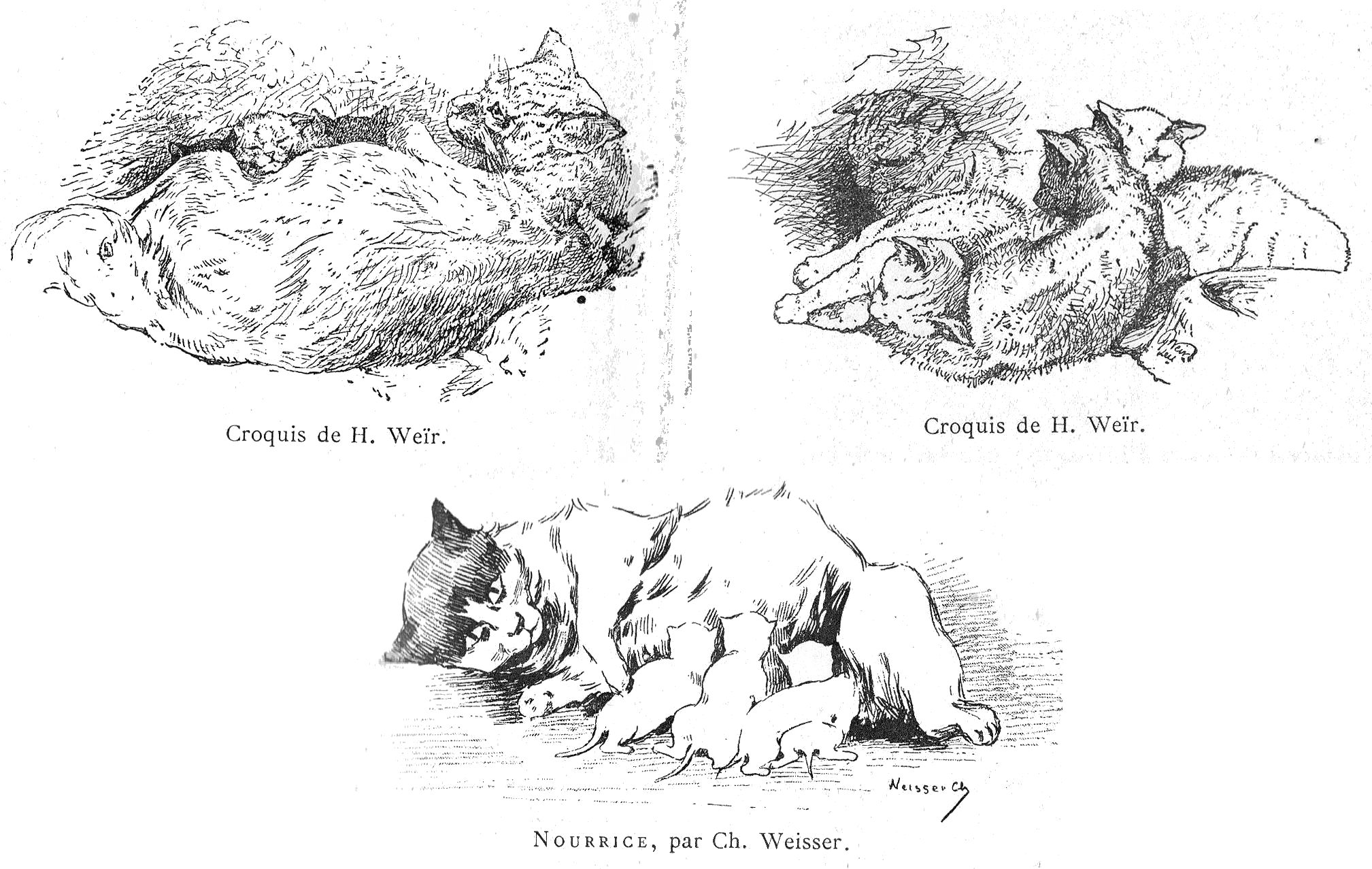
CHAPTER IV - FELINE HABITS AND BEHAVIOUR, KITTENHOOD, FAMILY FEELINGS.
According to Champfleury, "A kitten is the joy of the house." The fact is that nothing is as amusing as a family of kittens cats, such charming and graceful creatures that you have to be a real executioner to destroy them; and yet how many are destroyed each year? "Their first voice is exceedingly sweet and quite childish. They are so restless that, even while blind, they are not afraid to venture out of the nest, and their mother, worried by their escapes, is always forced to bring them back to the nest. Scarcely have their eyes opened to the light, scarcely are they able to distinguish objects around them, than they immediately begin to play with anything that stirs, rolls, slips, or flies. Their instincts as hunters of mice and birds already begin to awaken. They play continually with their mother's tail and with their own, as soon as it is long enough for them to be able to grasp it with their paws; they also bite it and do not notice that it is part of their body, just as our children bite their fingers, which they consider to be something foreign to them.
Kittens make the most singular leaps and the most graceful movements. Their gestures and games, which they enjoy just like children, amuse them and also amuse the people who love them, for hours at a time. As soon as their eyes are opened, they know how to distinguish the good person from the evil, the friend from the enemy. If a dog arrives in the midst of their games, whatever its size and strength, they immediately put themselves on the defensive by arching their backs. They are like little lions.
The physiologist Gratiolet, when he wished to study the sensations which occur in the organs when there is a pleasant sensation in some sensory organ, used an infant cat as his subject.
"Observe a kitten advancing slowly and sniffing at some sweetened liquid. Its ears are erect, its widely-opened eyes express desire, its impatient tongue, licking its lips, tastes the desired object by anticipation. It walks cautiously, with outstretched neck. But now it has got hold of the longed-for object, its lips touch the balmy liquid, it laps it eagerly. The object is no longer desired, it is possessed, and the sensation which it awakens pervades the entire organism; the young cat then shuts its eyes, in contemplation of its own all-pervading pleasure. It falls back upon itself, hunches up, raises its back, shivers voluptuously, and seems to cover up its body with its limbs, as if to possess the source of its enjoyment more entirely. Its head sinks in between its shoulders; one might fancy that it seeks oblivion of a world thenceforth indifferent to it. It resolves itself into the sense of taste, and the sense of smell, and withdraws into itself with a most significant completeness."
A mother cat’s love for her young is admirable. Before they are born she prepares a nest for them in a hidden place, so that nothing disturbs her. As soon as she fears the slightest danger for the kittens, She carries each of her children in turn by the skin of the neck, but only with her lips, and so gently that the small creatures do not even feel it, and hides them in a safer place. All the time she is is nursing, the cat leaves her offspring only to seek food. There are many anecdotes showing how highly the maternal feeling is developed in the cat. I will content myself with two which seem to me entirely worthy of belief.
The first is reported to us by Dupont de Nemours: "I had two she-cats," he writes, " they were mother and daughter. The mother had produced her kittens on a certain day, and they had been all left with her. The daughter gave birth to her first litter on the following day, and was very ill. She lost consciousness and motion with the birth of the last kitten. The mother went round and round her, lavishing on her all the expressions of maternal tenderness, which are very numerous in the vocabulary of cat-language.
"Perceiving at length that the care she was expending upon her daughter was in vain, she busied herself, like a good grandmother, with the little creatures crawling in a desolate and orphaned condition upon the ground, licked all the litter, and finally carried them to the bed of her own children, where she shared her milk with them.
"A full hour afterwards the young cat came to her senses, looked for her little ones, and found her mother nursing them. There was great joy on both sides, and many touching expressions of affection and gratitude were exchanged. The two mothers established themselves in the same basket, and, while the educational period lasted, they never left it except separately. One always remained on duty. Thus they nursed, caressed, and impartially reared the seven kittens, of whom three belonged to the daughter, and four to the grandmother.
"I do not know," says Dupont de Nemours in conclusion, "what species of animal could have done better."
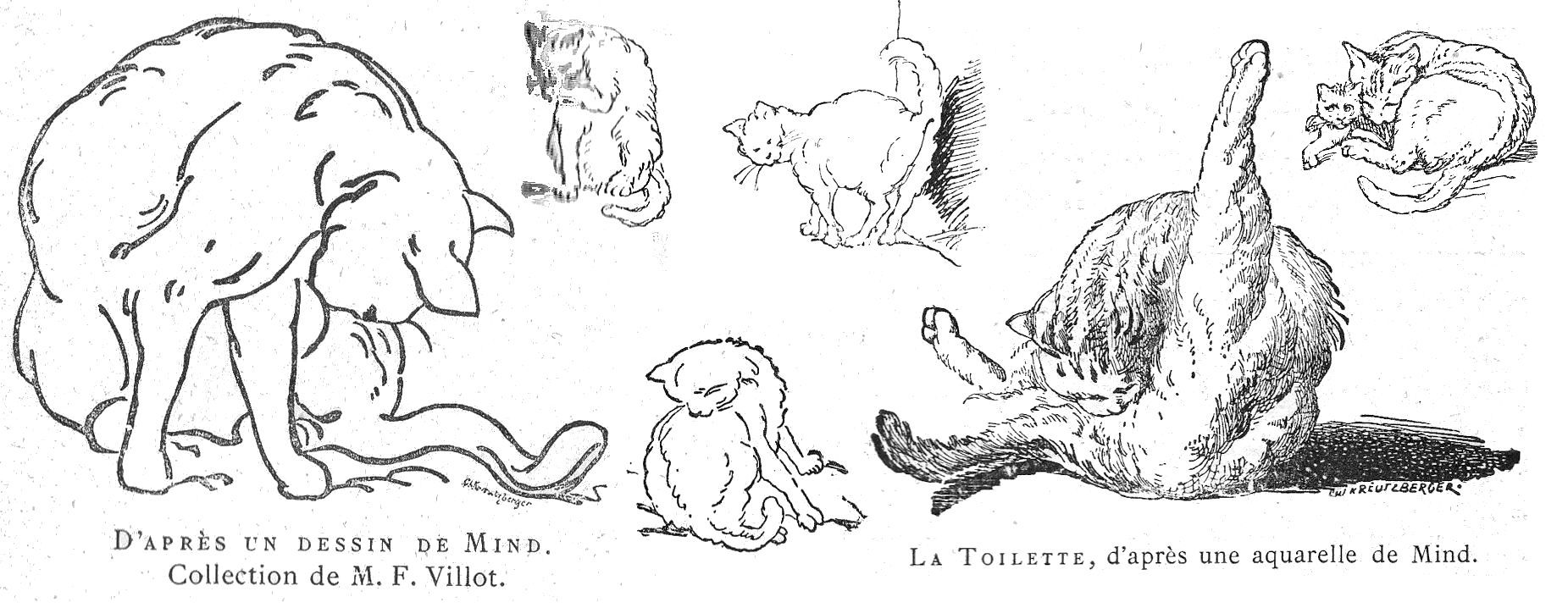
I will borrow the other account from the author of "Folie des Animaux," Pierquin de Gembloux:
"M. Moreau de Saint Méry," he says, "had a cat who produced several kittens, but always in vain, because she was not allowed to rear her family. In order to spare her feelings, and also to provide for the drawing-off of her milk, she was deprived of only one kitten each day. For five successive days she had undergone this bereavement; on the sixth, before any one came to her basket, she took the child that remained to her, carried it to her master’s study, and laid it on his knees. Her nursling was saved, but the mother brought it back every day, and could not be quieted until her master had caressed the little one, and renewed his orders that it was not to be removed from her."
The English painter Weir, whom I have already quoted, is one of the rare artists who has been able to portray the different attitudes of kittens lying between the legs of their mother in a lifelike way. Weir had, and still has, a real passion for cats.
When the kitten reaches six weeks old, this is usually it is separated from the mother; he is weaned, his education has been laid down and he has been promised since birth to friends amazed at the mother’s delicacy and the father’s masculinity. After it has left, the worried mother seeks her little one, calling him for a few days until her memory fades, or the anticipation of future offspring outweighs the image of the kitten for whom she had shown so much solicitude.
A curious fact is that sometimes nursing mothers show affection for other creatures. There are many examples of cats nursing puppies, infant rabbits, infant squirrels or even baby rats.
White [Natural History of Selborn] reports that at a farm in England, a cat that had given birth during the night, the owner had taken advantage of the mother’s first absence from the nest and drowned the kittens. The poor mother was exhausted from running throughout the house, searching, calling and giving all the signs of a very natural grief at the loss, which is usually much weaker in animals bastardized by domestication. She was still in search when a child who wanted to feed her put a nest of newly-discovered young rats in the basket where the kittens had previously been. The cat returned a few moments later and found the half-naked and groaning little creatures, which she initially did not take care of. She lay in her basket without taking any precautions, but also without hurting the new occupants.
To begin with, were they frightened, feeling themselves so close to the constant enemy of their race? I would imagine they were. No matter what, they recovered quickly and necessity helping them to overcome their natural antipathy, and they latched on to cat’s nipples and began suckling with good appetite. The nursing mother at first let them do this without showing any anger and then, perhaps experiencing some sort of relief from their sucking, she began to enjoy it and soon became interested in the little rats. Before the end of the day she was already washing them. From that moment she adopted them.
All the inhabitants of the farm came to see this unusual family; the neighbors hastened in their turn, and finally the visits multiplied to the point of becoming a real inconvenience, so to put an end to it, we decided to destroy the baby rats. I regret that the experiment was not carried through to the end; it would have been curious to see if, once they were independent, the young rats would have been eager to flee from their their nurse, or whether the cat herself, once she was no longer necessary for their survival, would have lost her affection for them. Who knows whether her old instincts would have gained the upper hand so that one day she made a fine meal of the creatures she had once nurtured?
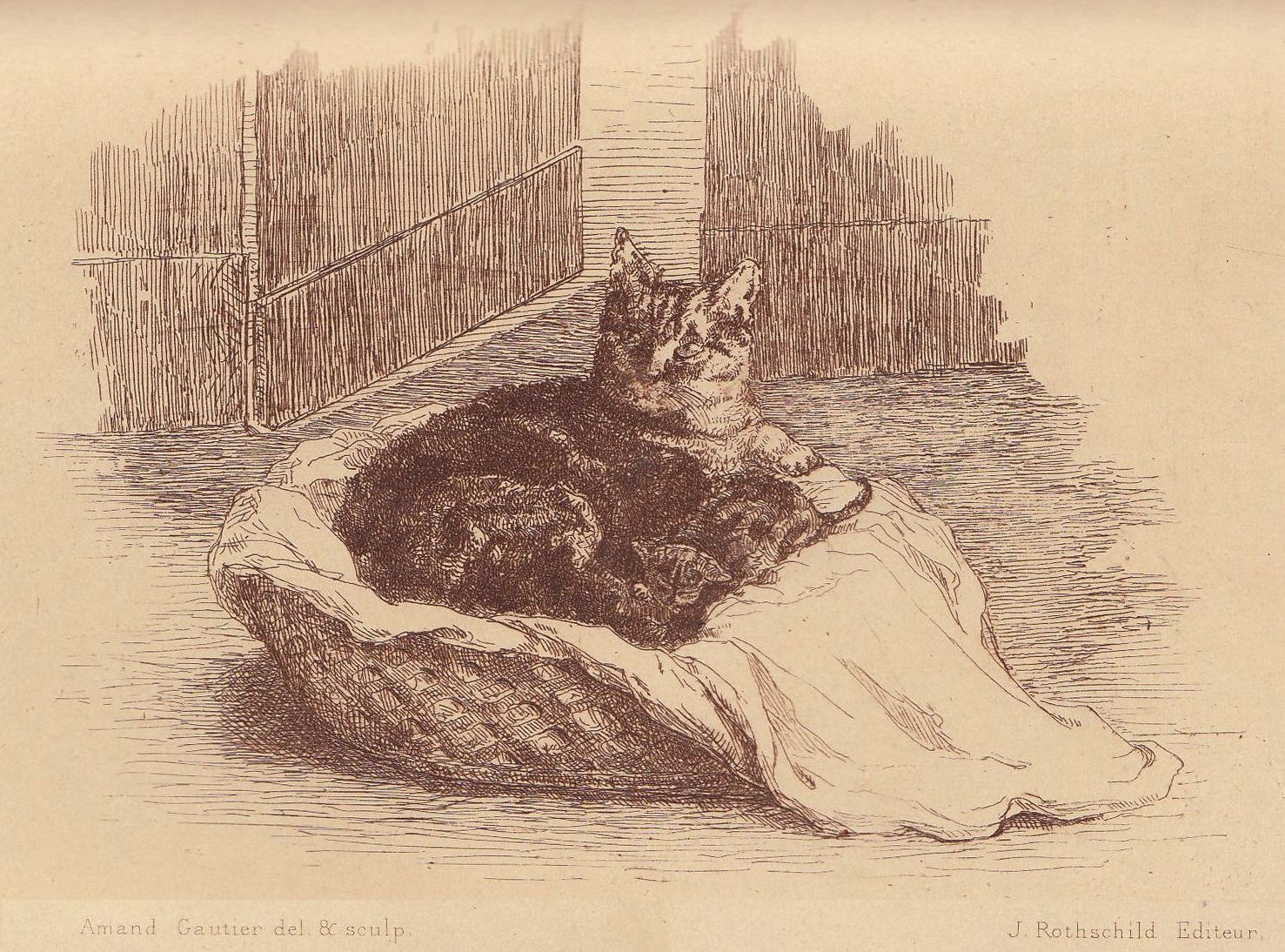
The Cat’s senseof cleanliness is taken to the great lengths, it cannot stand the slightest stain on its fur; we always see it lick after finishing its meal, clean its coat, smoothing its fur with its tongue as far as its mouth can reach. It washes its head and places inaccessible to its tongue by wetting its paw with saliva, and passing this over its fur again and again until complete satisfied with its looks. No part is ignored, and all parts of its body, from the head to tail-tip, must be glossy and brilliant. This quality, so well-known to us, is expressed very well in a popular song found in the collection of Jérôme Bujeaud (Songs and Folk Songs of the West);
Le chat à Jeannette
Est une jolie bête;
Quand il veut se faire beau,
Il se lèche le museau;
Avecque sa salive
Il fait la lessive.
[Jeannette’s cat is a pretty animal.
When he makes himself beautiful,
He licks his muzzle with his spittle
And does his laundry.]
Their cleanliness extends beyond the care of their washing; in fact they have the habit of burying their excrement and carefully covering it with earth, sand, or ashes, in order to conceal it completely from sight.
"Physically as well as morally," said Scheitlin, "the cat always aims higher; he is not affected by vertigo; his nerves are proof against everything. He climbs to the tops of the tallest fir trees without worrying how he will get down; yet fear is not unknown to him, for he sometimes gets stuck at a great height and asks for help, not daring to descend, and when he finally decides to return to the ground, he does so backwards. He always endeavours to reach the highest possible level, to perfect the art of climbing, but he is aware of the danger he runs, only the inferior animals are careless. When one tries to make him fall he clings to everything around him.
"He knows how to judge distances and space, and recognizes whether a surface is vertical or oblong before he makes a perilous leap for the first time. He reflects and compares, judging his strength and skill before the attempt. Sometimes he hesitates quite a while before acting; but once he has succeeded in doing it once, he will do it a hundred times; otherwise he will practice and try again later. He has little appreciation of time, but it is clear that he knows when dinner-time is because he is always present when the table is set. But, because of his free-living tendencies on the heights, and his nocturnal eye, he needs a sense of space and places rather than a sense of time and hours.
He also has a sense of colours and sounds, because he recognises a person from their footsteps and voice, and he asks to go out if he is called out.
The cat's urine, especially that of the male, stinks, and has a persistent penetrating odour. Urination in males occurs without crouching like females and kittens."
The cat’s average lifespan is from ten to twelve years, but we have amny examples of cats that have reached up to twenty-two or even twenty-five years old. The cat is adult at fifteen months; the male tends to be a vagabond and the female is much more sedentary. In the breeding season, these creatures, which generally do not have regularly associate with each other, associate more closely. Females go into heat twice a year - in spring and autumn - and sometimes even three times in a single year.
We are all familiar with the cats’ concerts that precede the choice of husband who comes to sing his invocation in the moonlight with the tenderness of a true troubadour. Who has not heard the solo and choral responses escaping from the roofs, gardens or attics of farmhouses? The silence that follows this first act is soon interrupted by a new bolero, which provides the pretext for other songs in the middle of the night, depriving people of restful sleep. Gone are your sweet dreams; your ears are pierced by wild sounds that rise to a crescendo instead. You are forced to bear this din; everything you might try to stop this nightmare would be in vain. You are forced to listen to the war cries of the rival suitors, which begin with plaintive sounds and end with a peculiar whistle, provocation to a combat whose musical theme is the Crescite et multiplicamini [Increase and multiply].
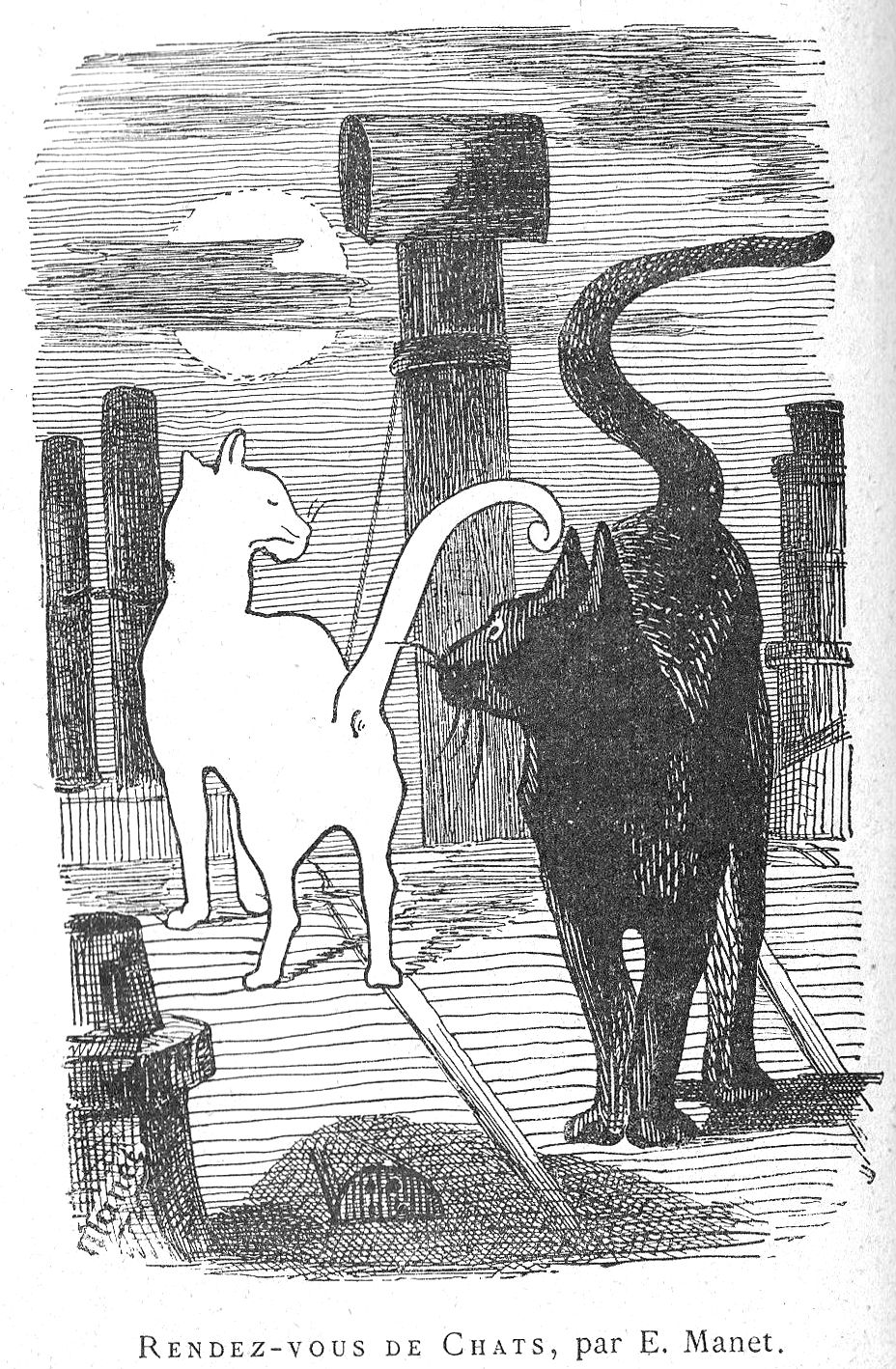
More than one suitor of the belles is harshly treated in these duels and tournaments of gallantry where blows, strikes and hideous wounds are not spared.
During the mating season, the tomcat gives off a very unpleasant and unique odour. Gestation lasts fifty-five to fifty-six days. The female usually bears two litters in a year, kittening occurring at the end of April or in the first days of May, and in October.
The normal cry of the cat, which has several different modulations and inflections, is called miaowing, and it certainly deserves to be considered language. The intonation and rhythm differ according to the cat’s sex. The mother has a particular cry for calling her kittenss, another to guide them, another to warn them of danger and scold them for their misdemeanours and disobedience. The male meows in a very different way to express his affection and friendship to his masters. The expressions also vary between spouses. He knows how to ask, not to be mistaken, to drink, to eat, to go out or to return, etc. His discontent is expressed by particular cries; he has his cry of war, of contempt, of anger; it is a kind of whistling, it sometimes sounds like he is spitting in the enemy’s face and this is commonly called swearing. He expresses his contentment and satisfaction when he is caressed, by a peculiar noise similar to that of a spinning wheel and which has been called the purring. In some cases, he translates his affections, his desires and his good humour into a dull and continuous murmur. The language of the male is very different from that of the female.
Father Galliani, who has, as I have already mentioned, studied the language of animals, says that there are "more than twenty different inflections in the language of cats, and their language is a true language, because they always employ the same sound to express the same thing".
It is often said that the Cat is more attached to the house than to the inhabitants; I think there has been some confusion about this. Just as it has been noticed that Cats carried a great distance from home in a basket or bag have returned to the house they had been torn from, there are also many examples that prove when their masters come to live in the new house with them they do not try to go back to their old house. They acquaint themselves with the new place, and when they feel certain that their masters are with them, they feel at home and remain there without fear and without trying to escape.
Let us also note that among the cat’s peculiar habits is a passion for valerian (Valeriana officinalis and Valeriana phu). When they encounter it, they roll in it, rub themselves on it, and seem to find incomparable delights in these actions, probably because of the smell given off by the root, although this is unpleasant to our sense of smell.

CHAPTER V – USEFUL CATS
It seems to me that cats should be better appreciated for the unquestionable services they provide.
There is no doubt that there are "drawing-room cats" who never destroy any mice, but the well-known story of the young Englishman who made a fortune in the Indies with the help of his cat, does not seem completely improbable to me. I can imagine perfectly well the joy of the legendary monarch who had been tormented by rats when the stranger’s cat arrived, sowing terror and death in the ranks of these previously invincible enemies. The simple presence of a cat is enough to deter those bold rogues and force them to retreat. This cruel enemy who stalks them, his eyes shining with a strange light in the darkness; this mysterious and terrible creature who seizes them by the throat before they even suspect his presence, filling them with fright. Rather than remain exposed to danger, those cowards prefer to flee. The mere fact that a cat’s presence frightens away rats and mice is so true that, in recent years, an American has made porcelain cats with phosphorescent eyes, which are apparently enough to rid houses of those useless and dangerous rodents.
The quantity of rats and mice destroyed by cats is considerable and would be hard to believe if we did not have the testimony of numbers. I give here the result of Lenz's experiments and observations. "To know what a cat can do by way of destroying mice, I used the year 1857 which was extremely fertile in those small animals. On the 20th of September I enclosed two small half-Angora cats, with brown tiger stripes on a fawn background, and aged forty-eight days, in a small box arranged for such experiments,. I gave them daily bread and milk, and in addition I gave them four to ten mice, which they never failed to devour completely. After fifty-six days, I only supplied them with milk and in this interval fourteen adult or at half-grown mice. The young cats ate everything without rejecting anything, doing very well on this diet, and having the same appetite the following day. Soon afterwards, the mouse eaters in question having been released, I locked up a young half-Angora cat, aged five and a half months, at about nine o'clock in the evening and I gave him nothing to eat for the night.The young animal initially showed sadness at finding himself shut up and deprived of his youthful frolics. The next morning I gave him, for the whole day, a mixture of equal parts milk and water. I had a supply of forty freshly killed mice, and from time to time I gave him a number of them.
"At nine o'clock in the evening, and consequently after twenty-four hours of captivity, the prisoner had eaten twenty-two mice, half of them mature, and the others half-grown. The animal rejected nothing, and continued to do well. During the whole of the year my cats were occupied night and day in catching and eating mice, and nevertheless each of them ate a further seven mice on the 27th of September, in the space of half an hour, which I gave them in addition.
"From these experiences I admit in a positive way that in the years when there are many mice, every half-grown cat eats on average twenty mice per day - that is, 7,300 mice a year. In the years when those small rodents are less abundant, I estimate this same total at 3,650, or an equivalent in rats instead of mice."
These statistics alone should allow for a little kindness towards the much-maligned and slandered cat.
And it's not just in our homes that our friends the Cats friends wage war on rodents, but it’s wherever they can, even in places where most other animals could not survive. Thus, in many cities in the United States, mainly in Pittsburgh, where the cold-food industry has expanded considerably. These cold stores, "Cold storage warehouse," do real services in a country where there is extensive production and where, due to momentary over-abundance in the marketplace, many goods might otherwise be thrown away or sold at low prices. For several months, during the creation of these establishments, the cold storage warehouse in Pittsburgh housed neither rats nor mice; it was too cold and, more importantly, the cold was too persistent - the permanent temperature being 4 to 6 Celsius below zero. — The rodents that crept in either died or quickly left. However, some of them managed to survive the low temperatures and after a while their presence was noticed, but they were not normal rats; they wore surprisingly long, thick fur. Even their tails, by the wise dispensation of Providence, was covered in thick, warm fur, otherwise it would no doubt have quickly become frozen, gangrenous and have fallen off. To get rid of the rats which hade become perfectly acclimated and very abundant, cats were brought in. They died. The cold was too harsh for them, and they could not resist. After a few tries, one of them was able to survive. It was a female with exceptionally thick fur. She was obviously better equipped and better able to resist the cold. Her thick fur saved her and she survived. One day, she gave birth to a litter of seven kittens. Born and raised - with great care - in the unhospitable environment into which they were born, the saw the day, metaphorically speaking, and developed into strong, well-fed cats, endowed with an excellent fur coat. They became the ancestors of an abundant breed which is so well adapted to the cold that they have populated all the cold stores of Pittsburgh. All these cats are vigorous, stocky and have very thick coats resembling that of wild cats of the forests of Canada [lynx].
This special breed, which owes its existence to both selection and the influence of the environment, is mainly characterized by the length of its tail and the considerable development of its eyebrows and whiskers. These bristles are about twice the usual length, and in the darkness where these animals live, these tactile organs obviously play a much larger and more important role than in ordinary conditions. The acclimatization and adaptation are perfect, it even seems that if a cat of this new variety is taken from its habitat and put outside, especially during the summer, it dies in a few hours because it is unable to endure the extreme temperature. This is very possible. Without wishing to enter into scientific theories, we can say that this is a very curious case of acclimatization and adaptation in an abnormal environment – and there are many other other cases - which is interesting because of the odd nature of the environment. The industrialists of Pittsburgh will not deny the great usefulness of cats.
[Note for the modern reader: this was a wholly invented story from a journalist on a "slow news day." There were no rats – or cats - in the refrigerated warehouses.]
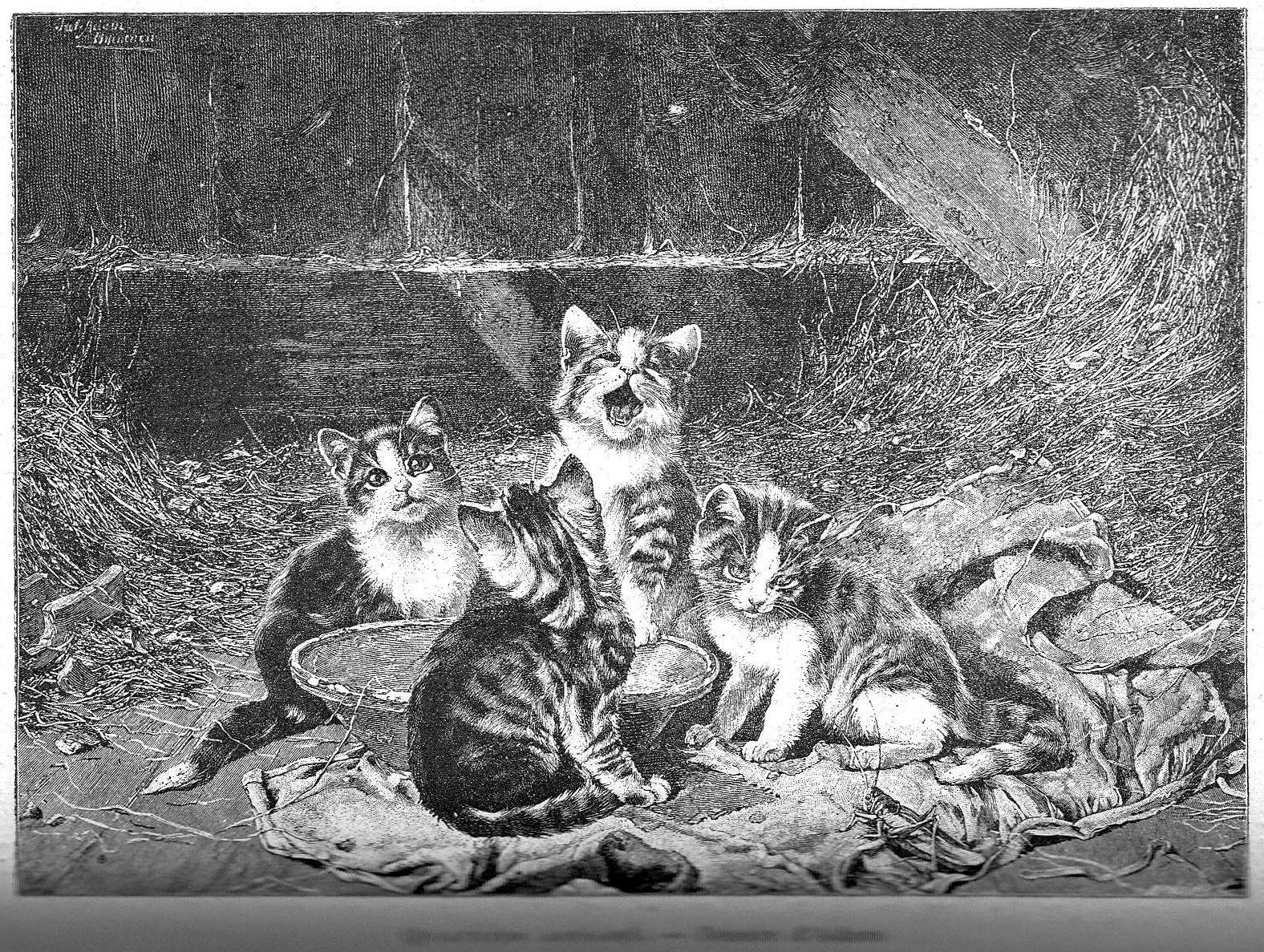
Not only do Cats rid us of the danger presented by a whole series of rodent vermin, they also destroy reptiles, especially the most dangerous serpents like the viper and the rattlesnake. It is known that the monks of the island of Cyprus brought in Cats to hunt the serpents that infested that territory.
De Debreves, in his "Voyage in the Levant," says in regard to this: "Near Paphos, later called Bafa, is a famous spit of land at the tip of the island of Cyprus; it is called the Cape of Cats. The legend goes like this: There was a monastery whose monks kept a certain number of Cats to wage war on the serpents that laid waste to the country. The cats were perfectly disciplined, and at the sound of a certain bell they all went to the abbey for their meal, and then returned to the country, where they continued their hunting with admirable zeal and skill."
While in Paraguay, Rengger witnessed cats pursuing preptiles and recounts one such scene as follows:
"More than once in Paraguay, I have seen cats chase rattlesnakes at places where the soil was sandy and grassless, and harass them until they were dead. They slap the reptile with instinctive skill, and throw themselves aside to avoid the enemy's strike; if the snake rolls itself up the cat waits for a long time without attacking it, walking around it until the evil reptile grows tired of turning its head in all directions to follow the cat’s movements. At that moment, the cat slaps it again and springs to the side; if the snake tries to escape, the cat takes it by the tail as if to play with it. In this way, by a series of repeated paws, the cats usually succeed in killing the snake in less than an hour, but they never eat their flesh."
The Cat also destroys a large quantity of the insect pests that devastate our plants, such as beetles and grasshoppers. Various public administrations, customs posts, post offices, etc. etc., maintain a certain number of cats for which a special budget is allocated.
That is, without the Cat, the man is powerless to get rid of this devastating plague represented by the trots-menu gent.
This is because, without the Cat, man is powerless to get rid of the devastating scourge represented by its walking dinner [trotte-menu]. This isn’t surprising if recall the history, or perhaps legend, of the great fortune of Richard Whittington, to which Madame Levesque alludes in her poem "Minet," published in 1736:
Finally, charming Minet, I’ll establish your glory,
By making a memorial of the feats of your peers;
And those who applaud him will pass for the learned,
Just as did the the illustrious Lesdiguiere,
The love of a Cat is a great-hearted love,
And this love carries with it heroic honours.
It was thanks to a cat that a veritable no-one,
As the English will tell you, became mayor of London.
Another man almost wound up in prison,
But his little cat’s tricks paid off his ransom.
[Enfin, charmant Minet, pour établir ta gloire,
Des faits de tes pareils je veux faire un mémoire:
Ceux qui l’applaudiront passeront pour savans,
Ce que lit autrefois l’illustre Lesdiguière.
[ . . .] La passion des Chats est celle des grands coeurs,
Elle entraîne après soi d’héroïques honneurs.
Un quidam par son Chat fut gouverneur à Londres,
Demandez aux Anglais, ils en pourront répondre.
Un autre était au point d’être mis en prison,
Les tours d’un petit Chat payèrent sa rançon.]
The story of Whittington’s famous Cat is narrated elsewhere in the comedy "Foote the Nabob." Is it true? In any case it is not improbable.
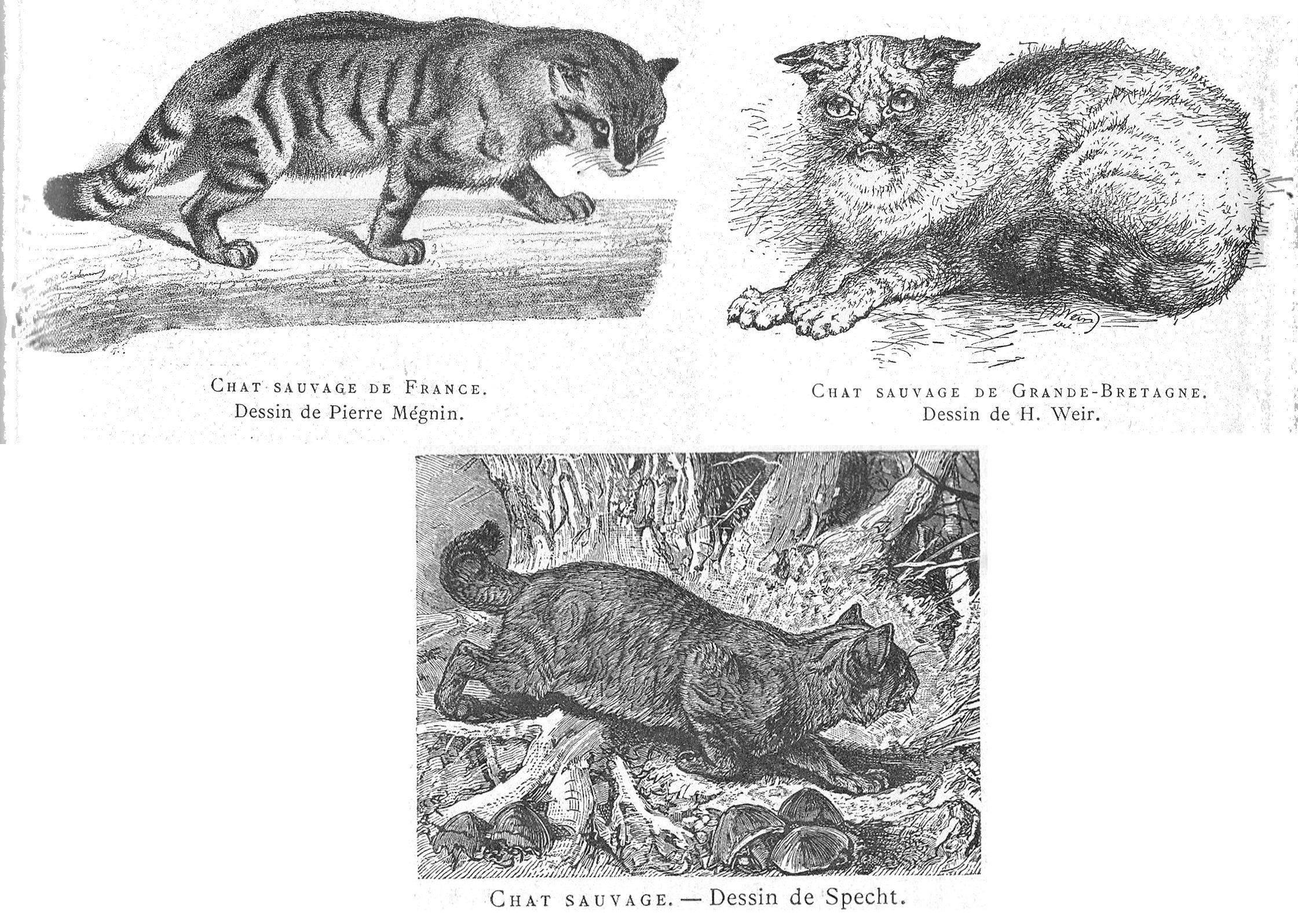
CHAPTER VI - GENERAL CONSIDERATIONS ON BREEDS.
The various cat breeds arose without human intervention due to the spontaneous appearance of special characteristics, or by the influence of the environment. The little dominion that man has over such am independent animal explains this fact. The foremost of these characteristics relate to the shortening of the tail, the position of the ears, and peculiarities of the skin and fur. Mr. Cornevin, the very learned professor of the Veterinary School of Lyon, has established the following classification on the basis of these characteristics:
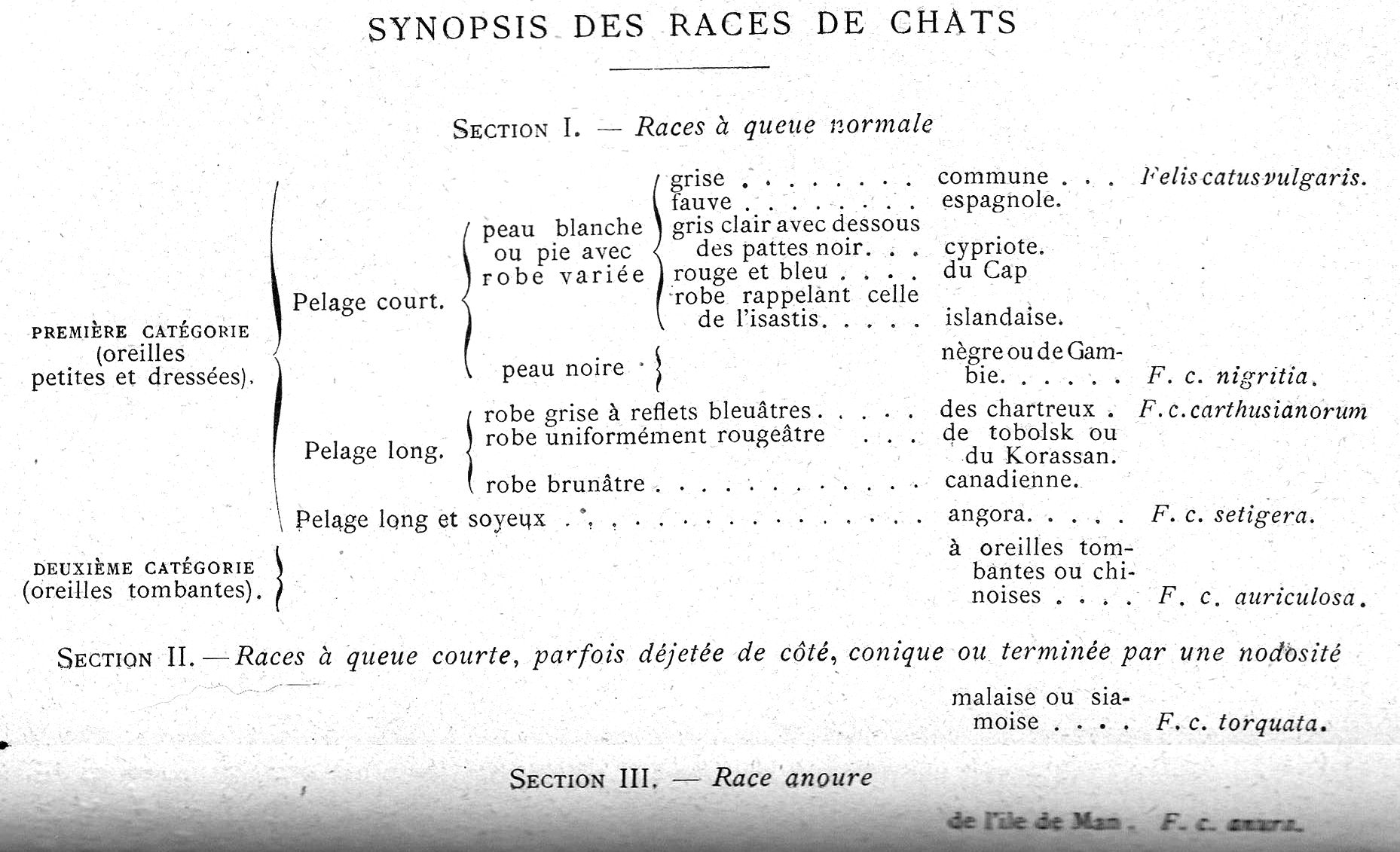
This classification leaves out the wild cat (Felis catus), which appears to be the origen of the domestic cat, but which is noticeably stronger and more vigorous.
The wild cat is tawny-grey or brownish above, and the lower parts are clear fawn. Its tail is remarkable, being very well furred, the same diameter along its length and terminating in a large black ring. In the domestic cat the tail is less furry and almost spindly. At first sight, it is distinguishable from the domestic cat by its more luxuriant coat, its more abundant whiskers, its wild appearance, and its stronger and sharper teeth. It has a yellowish-white spot on his throat.
This cat actively hunts birds and small mammals. In some circumstances it has even been dangerous to man; fortunately the wild cat has become very rare in our country, but it is still quite common in parts of Switzerland, in the Thuringian Forest and in the Caucasus. What is curious is that it does not exist in Norway or Sweden, nor in the north or center of Russia; in fact the lynx – another member of the cat family – has the advantage and replaces it in these countries.
Living lonely in the middle of forests and high timberlands, the Wild Cat makes its home in caves, rock crevices or in the burrows of foxes or badgers where it finds a ready-made lodging. It hunts mainly at night, and although it gets rid of a considerable number of small rodent pests, it prefers young game. Its method of attacking his enemy is quite cowardly: it never faces its prey, but jumps on its back and assassinates it - that's the right word for it - by breaking its cervical vertebrae or severing its carotid arteries with formidable pointed teeth that cut like lancets. If it misses, it quickly retreats, climbs a tree and waits patiently and vigilantly for the tight moment for a new attack. Eating relatively little, it kills for the pleasure of killing.
Fearing men, it quickly flees from them as long as it is not attacked, but if attacked, and especially when wounded, its wrath becomes terrible and it shows extraordinary courage. It attacks dogs with the same energy.
"The Wild Cat," wrote Tschudi, "is so unafraid of dogs that he will voluntarily come down from the tree and attack them before the hunter arrives, resulting in a dreadful struggle. The angry cat rakes its claws into its opponent, making deep gouges, and tries to scratch its opponent’s eyes. It defends itself furiously for as long as it retains a spark of life and its defence is long because few animals have such a tenacious grasp on life.
In the Jura a male wild cat, lying on his back, held his own against three dogs and came out victorious from the battle. He slipped his claws into the muzzles of two of the dogs while he held the third by squeezing its throat in his powerful jaws. This mode of defence, which demanded extraordinary courage and an inconceivable skill, was at the same time a testimony to the cat’s extreme resourcefulness, for it was the only defence that could protect him from being bitten by the the dogs
The gestation period is about nine weeks and female wildcats usually bear their young in a tree trunk, rock crevice or burrow. They feed their young with great solicitude, however they defend them very poorly. This anecdote reported by Lenz is proof of this:
"In 1865 a carpenter crossed a thicket about fifty paces from my house on the southern side of the Hermnustein, where there are a great number of rabbits. He thought he heard meowing from an enlarged burrow. This discovery filled him with joy, because a few days earlier he had expressed the desire to have some wild cat kittens. He began digging out the burrow and found three kittens each about the size of a rat. He put them in his sack and was leaving when he spotted their mother lying not far away with her ears erect. However she kept her distance, and did not try to attack him.
She was the size of a large hare. The young, by their colour and short, thick tail, were easily distinguishable from domestic cat kittens. They were extremely wild, scratching, biting and screaming ferociously.
He tried all possible means of taming and caring for them, but in vain as they refused to eat or drink and fought him like devils until they died."
The wild cat is often confused with feral cats, that is to say with domestic cats living a more or less wild life.
The Manul cat (catus manul) is another species of wildcat and is found in the mountainous regions of the Tartar and Mongol steppes. It stands taller than the fox and its coat is a mix of whitish-yellow hairs and brown hairs. Its head is spotted with black; two black bands extend along its cheeks; the exterior of its short, broad, blunt ears is yellow; its long tail is bushy, uniformly furred and is ringed up to the black tip.
The gloved cat (calus maniculatus) whose habitat is Nubia or eastern Sudan, is similar and almost impossible to tame.
The species has existed for three or four centuries in Paraguay, where it has been domesticated, but it has shrunk in size. It reproduces with difficulty in the South American forests despite ample means of subsistence.
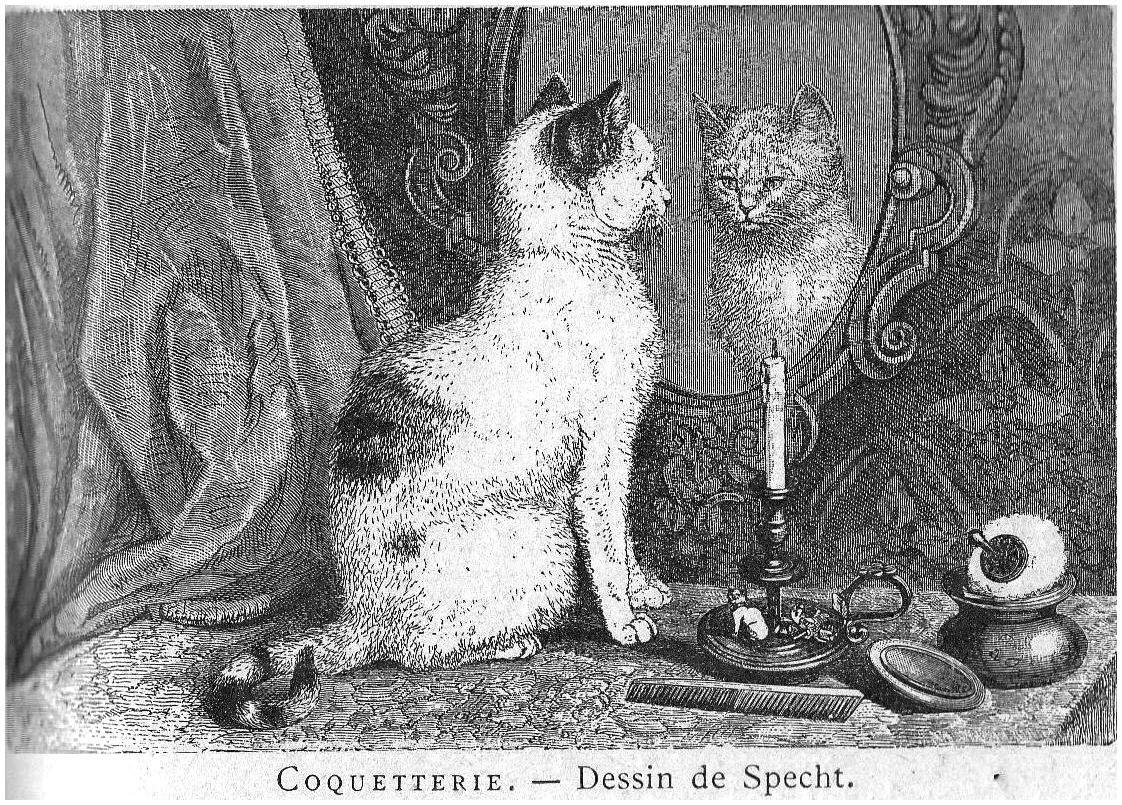
CHAPTER VII - DOMESTIC CAT BREEDS.
I have already mentioned in this study the probable origin of the domestic cat, so I will not come back to this. Its colouring, as I have said, is extremely variable. The general characteristics are: the rather small ears which are hairy on the outside and almost naked on the inside; the long, tapered tail and the short fur.
Sexual dimorphism is evident in the male's greater strength and weight and because his coat never has more than two colours, while the female can have three colours.
The average live-weight is 4 kilograms.
The average weight of the skin is 380-grams.
The average weight of the brain is 32 grams.
Nearly all that I have said about the wild cat is also applicable to the domestic cat, but there are several sub-races. Here are the main ones.
THE IBERIAN CAT (Felis catus hispanicus), designated by Linneas and Boddaert under the name F. c maculatus, is widespread in Europe, and quite sought after by amateurs.
Very gentle, docile, very attached, very affectionate and intelligent, it is a charming cat, though it is also a skilful hunter of vermin. It is about him that we say:
But what do we know, says Montaigne,
When with his cat from Spain
A man takes his frolics,
If the cat is not the real master
And the man is only a beast
Suitable for entertaining cats.
Its fur is shiny and rather short and its coat is marked with irregular patches: tricolour in females, that is to say, bright red, dark black and pure white, and two-coloured in males. However, it is said that in Spain and Portugal there are males with the three colours.
THE CYPRIOT CAT is invariably light gray with the underside of the paws black; they are long haired.
THE ICELANDIC CAT is grey-blue; as for the CAPE [OF GOOD HOPE] CAT, it is red and blue; we see a reddish dorsal line on its bluish coat.
THE NEGRO OR GAMBIAN CAT is found on the west coast of Africa, in Guinea and Gambia; the pelt is black and crinkled, the figure short, the hair long, the ears a little bare and the legs too long, which gives these cats a singular appearance.
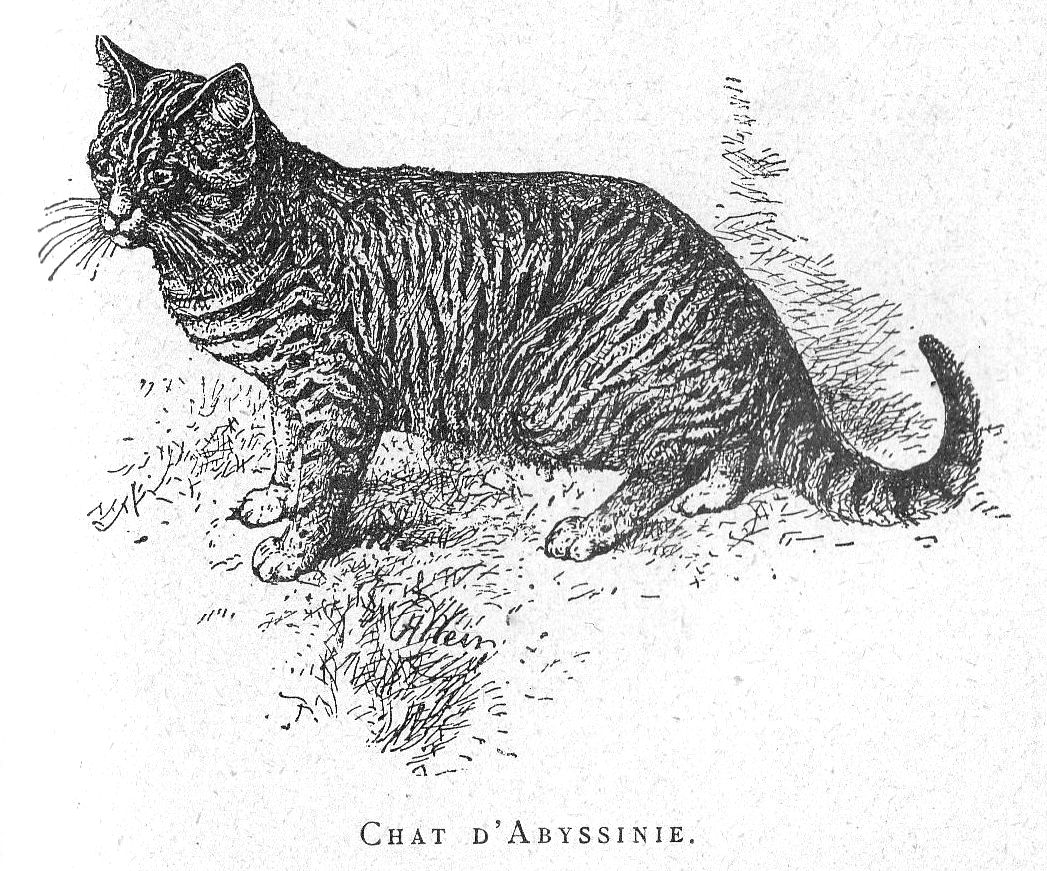
THE ABYSSINIAN CAT differs from the Gambian cat only in that it is striped; it is a very pretty domesticated animal in some parts of Egypt.
THE CARTHUSIAN CAT has a long, woolly coat, uniformly dark bluish in colour; it is strong in size and imposing looking, but has a general tendency to laziness. The sub-breeds in this group are the TOBOLSK, KORASSAN and CAUCASUS. The TOBOLSK cat has very long woolly hair, as befits an animal from cold countries, its colour is uniformly reddish. The CAUCASUS and KORASSAN breeds seem difficult to distinguish from the typical Carthusian cat except that their coat is more reddish.
THE ANGORA CAT is widespread and found everywhere. Originating from Angora in Anatolia, it is certainly the most beautiful breed you can meet. It is said that the Angora’s fur alters and changes when these animals leave their country of origin, and this does seem to be the case for among specimens of this breed directly imported and now to be seen in the zoological gardens of London or Antwerp, the fur is even longer and more silkier. This is the favourite breed of the Turks and Armenians.
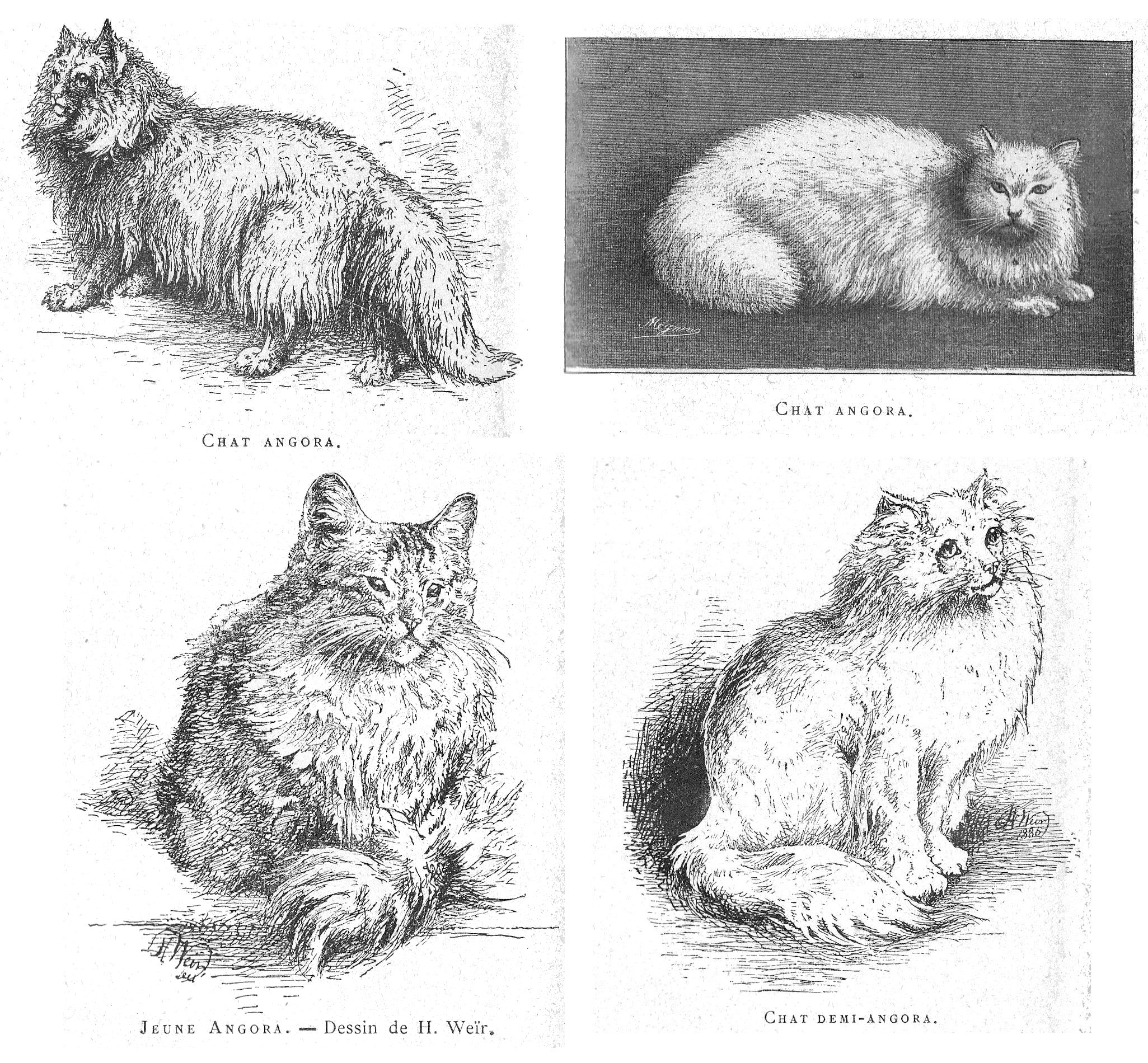
It is tall, with very long, fine and silky fur, especially aeound the neck, belly and tail. Its colour varies; it is sometimes a remarkable white, sometimes greyish or pale fawn, but rarely a mix of colours. The lips and soles of the feet are flesh-pink in colour. The ears are large, rather than small, and are pointed with tufts of hair at the top. The rarest and most valuable are the blue-eyed white Angoras without any colour mixed in their fur.
This cat is lazy, indolent, sleepy and frivolous, but is very intelligent. It is a large departure from the primitive type, having neither the carnivorous instincts nor the liveliness of the tabby cat. It is majestically enthroned on an elegant piece of furniture in the drawing-room, or in shops in the cities, where it seems frozen into in complete immobility, like a wonderfully successful work of art. Its prolonged pose and attitude give it the appearance of a sphinx.
In contemplation they take thea noble attitude
Of great sphinxes lying in the depths of solitude,
Who seem to sleep in an endless dream.
[Ils prennent, en songeant, les nobles attitudes
Des grands sphinx allongés au fond des solitudes,
Qui semblent endormis dans un rêve sans fin.]
The Angora is more of a luxury animal than anything else; it belongs only in drawing rooms and it is indifferent to mice and rats. It loves the fireside, the beds and armchairs, where it has frequent and prolonged naps. Its movements are slower than those of the short-haired cat, and it is less carnivorous.
In France, there are very few true Angoras, but half-Angoras are very numerous; these are nice enough, and are close enough to the pure type; even if their hair not as long it is just as silky.
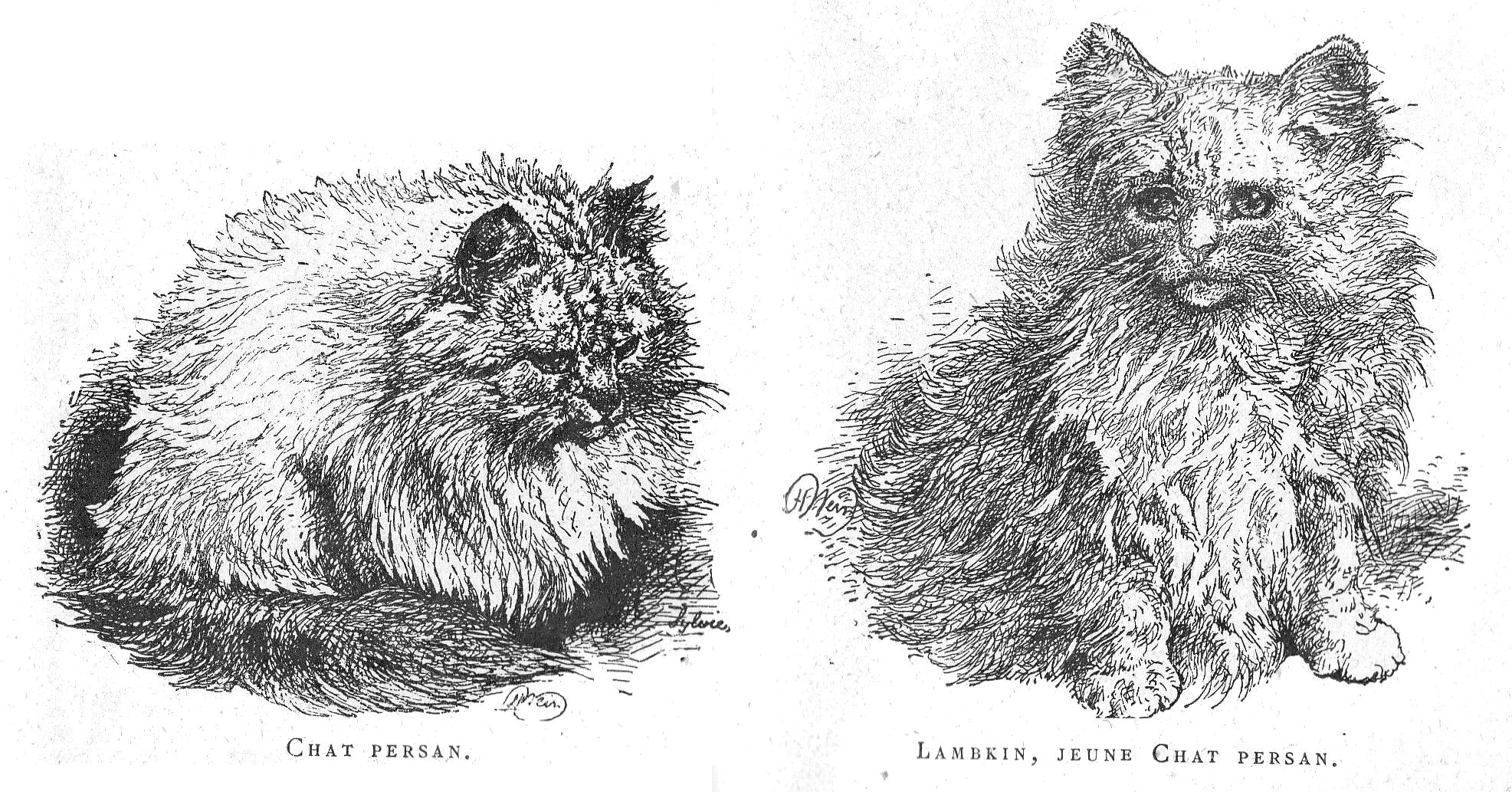
THE PERSIAN CAT differs somewhat from the Angora, in that its size is generally more robust, its head is larger with less pointed ears, its eyes are larger, fuller and rounder, with a great expression of sweetness, and its legs, and even its feet, are covered with long hairs. There are many colour varieties, and by selective breeding you can obtain almost all colours, except for the one peculiar to tortoiseshell cats.
THE RUSSIAN CAT also differs from the Persian and Angora in that it is even larger in its body, but is less leggy. It has a mane, or rather a ruff, furnished with thick, silky hair; its colour is usually duller.
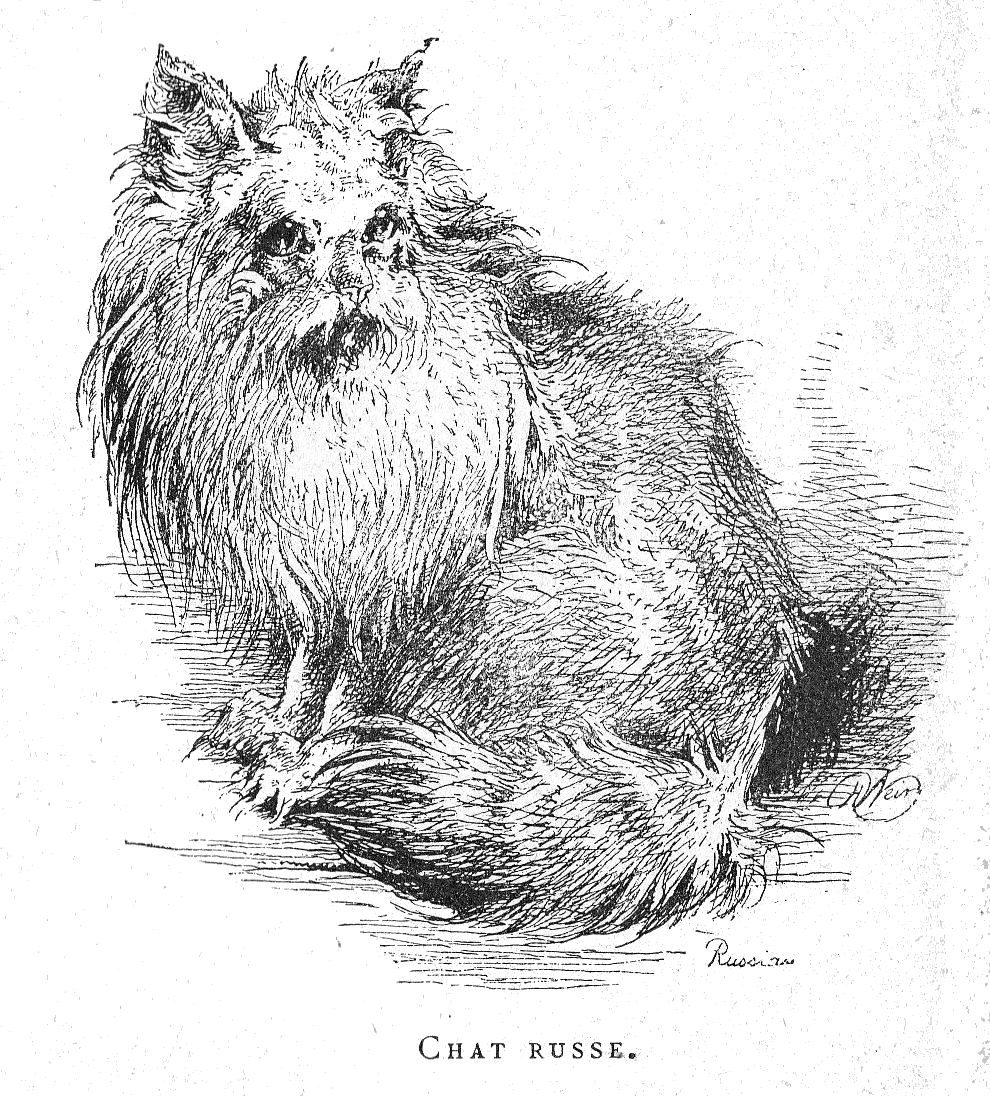
In the category of lop-eared breeds there is only one breed to be reported.
THE CHINESE CAT (F. c. sinensis) resembles the Carthusian cat in the length of its hair. It is found in China in the province of Pet-chi-li and in all of Manchuria. It is fattened and eaten just like the specially bred chow-chow dog. It is also part of the export trade, being exchanged between the Manchus and the inhabitants of the country of Kiliaque, who trade sable fur for it. It is rarely found in Europe. However, Baudelaire, that friend of cats, took note of it:
"One day," he wrote in wrote in the Revue Fantaisiste of 1861, "a missionary walking in the suburbs of Nanking realized that he had forgotten his watch and asked a little boy what time it was. The boy of the Celestial Empire hesitated at first, then, turning his back, he replied: ‘I will tell you.’ A few moments later he appeared, holding in his arms a very large cat, and, looking at the pupil of the cat’s eyes, he said without hesitation: ‘It is not quite midday yet.’ Which was true. For me, when I take in my arms my extraordinary cat, which is at the same time the honour of its race, the pride of my heart, and the perfume of my mind, whether at night, In the full light, in the depths of her adorable eyes I always see the hour distinctly, always the same, an immense solemn hour, great as the space without division of minutes or seconds, a motionless hour which is not marked on the clocks and, however light as a sigh, quick as a glance.
And if some intruder came to disturb me while my gaze rests on the delicious dial, if some dishonest and intolerant genius came to tell me ‘what are you looking at with such care?’ What do you look for in the eyes of this stranger? Do you see the hour, mortal prodigual and lazy?
I would answer without hesitation: Yes. I see the hour; He is eternity!"
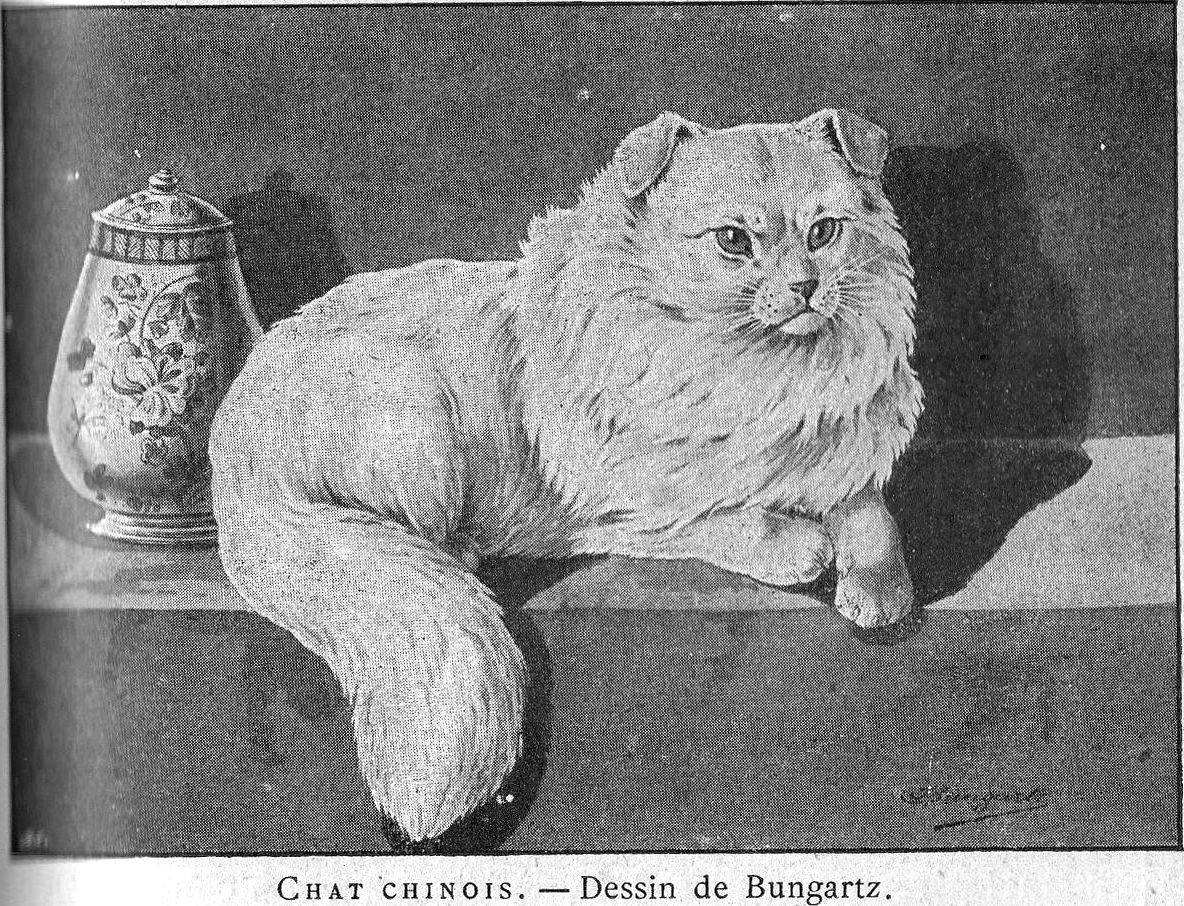
A BREED OF CATS WITH A SHORT TAIL ENDING IN A NODULE is found mainly in the Far East - in the British East Indies, Siam and the Malay Archipelago.
The main type of this breed is the Siam or Malay Cat, which is becoming quite common in Europe, but which remained rare for many years. H. Weir, in his book "Our Cats," says that from 1871 to 1887, only 19 of them were exhibited, including the 15 she-cats in various English cat shows. Since then, many people from England and France have made trips to Siam and the species has become a little more widespread.
It seems that the true breed is only found at the palace of the king of Siam and it is difficult to obtain one. The king is very jealous of this royal breed, which is why he does not allow the exportation of entire males. Their diet consists of boiled rice and fish, and also meat; they prefer small birds and small quadrupeds. They are very attached to their master and follow him like little dogs.
They are very difficult to rear until they are six months old. They are born almost white, with a small dark grey line on the edge of the ears; the extremities darken gradually until the age of one year.
According to Mr. H. Weir, the characteristic points of the Siamese cat are:
Size and shape: a little smaller than our European cat, elegant and graceful profile, thin and somewhat long; thin and somewhat short legs, feet longer and less rounded than in ordinary cat, long, thin neck.
Small head, wide between the eyes, narrowing at the nape of the neck and between the ears; flat and receding forehead; nose long and rather wide, cheeks narrowing towards the mouth; full and rounded lips; ears rather large and broad at the base, not very hairy inside; almond-shaped eye, set obliquely towards the nose, with an iris of beautiful opaline blue, and a luminous reddish pupil in darkness and in a spotlight.
The tail is shorter than that of the ordinary cat, a little larger at its root and gradually towards the tip.
Short hair, a little woolly, soft and silky to the touch, shiny and lustrous on the face, legs and tail.
Base colour is a solid hue, a little darker on the back; café-au-lait, pale silver-grey, light orange, and bright fawn are the preferred colours. More or less dark brown cats, almost chocolate, are allowed, provided they have no markings but, we repeat, light colours must be preferred.
Markings: Black ears; this colour not extending beyond the ears; black mask, tails and black legs. Black must not extend onto the body and there must be no other black markings.
Condition: In full health, the Siamese cat should not be too fat, and should have soft, shiny, glossy hair lying flat to the body which must show hard and firm muscles.
There are now many families of Siamese cats in France; among these, I must mention a whole brood that has lived for several years at the laboratory of Professor Milne-Edwards at the Museum, and another belonging to Senator Waldeck-Rousseau. Both families are pure-bred. Our master François Coppee also has a specimen, but of less pure race.
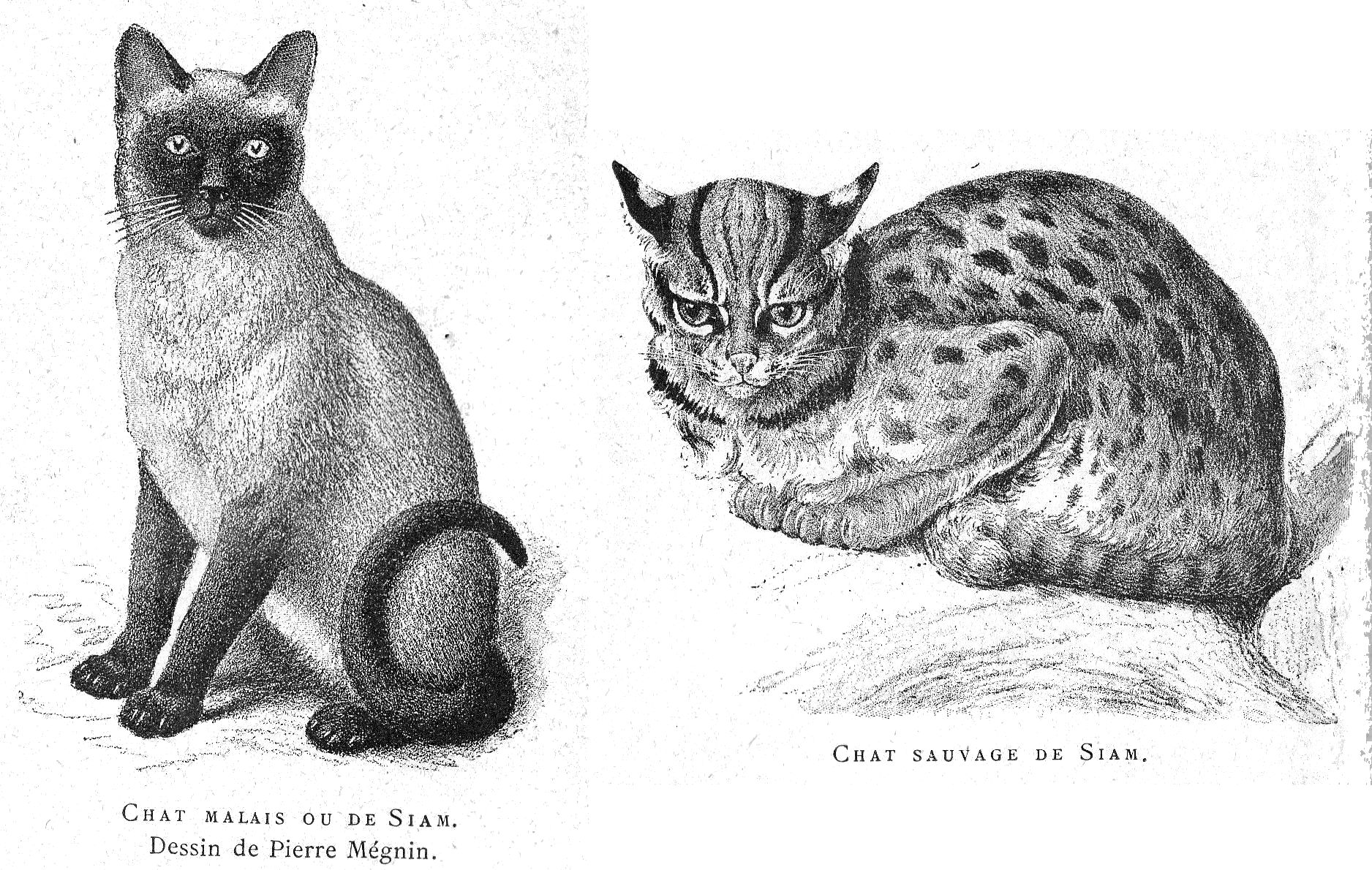
Beside these domestic cats of Siam, which seem to be the drawing-room cats of the future, there are wild cats in the forests of Siam, and the Garden of Acclimatation possesses a very fine specimen. These are red with black circular spots and white throats.
These relatively short-tailed cats form a natural transition between breeds with ordinary-length tails and and those without tails.

Tailless Cats are native to the Isle of Man in the Irish Sea. Their tail is indicated by a simple stump, and their coat is uniformly black. There is a strong probability that this breed was imported and that its starting point was Japan, or perhaps China, couontries neighbouring Indo-China and Malaysia, the homeland of short-tailed cats, because in Japanese and Chinese images and paintings, it is quite common to see representations of tailless cats.
These cats from the Isle of Man, known as Manx, are very friendly and are good hunters of mice; but only a few English cat lovers have been able to keep the race pure. Matings with long-tailed cats produce fertile offspring, and the purity of the breed can only be maintained with much care or with the help of new imports.
These cats have a very curious feature: the hind legs are stronger than the forelegs, so that it no longer runs like a cat, but runs rather like a hare. The head is rather small for its size, the eyes are large, round and full, and the ears are average-sized and a little rounded at the top. As for colour, the cats of the Isle of Man vary a great deal, however, we do not know of any white ones, and black ones are very rare.
[Note: Megnin contradicts himself regarding black Manx cats, first saying Manx cats are uniformly black and then saying black Manx are rare.]
The frequency of cat shows in England has meant that many amateurs interested in cats have created, so to speak, new breeds, these only being varieties that differ mainly in colour, spots and zebra-stripes.
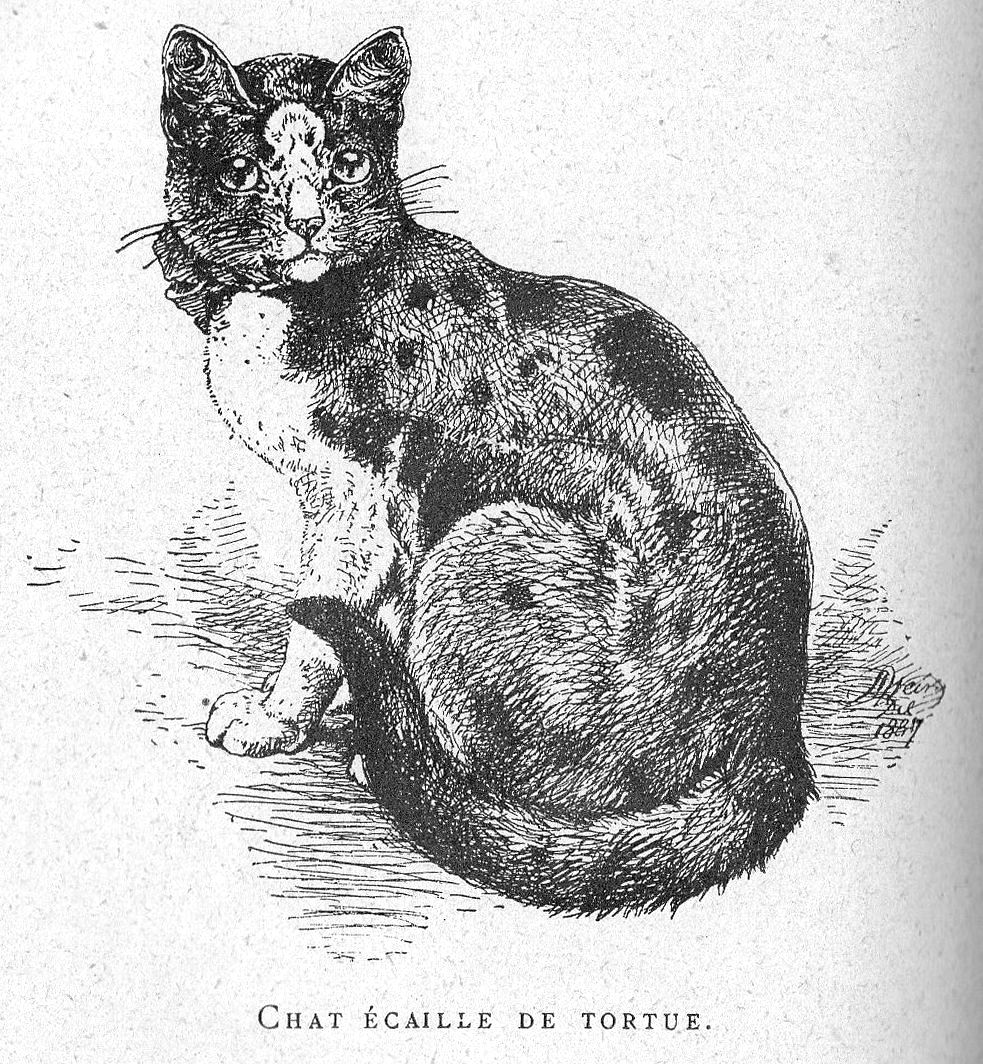
There is a very common species in the United Kingdom that is called TORTOISESHELL. This cat must be black, red and yellow. The colour should be wide and strong and the markings well defined. The eyes must be orange, the tail should be longer and stronger at the base, and the figure graceful and elegant. Standing rather low on legs, it is certainly a very attractive looking animal, but it is only an artificial product obtained by careful selection. Some even prettier types have white front paws, white chest and a white blaze between the eyes extending in a strip to the muzzle.
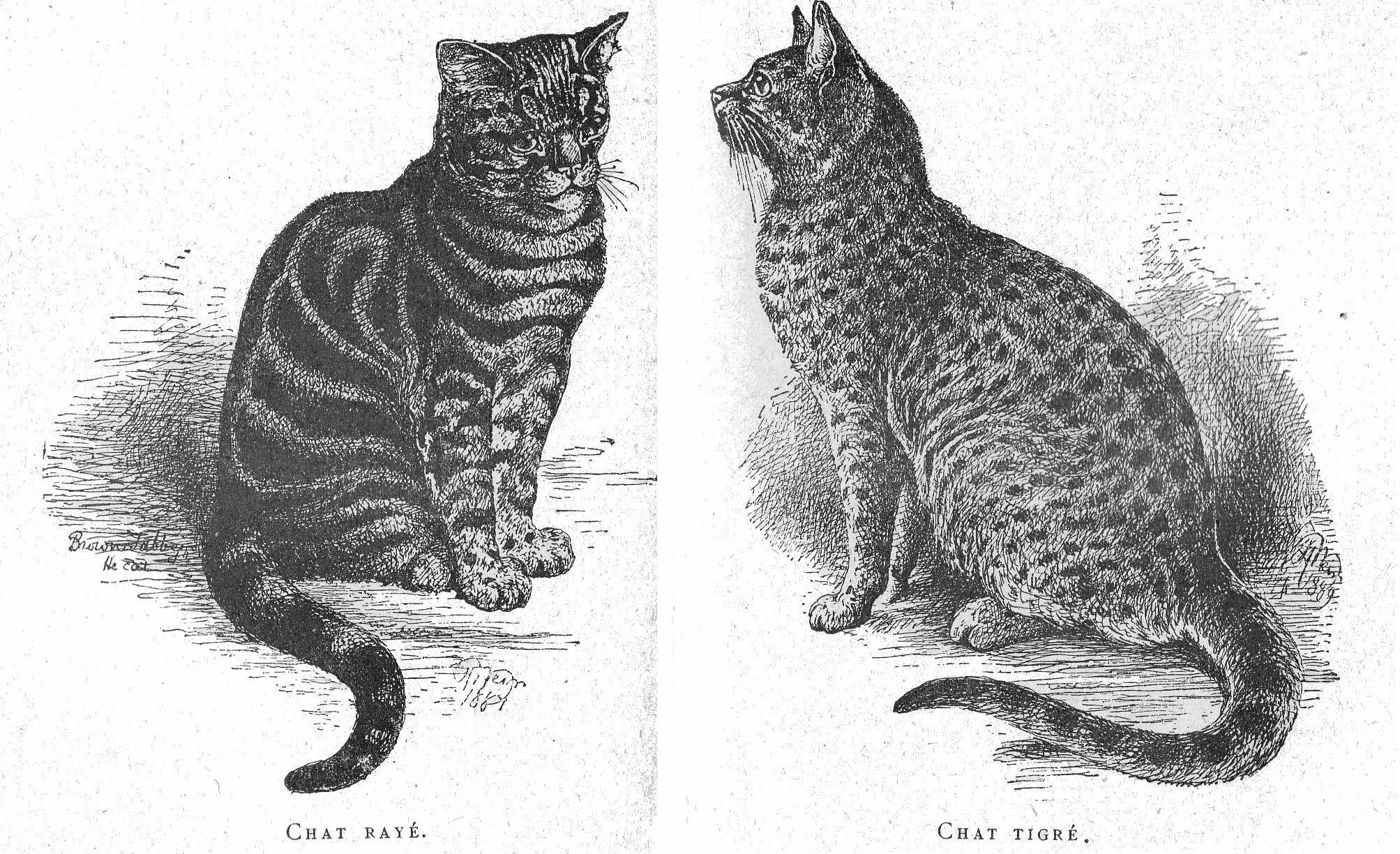
Here is the TABBY CAT, which is very common at English cat shows; some are black-striped, some are striped and spotted, others are brown-striped, and yet others are uniformly speckled. They are show cats.
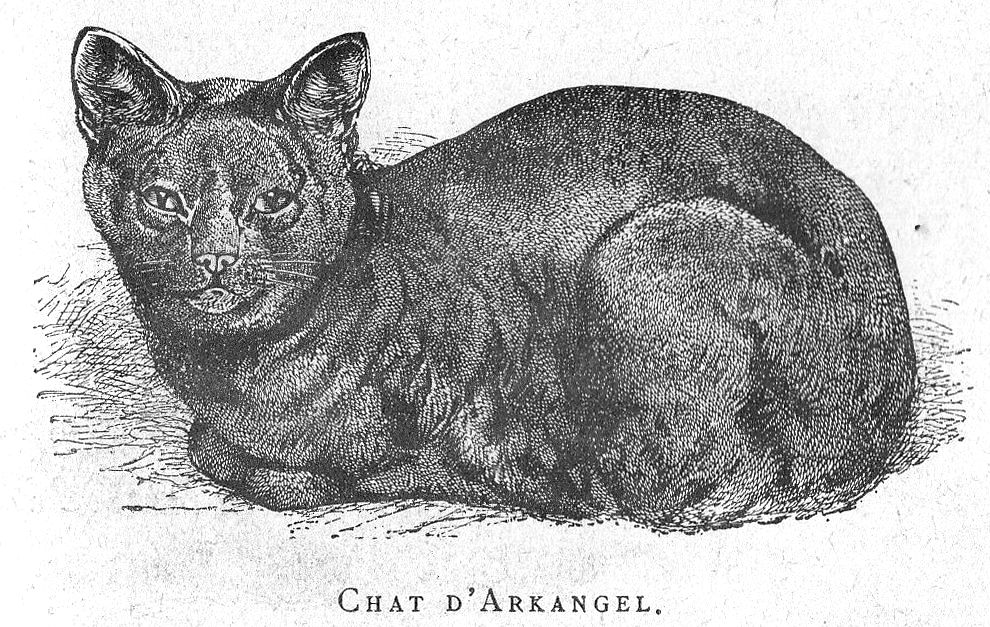
In the same way, the ARKANGEL CAT is just a paler variety of the common black cat. No-one knows why it is so-named seeing as it reached England under numerous names: Blue Cat, Russian Blue Cat, Spanish Cat, and American Cat. Weir, who has seen many specimens, admits that the most beautiful of this race, which was given medals at various cat shows, was merely the product of a she-cat with markings on a white background and a tomcat with markings on a black background. Nevertheless, these Cats are very pretty and deserve to be mentioned here, if only as curiosities.
That is a quickly study of the main breeds of domestic cats.
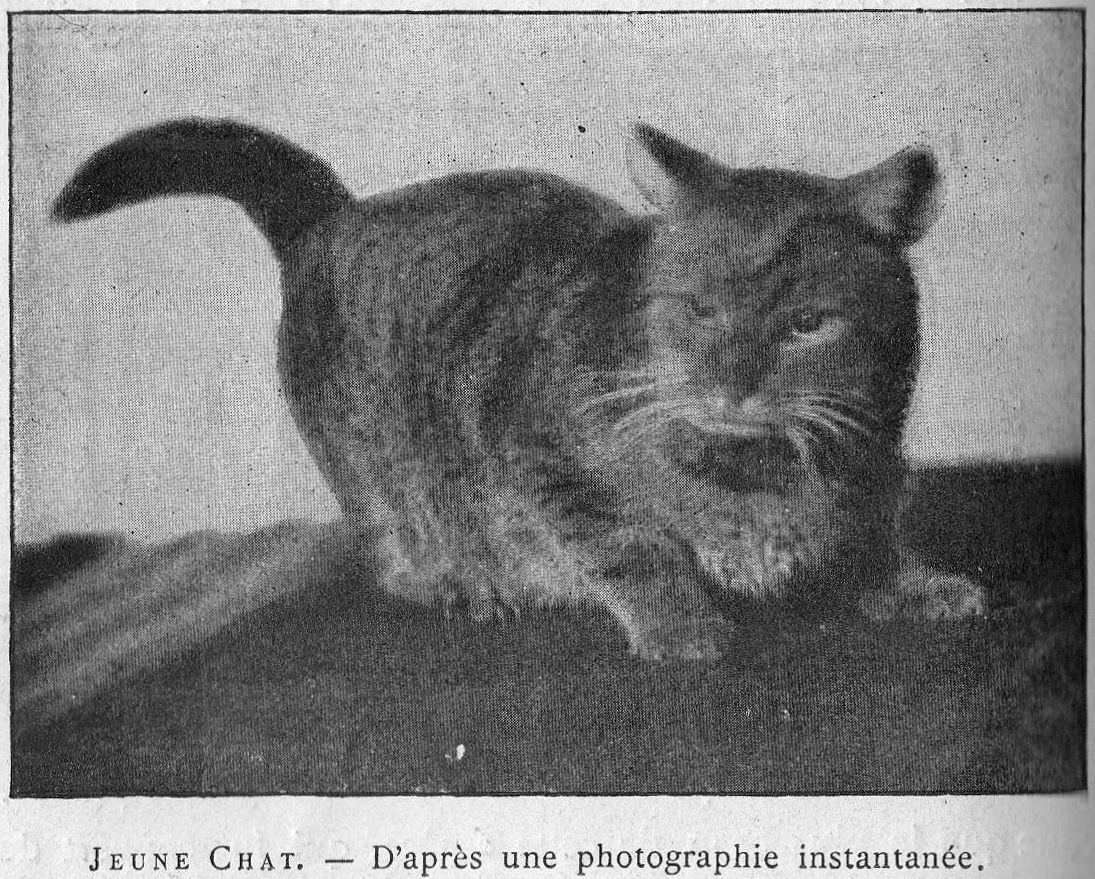
CHAPTER VIII - CAT DISEASES.
Because of their independent nature and the almost complete freedom they enjoy, cats are generally less susceptible to disease than other domestic animals. Few afflictions are peculiar to them, and these always have a great analogy to the afflictions of dogs.
Like dogs, cats are sometimes the victims of a particular sickness at a young age. It has even come down with epidemics at different times.
Mr. A. Landrin, who wrote a little "Treatise on the Cat," says that this was observed on a large scale in Europe, and especially in France, Italy, Germany, and Denmark, in 1779, when it struck all the cats.
During the years 1782, 1783 and 1784, Barnier says that the farms around Chartres lost all their cats. It was also observed around 1835, in several localities of Brie, especially in the canton of Claye, where it had been designated as epizootic.
It is nowadays occurs in isolated or sporadic cases in a number of cats.
This disease, which is essentially catarrhal in nature, manifests itself in young cats in the form of catarrh, pharyngitis/laryngitis, pneumonia and gastroenteritis. It is characterized by depression, despondency, nausea and cough. The diseased animal is drowsy, exhausted, and lethargic; it moves with difficulty; avoids cold and always seeks to get closer to the fireplace. It shows a deep disgust for food. One often sees mucus in the vomit. Its eyes, lips, and cheeks swell; it looks as if the head is swelling, its hair bristles, becomes dull, its fur looks soiled. It is no longer interested in grooming itself, something it takes great care of when healthy. Sero-sanguinolent [yellowish and bloody] mucus seeps from its nostrils and his eyes. The sufferer soon assumes a repulsive appearance, becomes ugly and spreads an infectious odor. It falls into a state of complete prostration, which is followed by convulsions at intervals. It quickly grows weaker and if one does not quickly rememby this state of affairs it quickly succumbs.
The same nervous phenomena that are observed in this disease in young dogs also occur in cats. As a remedy, there is only hygiene, good raw meat cut into very small pieces, fortifying preparations, and, like small children, cod liver oil; then one or two 50 centigramme salol pills per day.
Rabies also affects cats; in them it is as dangerous, if not more so, than it is in dogs. The symptoms are the same, and as for the remedy, there is only vaccination. The cause is always, as in all other animals, by contagion.
Now we come to a disease which is peculiar to the cat. This is contagious typhus, which has been observed in different countries of Europe and studied in detail at the medical school of Montpellier. Dr. Buniva of the University of Turin has also made detailed observations. These different workswere used by Dr. Guersent in the writing of his medical history of the contagious chapter on ‘Contagious Typhus in the Cat Species,’ in his ‘Essay on Epizootics’ [Essai sur les epizooties].
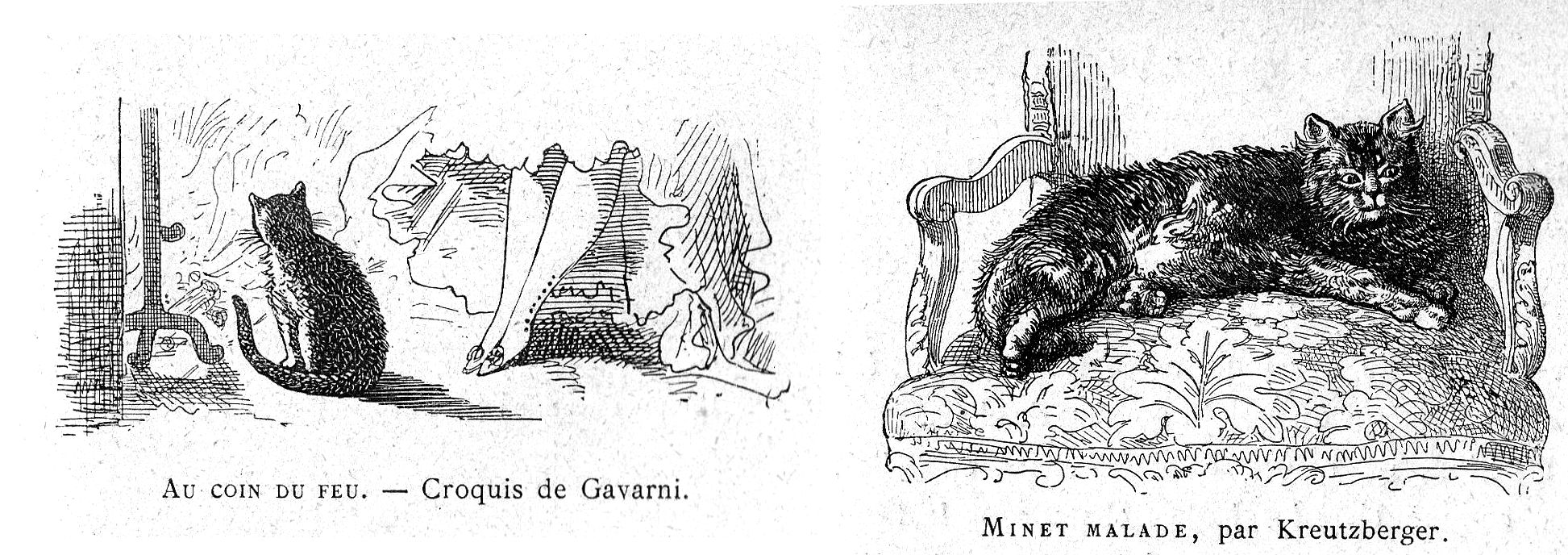
"In the first period of the disease," he says, "the tail droops, the head leans, the neck is elongated, the ears become flabby and cold, the limbs stiffen; the animal yawns [retches] repeatedly, sometimes has nausea and may vomit; he is drowsy to the point of stupefaction. The head and extremities twitch with tremors; the voice is changes; the pulse is shallow and frequent, the skin is hot and very dry, and there is stubborn constipation.
"In the second period, the animal is insensible to the voice of its master; the eye is small and tearful, the pupil is usually narrowed, but is sometimes dilated. The tongue is dry and covered with yellowish coating; a greenish foamy mucus discharges from the mouth, and sometimes there is a similar discharge from the nose; diarrhea often occurs; breathing is short and obstructed; the animal coughs. During the third period, agitation and convulsions mingle with the preceding symptoms; the body becomes jaundiced, and the patient dies in a state of prostration, or in the midst of convulsions, from the fourth to the fifth day.
"The alterations which have been observed in corpses prove that this is a general disease affecting nearly all the mucous membranes. The nostrils, the mouth, the oesophagus, the trachea, the bronchi, and especially the intestines, are usually partly filled with a whitish, yellowish, and bloody serous mucus, lying on the surface of the inner membrane lining these bodies. There is, moreover, an appearance of bruising, or black spots, frequently referred to as gangrenous. Similar alterations have been found in the liver and lung.
"It appears that this disease, just like contagious typhus in man and other animals, is also sometimes accompanied by inflammations of parts other that the mucous membranes. Hallé found, on a cat that had died, an effusion of purulent matter at the base of the brain near the ethmoid.
"There are numerous facts that prove that this disease is rapidly communicated between cats inhabiting towns, and even the wild cats. Buniva killed several Cats that he had brought from an uninfected country, inoculating them with a lancet carrying the drool of a sick Cat. Some experiments, initially undertaken by this same physician, and continued by his pupils, seem to prove that, under certain circumstances, Cats may transmit this to cattle; but it was not possible to experimentally inoculate calves or other animals with the disease.
"Man always seems immune from it. Can Cats, in their turn, contract cattle typhus, and do they transmit this disease to cattle? This question has not yet been resolved. Buniva reports a case, according to Finazzi, that seems to suggest that such transmission could be possible. During the cattle epidemic of 1776, a person exposed skins of cattle that had died of this disease to the open air. Two Cats ate pieces of the flesh attached to these skins. A few hours later, one died in convulsions, uttering terrible screams, and when its corpse was cut open they found gangrenous spots on the viscera of its lower abdomen, and in several places the subcutaneous tissue were distended by a serous effusion.
"The second Cat suffered a similar episode; he was vomited violently and fell into a state of lethargy, but did not die.
"So far, the difficulty of administering remedies to these animals, and the poor success rate in those where cures were attempted, made Buniva propose the destruction of all cats affected with contagious typhus. His main reason in favour of this opinion was, perhaps, the fear tht infected cats might hide in cow-sheds and transmit the disease to cattle. However, Cats are useful and necessary animals, and should be preserved in order to serve our needs. It is therefore advantageous to find ways to combat a disease which is a real loss to them."
Follow a therapeutic proposed by the doctors of Montpellier and based on the administration of emetics and bitters, and the application of blisters and setons [silk threads or horsehairs, or a strip of linen etc, inserted beneath the skin to drain a fistula].
[Note: Counter-irritant treatment was based on a theory of drawing morbid fluids away from a diseased part.]
Buniva advised, after administering of emetics, the use of oily herbal teas. The aim is to destroy the miasmatic element, which would be achieved by giving quinine salts and to awaken the organism by granules of strychnine arsenate.
Here is an observation about Cat Diphtheria which has been sent to me by the English veterinarian, Mr. H. Gray:
"I have often been consulted by owners of sick cats about the nature of a rather curious diseasae; could it be diphtheria?
Before I had observed the following facts, I doubted the existence of a diphtheric disease in the cat. Although I have encountered many cases with symptoms similar to those I am about to describe, I have never been able to get the owners to allow me to perform an autopsy and, naturally, have never been able to see the presence of diphtheritic membranes in the cat’s throat.
"The subjects submitted to my observation were three young eight-month-old Persian Cats, very fat, slate-blue in colour, and splendid representatives of the race.
"Another cat from the same litter and brought up with them, was sold and left the house on the 10th of February. Moreover, about this time, a wandering Cat was prowling around the house, though the owners were unsure of having seen it before the sale of the fourth subject.
"The latter remained in perfect health in his new home until the 25th, when he presented the same symptoms as those I observed in the other three patients. He died on the 28th.
"The other three did not present anything abnormal until March 4, when they abruptly stopped eating. On the 8th, I was called to examine them.
"I found them all in a state of great prostration. They were lying on the kitchen floor. The position of the body indicated great weakness; they were dull and sleepy. They remained in this position, whimpering whenever they moved or when they were touched; only one had enough energy to offer some resistance when we wanted to pick it up.
"The following symptoms were common to all the animals: hair sticking up and dull; dilated pupil; slight nasal discharge, very foul breath. If I opened the mouth of one, the breathing was accompanied by a gurgling sound, and the mouth remained passively open, unless I stimulated the animal by passing a spoon under his mouth. The soft palate was inflamed and very vascularized. I did not fully examine the mouth, not having a somewhat skilled assistant to hold the Cats. None of these animals wanted to eat and I noticed, pearling on the hairs of the lips, a few drops of milk which they had forgotten to lick away.
"Sometimes there was slight vomiting which, despite the great prostration of the subjects, did not seem to have made them lose much weight. Two of these cats had a shaky gait. On no-one did I observe muco-purulent discharge in the ears, as I had noticed in other analogous cases.
"This exaggerated stupor and prostration, the foetidity of breathing, the acuteness of the attack, complicated by inflammation of the throat, led me to establish the diagnosis: malignant angina or diphtheria of the cat. I tried to support the patients' strength with brandy, and Brand's beef essence, but I my grave prognosis was fully justified because two of the cats died on the night of the 8th and the third on the morning of the 9th.
"On the morning of the 10th I was able to get the three corpses. Opening of the heads of two of them allowed me to examine the pharynx and the larynx; there I discovered a diphtheritic membrane, which allowed me to suppose that this disease had some connexion with human diphtheria. I then sent the unopened head and the less mutilated head of the two others to Professor M. Fadyau. He has since taught me that in the three heads he had found an almost continuous grayish-white membrane in the pharynx and on the upper surface of the roof of the palate. Culture trials revealed no diphtheritic bacilli in the membrane; it contained a variety of organisms, of which one of the most abundant was a small bacillus, which gave large, opaque white colonies on agar, resembling those of Staphylococcus albus. He also told me that he could not transmit the disease to a young cat (six months old) by feeding it with milk containing particles of the diphtheritic membrane.
"This disease seems to be very detrimental to the lighter-coloured Persian breed. I have seen chronic cases in which the cough was hoarse and resembled the call of a diphtheric cockerel.
"Whenever I have encountered these cases of malignant angina in the cat, I have always tried to find out if any members of the family had a throat ailment, before or after the cat’s malady, but I have never been able to prove this fact. I can say, however, that the animals belonged to wealthy proprietors, and that the hygienic conditions were nearly fulfilled."
Numerous parasitic diseases affect cats; they are caused either by animal parasites or by vegetal parasites. I will not talk about fleas or lice, which are only an inconvenience, and which can be easily got rid of in cats by blowing pyrethrum powder or staphylaxis powder into the base of the hair, and also into the animal’s bed where flea larvae live. Scabies is a skin condition that quite frequently affects cats and is always sarcoptic in form.
Unlike the dog, the cat is not subject to a great number of scaly dermatoses, because he has been able to keep most of his primitive instincts, and the food animals that he knows to find when food is not given to him prevents him from developing the constitutional diseases that an abnormal diet causes in the dog. Angora cats, which belong to an artificial species that has lost the instinct to hunt mice, are the most susceptible to constitutional skin disorders.
The cause of feline sarcoptic mange is unique, it is a parasite, Sarcoptes minor, that we will not describe here, as we are not writing a scientific treatise, but a practical book. The prognosis for feline mange is serious enough because of the difficulties in treating these rather intractable animals, which do not like to take baths, and also because of mange is very contagious to other animals and also to man.
In the treatment of parasitic diseases of other animals, baths are used, but this is impossible with the cat. Benzine or oil do not succeed either, because their application causes the cat to develop a general malaise with loss of appetite, fever and often death. It is not up to the harmless Helmerich ointment which, because of the cat’s overpowering need to lick itself, would not be absorbed and would cause dangerous purging. Mr. Anaker [Thierzart. 1875] did some research on the best antipsoric [remedy for healing itchy skin eruptions] for the cat and found that Peru Balm, while being an excellent acaricide, does not produce any discomfort in this delicate animal. The balm is dissolved in four parts of alcohol, and about 32 grammes of this solution are employed for two applications which are sufficient. This preparation has, besides its certain curative effect, the great advantage of being able to be used on animals that live in the apartment animals and on drawing-room dogs in the same way, its vanilla scent being very pleasant.
In reporting an outbreak of scabies in the cats of Offenbourg, Mr. Bell indicated as an effective remedy a lotion consisting of zinc chloride at a dose of one gros [a measure] in one litre of water [Thierarztliche Zeitung, 1843]. Mr. Pierre Megnin [Bulletin of the Central Society of Veterinary Medicine, July 27, 1876] reports a case of feline auricular chorioptic prurigo [mange to to Chorioptes mites] that he was able to observe in two cats belonging to the same owner in Paris. These animals were plagued by an itch tht prevented them from resting and which sometimes caused really frantic attacks. They showed only a few superficial excoriations resulting from scratching the posterior surface of the ear, but an examination of the inside of the ear revealed the Chorioptes ecaudatus parasite to Mr. Megnin. He managed to rid the cats of this parasite by injections of a solution of sulphuretted potash to the hundredth – in a similar case one could also use injections of Peru Balm which is discussed above.
As for the diseases caused by worms or helminths, they are rather uncommon in cats, roundworms and tapeworms rarely inconvenience them. However, there is a tapeworm species specific to the cat; it is Taenia crassicolis, which is found in the small intestine, and it is caused by a cysticercus [tapeworm cyst] specific to mice. Likewise, a roundworm, Ascaris mystax, is common to both cats and dogs. I do not want to do create a work of science; when a cat has worms, it does not matter to the owner what the name of the worm is, only how to get rid of it. There are many deworming powders, but the most effective is fresh areca nut powder, which is absorbed into the cat at a rate of one gram in a little milk. Two doses are sufficient to rid the cat of these unpleasant guests.
As for wounds or other accidental ailments which cats may have, they are the same as in dogs, but the difference is that they are less frequent and often less serious. Note, however, that cancer, especially lip cancer, occurs and, alas, there is no effective remedy for this.
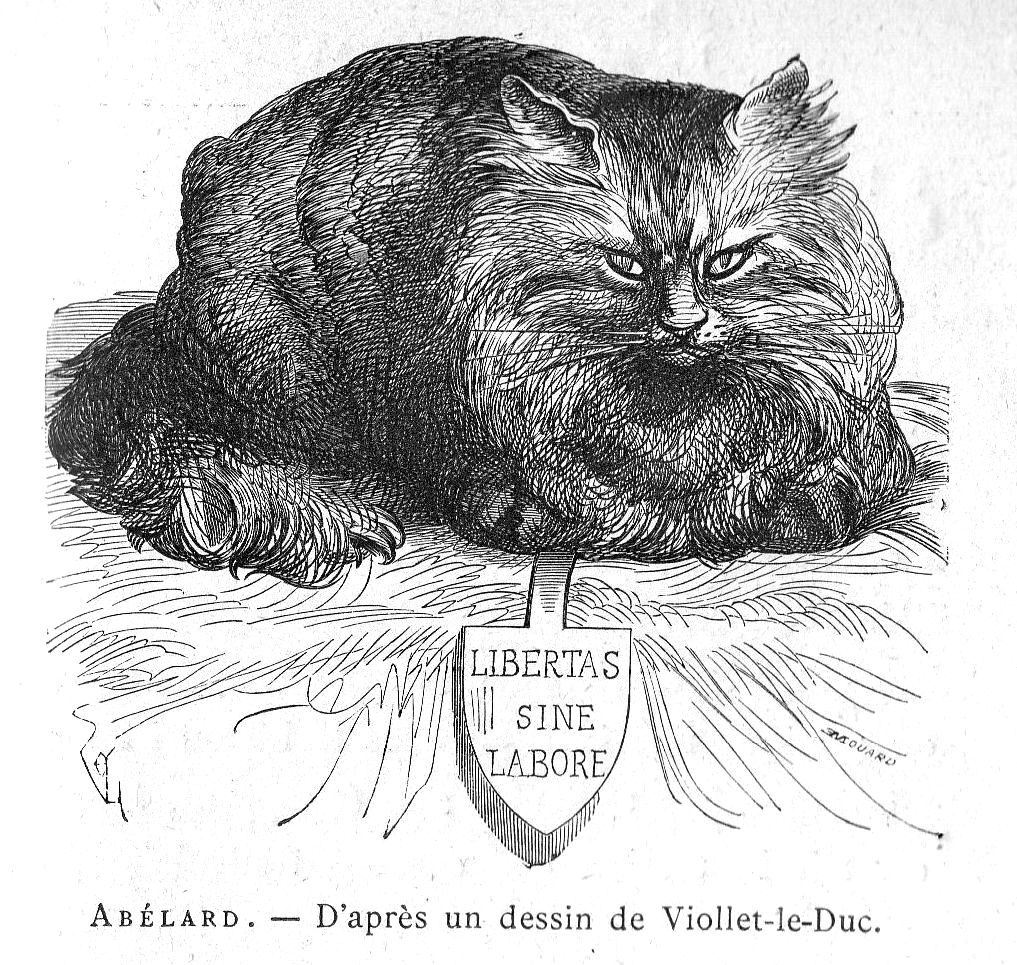
CHAPTER IX - CASTRATION.
Castration is an operation that is frequently performed on tomcats; it makes the animal more attached to the house and takes away the inclination to wander. He becomes sedentary and more affectionate, but also more lazy. His body becomes larger and he has a tendency to obesity, and his fur becomes thicker and more silky. In a word he becomes more domesticated. Some people castrate their cats for the sole purpose of ridding their urine of the persistent, unpleasant odour peculiar to tomcats.
Here is how the operation is done. It is necessary above all to take precautions to avoid the attacks of the teeth and claws of the future eunuch. The head and the front legs are brought into a bag or wrapped in a cloth so that the cat is able to breathe.
Both two hind legs must be held by one or two assistants, an incision is made with a scalpel on each side of the scrotum. The testicles emerge and with the aid of the fingers the testicular cords are twisted and the testicles are thus torn off. One could also do the section with scissors without fear of haemorrhage. The operator must protect his assistants and pay attention to himself in order to avoid the jet of urine that the patient never fails to launch during this operation. Healing takes place in a few days without causing any obvious traumatic fever.
When the operation is performed before adulthood, the heads of the castrated animals become less voluminous, their whiskers are less strong, and their claws remain less well-developed. We can see the effects of the modifications on physique and behaviour; the voice is also modified.
It would seem, if we believe the good poet Catullus Mendes, that this operation can push the cat to commit suicide in despair
"At Rue Mansard, I had a cat who was named after a character from the "Walkyrie." Mime was beautiful as a lover. He was a superb black cat who had a formidable odour and who never failed to shred my curtains. We were obliged to entrust him to a man of the art, who brought him back in a state of absolute neuter. From that day on, Mime sank into a despair darker than himself. We lived on the fifth floor. At certain times of the day, Mime used to to make a little tour on the zinc cornice which existed along the interior facade, underneath our windows. One morning I saw him - or I thought I saw him – throwing himself deliberately from this ledge into the street. When he fell he hit a street lamp that broke his back. I tell you that I still have the impression that Mime committed suicide."
Rather than suicide, was it a kind of madness that gripped Catullus Mendes’s cat following the operation he had undergone?
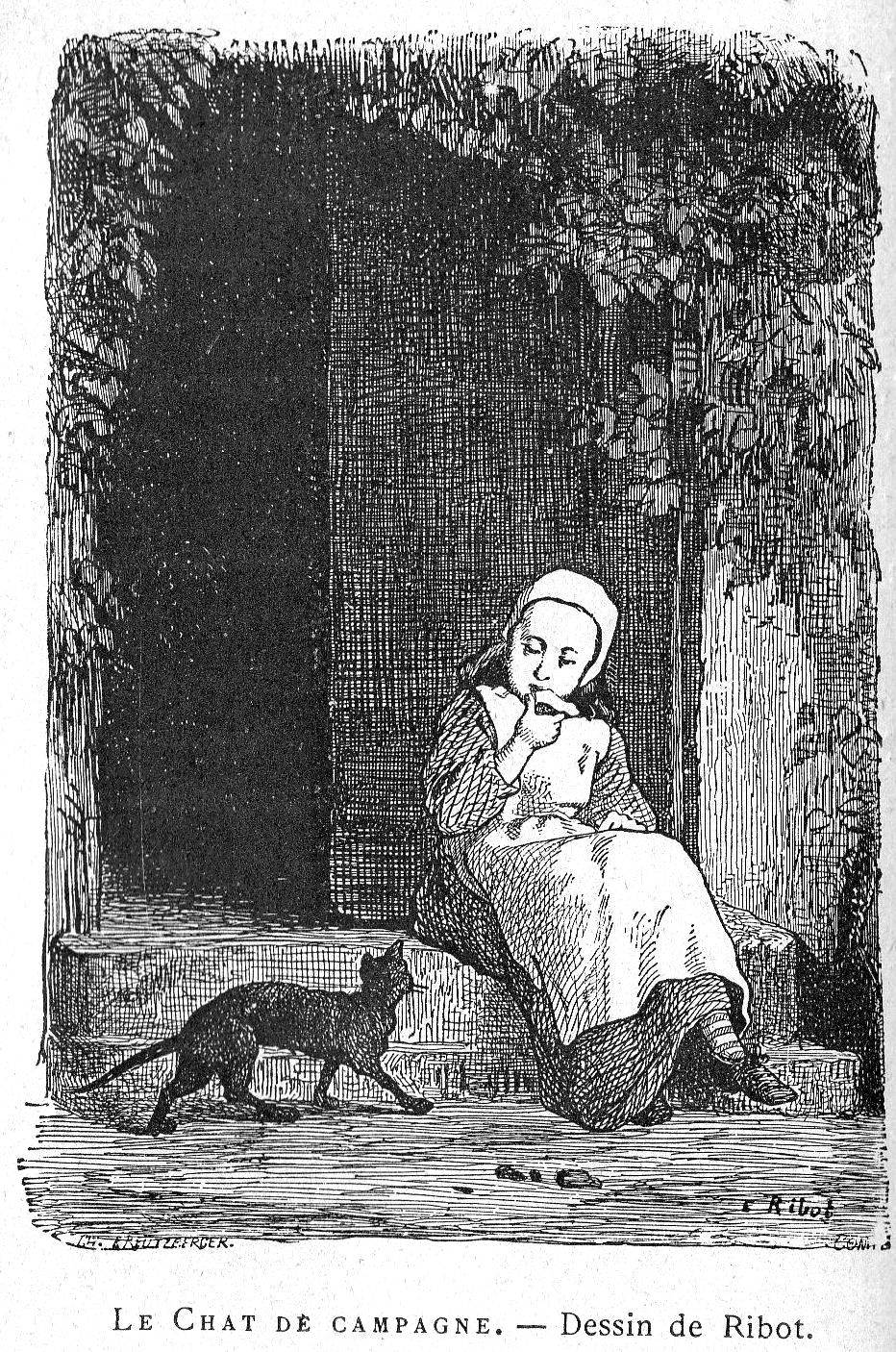
CHAPTER X - CATS IN COURT
Cats have often been involved in legal matters. Of all animals, it is certainly the cat that most occupies various civil and correctional courts. I have already mentioned the case of that brave woman who bequeathed her cat to the city of Paris. This event is not unique in the judicial annals; many legacies in France were made, in front of notaries, to cats. Such bequests have been attacked by greedy heirs who use their deceased parent’s affection for the animals as a way of suppressing the bequest by accusing the testator of madness.
One of the most curious lawsuits of the middle of this century was that brought by a brother against his sister. He wanted to have overturn the bequest "because she had the tooth of her dead cat mounted in a ring", which, according to the plaintiff, constituted a true act of insanity and imbecility. Madame Crémieux pleaded on behalf of the cat and won her case.
If the civil tribunal is transferred to the justices of the peace or correctional courts, the number of trials becomes even more considerable. One case among other in 1865 had a quite considerable impact, and was even known in court under the name of "Cats’ Case". Two contradictory judgments were rendered. Here is the case: A landowner in the neighborhood of Fontainebleau, Mr. L., seeing his property invaded by neighbourhood cats, and having used all the possible means to drive them away, ended up by talking to a forest guard, who set up traps which killed fifteen cats in a short time. Complaints were addressed to the police commissioner by the owners of the cats. Minutes were drawn up against Mr. L. and the forest guard, who were called before of Fontainebleau police court in front of Mr. Richard, the justice of the peace.
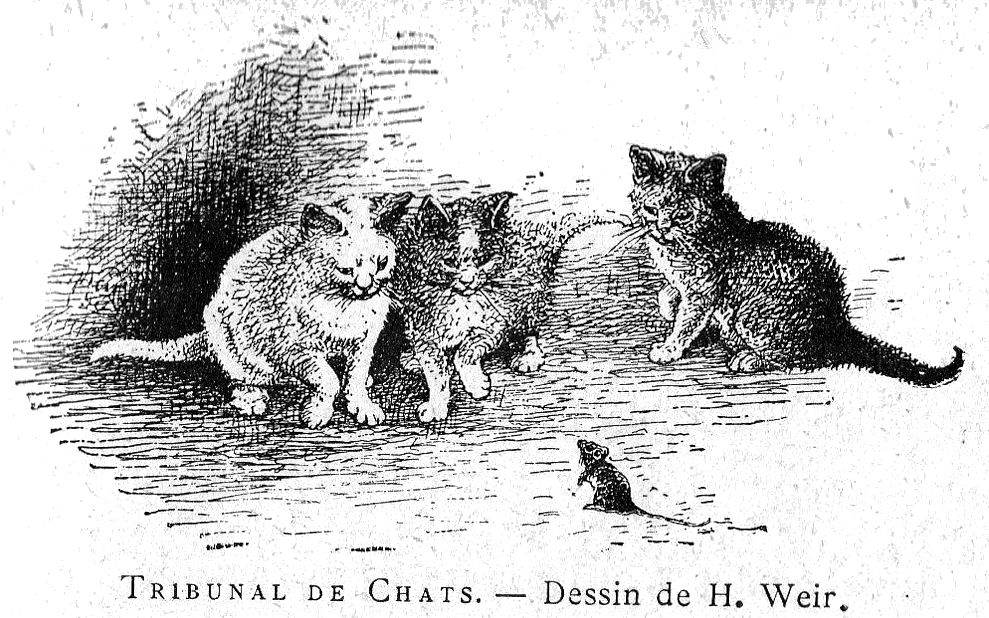
Here is a transcript of the sentence pronounced by the magistrate on 15th May, 1865:
"The Tribunal,
"Herewith the parties in their words, behaviours and conclusions;
"With regard to article 479 of the Penal Code and article 1385 of the Napoleonic Code;
"On the existence of contraventions:
"Whereas science and jurisprudence recognize several species of Cats, notably the Wild Cat, a nuisance animal for whose destruction a bounty is granted, and the Domestic Cat, a household pet like the Dog, in the eyes of the legislator;
"Whereas the domestic cat is not res nullius [an unowned thing], but is the property of a master, who has the duty, as far as possible, to supervise, and at the same time the right to protect the animal which belongs to him;
"Whereas the Cat, by its nature and instincts, escapes full-time surveillance; such that it is impossible in this respect to assimilate it to other domestic animals, docile to the bit and to the yoke, or easily deprived of the liberty of going or coming;
"Whereas the Cat, notwithstanding the little sympathy which it inspires, on account of his character and the inconveniences to which his presence exposes us, is none the less of unquestionable utility, destined to purge not only the dwellings, but also the adjoining lands, of dangerous and inconvenient rodents; that the services rendered do not stop at the residence of his master, and that it is therefore very equitable to have leniency for an animal tolerated by the law and useful to all, either directly or indirectly;
"Whereas the Cat, even a domestic, is in some sort of a mixed nature, that is to say, an animal that is always a little wild, and having to remain so by reason of its very purpose, so that he can render the services expected of him;
"Then for this reason the greatest discretion should be left to the judge in the assessment of alleged faults, which, more often than not, are attributable only to the carelessness or even negligence of those who complain. Man has his reasoning and experience to protect himself, if not against any damage, at least against the larcenies of the Cat,;
"Whereas the house of Mr. E is closed by a doorway of iron, the bars of which are spaced 9cm apart with a base of only 55cm;
"That this door thus offers an easy passage, and perhaps only during the night, in the neighborhood, to any cat continuing along the street, and that failing to repress the murders and mutilations of Cats, under the circumstances in which they were produced, could result in undesirable consequences in more than one way;
"Whereas the law does not want us to do justice ourselves;
"That article 1585 of the Napoleonic Code grants an action for damages to the injured party so that he may sue through the courts for compensation for the damage he has suffered;
"That, finally, if the law of 1791, Title XI, Article 12, permits, in effect, the killing of birds, the attempt to put the cat in the same category as poultry is not correct since poultry are destined to be killed sooner or later, and in the main they are held sub custodia in a restricted and completely closed place, while the same cannot be said of the Cat, no can he be kept under lock and key if he is to obey the law of his nature;
"Moreover, the law of September 28th, 1791, requires a concurrence of conditions which are lacking in the present case, in particular the flagrante delicto [caught in the act], and that, finally, this being strictly criminal law, it is impossible to reason by analogy and to apply to the urban police, as a result of a benevolent but dangerous interpretation of the provisions of a law entitled the Rural Code of 1791;
"Whereas, if the defence holds that the Cat-killing took place in consequence of an imperious necessity, this obligation has yet to be proved, for neither larceny, damage, flagrante delicto, nor anything that would constitute a case of self-defence or force majeure, with respect to a particular Cat, has been established all;
"Whereas arguments based on common sense, fairness or necessity must never lead the judge to lose sight of the fact that in any litigation, no matter how small, its sole task is to state the law and apply it, especially in the presence of the clear and formal text of article 479 of the Criminal Code;
"Whereas the arguments drawn from the observations of the Council of Cambaceres at the Council of State, notwithstanding the great authority which always attaches to such a celebrated name, are never the expression of individual opinion, albiet a very respectable opinion, but an opinion without force of law;
"That, besides, the alleged right to kill, in certain cases, the Dog, an animal dangerous and quick to attack without provocation, cannot, by consequence, give one the right to kill the Cat, an animal quick to act and one which is certainly not of a nature to cause fear;
"Whereas evidence of any alleged damage is incumbent on the complainant, and despite of the difficulty of proving such matters, and quite separate from the injury caused, nothing in law allowed the accused to lay down traps, especially after the fact, in such a manner as to attract, by the confession of the accused, innocent cats from the whole neighbourhood as much as guilty Cats;
"Whereas, at last, no one ought to do something to another’s property that he would not wish done to his own property; that all the goods, according to Article 516 of the Napoleonic Code, being either movable or immovable, the result is that the Cat, in accordance with Article 528 of the same Code, is undoubtedly a piece of furniture protected by this law and others, and that consequently the facts complained of fall directly under the application of Article 479, sub-section 1, of the Penal Code, which punishes those who have voluntarily caused damage to the property of others;
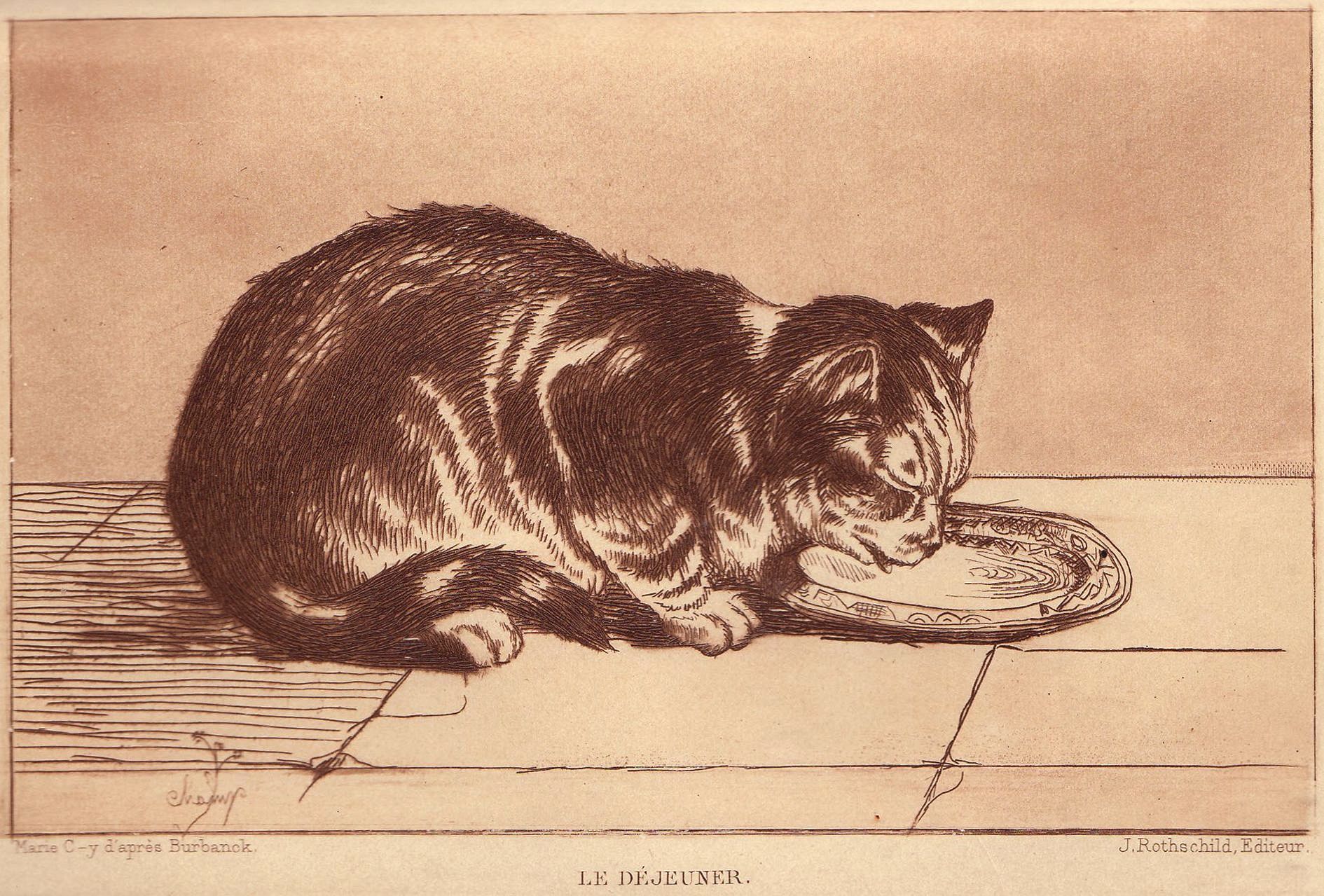
"As for Ranger G ...:
"Whereas G acknowledged having participated in the destruction of the Cats, in executing, he said, an order of M. Inspector of Forests; but, since the proof of this assertion has not been made; and that, besides, even if he had proved it, a subordinate is not bound to blindly obey an order given outside of authority, especially when this order does not have, and evidently cannot have, the authority of a council;
"Whereas, finally, in the matter of contravention, the law does not recognize any complicity, and therefore the accused G is solely responsible to answer for his acts and gestures;
"Whereas G ... further stated at the first hearing that he had set traps in Mr. E's garden ... for the purpose of taking Cats, traps which he said had cut off their legs and muzzles in order to claim a bounty, in view of the impossibility of being able to distinguish whether the legs of the animal thus mutilated came from a Domestic Cat or a Wild Cat;
"As regards the accused, female B ..., a domestic servant:
"If obedience is the first duty of a subordinate, it is none the less true that a servant, whatever he may be, is not a completely passive being, who must inevitably submit to any comman that it please his master to give him, whether right or wrong;
"Whereas it is impossible to argue that, by slaying with a hammer the Cats caught in the traps, the accused B obeyed a force majeure which she could not resist;
"That guilt is aggravated by the plurality of executions of this kind;
"Regarding the accused woman E ...:
"Whereas it appears from the circumstances of the case that it has not acted ab irato [in anger], but on the contrary has taken a direct part in the destruction of the Cats with a rigour which has not been the effect of a single instant;
"With regard to the accused E ...:
"Whereas he acknowledged at the first hearing, that his house being gravely inconvenienced by the Cats, one had the right to act as they had done;
"Whereas today he even admits to having taken a direct part in the destruction of the Cats, six in number, while the ranger G. only recognizes three contraventions to his charge, while the servant B. declared that he had killed seven Cats, and that the Public Prosecution recorded fifteen contraventions of the same kind;
"Whereas the contraventions attributable to G ... are six, according to the very statement of Mr. E ... and that seven contraventions, with respect to the other three indictees, remain alone perfectly established by the very statement of the accused B ...;
"As for B, the husband of the accused:
"Whereas under section 7 (II) of the Act of 6 October 1791 the husband is civilly liable for the offenses committed by his wife, this provision is special to the rural police and, in consequence, does not apply by extension to the urban police;
"Whereas, moreover, if the husband is not, as a general rule, civilly liable for the offenses and quasi-offenses of his wife, not being presumed to have given her a mandate to delinquency, the same rule must certainly apply to contraventions committed by the wife, apart from any pecuniary interest appreciable for the husband, and moreover without his fault and without his knowledge;
"With respect to cumulation of penalties:
"Whereas the system of cumulation of penalties, as regards contraventions, is accepted by the legal system; that this system is rational and equitable; that it is also inscribed in the law of 22 March 1841, article 12, and in that of 17 March 1850, article 8;
"But, whereasm after all, that the public prosecutor was the first to insist on the admission of extenuating circumstances on the part of the judge, in accordance with the provisions of Article 483, in brief, and 463 the Criminal Code;
"Whereas, finally, the unsuccessful party must be condemned to bear the expense of the proceedings;
"For these reasons,
"Judging in the presence of all parties involved, and as a last resort,
"Dismisses B ..., husband of accused B ..., of the prosecution against him, as civilly liable, and relieves the four accused in question of eight contraventions out of fifteen; but detains them for seven, where they were the co-authors of the contraventions, with the exception of a single offense against the discharge of the accused G, who did not take part in it,
"And condemns the defendants not jointly and severally, but by body (articles 56 and 467 of the Penal Code), namely:
"Firstly, the forest ranger G ..., with a fine of 1 franc for each contravention, to a number of six;
"Secondly, the servant B ..., with a fine of 1 franc for each contravention to the number of seven;
"Thirdly, the accused husband and wife E ..., with a fine of 1 franc each for each violation, seven in number;
"Fourthly, and finally, all the accused, jointly and severally, for all costs of the proceedings. "
"Whereas under section 7 (II) of the Act of 6 October 1791 the husband is civilly liable for the offenses committed by his wife, this provision is special to the rural police and, in consequence, does not apply by extension to the urban police;
"Whereas, moreover, if the husband is not, as a general rule, civilly liable for the offenses and quasi-offenses of his wife, not being presumed to have given her a mandate to delinquency, the same rule must certainly apply to contraventions committed by the wife, apart from any pecuniary interest appreciable for the husband, and moreover without his fault and without his knowledge;
"With respect to cumulation of penalties:
"Whereas the system of cumulation of penalties, as regards contraventions, is accepted by the legal system; that this system is rational and equitable; that it is also inscribed in the law of 22 March 1841, article 12, and in that of 17 March 1850, article 8;
"But, whereasm after all, that the public prosecutor was the first to insist on the admission of extenuating circumstances on the part of the judge, in accordance with the provisions of Article 483, in brief, and 463 the Criminal Code;
"Whereas, finally, the unsuccessful party must be condemned to bear the expense of the proceedings;
"For these reasons,
"Judging in the presence of all parties involved, and as a last resort,
"Dismisses B ..., husband of accused B ..., of the prosecution against him, as civilly liable, and relieves the four accused in question of eight contraventions out of fifteen; but detains them for seven, where they were the co-authors of the contraventions, with the exception of a single offense against the discharge of the accused G, who did not take part in it,
"And condemns the defendants not jointly and severally, but by body (articles 56 and 467 of the Penal Code), namely:
"Firstly, the forest ranger G ..., with a fine of 1 franc for each contravention, to a number of six;
"Secondly, the servant B ..., with a fine of 1 franc for each contravention to the number of seven;
"Thirdly, the accused husband and wife E ..., with a fine of 1 franc each for each violation, seven in number;
"Fourthly, and finally, all the accused, jointly and severally, for all costs of the proceedings. "
This case of Cats gave rise to an appeal gainst the sentence of the police court, as we find mentioned in the newspaper "Le Droit," which gave an account of the hearing of 25 August 1865. Here are the terms in which he relates in his columns the reversal of the judgment:
"Our readers have not forgotten the sentence of May 15, by which the Justice of the Peace of Fontainebleau condemned four persons of that city to fines for the murder of seven Cats.
"This judgment was appealed by the convicted parties.
"Georges Lechevalier, of the Paris Bar, their lawyer, after paying tribute to the learned Justice of the Peace, who, with regard to a question which appeared to be of little importance, found means of recalling all the great principles of law and social order, recounted the facts on which the trial took place.
"At the beginning of this year, M. and Mme. Escalonne saw their garden become the rendezvous of all the neighboring Cats. One day one of them carried away the thigh of a roe deer; the next day an ornamental tree was broken; and finally every night became an infernal din, and M. Escalonne could say, like Boileau:
And what an annoying demon, the whole nights through,
Gathers together cats from all the gutters in this place.
"What to do? The neighbors were informed, those to whom ownership of the devastating animals was ascribed, by asking them to keep the night-prowlers at home a bit more; but the visits of those indefatigable dissolutes continued.
"It is necessary to advise: some traps were placed; six or seven Cats were taken or killed. Right away there was a public stir, a general hue and cry of M. Escalonne’s neighbours against this murderer of the companions of their solitary old age:
And the number of Cats, in the retelling,
Grew from mouth to mouth,
And before the end of the day,
It was more than a hundred.
"It was in these circumstances that the prosecutor of the police commission and the sentence of the Justice of the Peace intervened.
"The attorney read this judgment and found that never, without even the exception of ‘The History of Cats’ by Sieur Moncrif of the French Academy, has the legal position and the social importance of these interesting animals been so compendiously exposed. "
"In entering into the discussion, the lawyer says that if the Justice of the Peace had not so scornfully rejected in a judgment ‘arguments drawn from common sense,’ he would have merely recalled what, in a similar process, Racine causes his Little Jen of the Litigants to say:
As for me I don’t know how to do so much
As to say that a mastiff has just taken a capon.
There is nothing your dog does not take;
And here he has eaten a fat capon of Maine;
And the first time I catch him doing it,
His trial is finished, and I'll knock him out!
"But, to the Justice of the Peace, common sense being of no value to resolve this question, it was necessary to examine it more closely.
"Escalonne evidently had the right to defend his property against these destructive agents. What could he do? In the past he might have put the animals themselves on trial, and might appeal to use to spiritual weapons against them, as did the inhabitants of the bishopric of Autun in 1522, according to the president of Thou, when they solicited and obtained a sentence of excommunication against all the rats. But this is no longer possible, and history does not tell us whether it is effective.
"What could they do? Pursue lawsuit to the owners of the Cats, as the Justice of the Peace indicates? But they would have to know who the owners were, and first of all would have to establish the identity of the Cats. Now, according to the proverb, at night all cats are grey, making identification a difficult matter. Therefore, there remained only the means employed.
"But is the cat, ‘that unfaithful servant,’ as Buffon calls it, really worthy of all the interest shown by the Justice of the Peace? According to Toussenel, it seems that Cats do not fulfill their social mission very scrupulously; the spiritual writer tells us that he attended the spectacle ‘of a group of Cats and Rats on friendly terms, fraternizing at the expense of man, and shamelessly sharing the entrails of young pigeons and cabbage-eating rabbits.’
"And M. Toussenel added that for his part, ‘he never encountered a marauding Cat in the woods or in the plain, without doiong the honour of shooting it.’ Well! M. Escalonne has only surrendered himself to that destruction of Cats, in which M. Toussenel gloried to contribute as much as possible, but M. Escalonne was constrained by necessity and therefore he can not be condemned.
"Imperial Procurator Delapalme referred to the wisdom of the Tribunal, which ruled as follows:
"The Tribunal,
"Whereas it is an established fact that Escalonne tasked Grossac with placing traps in his garden;
"And besides, it is certain that several Cats were caught in those traps and killed;
"But whereas the witness Berger, a gardener who maintains Escalonne’s garden, testified before the trial judge, as is apparent from the notes of the hearing, that he had found damage to the garden plants and flowers, damage caused by the Cats, and he finally added that ornamental trees in the garden were damaged by these animals;
"That from then on Escalonne found it necessary to take measures to defend his property;
"Moreover, Article 479 of the Penal Code punishes only those who have wilfully damaged the movable property of others, and that, consequently, there is nothing to established who owned the animals destroyed, or even if they were owned by someone, so it follows that that article cannot be applicable;
"I pronounce that he was misjudged, his appeal is valid, and I annul the verdict on appeal;
"Sentence quashed:
"Appellants are discharged from all convictions against them."
Hunters will always share the opinion of Scheffer and Toussenel: it is necessary to destroy cats as they are the worst of the poachers. I asked the following question of a friend of mine, a learned man in the field of hunting rights, Mr. Valadon, legal editor of the newspaper "L'Eleveur:" "If a farm cat who abandons his master’s home and goes hunting in the fields, can it be destroyed by the guard of the property whose game he destroys?" After having quoted me the two contradictory judgments that I have just given, he added:
"When I spoke about the need to protect game and enforce the right to hunt, I have demonstrated that as pets they can only be destroyed in cases of self-defense.
"As far as the cat is concerned, the owner of hunting rights is not bound by the same considerations, because of the cat’s independent nature which makes him a commensal rather than a real domestic animal. His nature easily gets the upper hand and if he leaves the dwelling of his master temporally or permanently to indulge his carnivorous instincts, he is no more than a wild animal, a beast, a ravager that does not deserve any more protection than other evil and harmful predators.
"If, in spite of the above considerations, the owner of a cat wished to argue that it was a domestic animal and draw up a ticket against the author of its death, on the basis of Article 479, paragraph 3 of the Penal Code, which prohibits the injuring or killing of animals belonging to others, and consequently claiming damages, it would first be necessary to prove ownership of the animal [Court of the Seine. Judgment due August 1, 1865]. He then exposes himself to a claim of damages, possibly quite considerable, because, under the terms of Article 1385 of the Civil Code, he is responsible for damage caused in the fields or the woods by his straying or escaped animal (here the cat). Not because game animals can be considered as a property, but because the HUNTING RIGHT is one of the most real appurtenances of the property and this disappears when the game animals are exterminated by the cats. ["You are not," says Jullemier, quite rightly (page 13, "Hunting Trials"), "the owner of the game that wanders in your fields and in your woods, but you have on this game a prospective right, a right of custody, and as long as it stays on your land, you can prevent it from being killed or taken."]
The police courts of Argenteuil (judgment of January 12, 1886), Poitiers (judgment of March 24, 1887), Rambouillet (March 3, 1866) and another judgment indicated by our colleague Lajoye confirm this theory that if harm exists and it is necessary to stop the damage then it is lawful to destroy wandering cats. [Compare: judgments, cassation, December 17, 1864 - November 17, 1865 - March 7, 1868 - July 7, 1871.]
Mr. Villequez, Lieutenant of the Louveterie [Wolf-hunting officers], dean of the Faculty of Law at Dijon, also affirms the right to destroy harmful or harmful animals. - Seventh edition.]:
"Cats that have strayed from farms and villages also do great damage. Those who have lost the inclination to return, and who no longer belong to anyone, can be shot without scruple and without it being an offence. I have often encountered them in the woods and a long way from homes. For a long time I refrained from shooting them; but since I had chanced to see the work one of them was doing in the midst of a company of young partridges, my scruples have considerably weakened. I began with that one, from whom I took back his partridge, and he has been followed by many others since then."
Neither that eminent author nor jurisprudence has affirmed that one can kill all cats found in the fields at a short distance from towns and villages; but those caught in the act of stealing, or even simply confirmed to wander frequently, can be slain.
It is needless to add that the rifle must bring prompt justice to those who live in the woods and who have become quite wild, a large number of prefectural decrees authorize their destruction, even without a hunting permit.
I record Mr. Valadon's statements without comment.
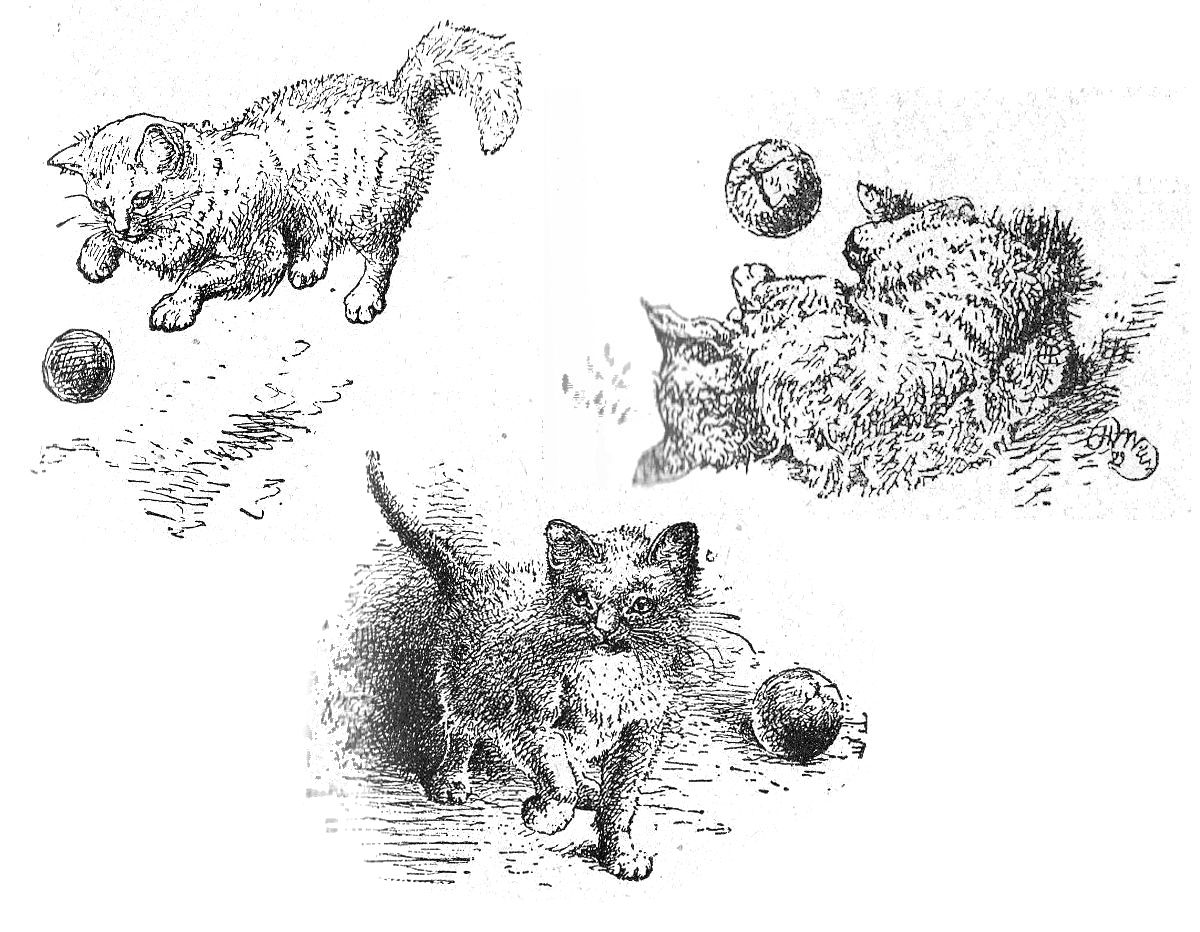
CHAPTER XI – CAT SHOWS
In France most of the domestic animals which we honour with our respect and friendship are endowed with special clubs which devote themselves to their advancement, take care of their interests, defend them against all comers, sponsor them in the newspapers, and periodically erect altars and pedestals in the form of exhibitions which enthusiasts never miss. Until 1896 the cat was an exception, although the canary had attracted the united forces of his admirers into a strong group. The honour of organising the first real feline exhibition in France belongs to Fernand Xau, director of the Journal, and to M. Porte, director of the Zoological Gardens of the Bois de Boulogne.
Every year since 1871, a feline exhibition has taken place at the Crystal Palace in London. The first was at the instigation of the painter Harrison Weir, who single-handedly drew up the rules for judging cats, and those regulations are still in use on that side of the strait. Following the 1871 cat show, the assembled fans created the English Cat Club, which is one of the most successful specialist clubs in England.
In Holland, the first cat show dates from 1890 and in Belgium from 1891. Here is what a newspaper from Brussels, "Chasse et Pêche," [Hunting and Fishing] reported on that exhibition:
"The first cat show, organized by the Cat-Club, was incredibly successful as a curiosity to the point of causing coach congestion in front of the "Modern Salons" of the Flemish Brewery. Many cat lovers who have beautiful cats have again refrained, hesitating, not knowing exactly what the judges want. Now they are able to fix on the direction to take in breeding, on which offspring to choose from the litters that arrive due to fortuitous encounters on the roof gutters. Soon, perhaps, they will decide not to leave these liaisons to the whims of dark nights, which, as the saying goes, are favourable for producing grey cats.
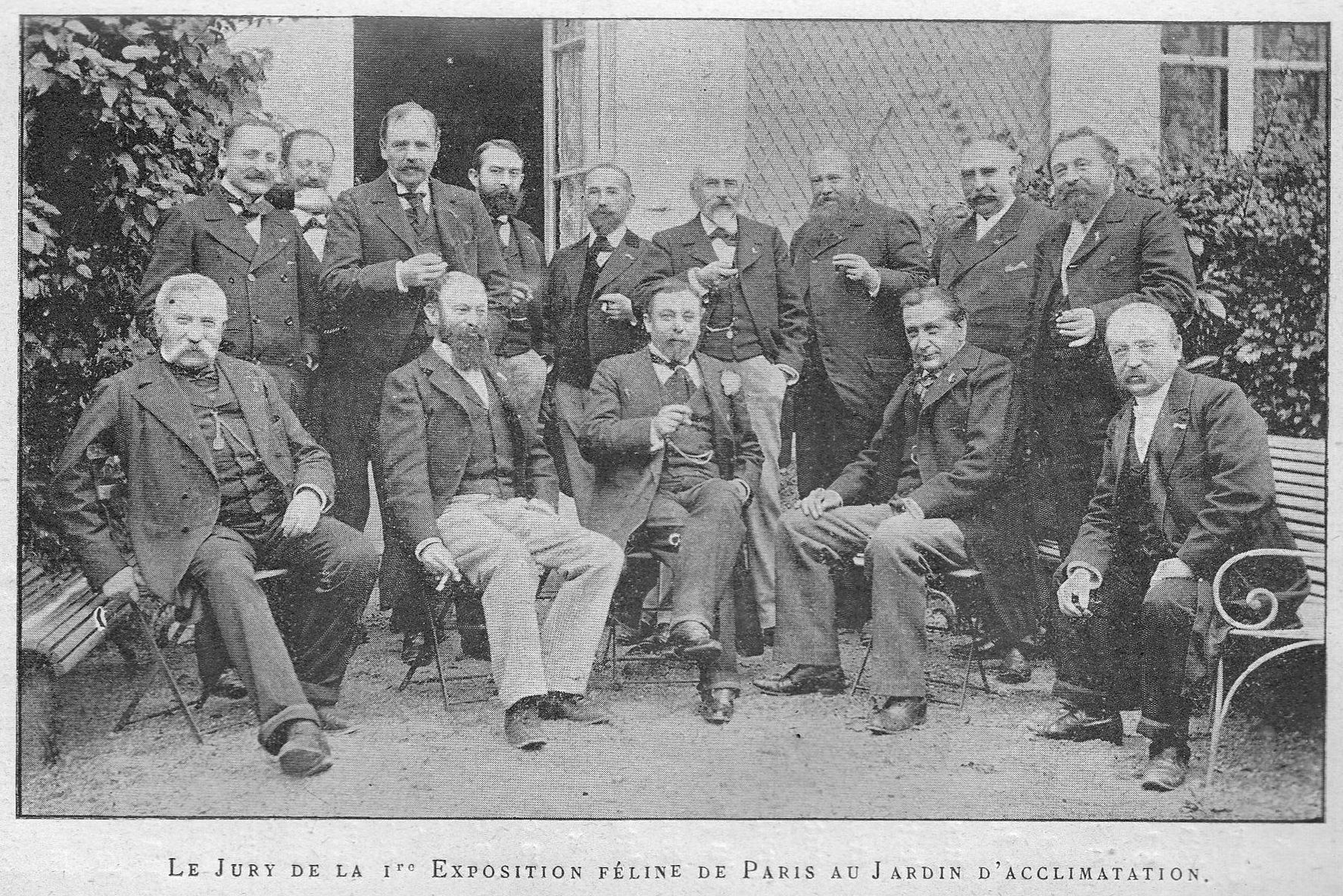
"Judges like variety in colours, but their requirements are limited. Cats with short hair should be regularly marked, striped, banded or mottled, and the markings should contrast with the background colour. If the cats have spots, they must be regular; if they are solid coloured, not only must they be free of any white hairs, they must be a uniform hue all over the body.
"Among the long-haired cats, alas, we did not find our ideal, but there was an astonishing volume; the well-known Café Riche cat was eclipsed by a 15 kilo tomcat, which the judges awarded a special prize. The giant rabbit of Flanders is exceeded by a hundred cubits. Long-haired cats should be judged on the length and richness of the coats, with less regard given to the markings. Unfortunately, we are at the beginning of winter, in other words it is moulting time, and if only we could revisit in three months those specimens which, at the moment, are bereft of mane, inner-ear tufts, long fur on the back and legs, not to mention the plumy tail, then first prize winner might perhaps be placed last, and the modest ones mentioned might become the laureates.
"Exhibitors still have a lot to learn, but so do the organisers. Thus, if there had been a class for tricolour cats i.e. white, black and red, which are quite abundant in the country, there would be no shortage of registrations as happened this time. Tortoiseshell cats were also conspicuous by their absence, but in the class established for them was four-coloured cat - white, red, gray and black – which was awarded second prize for the originality of its markings. Noteworthy among the kittens was a superb specimen who was raised in England, by the name of Abelard, who was well-striped and very dark. There are those whose baptism brings bad luck, otherwise Abelard would have featured with honour at the head of intact males."
As for the Paris show organized by the Journal, at the Zoological Garden, it was, we may say, a remarkable success: more than four hundred cats were exhibited, and, as for visitors, on the last day we counted fifty thousand entries into the Garden!
It must also be said that it was an innovation, being the first exhibition of its kind in Paris. Plus the setting was wonderful, and as one of the judges, Mr. Lhoest, the friendly director of the Zoological Garden of Antwerp, said: "If the Palmarium of the Zoological Garden was located closer to the centre of Paris, no city in the world could hold anything like it." The elegant cages that housed the cats were in the middle of a real tropical garden. Mr Porte himself, the amiable director of the Zoological Garden, presided over the installation of his temporary guests with his usual solicitude.
The composition of the jury was truly exceptional: Mr F. Coppée, of the French Academy; Mr Catulle Mendes, Mr A. Theuriet, Mr A. Sylvestre, Mr O. Mirbeau, Mr E. Lambert, Deschaumes, Mr A. Porte, Director of the Zoological Garden, Mr Lhoëst, director of the Zoological Garden of Antwerp; Mr Pierre Mégnin, of the Academy of Medicine; the artist Steinlein and Mr Maurice Vaucaire.
What caught the visitors’ attention was the category of foreign cats and wild cats. In this category were felines that may not have been true cats, including a Serval, a really fierce animal that it would have been dangerous to stroke; moreover, he warned away the world with his characteristic hissing. On the other hand, in the same category there was a small Cayenne Leopard, presented by Miss Dufresne, and this was gentle, affectionate and playful like a real cat.
The foreign domestic cats were mostly represented by Siamese cats, about ten in number, so pretty with their pale coffee coloured coat and black muzzle, ears, legs and tail. This category should have been completely separate from the others; because Madame Waldeck-Rousseau’s pretty Siamese family comprising father, mother and the little ones would have had gained first prize, but they only got a second prize because Miss Dufresne’s little leopard took first prize!
Among the native cats, all Parisians, most of them were neutered cats which, due to this operation, had generally attained colossal sizes. It is one of those cats, a beautiful Angora it is true, who had the first grand prize of honour; the second grand prize was awarded to a beautiful tabby entire male, a true model of conformation and colour, and in our opinion, he should have had first prize because the breeding cats must always be placed ahead of the eunuchs in a show aimed at encouraging the production of beautiful breeds.
Many owners of beautiful cats had abstained, hesitant, not knowing exactly what the judges were looking for. Now they are able to fix on the direction to take in breeding, which offspring to choose from the litters resulting from random encounters on the eaves.
Thus the Paris cat Show was founded; it is now held regularly every year. The first show, despite the speed with which it was organized, succeeded very brilliantly.
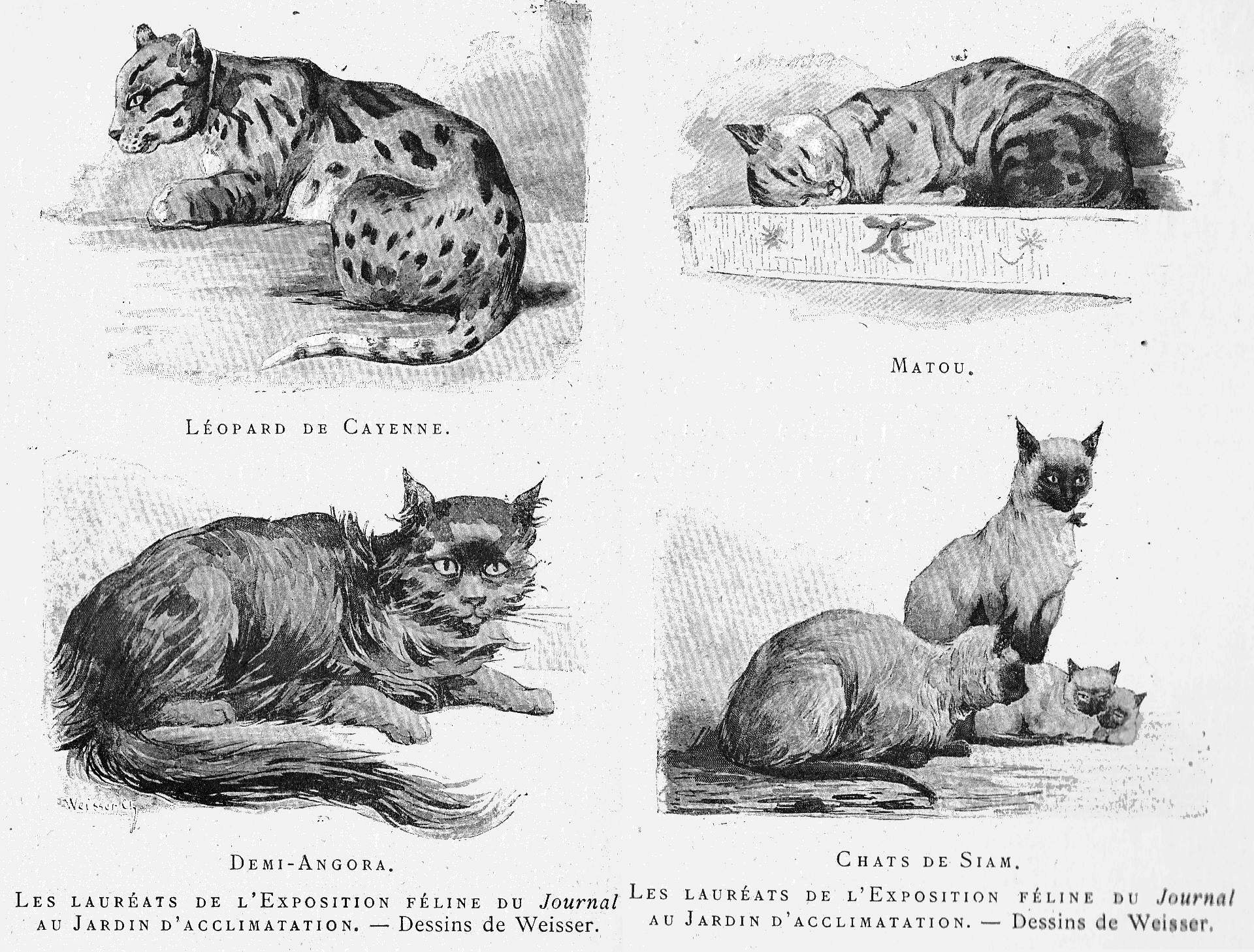
The winning cat owners at the first cat show in Paris were:
First Grand Prize of Honour, Mr. Lésy.
Second Grand Prize of Honour, Mr. Khil.
Grand Prize offered by the Zoological Garden - Gold Medal, Grand Module [25 centimes], Mr. Weil.
Special prize awarded to the best domesticated cat, offered by Mr. Vadon. - Miss Dufresne.
It remains for us to hope that we will not stop on this good path. Now that cat shows are held every year in Paris, cat lovers will be able to get together and found not just a society for the improvement of cat breeds, but at least one club for French cat lovers. Similar societies have existed for several years in England, Belgium, and Holland, where they are flourishing.
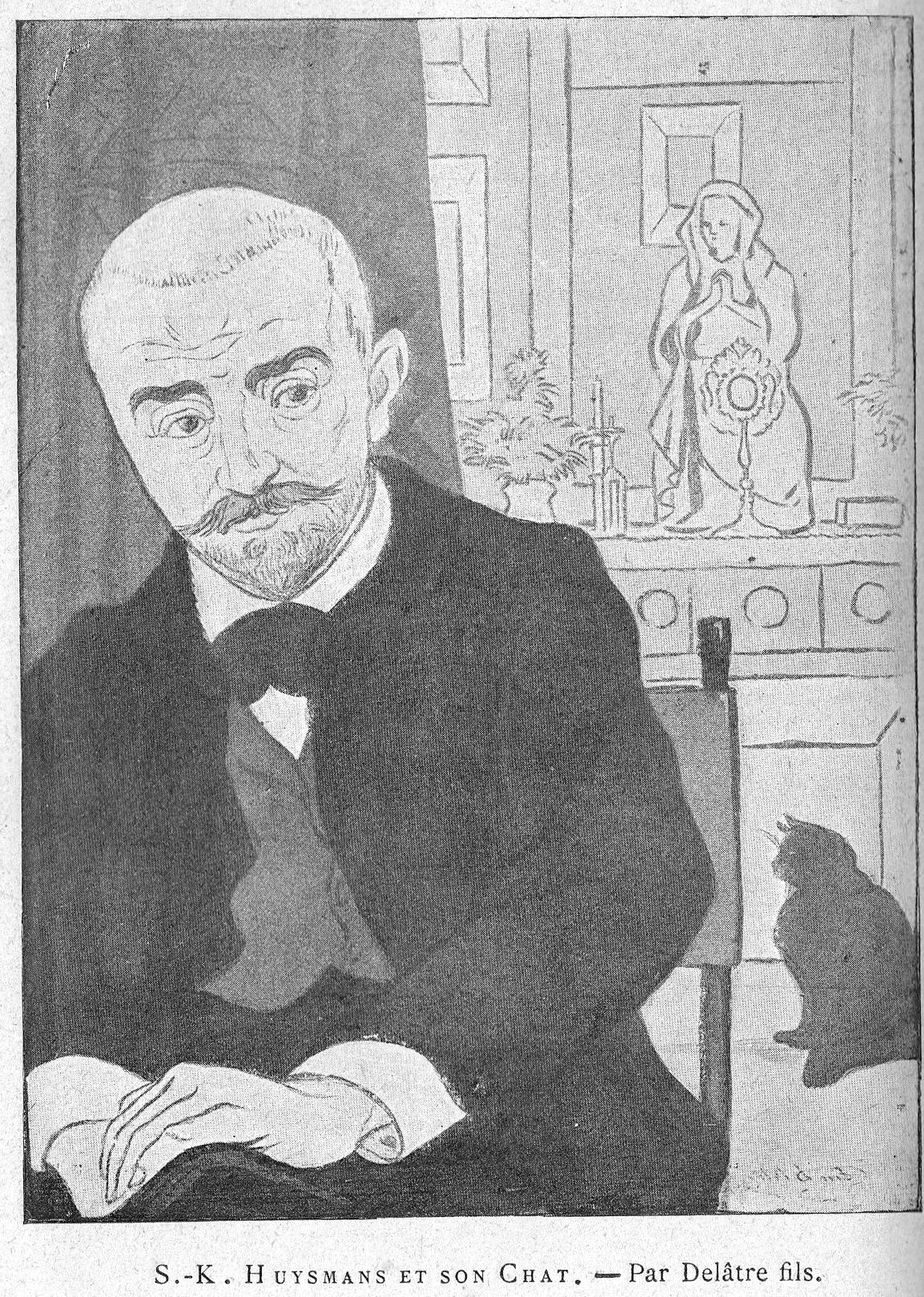
CHAPTER XII - CONCLUSION
By way of a conclusion to this work, in which I have tried to rehabilitate our friend the Cat a little, while hoping to interest cat lovers, guiding them, explaining what is so charming about this animal, I have to say that I can do no better than to quote the various opinions communicated to me by some of our contemporaries, who are great friends of our friend the cat.
Master Emile Zola likes all animals; as for cats, he adores them.
Interviewed by one of my colleagues [G. Docquois, "Beasts and People and Letters"], he told her, "I began by putting two in the "New Stories to Ninon" - a white cat and a black cat. In the foyer of the Bordenaire theatre in Nana, there is a big red cat who does not like the smell of the varnish with which the old comic Bosc coats his cheeks to stick on a false beard. In the "Error of Father Mouret," there is a trio of cats. One of them, all black, is called Moumou. These three are rustic cats, as I have in Medan. There is also Francois, the enigmatic tomcat of Thérèse Raquin, wit his hard, ironic and cruel look, and diabolical stare. And then, oh! and then, my favourite, Minouche with her joie de vivre; a little white cat with a delicate air, whose tail, at the sight of mud, trembles in disgust, which does not prevent this creature from wallowing four times a year in the filthy streams.
"Cats were always my favourites, I have a whole group of them in Medan ..."
François Coppée, the sweet and illustrious poet of "The Humble" and "The Intimacies," has cats by the dozen, "These are real dynasties as in ancient Egypt. The oldest of the three remaining with us is called Bourget - it is not, believe it, an irreverence with regard to the author of "Cruel Enigma" - Bourget. Zeze, in "The Intimacies," is a big black cat scrawny with old age, he is the Chevreul of the species, being more than twenty years old, which is a great age for a cat. See that his ears are in tatters because Bourget has fought a lot and has hunted many birds despite being castrated cut.
[Note: Michel Eugène Chevreul was a French chemist who lived to 102 years old.]
"Now here is Loulou, a big Angora as furry as a religious man’s sleeve. He is rather small, and what is pecular about him is that he runs on his legs like the bulls of the Camargue. On this subject I consulted scientists in feline matters and have been told that he comes from a very pure and special race, perhaps a Portuguese Angora. Loti saw Persian cats in Mahe similar to my little Loulou, but two or three times his size.
"As for my third commensal, it is a common cat named Mistigris, and is remarkable for ... its excessive appetite." [G. Docquois, "Beasts and People and letters."].
Since then, Francois Coppée has had other household cats, including a Siamese.
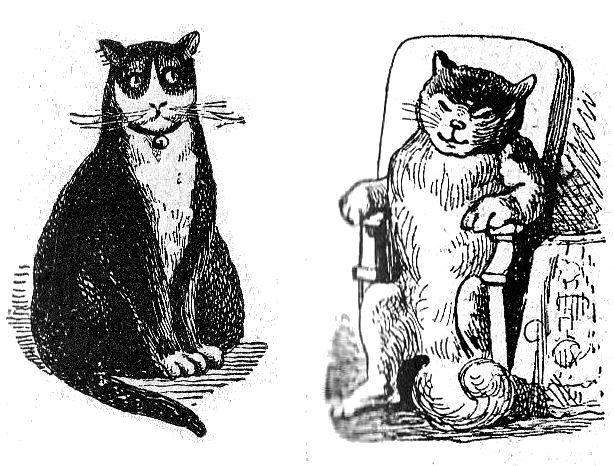
Catulle Mendes loves cats for their unique beauty; apart from this admiration for them, he does not devote any affection to them. Although having always considered the cat a bad animal, he loves them and even grants them certain privileges, thus he possessed two cats, Faffner and Fasoll, who dined at his table.
The cat is Pierre Loti’s favourite animal; he thinks it is an adorable beast, elegant, distinguished, deeply pensive and exquisite to touch and look at. For him, the cat is endowed with perfect reasoning. The account he gave of the life of his various "moumouttes" provides many examples. The parallel stories, especially of Madame Moumoutte Blanche and Madame Moumoutte Chinoise, are touching to the last degree. One with her rich Breton fur, the other derisively dressed in her poor threadbare coat of a needy Chinese woman, such a poor coat that you can see her skin in places, these two form a singular contrast ... But I do not want to recount Pierre Loti’s touching story of these two pussycats. Let our readers refer to a pound of "Mercy and Death."
I would like to give portraits of Mr Pierre Loti’s cats, but unfortunately those independent creaturess have absolutely refused to pose in front of a camera. I will have to content myself with the description made by the master himself, who sent it to me, accompanied by this charming appreciation of the Cats:
"Their intelligence at least equals or surpasses that of dogs, and, moreover, they have never the triviality, the obsequious submission, or the ridiculous importance of dogs. They are small patrician souls in small elegant bodies, but are skittish, not disposed to vulgarity, penetrable only for certain initiates of their choice.
"Capricious, and frequently distracted, they are absorbed in reveries and do not always deign to listen to us. They are capable of deep and exclusive tenderness, but if something offends them they take a long time to forgive.
"My cats? Here they are:
"Firstly, ‘The Cat,’ - he does not have a name. He is the Cat par excellence, and is called "The Cat", just as the Romans said ‘Urles’. A 4-year-old Siamese, rosy otter colour with turquoise eyes, and with tail, gloves, ears and nose of black velvet (we will find similar ones in the Zoological garden). Superior intelligence and extraordinary memory. Capricious, a bit unbalanced. Very lordly. Affectionate and cuddly to excess, holds long speeches to me.
"Secondly, Belaud. – a young gutter cat. Two years. Grey spotted with white belly. Also very affectionate. Childish and without embarrassment. Does not have the distinction of the previous one. Outbursts of melancholy, during which he comes to tell me things in a small plaintive voice. Provenance unknown. One day, he was found meowing in a corridor, very small, barely weaned. And he did not want to leave.
"Thirdly, Ratonne. - Old gutter she-cat; white belly, with a black cap, cloak and tail. About two years ago, already elderly, she came to ask for alms, with a voice that broke the heart. She was thin, pitiful, dying. Welcomed with charity, she did not want to go away and became our house cat. Remained discreet, fearful, allowing herself to be caressed only by me, looking at me with tender eyes and following me everywhere. Hugs passionately when we are alone together, flees as soon as someone appears. Impeccable dress, immaculate cleanliness, in a poorly furnished coat. Receives a few claws from the previous cats, but never replies in kind."
For Sully-Prudhomme, the cat is too proud and too independent.
J.-K. Huysmans is a fervent cat-lover.
"In the matter of animals," he wrote one day, I only like cats, and I love them unreasonably for their qualities and in spite of their numerous defects. I only have one, but I cannot live without a cat. "
"I have been, and am still," wrote J-K Huysmans, "a diligent friend of the feline race, but since the death of my last cat, I have no more specimens of this animal; therefore my affection is presently platonic.
"Nothing is more difficult than finding an affectionate cat that is discreet and placid. If we do not raise them ourselves, we encounter habits that nothing can extirpate and if we take them very young, we expose ourselves to many miscalculations.
"This happened in my case. Some good nuns, after the death of my friend, offered me two young brothers born in their convent. I hoped to find that these children, raised in a debonair and pious environment, were meditative and already serious cats, but this was not at all the case - they had been allowed to run around the gardens of the community, so that as soon as they arrived at my house, they climbed up the furniture and the paneling like trees, and they began pillaging in short order. I had to return those young beasts after a while.
"There was no thought of me getting any more when a friend brought me a little monster one night, a ball of fluff interesting in its colour, for it was "Carthusian" [Chartreux] in colour (in this respect this old adjective from the Middle Ages is used only for the coat colour of cats which have consequently rendered us a real philological service by preserving this medieval term).
But to return to this Carthusian, he was more monkey than feline and he proved more rambunctious than his predecessors. I found myself dealing with a terrible night owl who shook up the whole house and woke it up with the racket of broken broken objects. So I was forced to oust him, and tired of these experiences, I have deprived myself of a feline company, at least for now."
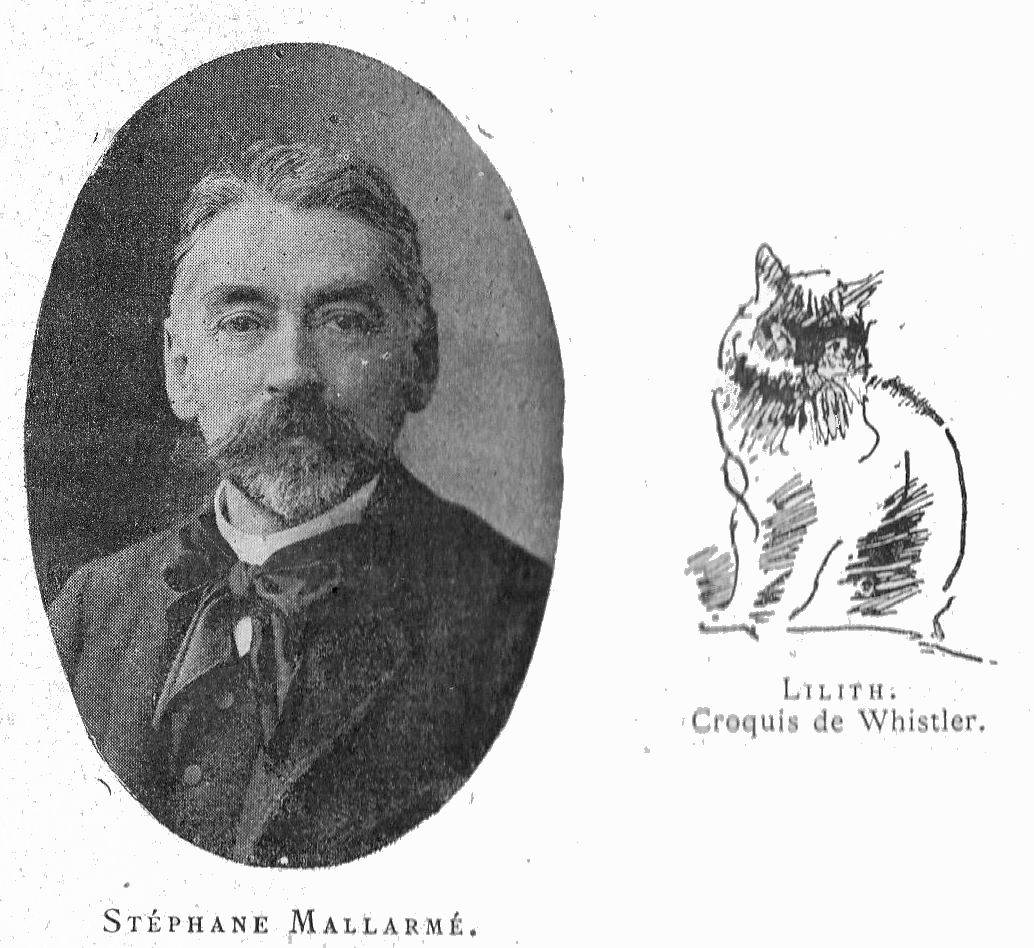
Stéphane Mallarmé "does not bother to examine whether the cat is hypocritical and cunning, as it is claimed. It is an animal necessary for indoors; he makes it complete, it is he who polishes the furniture, who softens the angles, who gives the apartment something mysterious. He is the last trinket, the jewel in the crown."
A great admirer of the feline breed, Stéphane Mallarmé possessed one that, like Pierre Loti's, rebelled against human contrivances.
"My Lilith," he wrote to us a few weeks before her death, "is now very old, once a superb person, there are only two golden eyes of gold in just the right amount of black to show their value. To describe it, for an artist it would lack intimate resemblance. It remains for me to entrust to you an ink drawing that Whistler lately tried in vain - the model disappeared under a bed before the great painter had drawn an outline, so that the following indication is from talking all about the cat ... " We give this sketch from the great English painter; in sending it to us, the master poet Mallarme accompanied it with a few lines about the cat.
"The cat goes from divinity to rabbit; outdoors he is pursued, by brutal peasants, he returns to the indoors, into recesses of shadow, becoming something like our household god, the idol of the apartment. I add, and have often said, for that reason alone he satisfies the need for affection, by offering it at the exact place; including, speaking philosophically, the next world, the essential, in the unfurling or flight of its tail."
"I adore," wrote Armand Silvestre somewhere, "These brothers whom we have the power to support. In the cat’s case, ‘adored’ is the word, and I am absolutely Egyptian when it comes to this mysterious animal whose eyes have the depth and the stars of part of the sky."
Courteline, brilliant and joyfully whimsical, is also a great adorer of the feline race; he is somewhat the father of all the animals who wander on the Butte Montmartre; I have heard him relate very curious anecdotes on this subject, but unfortunately have no place for them here. His love for cats pried him out of his cradle, from where he slipped at the age of eight months to go on all fours to search under the shade of furniture for the cat belonging to Mother Popo (his nurse ). Today he has many cats and he loves them all equally.
Courteline's cats are wise people, and they let themselves be portrayed; but their master resists any interview; all I could get from him were the names of his fellow felines, and what names! They certainly cannot deny their Montmartre origin: the Purotin of the Rue du Ruisseau; Charles Scherer, called the Infamous, the Terror of Clignancourt; the dissipated Mother; the Little Turbulent One, and the Redhead of Montmartre.
Edmond Deschaumes, who was one of the judges at thye Journal’s cat show, has the same affection for Cats and Dogs; witness this letter he wrote to me recently:
"Living for years in the midst of a real menagerie, I especially enjoyed studying the relationship between animals and I recognized, not without shame, that they are much more sociable than men. Nothing is more false, therefore, than the saying: ‘Like Cat and Dog’ which supposedly defines, by metaphor, the ultimate degree of hatred.
"I saw my dogs and cats constantly living in the most perfect understanding. My monkey herself, who gets on with all my little world, served as a nanny to our kittens, when my cat raised her young. So I think all animals raised together know and practice friendship much better than old schoolmates, and I envy them. They are exempt from the perfidies of false friendship and do not know the bitterness of disillusionment which brings us to Parisian skepticism: the greatest suffering for a generous and upright heart.
"My pussy died of her love affairs with a young dog from this house. I have not replaced her yet. The cause of her death proves that there is no hatred - far from it! - between the canine and feline races.
"This poor beast was a brave gutter cat, very slender with a black and white coat, and also very thin also because she had bred too much. She was discreet, silent and very attached to the house. Often she jumped on my desk, smudging a fresh page and then purring like a spinning wheel, looking quite satisfied with her work. She was right ... She often raised my energy, or just trashed my vanity. I have never had a wiser or more impartial literary advisor.
"Now, when the sheet is smudged, when I question looking at the wastepaper basket that fascinates me, the little black and white cat is no longer there to tell me, flaunting herself disdainfully: ‘This is not it. Start again!’
"You see, my dear colleague, I had a cat that loved my dog and was very hard on my ‘writing.’ She was perfect and it's definitely because of her perfection that she's dead."
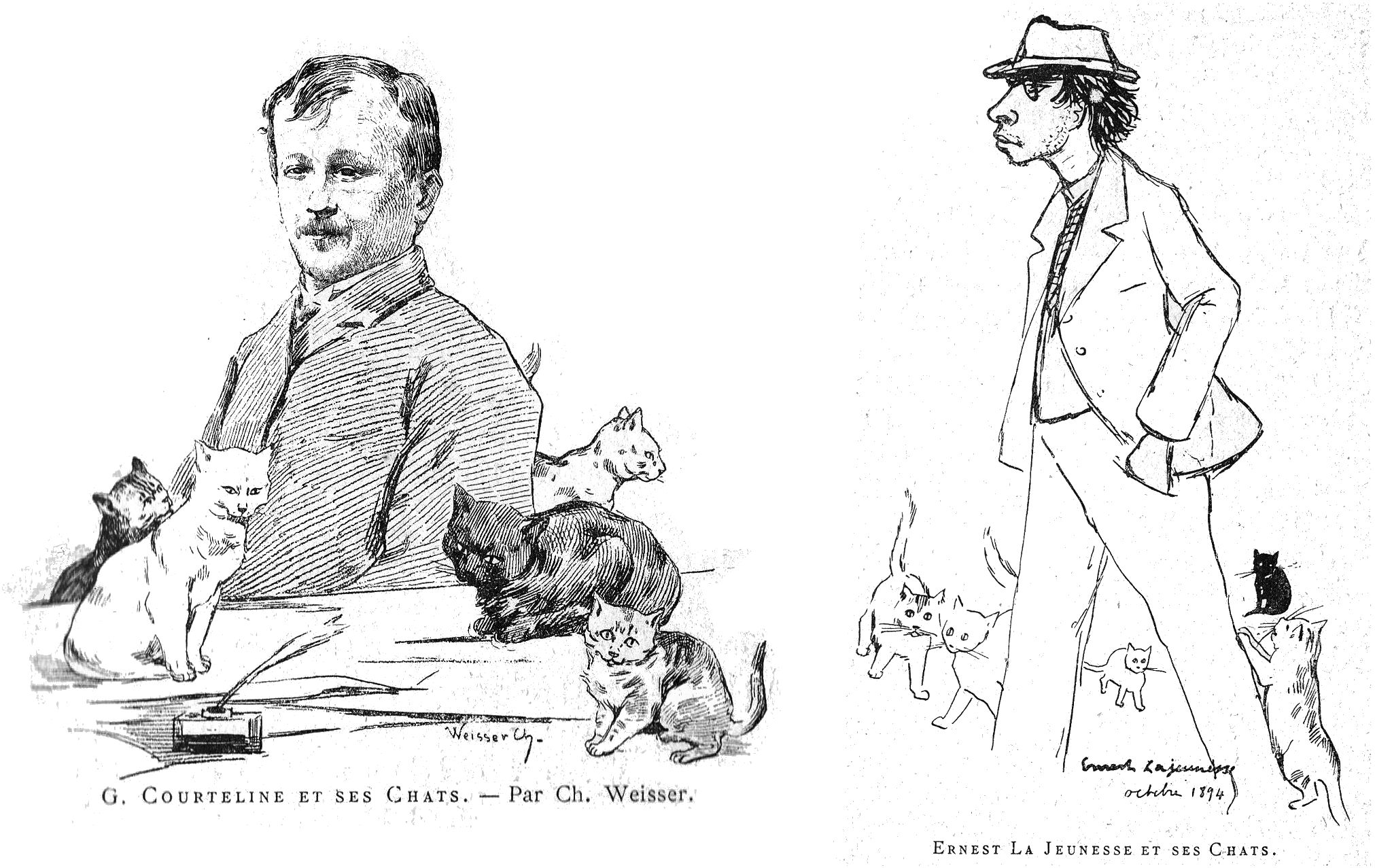
Among the younger people of literature, one of those whose talent is most original and most fertile, is certainly Ernest La Jeunesse, who came to conquer Paris two or three years ago from Nancy accompanied by five superb Cats: Elsa, Thais, Paphnuce, Berenice and Boudolha. In one of his upcoming novels, he will tell us about his arrival in the City of Light, and his passion for felines. Here is an unpublished passage from this novel, "The Inimitable":
"Sitting on a bench, he massaged his animal in his fingers, looking into her eyes: ‘Listen,’ he said, ‘for a little while you're bored with me. And soon we will be bored of not getting bored together anymore. I'm going to jilt you badly, my poor friend. I will have done everything to avoid this cowardice, but there are things and there is destiny. And then I'll have a cat, - me. I am more cat than you. I am Dog too. You do not remember (because you were not born), I roused Dogs in the street, speaking their language without understanding it, furiously, languidly, in ululating tenderness, and in tense grief in turn. You heard me meowing and it did not surprise you because you knew me, because before you, your mother did not let herself get caught, knowing me so well! but Cats in the streets fled at my voice and then came back, lurking around my call and their eyes shining towards my eyes, searching for the cat in me and staying there, wondering why I was less foolish than other men, being more animal than them.
"I'm a beast, my friend, a clawing animal, biting, twisting, jumping, frolicking and rushing about: I possess the art of inhuman screams and I possess it by birth, I've have the dreams of a beast and the desires of a beast, I did not find anyone to talk to, dogs having special terms for treating ethics and men barking only in secret. I give you these confidences, little one, before leaving you. You must be my mute confessor, my impotent accomplice, you must be the quiet companion of my struggles, the serene witness of my anxiety, my soul with fur. You know my secret and my future (which I do not know) for having slept on my heart, for having scratched it and for not knowing how to say the words of men. You will keep these secrets in your little cat life: it will not bother you to look for food, to try to purr. Will you remember me, my long walk? Will you remember that, as a child without a shelter, I looked for you a lodging? Besides, I'll meet you in a few months, in a few days, but I will not recognize you! Ah! my poor child! my poor child, good-bye!"
"He kissed her with a mad kiss, long, eternal, in a passionate embrace, then he put her on the ground and walked away without turning around. He turned after ten steps. The cat had followed him and looked at him with such a look that Andre's heart weakened dispairingly: ‘Ah! my poor beast, you understand me! Ah! you love Me! Ah! you do not want to leave me: you will not leave me.’ He picked up the cat, washed its mud-stained legs and put it back on his chest."
Louis de Grammont, whom I have previously mentioned among cat-lovers, had a real passion for cats. Here is his opinion of them:
"But I will not let slip this opportunity to proclaim my predilection for cats - those animals so pretty, so graceful, so ‘feminine,’ whose name alone, for anyone who loves them and is often frequented by them, is deliciously suggestive.
"What pleases me about the cat, besides its prettiness, is the grace of its movements, its extraordinary suppleness, and its absolute independence. The cat is not a servant, he is a guest. He deigns to live with man, but he does not live only for man. He is symbiotic with us. He shares this way of being only with sparrows, those sweet anarchists.
"They have been much slandered. Oh, they pretend that they are incapable of affection, that they cling to places and not to the people ... What an error! Cats, like animals and children, love those who love them, care for them, caress them. One must never have been host to any feline in order to support such revolting heresies. People say they are traitors ... Alas, they are the only beings who have never betrayed me!
"I would write volumes, if I wanted to include all the memories evoked in me by cats; if I wanted to review all the guests with their silky fur, sharp teeth and mysterious eyes, who have succeeded each other in my home; since Popul, who was killed as a poacher in the forest of Bondy on the orders of the Duke d'Aumale; from Tayo, who, when a bald man sat at my table, leapt on that ivory-pale dome, and, to the great terror of the victim, performed balancing acts; to Kangaroo, who, despite his cowardly native, died like a defender, killed duelling for the beautiful eyes of my Moutonne. I would never finish if I wanted to tell everything!"
Georges Feydeau, an author much applauded for his beautiful monologues and who has lost count of his theatrical successes, has devoted to a charming fantasy to Minet [puss] which naturally finds its place in "Our Friend the Cat." The accompanying illustrations come from actor Saint-Germain, they would not be disowned by our best cat cartoonists.
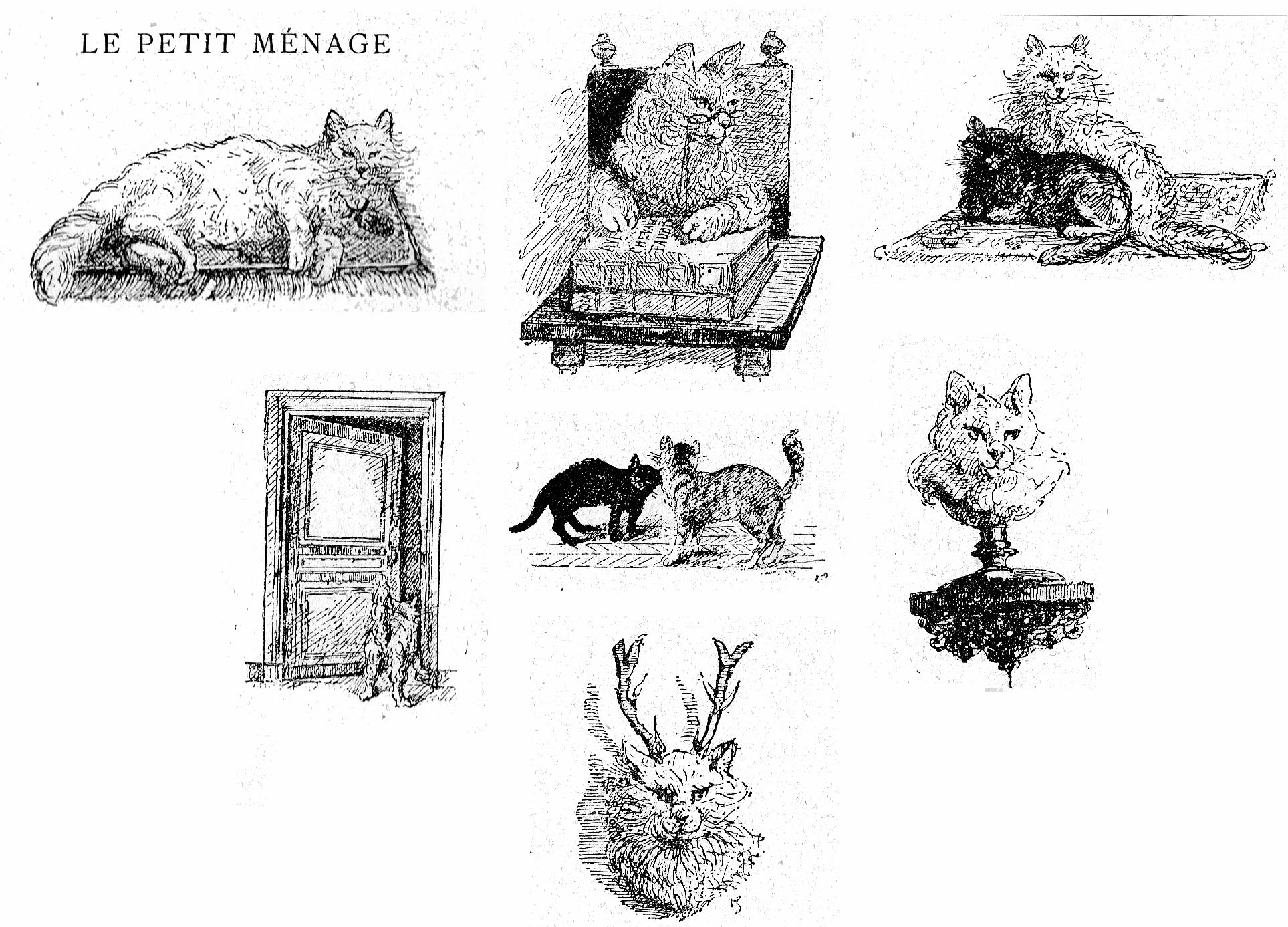
THE LITTLE HOUSEHOLD
Minet, the indolent king of angoras,
Silk-soft and white, large and fat,
Had a pretty Andalusian puss,
Brown-haired and alluring,
For his legal spouse.
It was I who arranged their wedding.
It took place on a fine April day;
But it was only a civil marriage
Without Mass – it’s the modern custom
Because I will admit that my cat,
An atheist like Daniel Rochat,
Does not get along very well with clergymen
Because those foolish robed gentlemen
Have named two of his favourite flaws –
Lust and gluttony – as dealy sins.
Besides, everyone to his own taste!
As for me, my cat’s a free thinker.
As is his right of course. But have no fear.
Minet is not a revolutionary;
He purrs, and sleeps quite peacefully,
And practices very little of politics.
As long as he is content, that's all he wants,
And it is right to say that he wants for nothing.
The lovers’ honeymoon lasted almost six weeks
The days passing sweetly, free from woe or worry,
The pair of them perfectly happy,
Their days overflowed with love’s intoxication
As they sang lovers’ duets filled with elation,
. . .
But look here, my neighbour’s cat is making himself known.
I think he is a little cousin Minet’s Andalusian wife.
.. . .
He purred softly and rubbed lasciviously
Against the delicate fur of Minet’s wife.
Why hesitate? He asks.
This Triboulet is a handsome creature
Whose looks inflame the mind and heart
Of the still-virginal pussy.
In short, this Don Juan seducer
Swaggered in and made sweet faces
At his pretty cousin.
He saw an opportunity and planned to seize it.
Full of self-confidence he became more audacious.
And why not? Minet was away from home.
Monsieur followed the lady – up into the attic,
Saying - No need to be alarmed!
Alas! my sweet, you are rather flighty.
She began to be swayed by his attentions.
They bantered, they debated
(In cat language, as I surely need not mention)
And the scoundrel finally won his case!
. . .
But, just at the crucial moment Minet tumbled in
Through the half-open door - it was not locked!
He was like an unexploded bomb.
Him! Name of a tomcat! The two lovers
Frankly did not expect this.
Madam! He was supposed to be off hunting.
These husbands! They’re never where they should be -
Here he is, and he’s furious!
Shaking at this outrage, Minet
Comes leaping in, full of wrath.
Lightning flashes in his eyes.
He spits "pfut! pfut!" and his back is arched.
This will end terribly no doubt!
Yes! tremble, poor lovers!
What terrible storms and awful cataclysms
Have you brought down upon your heads,
You unfortunate things!
I can already foresee carnage,
Ashen faced, eyes half-closed,
I don’t want to see any more so I look away.
. . . But what’s this? Nothing? Just silence?
Just a regular, rolling purr in the air,
No noise, no violence, no duel?
How peculiar!
Ah, Minet, is this how you take revenge?
Minet! You’ve a stout spirit!
Did you know what was going on?
Minet, the cuckolded husband,
Knows how to submit to his fate.
Philosophically, he falls asleep
And beside him, the couple kiss.
And that’s the story, my friend –
That’s the way of many husbands!
Quietly taking what is doled out:
Not that I want to name any names.
[Note 1: Daniel Rochat was an atheist in a French comedy of that name by Victorien Sardou.]
And finally I must mention this beautiful page by Champfleury, the first person of our century who devoted a book to cats; it is long since out of print despite running into numerous editions.
"The cat is natural, that's why we slander him. Playing its little part in the world unaffectedly, when it is hungry it says so. If it wants to sleep, it lies down and stretches itself out. When it wants to go out, it asks to be let out.
"But why hasn’t this constant ingratitude, this constant reproachment of the cat, alienated the heart of poor people who have put all their affections on the head of such an egotistical animal? for the cult of the cat, though no longer a religion, has not been interrupted since ancient Egypt; and although today he is no longer wrapped in the bandages of death, during his life he is surrounded by the care that he certainly prefers over embalming.
"In palaces and attics, the cat is treated equally by the rich and the poor.
"He is neither ‘an unfaithful servant’ nor ‘a useless servant’ as Buffon wrote, the animal works according to its own measure with the dedication of a slave.
"Here, in the courtyard, is a cat lurking near a lead pipe coming out of a house. We can call him, but he is at his post and will not raise his head. Sitting on the pavement, he occasionally thrusts his paw into the pipe and removes it with signs of great annoyance.
"The had seen a rat disappear into the pipe. He condemns himself to watch for hours the rat who will eventually succumb.
"Thus an animal called selfish will have given service that day."
"To rid an apartment of mice, we need ask nothing, just eat the enemies of the house. And when the house is free of mice, the mere presence of the cat prevents them from entering it. Even in its apparent laziness, the cat is a vigilant sentinel, who, from the moment it sets up home somewhere, it sees off the rodents.
"Should we accuse the castrated tomcat of his indolence while the mice are playing havoc with his whiskers? He has been disarmed. It is not he, we think, who solicited that inhuman operation that prevents him from ever obeying the instincts of his race.
"Man wanted the cat's company. Cats did not seek the company of man.
"Let an animal run in peace in the woods and gardens, it will not ask to come in to dessert, and to stretch itself upon the drawing-room carpet. The cat will satisfy his needs, find his own food, and sleep in a tree. Eight days of freedom will restore his natural independence.
"Man, to forget his vices, likes to create a belief in the vices of the creatures around him.
"The cat is the personification of selfishness – this is repeated sententiously by grave gentlemen, of whom I would not ask the slightest service."
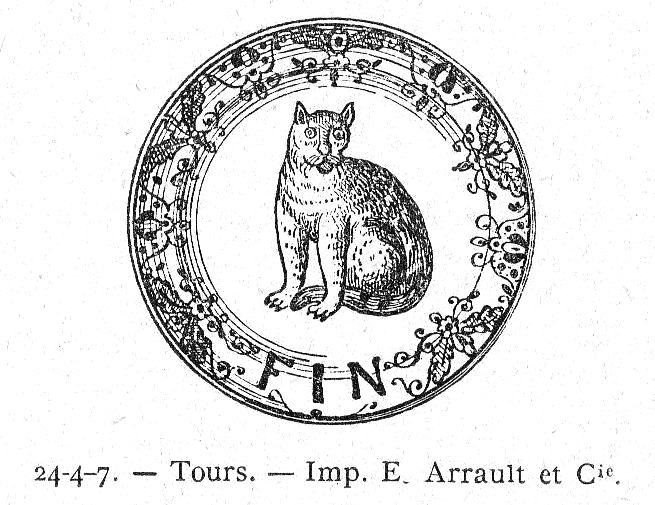
FOOTNOTE: This aquatint is not from Megnin's work, but it alludes to cats in Paris:
